Remembrance Day, 2019, Gettysburg



The world will little note, nor long remember what we say here, but it can never forget what they did here.
Abraham Lincoln, November 19, 1863.
by Joe Bordonaro
President Lincoln was wrong about the first part, but very much correct about the second part of this famous phrase from his magnificent “Gettysburg Address.” On Nov. 23, 2019, reenactors and members of the general public gathered in Gettysburg, Penn., to remember the actions of the soldiers and the President 156
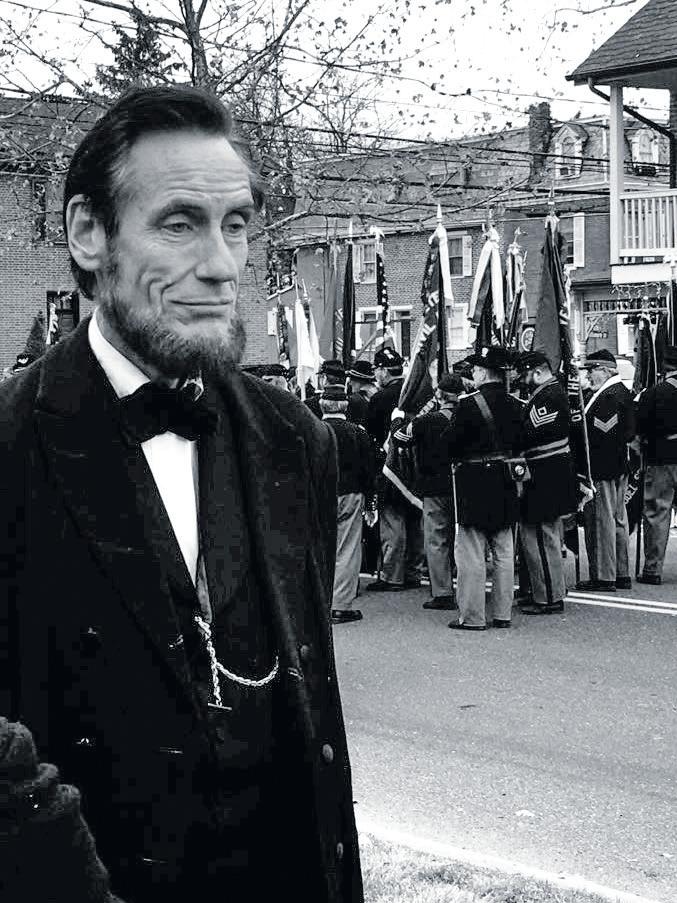
Remembrance Day 2019. Stafford County Science Teacher Don Mullen, portrays President Lincoln.
(Garry Adelman, American Battlefield Trust)
years ago. The Sons of Union Veterans held their 62nd annual parade, featuring numerous Civil War reenactors. Members of reenacting groups commemorated the actions of various individuals and units by conducting marches and visiting monuments. A “Remembrance Illumination” of Gettysburg National Cemetery graves occurs each year, as well. Although the numbers of reenactors are down from its 2000 peak when Wikipedia estimated there were about 50,000 Civil War reenactors; a still impressive number showed up this year and kept the traditions alive. The accompanying photos highlight some activities that took place.
Joe Bordonaro is a USAF veteran (1973–1977), Glassboro State College graduate (1980), Catholic school teacher, and retired public school teacher. He can be
CW
Vol. 46, No. 1 48 Pages, January 2020 $3.50 Civil War News America’s Monthly Newspaper For Civil War Enthusiasts Inside this issue: 47 – Advertiser Index 10 – Black Powder, White Smoke 38 – Book Reviews 40 – Critic’s Corner 28 – Emerging Civil War 43 – Events Section 22 – The Graphic War 24 – Inspection, ARMS! 20 – Preservation News 41 – Small Talk-Trivia 16 – The Source 12 – The Unfinished Fight 26 – This And That 14 – Through The Lens H Day . . . . . . . . . . . . see page 2
N
–
Members of the 14th Brooklyn carry the uniform of Frank J. Santella in Remembrance Day parade. (Todd Welsh) contacted at joe1861@gmail.com.
The Delaware Valley Blues march towards the Codori Farm. (Alexander Glisson)
Civil War News
Published by Historical Publications LLC
520 Folly Road, Suite 25 PMB 379, Charleston, SC 29412
800-777-1862 • Facebook.com/CivilWarNews mail@civilwarnews.com • www.civilwarnews.com
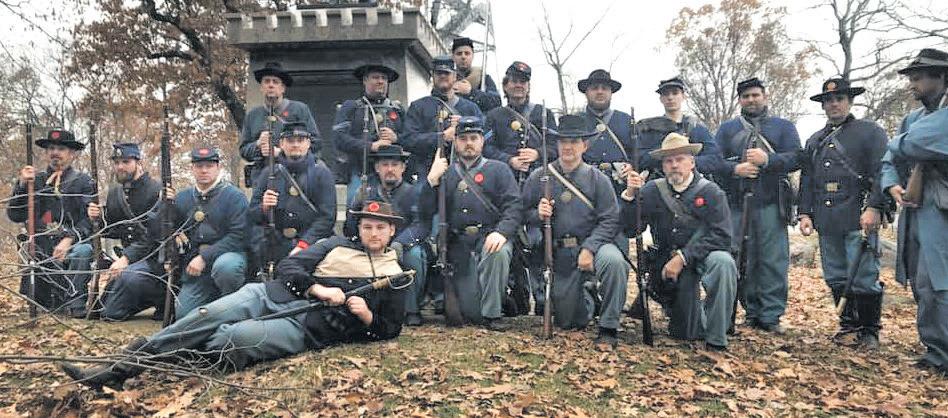
Advertising: 800-777-1862 • ads@civilwarnews.com
Jack W. Melton Jr. C. Peter & Kathryn Jorgensen
Publisher Founding Publishers
Editor: Lawrence E. Babits, Ph.D.
Advertising, Marketing & Assistant Editor: Peggy Melton
Columnists: Craig Barry, Joseph Bilby, Matthew Borowick, Stephen Davis, Stephanie Hagiwara, Gould Hagler, Tim Prince, Salvatore Cilella, Michael K. Shaffer
Editorial & Photography Staff: Greg Biggs, Joseph Bordonaro, Sandy Goss, Gordon L. Jones, Michael Kent, Bob Ruegsegger, Gregory L. Wade, Joan Wenner, J.D.
Book Review Editor: Stephen Davis, Ph.D., Cumming, Ga.
Civil War News (ISSN: 1053-1181) Copyright © 2019 by Historical
Publications LLC is published 12 times per year by Historical Publications LLC, 520 Folly Road, Suite 25 PMB 379, Charleston, SC 29412. Monthly. Business and Editorial Offices: 520 Folly Road, Suite 25 PMB 379, Charleston, SC 29412, Accounting and Circulation
Offices: Historical Publications LLC, 520 Folly Road, Suite 25 PMB 379, Charleston, SC 29412. Call 800-777-1862 to subscribe.
Periodicals postage paid at U.S.P.S. 131 W. High St., Jefferson City, MO 65101.
POSTMASTER: Send address changes to: Historical Publications LLC 520 Folly Road Suite 25 PMB 379 Charleston, SC 29412
Display advertising rates and media kit on request. The Civil War News is for your reading enjoyment. The views and opinions expressed herein are those of its authors, readers and advertisers and they do not necessarily reflect the official policy or position of Historical Publications, LLC, its owners and/or employees.
P UBLISHERS :
Please send your book(s) for review to:
CWN Book Review Editor, Stephen Davis 3670 Falling Leaf Lane, Cumming, GA 30041-2087
Email cover image to bookreviews@civilwarnews.com Civil War News cannot assure that unsolicited books will be assigned for review. We donate unsolicited, unreviewed books to libraries, historical societies and other suitable repositories. Email Dr. Davis for eligibility before mailing.
ADVERTISING INFO:
Email us at ads@civilwarnews.com Call 800-777-1862
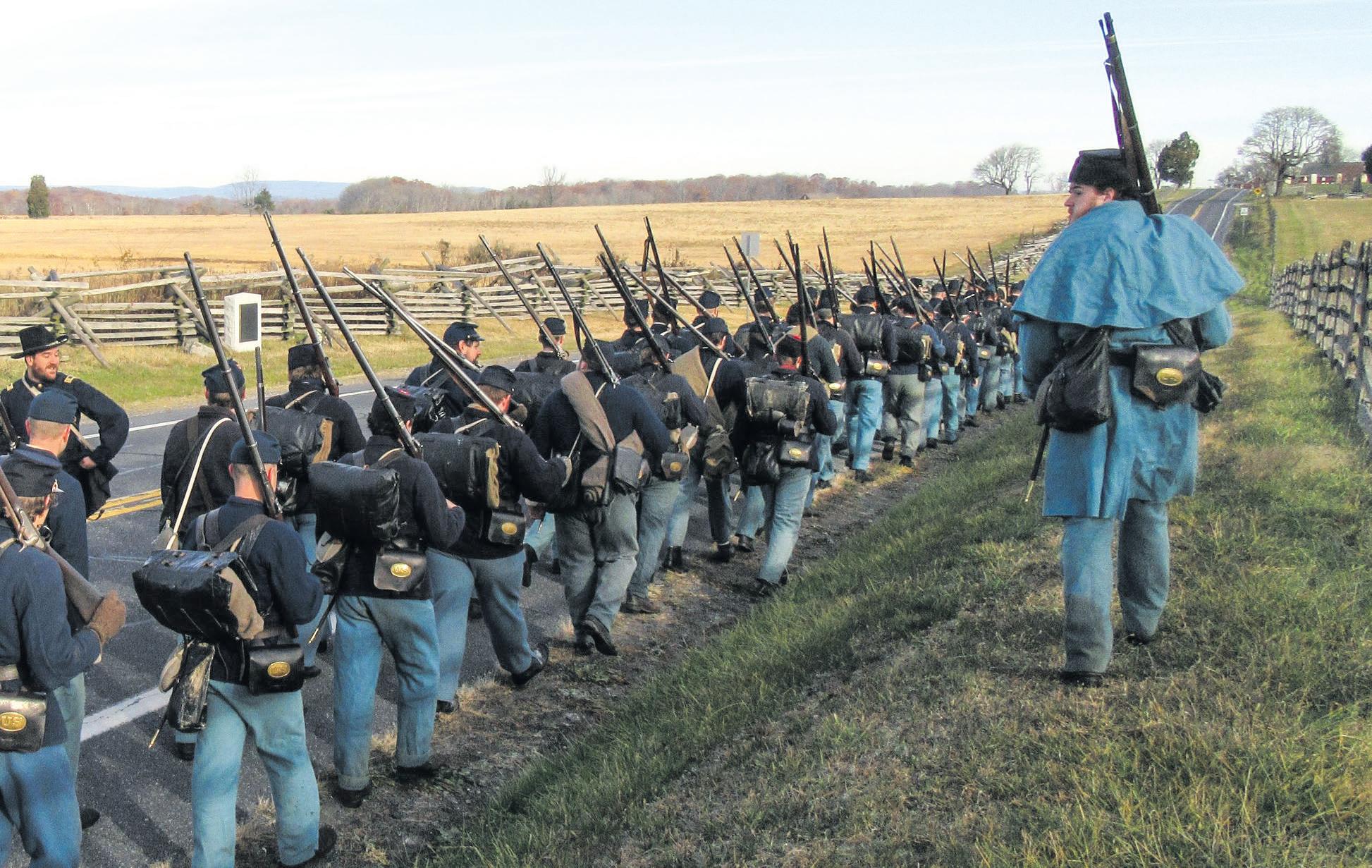
MOVING?
Contact us to change your address so you don’t miss a single issue. mail@civilwarnews.com • 800-777-1862
SUBSCRIPTION RATES
H
Remembrance Day
End of the 56th PVI March on Culp’s Hill. (Maddi Burtner)
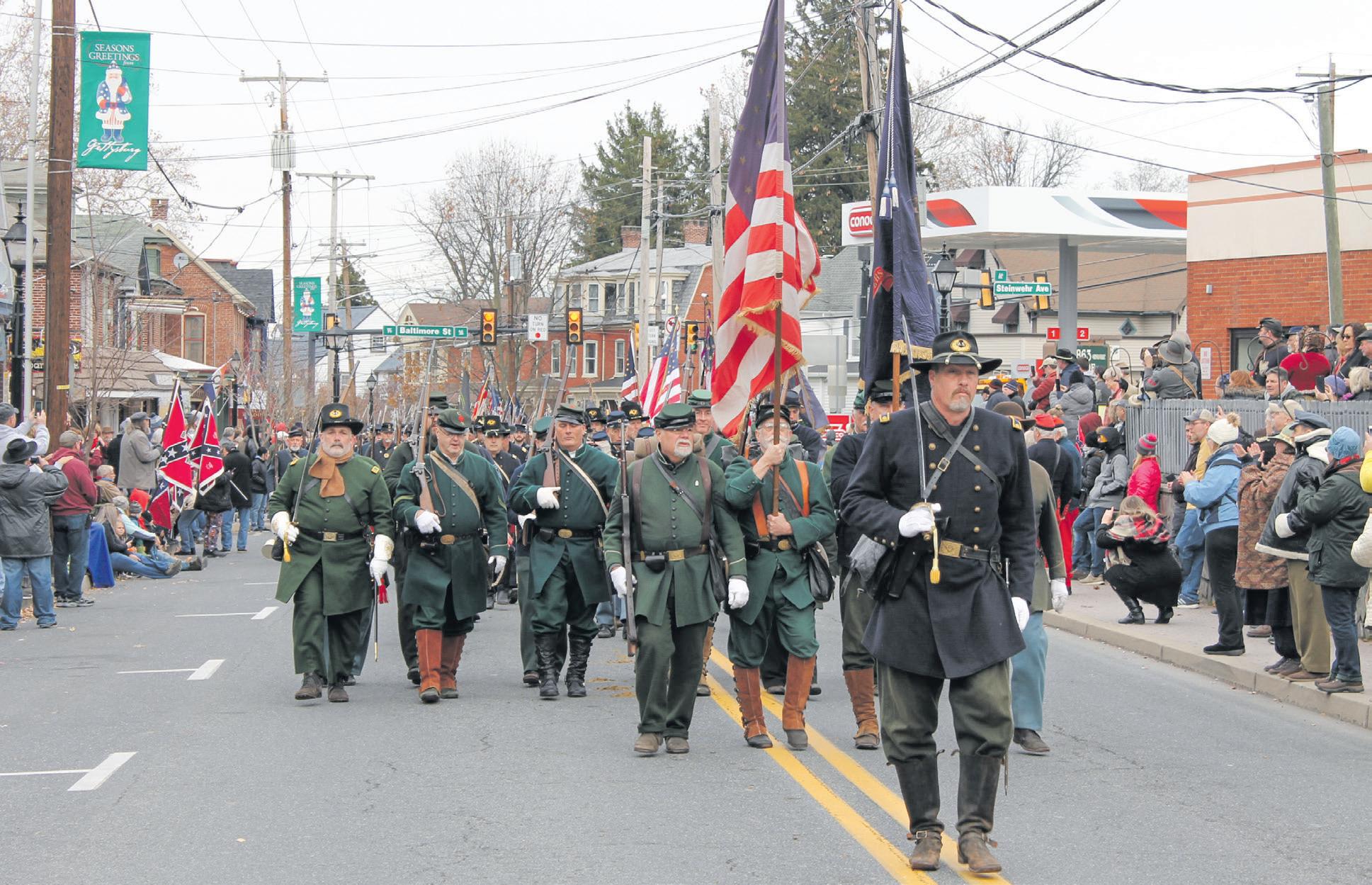

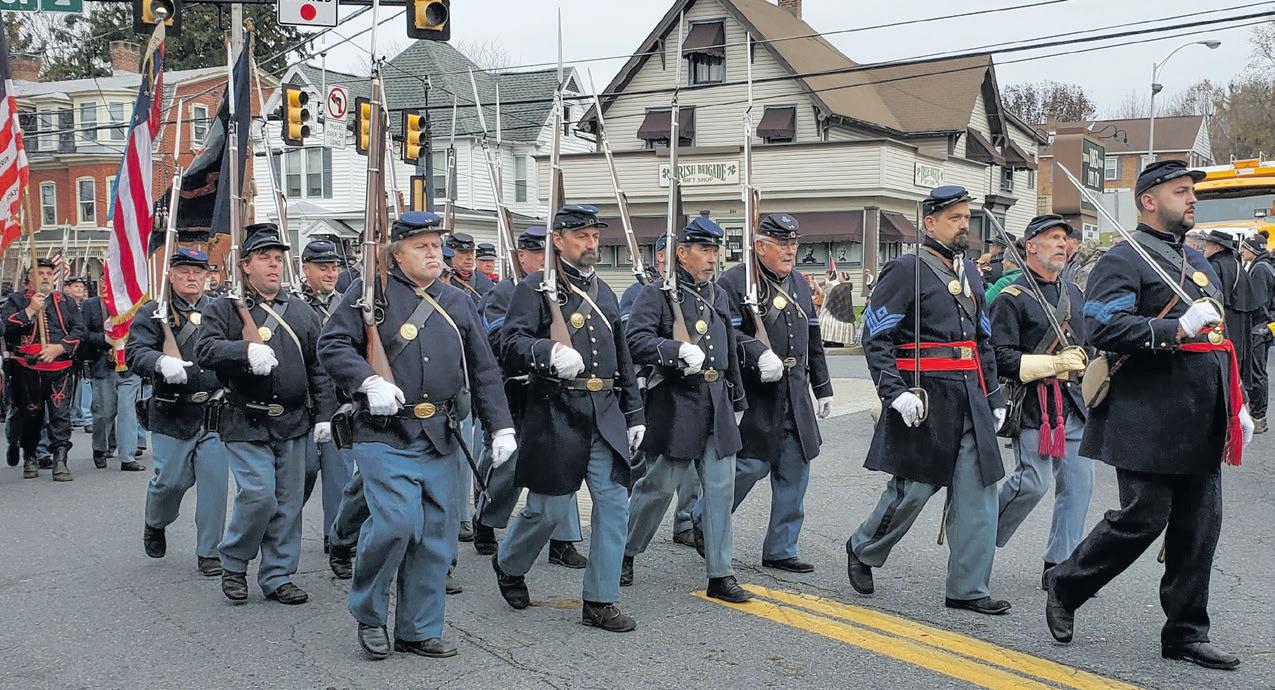
2 Civil War News January 2020
U.S. Subscription rates are $38.50/year, $66/2 years, digital only $29.95, add digital to paper subscription for only $10/year more. Subscribe at www.CivilWarNews.com . . . . . . . . . . .
from page 1
Members of the Mifflin Guard march down Baltimore Street. (Brigitte Ross)
The Liberty Rifles recreated the march of the 17th Maine Volunteer Infantry. (Liberty Rifles)
A profusion of colorful flags leads the way in the parade. (Brigitte Ross)
Berdan’s Sharpshooters have a distinct green uniform, unlike the blue of other Union units. (Nicholas Ashe)






Publisher’s Note: We asked Steve Reilly to send in an additional article to cover the Gettysburg Remembrance Day for another viewpoint.
By Steve Reilly
On November 23, 2019, we commemorated the 156th Anniversary of Lincoln’s Gettysburg Address. A question that I needed to answer was when did Remembrance Day begin? I contacted Michael McCloskey, Professor of History. Professor McCloskey is my go-to guy in Gettysburg.
Now, Professor McCloskey’s words. Remembrance Day is today a solemn recognition of an event that took place 156 years ago. Even before the dedication, people came to the small hamlet of Gettysburg to visit the battlefield and remember what took place here. The war was raging in other regions, but people still wanted to come to Gettysburg to seek loved ones, hear what happened, or just offer their own small respect for what took place. When the dedication for the National Cemetery took place with the president present, it only heightened the perception of importance. Over the course of time, units came to Gettysburg for placing monuments, reunions of survivors, and to remember those who did not. Gettysburg became a place of gathering and of importance.
My first stop on Friday was the National Battlefield Park Visitor Center and Bookstore, to get a feel for the weekend. Walking in, I eyed eight book sellers with Scott Mingus sitting on the end. Scott was just at my Civil War Round Table at Kennesaw Mountain, so I walked over. Scott had the attention of the Gardner family from Boone, Iowa. He was telling the two Gardner sons, Nathaniel and Sean, how his ancestors, the Chambers boys, joined the 7th West Virginia and fought on Cemetery Hill on July 2. Their regiment marched into Gettysburg with 319 men, 5 were killed and 41 wounded.
I decided to do some sightseeing and meet George Weinmann, his wife Janice, and Charles Lirio at the 62nd New York State Vol. Monument. George was visiting the location where his uncle’s regiment fought, just off Wheatfield Road. The regiment lost 2 killed and 16 wounded.
Janice Weinmann is the President of the Greenpoint Monitor Museum. They own the East River waterfront property in New York City where the
Gettysburg Remembrance Day 2019
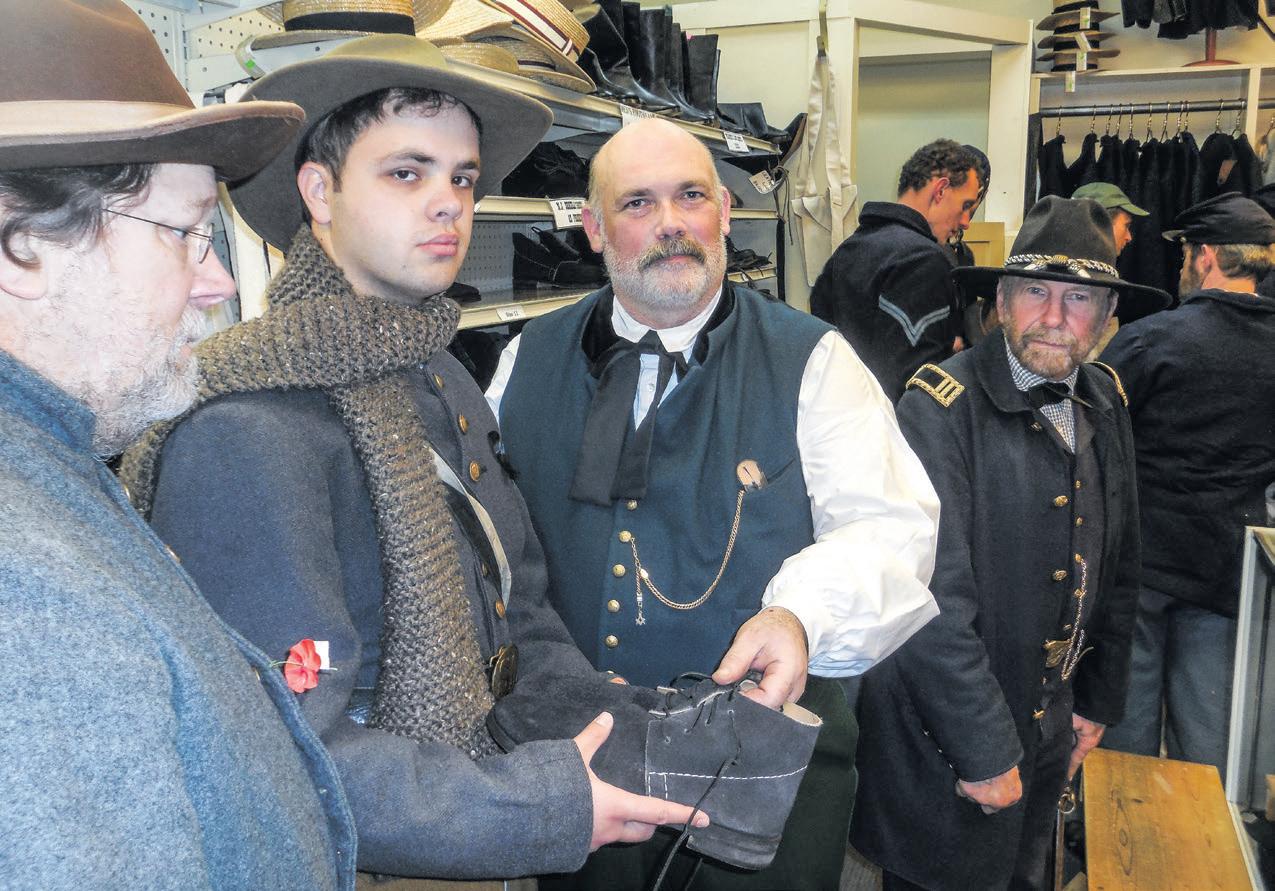
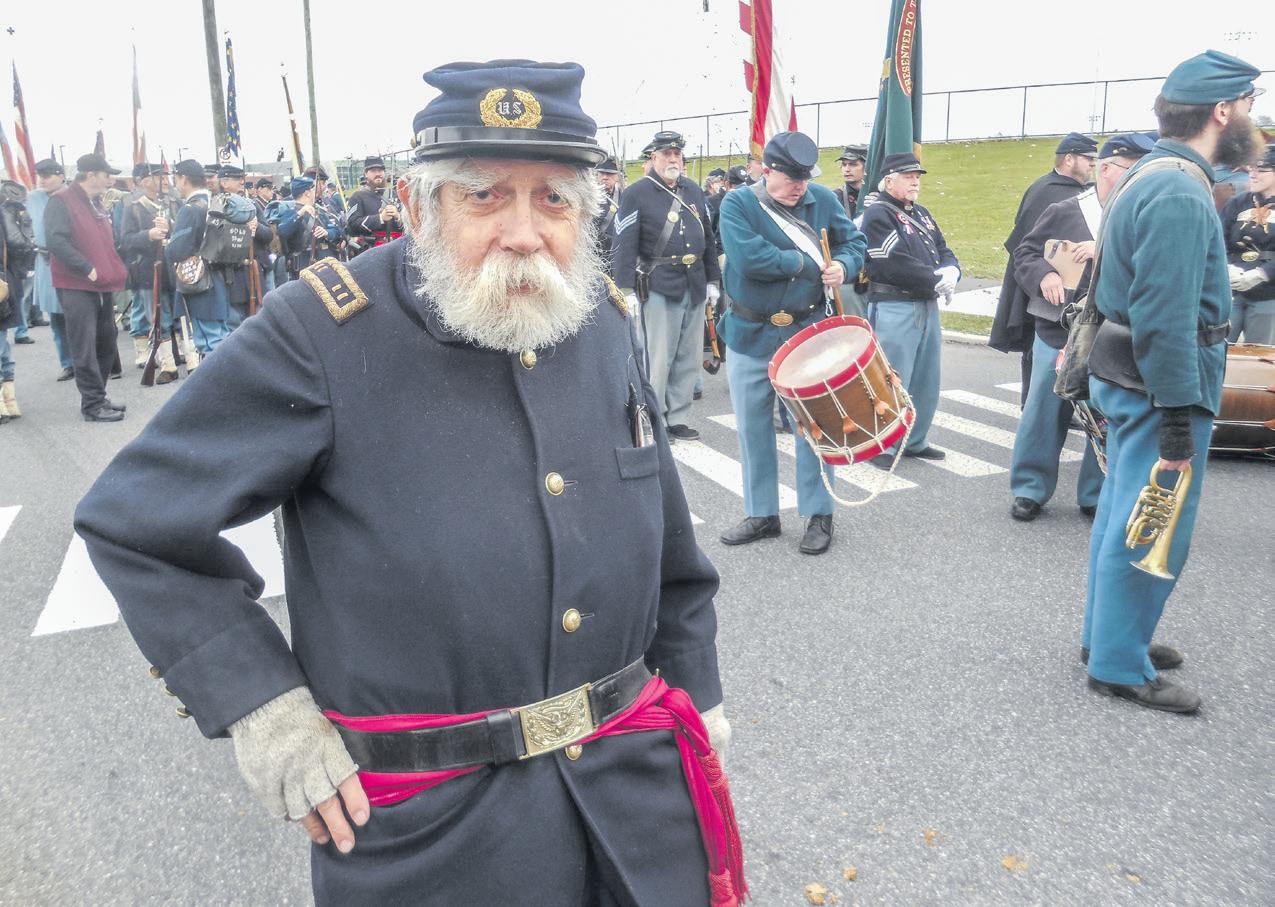


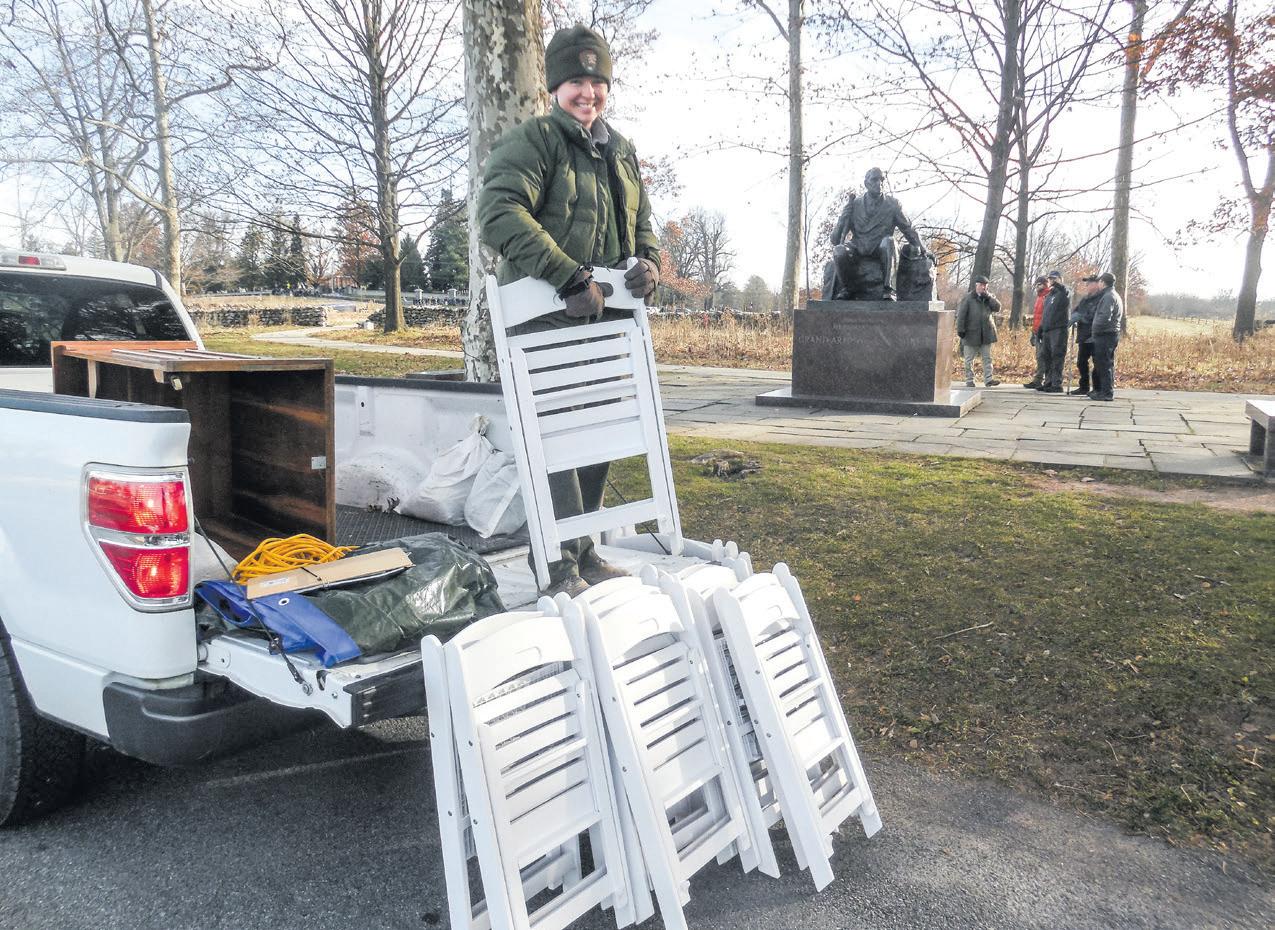
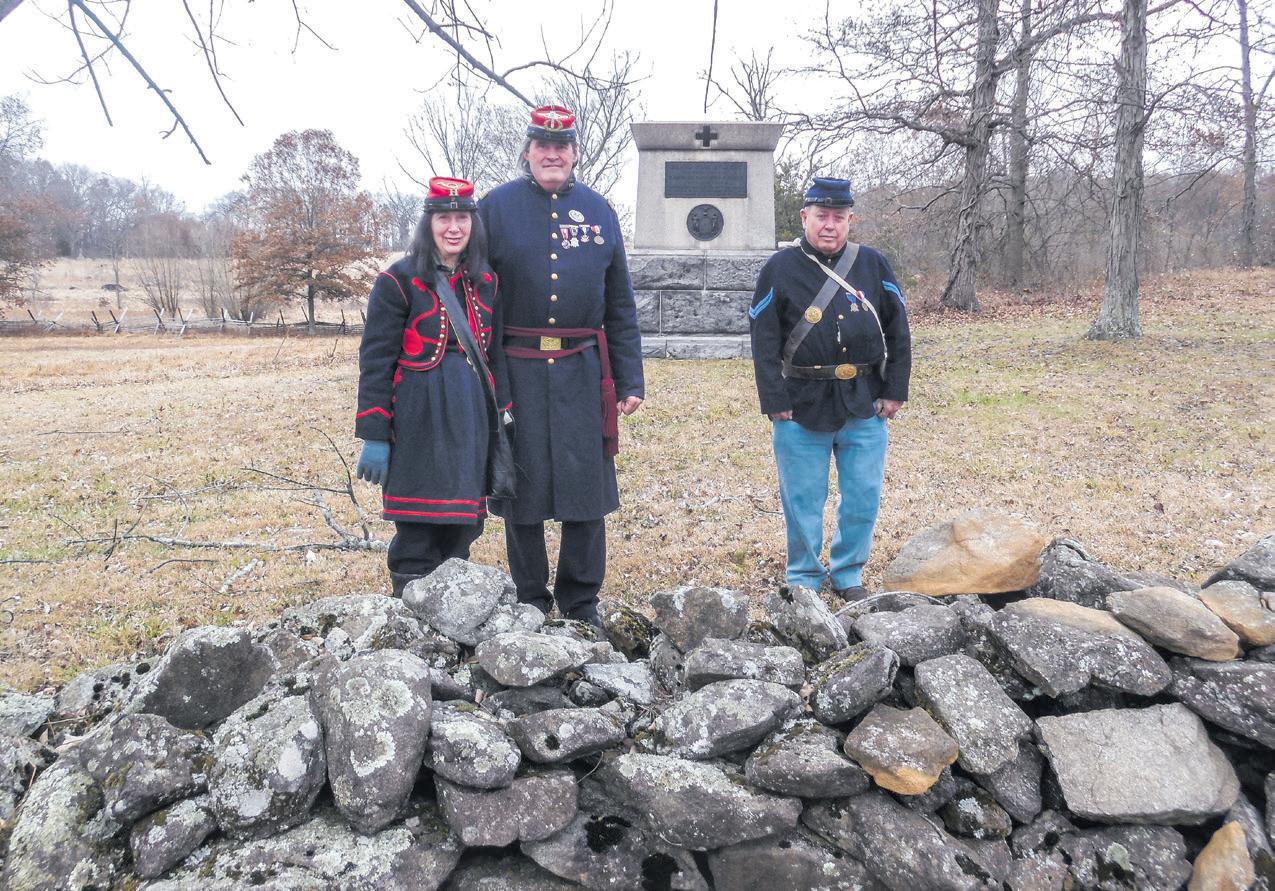
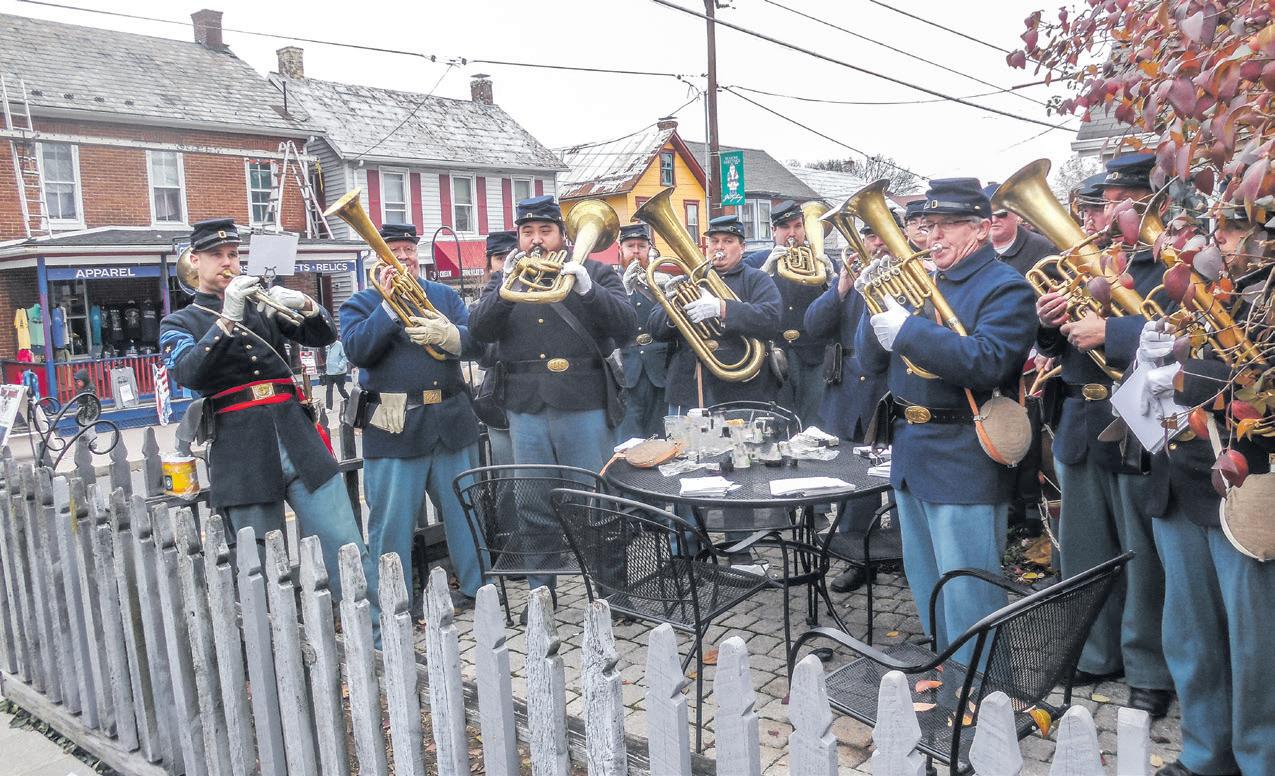

4 Civil War News January 2020
69th New York at their annual 4 p.m. Mass, at the Father Corby's Monument. (Photos this page by Steve Reilly)
73rd Ohio Band, giving a street concert for the troops.
Commander George & Mrs Weinmann, with Cpl. Lirio visiting the location where the commanders uncle fought.
Magan Weber of the National Park Service
Past C&C Mark and Barbara Day, SUVCW, Mark also portrays Gen. Ord, in Lincoln's Generals
Sons of Confederate Veterans, Maryland Division
John Griffiths, great grandson of Lt. General U. S. Grant.
Mike at the Regimental Quartermaster, attempting to convince two confederates soldiers, that the shoes are not free.
USS Monitor was constructed. Presently, they are repairing the waterfront and plan on beginning construction of the Monitor Museum.
The next morning opened cold, but clear, good marching weather. I drove up, parked near the high water mark and walked over to the National Cemetery and saw Meghan Weber of the National Park Service unloading chairs. When I took a photo, she looked at me and asked, “Why are you taking my photo, I’m not a VIP.” Without you, Meghan and your co-workers, there would be no Remembrance Day.
The Delaware River Blues, “K” Company, 1st Delaware Regiment, was walking across the field. Their unit was on McPherson Ridge the first day. They marched into Gettysburg with 288 men; 10 were killed, 54 wounded, 13 missing; the regiment was credited with capturing a Confederate flag.

I walked into the National Cemetery with the National Volunteer Brigade, with John Ault, NPS, stopping traffic for us. Inside there were several units with bands including the Providence Brigade with the 2nd Conn. and Battery “B,” 1st R.I. Light Artillery.

Then there is the 69th Pennsylvania; my great grandfather had a cousin in the unit; they fought at the high-water mark during Pickett’s Charge. They were placing coins on the graves of men killed in action; later they marched to the Angle, placing American flags along the wall. In 1863 they marched into Gettysburg with 258 men and had a total of 143 killed, wounded, and missing.



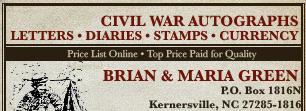
By this time, the streets were filling up with spectators; some areas of the sidewalk were two or three deep. In the parade staging area, I encountered Colonel Brian Pierson, USAF Ret., and currently the Senior Vice President of the Sons of Union Veterans. Moving up the line, there was John Griffiths, the great grandson of the President Grant.
Marquett Milton from the USCT Museum in Washington, D.C., told me of the big events happening at the museum. Marquett is one of the nicest men that I ever met; and wears his USCT uniform to work, to generate interest in the USCT Museum. Off to the side was Bryan Cheeseboro, a VIP who works at the National Archives. The United States Colored Troops are out in force this day including Robert Houston, the force behind the 3rd Regiment, USCT in Philadelphia, Penn. Behind them was the 14th Brooklyn,
marching with the folded uniform of Frank Santella, a member since 1980 who just passed away. Alongside them, were the 5th New York, Duryee Zouaves.
The 14th Brooklyn marched into Gettysburg with 356 men, and lost 13 killed, 93 wounded, 98 missing.

Approximately 500 uniformed troops composed the Confederate line. General Lee, 21st Georgia, 14th Tennessee, 19th Virginia, and 43rd Mosby’s Rangers to name a few.
As the parade moved up Baltimore Street, I walked over to the Lincoln Cemetery to pay my respects at the graves of several USCT Soldiers.
On the way back, I stopped at the Regimental Quartermaster and said goodbye to Susan. My friend Mike was in the back, doing his best to sell some shoes to a couple of Johnny Reb’s. Hey Mike, didn’t the Confederate army come to Gettysburg for free shoes?

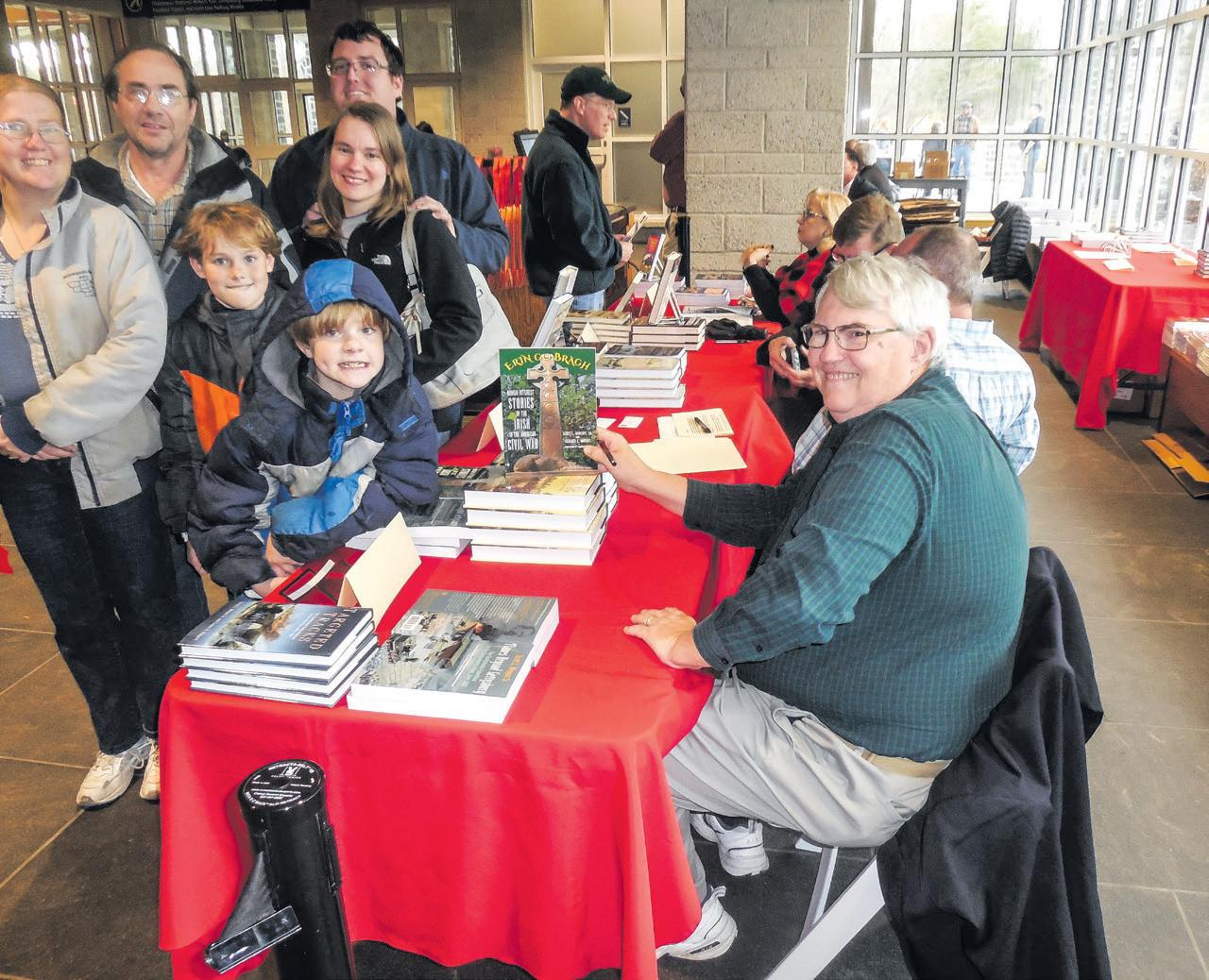
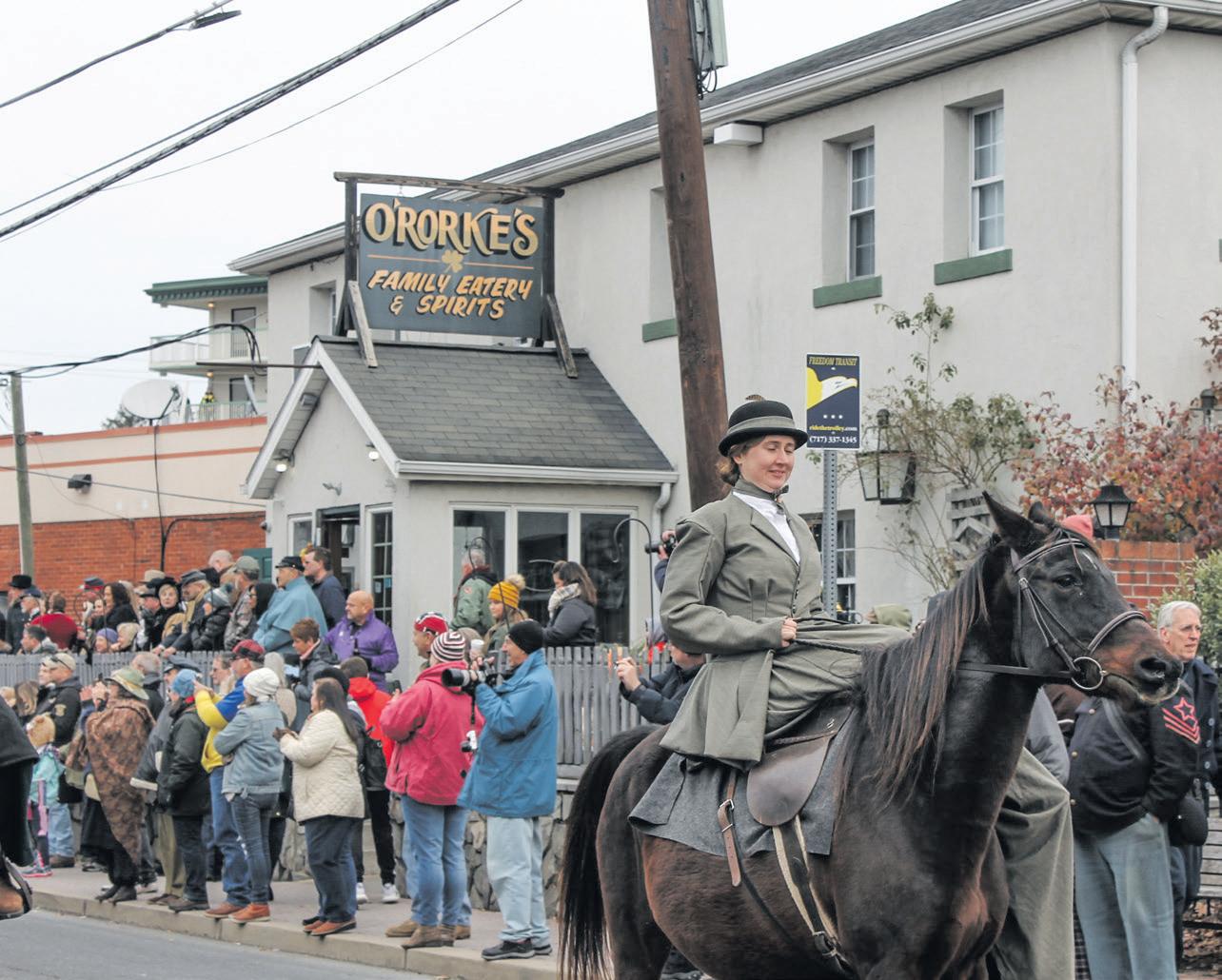

Across the street, is the 73rd Ohio Vol. Inf. Band, doing a concert at O’Rourke’s. A good 75 soldiers are standing around enjoying the music. They asked me to tell you, that their instruments date from around the Civil War.
About 4 p.m. there was just enough time to get to Father Corby’s statue, where the 69th New York Historical Association
was sponsoring a Catholic mass. I arrived just as Father David Moreno of New Rochelle, N.Y., and Father Jerome Lukachinsky of Garfield Heights, Ohio, were beginning the Mass and the heavy rains began. The 69th New York entered Gettysburg with 75 men, and suffered 5 killed, 14 wounded, and 6 missing. My great grandfather joined at age 12, in April 1861, and my son Rich just turned over command of Delta Company. He is now the aidede-camp to the Commanding General, 42nd Division.
My last stop was the Sons of Union Veterans SVR Dance. As I walked in, the first person I see is Brigadier General Shaw, Deputy Commander of the Sons Veterans Reserve. I asked him how this year’s SVR Ball is going, and learned attendance is better than last year. As I walk into the ball room, Mark Day and his wife Barbara met me at the door. Mark is the past Commander and Chief of the SUVCW; he told me, that he was just requested to join Lincoln Generals, as General Ore. Mark is a retired Navy Master Chief and a former American History teacher in Western Virginia.
5 January 2020
War News
Civil
Steve Reilly is a member of the SUVCW, Tilden Camp NYC and the 69th New York Historical Association.
Citizens of Gettysburg.
The Boone family from Iowa, at the NPS Visitor Center and bookstore.
American Civil War Youth March.
by Leon Reed
Over 350 Lincoln scholars and enthusiasts gathered from November 16-18 at Gettysburg’s Wyndham Hotel for the 24th annual Lincoln Forum Symposium. It was the best-attended Lincoln Forum meeting ever, with more than 50 first time attendees. A lengthy list of presenters addressed topics as diverse as causes

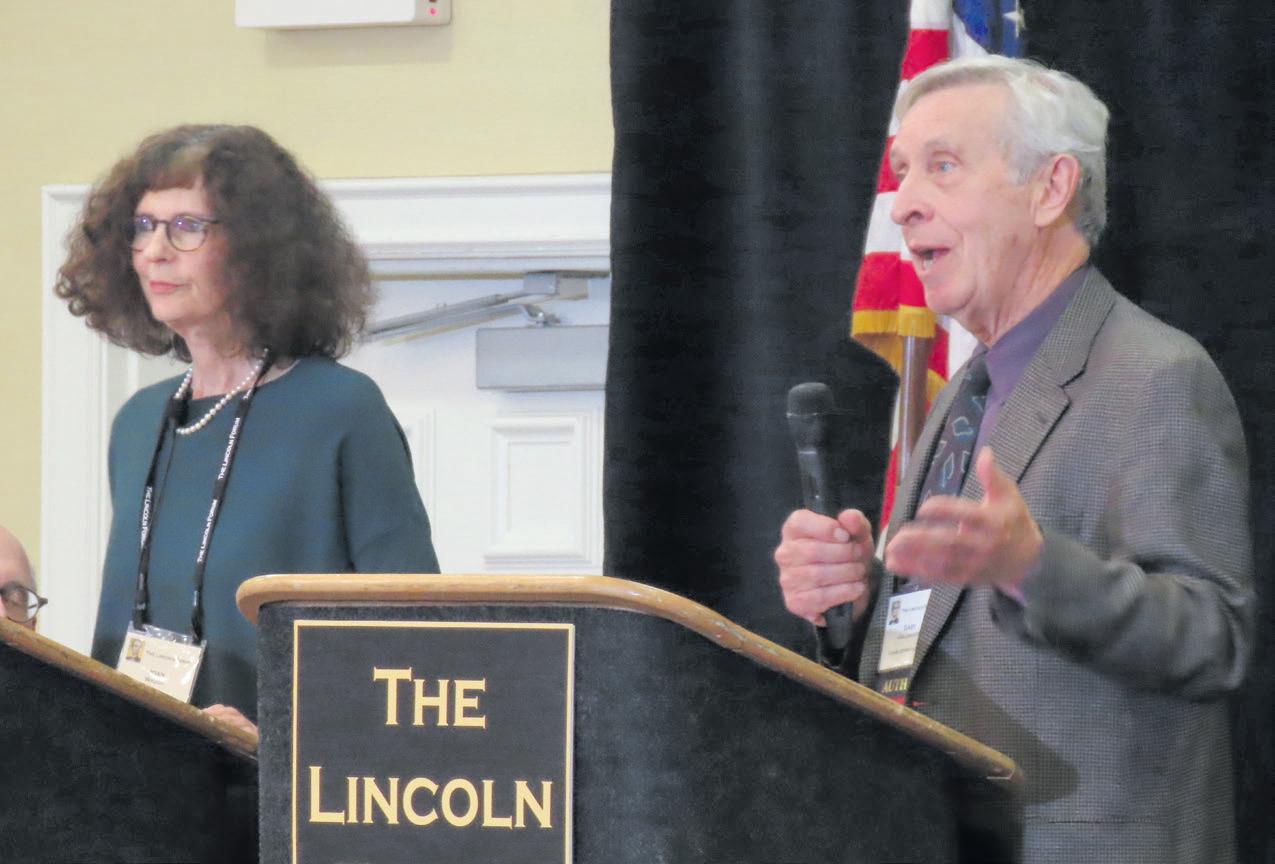
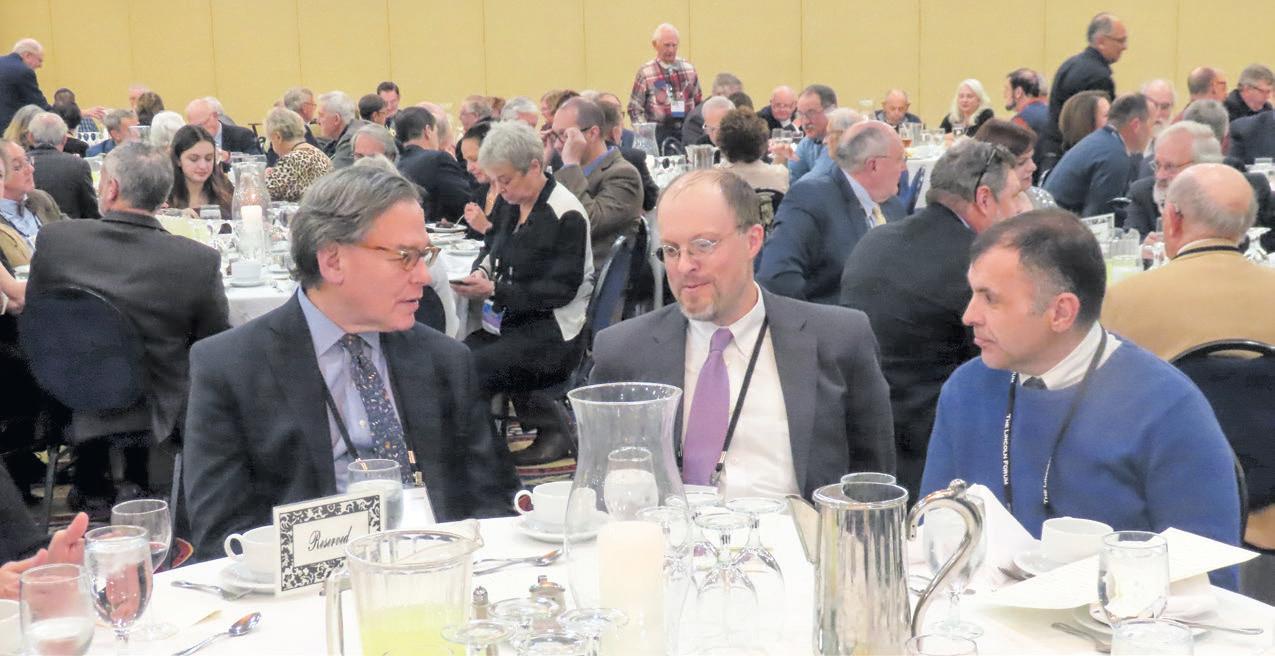
Lincoln Forum Has Largest Attendance And Most First-Timers Ever

majority’s interests. Many northerners, including many soldiers in Lincoln’s army at the start of the war, believed that they were fighting a war for deliverance “to save the southern people from their leaders.” She commented that there was “a widespread belief that we can save the South despite widespread evidence that they did not want to be saved.”
She concluded that it is “clear in hindsight that Lincoln and his allies significantly over-estimated the Unionist support in the South.”
Lincoln’s political leadership. Many speakers addressed Lincoln’s leadership style.

of the Civil War, the 1860 and 1864 elections, and the Civil War navies. Specific examinations of Lincoln included presentations on Lincoln and Union soldiers, Lincoln and the Constitution, and Lincoln’s experiences with death. Present and forward-looking topics included panel discussions on Confederate monuments and the status of the study of Civil War military history.

Lincoln biographer Sidney Blumenthal received the first annual Lincoln Forum book award and presidential biographer and TV commentator Michael Beschloss was given the Richard Nelson Current Award of Achievement. To encourage teaching and learning, the Forum also presented scholarships to students and teachers.
Causes of the War. Many speakers discussed causes of the Civil War. UCLA professor Joan Waugh noted a New York Tribune article that said the United States had become “one nation but two peoples.” She agreed that the Civil War was “an irrepressible conflict” in the words of William Seward’s speech. But UVA professor emeritus Gary Gallagher disagreed that it was inevitable. The North had had “long experience of Southern threats that never came to fruition” and easily could have misjudged the likelihood of secession and Civil War. Even President Buchanan commented that the South had “so
often cried wolf” that it was hard to make people believe it. While concern that Republicans would take action to end slavery was the underlying concern of Southerners, Gallagher pointed out that “Lincoln’s election provoked only 7 states to secede.” The precipitating event for the final secession crisis was the Northern reaction to the attack on Fort Sumter and Lincoln’s call for troop to suppress the rebellion. Waugh commented that “nobody at the time of Lincoln’s call for troops knew what lay ahead; but everyone knew that a threshold had been crossed.” Soldiers. Many people discussed the common soldier in the Civil War. Gettysburg College professor Peter Carmichael commented that historians are fortunate to have “oceanic amounts of material,” including letters, diaries, and other records, but he expressed concern that “if a scholar searches long enough,” some document can be found to “buttress every argument.” He advocated a “case study” approach and made an extended presentation on the two way correspondence between Civil War soldier William Standard and his wife, Jane.
UVA professor Elizabeth Varon explained that the prevalent “slave power” conspiracy theory led many northerners to believe that a small band of conspirators had duped the majority of southerners into supporting secession even though it was against the
Speaking on “Why Lincoln Still Matters,” Howard University professor Edna Greene Medford asserted that Lincoln recognized the importance of the new territories as an outlet for the growing numbers of poor white laborers, quoting Lincoln as saying “the slave states are places for poor people to remove from, not move to … The nation needs these territories.” As a result of this belief, Lincoln was unyielding during the campaign and secession crisis on the issue of extending slavery into the territories.

Yet, in a discussion of Lincoln and the Constitution, Anderson University professor Brian Dirck and Lincoln Forum vice chair Jonathan White observed that Lincoln’s opposition to the Dred Scott decision was almost entirely a legal response. He didn’t advocate any resistance and instead suggested that the solution was to win elections, appoint more amenable Supreme Court justices, and bring a new case.
Greene Medford also pointed out that the period of Lincoln’s presidency was a period of significant legislative achievement, including adoption of the Homestead Act, “which provided an opportunity for land ownership for people who would never have had the chance otherwise,” and the Morrill Act, “which gave many people access to higher education.”

The final night, presidential historian and TV commentator Michael Beschloss contrasted

President Lincoln’s wartime leadership with other wartime presidents such as James Madison (1812), James K. Polk (Mexican), William McKinley (Spanish), Woodrow Wilson (World War I), FDR (World War II), Harry Truman (Korea), and LBJ (Vietnam). Beschloss criticized many wartime presidents for lack of frankness with the American people and for bringing the U.S. into war on false pretenses. He concluded that “I have studied all eight (wartime presidents) closely and none comes close to Lincoln.”
Military history in the present day. A panel of Grant historian John F. Marszalek, historian Elizabeth Varon, and Civil War Times editor Dana Shoaf
6 Civil War News January 2020
Forum Chair Harold Holzer opens the Symposium.
Lincoln reenactor George Buss reads a condolence letter written by President Lincoln.
Gettysburg College professor Peter S. Carmichael.
Presidential biographer Michael Beschloss.
Award winner Sidney Blumenthal speaks with panelists Jonathan White (center) and Brian Dirck (right).
Panelists Joan Waugh and Gary Gallagher discuss causes of the Civil War.
Status of military history panel members John Marszalek, Elizabeth Varon, and Dana Shoaf.
Edna Greene Medford
considered the present-day status of military history. Their presentation stimulated a lively dialogue with the attendees. Professor Varon concluded that scholarship is undergoing a Golden Age, with innovative new interpretations across the entire breadth of the
subject area. All three panelists agreed that there are many indicators of declining interest, such as attendance at Roundtables, participation in re-enactments, and visitation at some historic sites. Varon also expressed concern about the educational
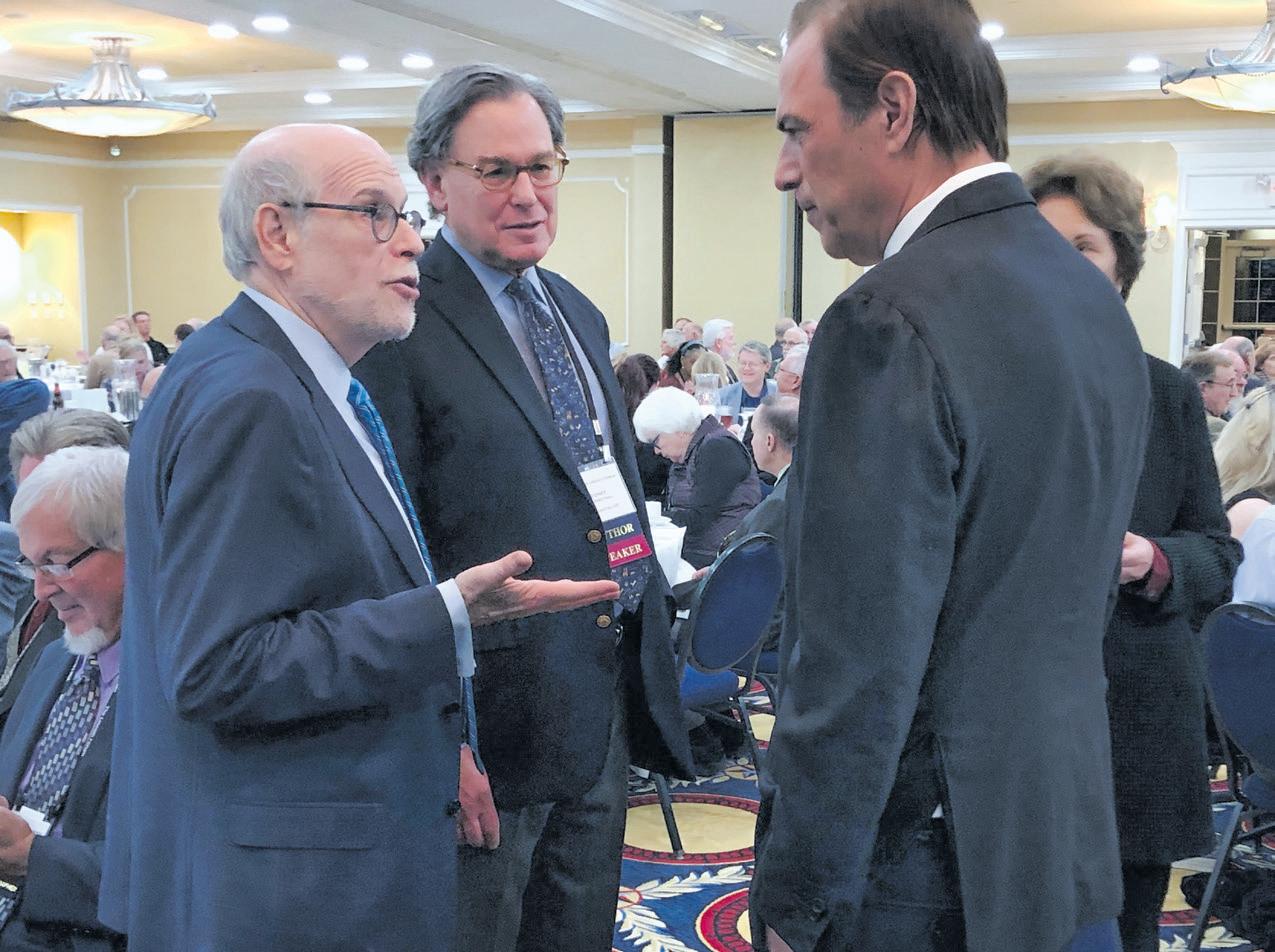

curriculum and the increasing belief among college students that “you have to do something practical.” Shoaf pointed out that not everything indicates a decline in interest. For example, he asserted, and was supported by several reenactors in the audience, that much of the decline is due to time and cost rather than interest in the subject. The panel emphasized that researchers and historic sites need to do more to recognize that young people consume information in different ways; they all agreed that historic sites and
writers need to capitalize more on social media.
Throughout the event, the crowded meeting rooms, lengthy lines to ask questions, or get autographed books, showed that interest in the Civil War remains high in the Lincoln Forum. As the conference was wrapping up, Anderson University (IN) professor Brian Dirck, who spoke on Lincoln and the Constitution and on his recent book, The Black Heavens: Abraham Lincoln and Death, praised the conference. “It is gratifying to be around people
who are literate about the Civil War and who understand that Lincoln remains important to the present day.”

Dana Shoaf, who spoke on a panel about the state of scholarship and interest in military history, said that the Lincoln Forum is “one of the best conferences in the field.” He described it as “vibrant,” “growing,” and said that it “contains a lot of energy.” He agreed that the growing attendance “bodes well for Civil War scholarship.” An expanded, four-day Forum will return to the Wyndham at the same time next year.
Leon Reed is a former congressional aide, defense consultant, and U.S. History teacher. He lives in Gettysburg and writes military history books.
100 Significant Civil War Photographs:


Atlanta Campaign collection of George Barnard’s camera work. Most of the photographs are from Barnard’s time in Atlanta, mid-September to mid-November 1864, during the Federal occupation of the city. With this volume, Stephen Davis advances the scholarly literature of Barnardiana.
$19.95 + $3.50 shipping
128 pages, photographs, maps, bibliography. $19.95 + $3.50 shipping. Softbound. ISBN: 978-1-61850-151-6. www.HistoricalPubs.com.
Order online at www.HistoricalPubs.com or call 800-777-1862

7 January 2020 Civil War News Subscribe online at CivilWarNews.com
Presidential biographer Sidney Blumenthal meets his biographical subject.(Lincoln reenactor George Buss)
Buss, Beschloss, and Forum chair Harold Holzer.
Forum chair Harold Holzer talks with biographers and award winners Sidney Blumenthal and Michael Beschloss.
The American Civil War was the first war in which both sides widely used entrenchments, repeating rifles, ironclad warships, and telegraphed communications. It was also the first American War to be extensively photographed. Mathew Brady, Alexander Gardner and Timothy O’Sullivan are famous for having made iconic photographs in the Civil War’s eastern theater. George N. Barnard deserves to be ranked in this top tier for his photographic work in the war’s western theater. A civilian photographer hired by Gen. William T. Sherman’s chief engineer to take pictures of fortifications around Atlanta, Barnard took several hundred of them in and around the city in the fall of 1864. His most famous is the site of Union Maj. Gen. James B. McPherson’s death in the battle of Atlanta, July 22, 1864. Thus far, no comprehensive, definitive listing has been made of the photographer’s work. The Library of Congress has 130 images; the U. S. Military Academy at West Point, New York, has at least 98 photographs, donated by Captain Poe’s widow. Other repositories, such as the Gilder Lehrman Institute of American History in New York City, have smaller collections. For this book we have chosen a hundred images we deem “significant,” though other students may wonder at some of our selections. We hope that this work will stimulate further interest in Barnardiana, and that other scholarly volumes are yet to come. The Atlanta
STEPHEN DAVIS 100 SIGNIFICANT CIVIL WAR PHOTOGRAPHS ATLANTA CAMPAIGN
Campaign
For more than 20 years, you and I have been part of something exceptional – a movement to build a legacy that will last forever.
Since the first day I stepped into this position as your president, I knew it would be the greatest job I would ever hold. I decided soon thereafter that it would be the last job I would ever hold. My two decades of service as president of this organization have been the best of my career, primarily because I got to work with passionate and generous people like you who care so much about saving our country's incomparable history.
Today, I write to tell you personally that I have decided to retire from my position as the dayto-day president and CEO of the American Battlefield Trust. My health is fine, but I will be 74 years old in March, so this is a natural time in my professional career to make this transition. The Board of Trustees is currently conducting a national executive search to find the strongest possible successor, but I assure you that this transition won't happen overnight. In fact, I have committed to stay on as long as needed to ensure we get the "right person for the job."
While I will miss being at the helm of this extraordinary effort, I am humbled and grateful to

be able to step down, brimming with pride at all you and I have accomplished. Furthermore, you should know that while I may be retiring as president, I have no intention of "leaving" the Trust. While I certainly look forward to having more time to travel and be with my family, I am also excited about remaining on the Board of Trustees as President Emeritus. I will also be available to help and advise the new CEO upon request and participate in the Trust's advocacy efforts with lawmakers and in major preservation efforts. In short, I will be available to help in any way that enhances the mission of this incredible organization, for many years still to come. I fully expect the new CEO will do some things differently, but I assure you on one key point: No one in the Trust leadership sees my retirement as an opportunity to move the organization in a different direction. Our mission remains the same—land preservation and history education— and we still have a lot of work to do.
When I took on this role in 1999, we had preserved 7,000 acres. Since then, thanks to generous patriots like you, our partners and the amazing team here at the Trust, we've grown our membership, broadened our mission, and
forever preserved nearly 52,000 acres of hallowed battlefield land.
Like you, I take immense pride in knowing that we have saved forever these important landscapes, ensuring that future generations can visit and learn from them. In fact, if I'm totally honest, I'm looking forward to having more time to visit these places with my own grandchildren!
The truth is that while I have been the "face" of the organization for nearly 20 years, and leaders generally get credit for victories (and must accept blame for defeats), I consider one of my greatest legacies to be the dedicated Board of Trustees, management team, and staff of the American Battlefield Trust. Without the hard work they do day in and day out, supported by the generosity of tens of thousands of passionate preservationists like you, I could never have made such strides toward accomplishing this mission that means so much to all of us.

I hope you are as proud as I am of all we've achieved together –and a toast, my friend, to the next 20 years!
With deepest gratitude, your obed't serv't,
Jim Lighthizer President American
8 Civil War News January 2020
On Monday, November 4, 2019, Jim Lighthizer — President of the American Battlefield Trust — announced his retirement in the following letter to Trust members and supporters:
Jim Lighthizer (James Salzano)
Battlefield Trust









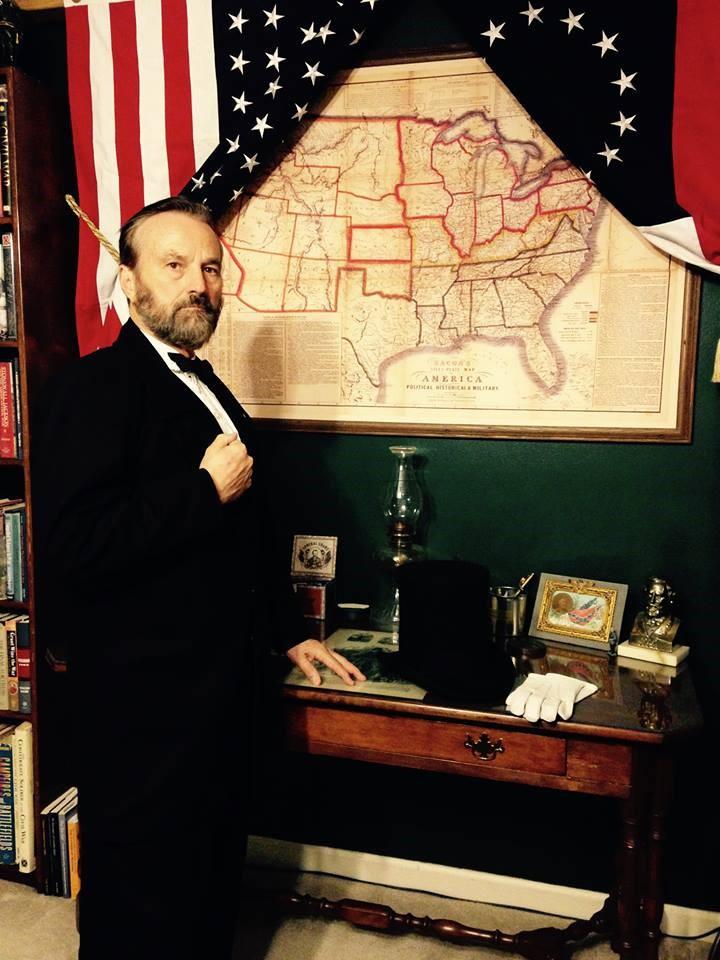
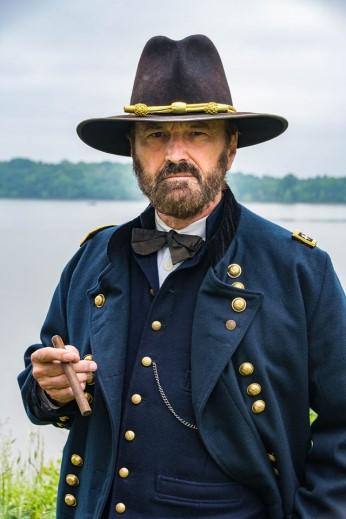
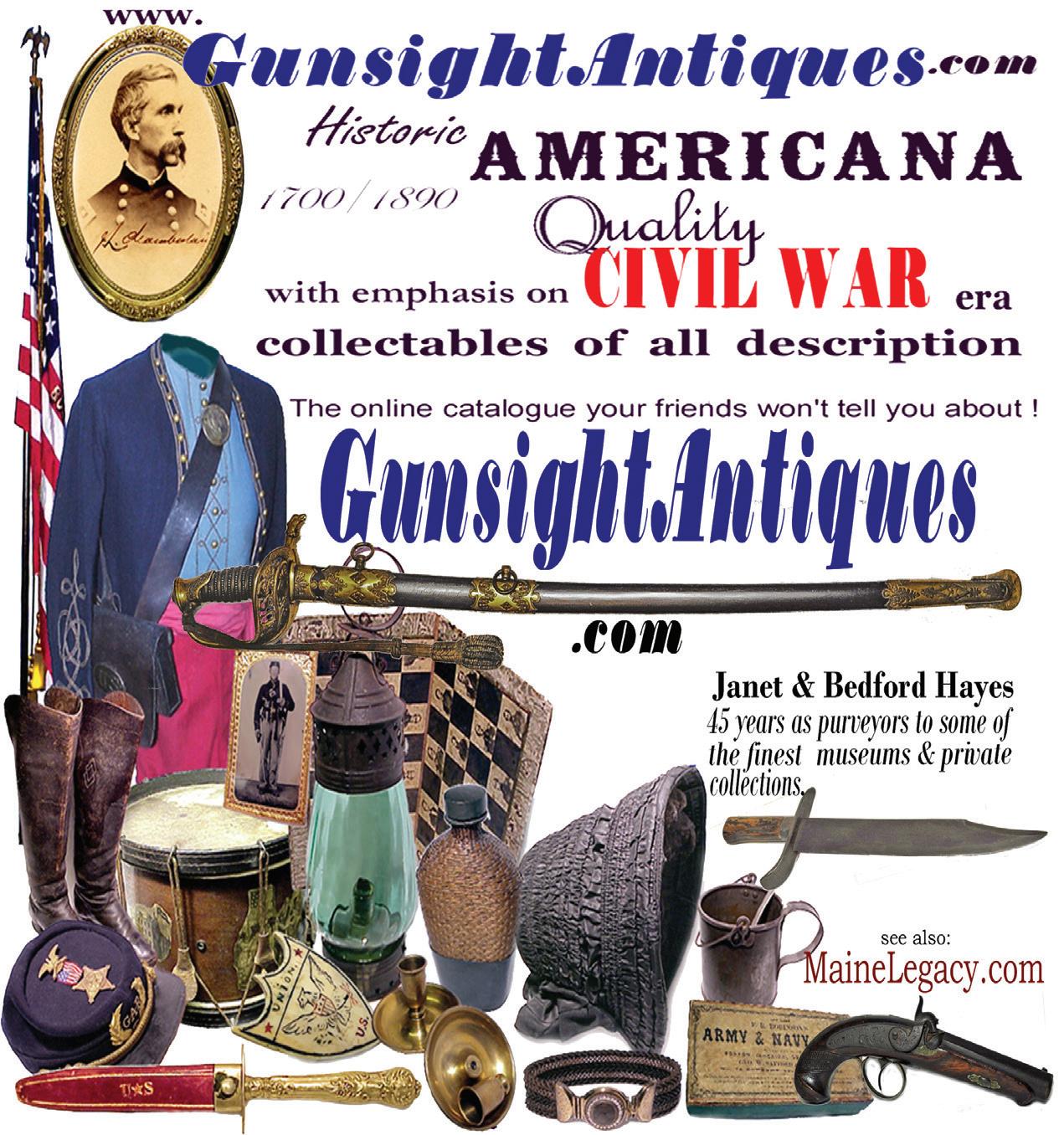
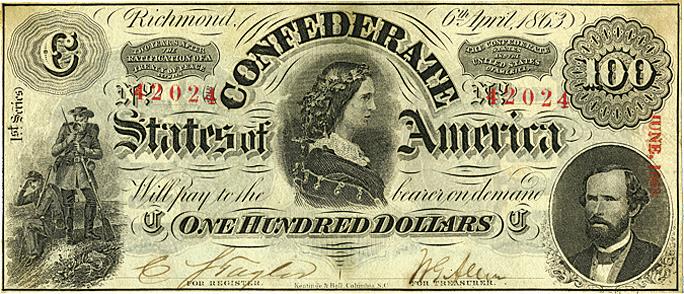
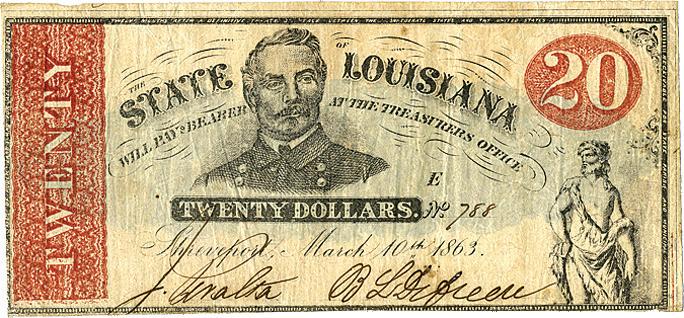

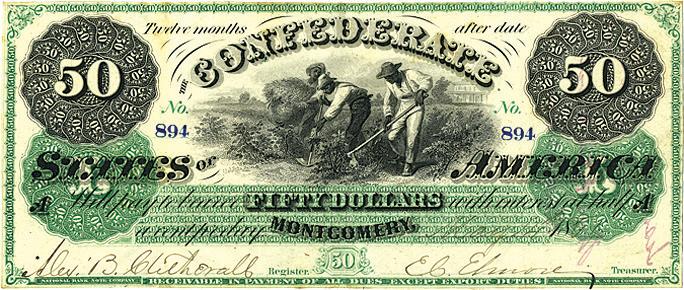
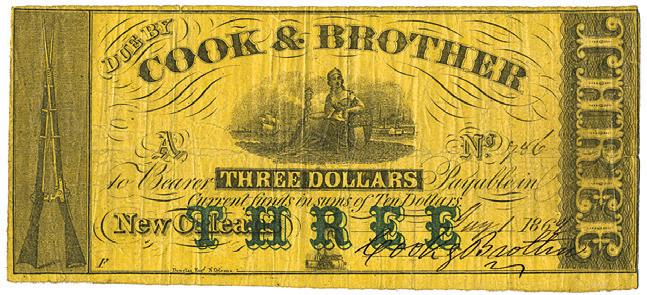
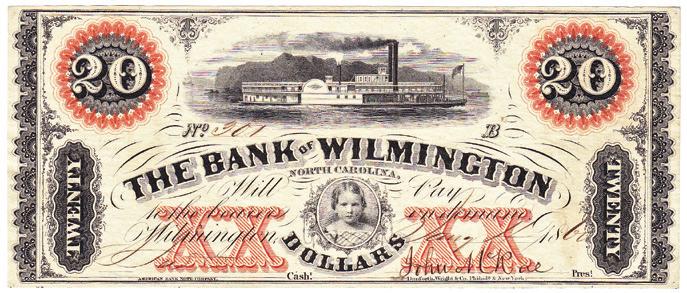
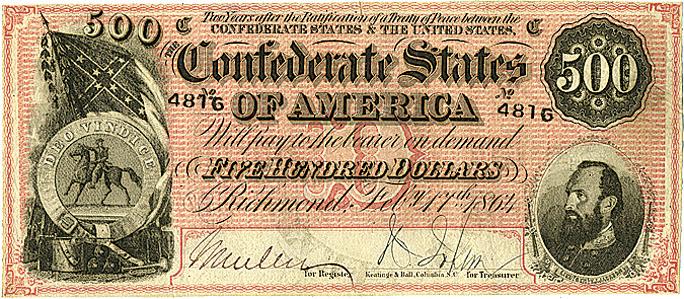













9 January 2020 Civil War News Deadlines for Submissions is the 20th of each month. Email to: ads@civilwarnews.com Greg Ton • P.O. Box 9 • Franklin, TN 37065 901-487-5944 • GTon1@aol.com Greg Ton Buying and Selling the Finest Confederate, Obsolete and Southern States Currency Since 1978 GregTonCurrency.com
Classy Handguns and Stars Over New Jersey




New Pietta Revolvers

Pietta USA, which now owns EMF and is probably the dominant reproduction revolver source, has introduced a new “Deluxe Grande Californian” model revolver. The handgun’s design is based on customer requests coupled with the company’s engraving and engineering artisans, and is Pietta’s vision of a deluxe six shooter based on the classic old Colt Model 1873. The gun is available in both .357 Magnum and .45 Long Colt, and, according to Pietta, “elevates the classic beauty of the original ‘Californian’ to an entirely new level. It is elegantly engraved with a combination of Victorian

scrollwork and sunbursts on the blued barrel and features a deep rich color-casehardened frame accented with a one-piece, diamond checkered grip. Like the rest of the Great Western II line, the Deluxe Grande Californian can be considered one of the most ‘true-to-original’ pistols on the market today.”
Alessandro Pietta, Vice President of Pietta Firearms and CEO of EMF, said: “We’re confident that this will become an instant classic and hopefully an heirloom to be handed down for generations to come.” So, if you are looking for a classy traditional handgun, you might want to check this model out. I am sure we will be seeing “Deluxe Grande Californian” style cap and ball sixguns from Pietta before long. Or maybe they will be called “Deluxe Grade Gettysburgian.”
If your reenactment presentation
 by Joe Bilby
by Joe Bilby
is as a general, or a junior officer who is the offspring of a wealthy family, it might be a must. Speaking of handguns, it might be well to refresh our memories on their use during the Civil War. It could be said that in many cases during the conflict, aside from the cavalry, the revolver was a badge of rank not unlike the sword. Enlisted men who went off to war in 1861 with handguns tucked into their equipage soon got rid of them, either because they were ordered to do so or decided the extra weight on a long march was not worth its potential value in combat. The use of a revolver in combat by an infantry officer was rare enough to be thought worthy of note in letters and diaries. Artillery batteries were issued a limited number of handguns, which were mostly used to shoot mortally wounded horses.

Despite legends in song and story, the handgun has never been a decisive weapon of war, or, for that matter, even a critical one, although from the days of the 16th and 17th century caracole to Alvin York’s trench raid of 1918 and John Basilone’s last ditch defense of Henderson Field in 1942, it has indeed come in handy on a number of tactical occasions.
The most successful users of handguns in the Civil War were guerillas, who usually carried several revolvers (Bloody Bill Anderson had six on him when he was killed in 1864.) and pointed rather than aimed them while delivering a blizzard of bullets in surprise rapid-fire close range shock attacks against an unprepared or tactically compromised foe. There are a number of recorded incidents of this attack mode being used in Missouri and other areas where guerillas were common. These tactics make modern tests of dismounted accuracy at standard targets somewhat moot when judging historical combat effectiveness. The poor sights on a Colt 1860 Army, for example, were no doubt compensated for by the gun’s natural pointing qualities, which were valued far more than bulls eye accuracy.
Stars over New Jersey
If you have an interest in New Jersey history, Civil War history, or, hopefully, both, there is a great new source book that is a must add to your library. The title is Stars Over New Jersey: New Jersey’s Generals and Admirals of the Civil War Era, by John W. Kuhl and Dr. David G. Martin. John is well known as the most knowledgeable collector of Civil War Jerseyana, and Dr. Martin is the author of numerous books on military history.
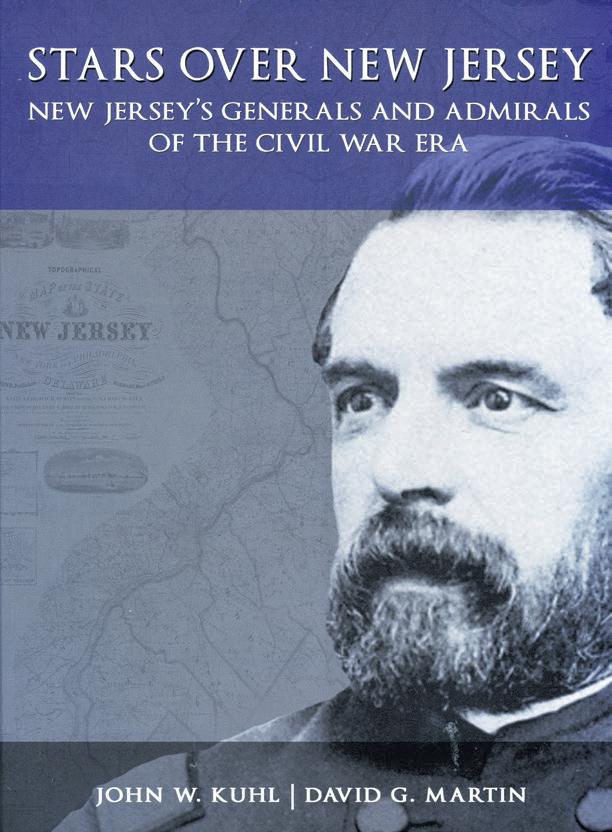
run from one to four pages and all but a few have portraits of their subjects,


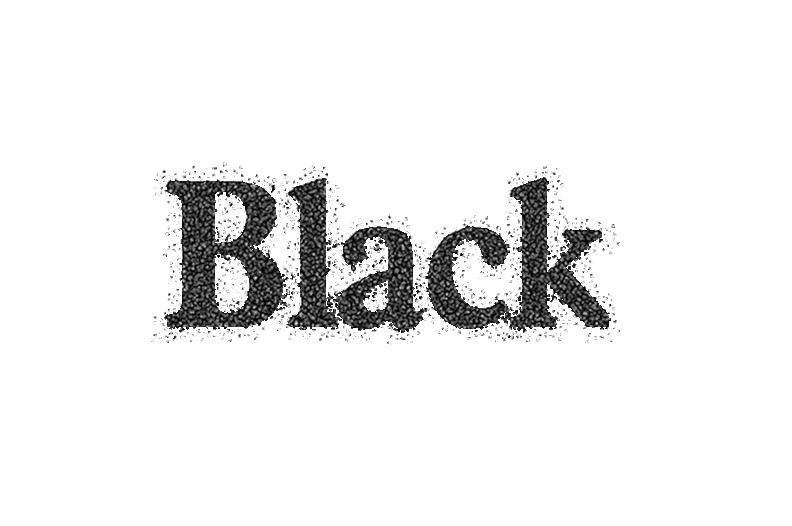
This project has been over twenty years in the making and I was fortunate enough to assist the authors in a small way. The book features collected detailed biographical information not available elsewhere. It is 474 pages long, 8 ½ by 11, with glossy paper, and has detailed indices and a full bibliography. The price is $42 plus $5 shipping; New Jersey residents should add $2.94 sales tax (Discounts are available for libraries). Order from Longstreet House, PO Box 730, Hightstown, NJ 08520. https://www.longstreethouse.com.

Stars Over New Jersey contains 285 biographies of New Jersey’s mid nineteenth century military leaders. It is an expansive effort that not only covers native born New Jerseyans, but officers who lived in New Jersey after the war, and those from outside the state who led Jersey troops. The subjects include seventeen militia generals, all brevet or honorary generals, seventy-four naval officers, and even twenty-eight Confederate officers. The biographies in Stars Over New Jersey
Joseph G. Bilby received his BA and MA degrees in history from Seton Hall University and served as a lieutenant in the 1st Infantry Division in 1966–1967. He is Assistant Curator of the New Jersey National Guard and Militia Museum, a freelance writer and historical consultant and author or editor of 21 books and over 400 articles on N.J. and military history and firearms. He is also publications editor for the N.J. Civil War 150 Committee and edited the award winning New Jersey Goes to War. His latest book, New Jersey: A Military History, was published by Westholme Publishing in 2017. He has received an award for contributions to Monmouth County (N.J.) history and an Award of Merit from the N.J. Historical Commission for contributions to the state’s military history. He can be contacted by email at jgbilby44@aol.com.

10 Civil War News January 2020
Publishers:
Please send your book(s) for review to: CWN Book Review Editor, Stephen Davis 3670 Falling Leaf Lane, Cumming, GA 30041-2087


Comments from Our Readers
“I have read your new Barnard book with great interest and pleasure. It should be in the library of every student of the Atlanta Campaign.”
David Evans
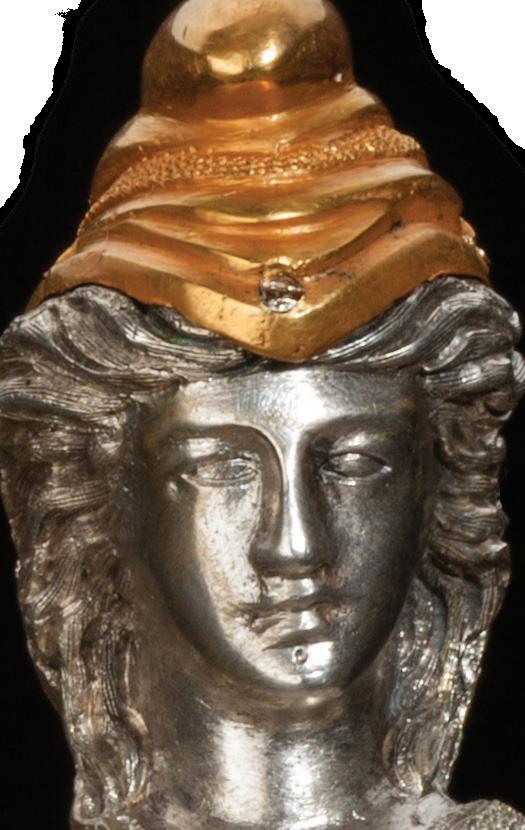
Author of Sherman’s Horsemen: Union Cavalry Operations in the Atlanta Campaign
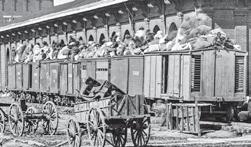
“I applaud Steve Davis’ selection and use of George Barnard’s photographs, which are seen on the printed page all too rarely. Davis takes readers on a visual journey from the earliest days of the Atlanta Campaign to Union capture of the city while zooming into the many details hidden in the depths of Barnard’s glass plate negatives. With introductory information and professionally curated and described photographs, Steve Davis presents a book from which casual Civil War buffs and serious Civil War photography students will benefit.”

Garry Adelman
Vice President, Center for Civil War Photography
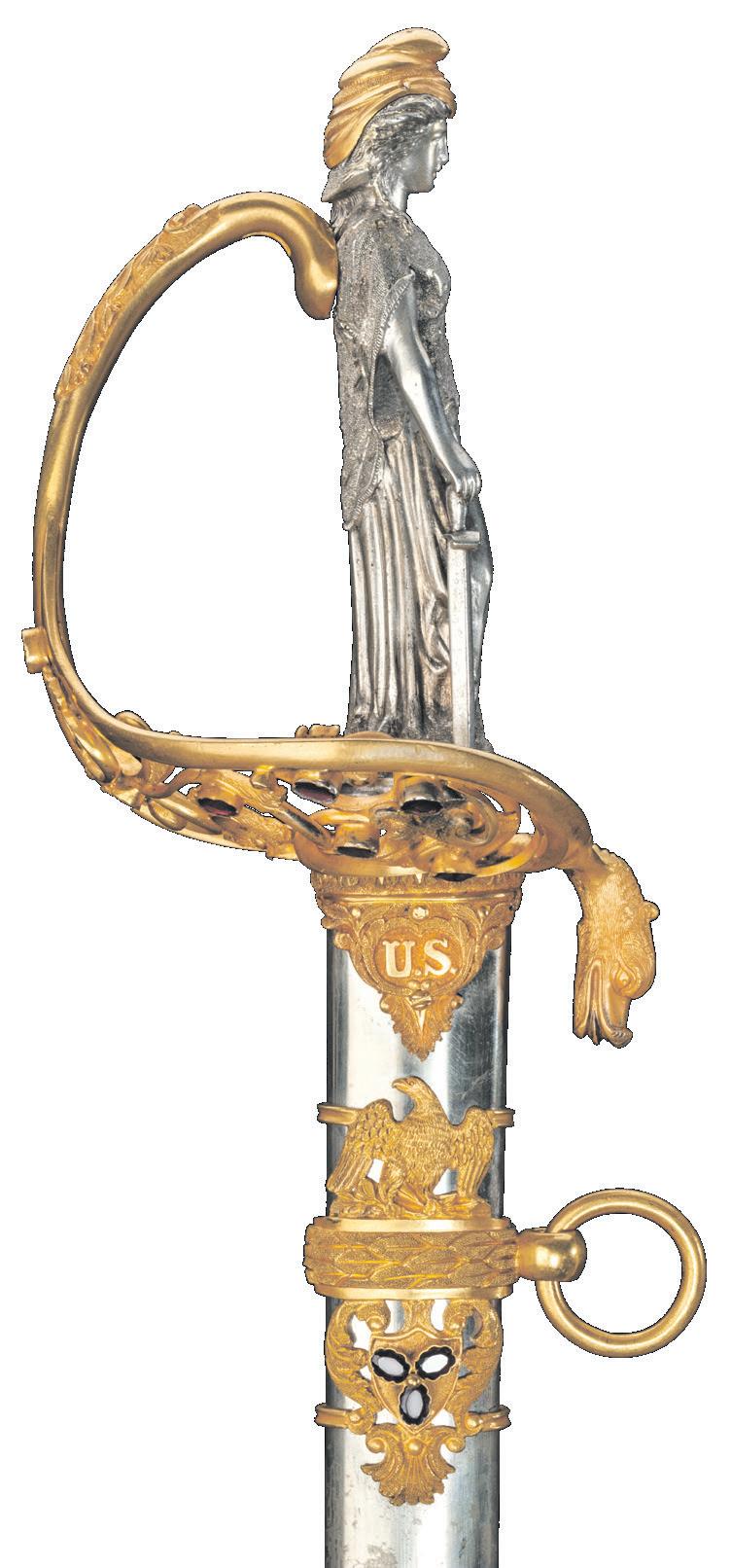
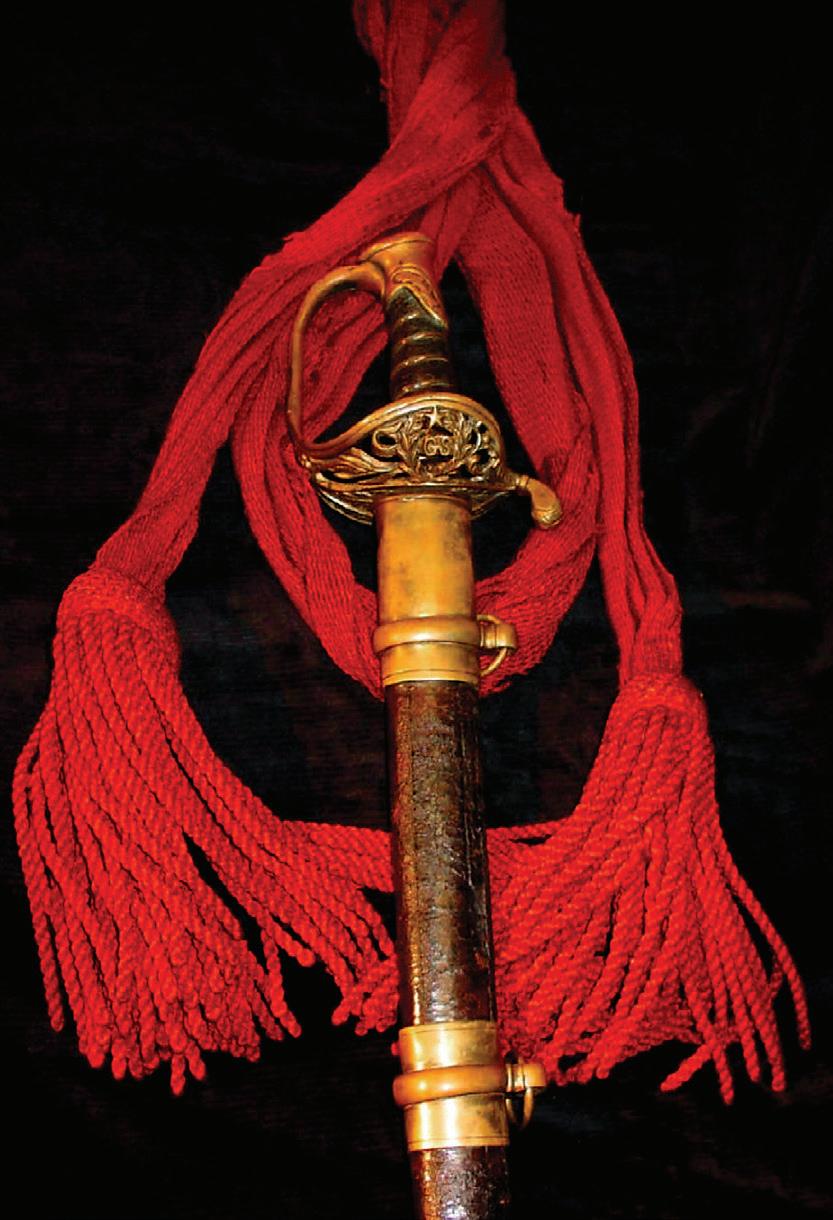



“I’m thrilled with your very crisp, readable, easily grasped-yet-informative book. AND—it has the image quality and detail people love.”
Gordon L. Jones
Senior Military Historian and Curator, Atlanta History Center





“The first thing I look for and see in any volume of Civil War photos is the quality of reproduction, and Stephen Davis’ 100 Significant Civil War Photographs: Atlanta Campaign easily passes that test, with rich and appealing reproductions, many from the original glass negatives. Davis also distinguishes his work by showing many of the fascinating details that emerge only with a closer examination of the images. The study and presentation of Civil War photography has become increasingly specialized and detailed in the past 50 years, and Davis’ book exemplifies that and represents another significant addition to the field.”
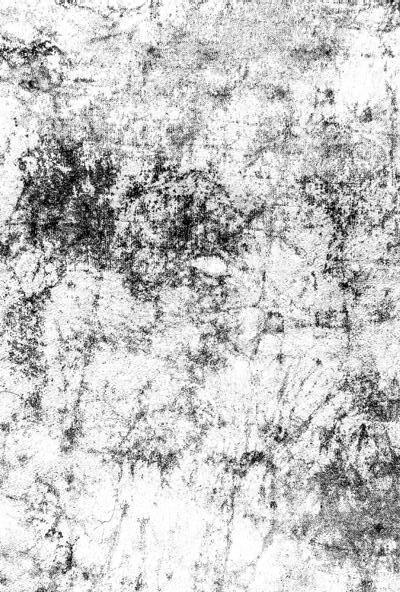
 Bob Zeller President, Center for Civil War Photography
Bob Zeller President, Center for Civil War Photography
“I have a small roller-type book cart next to my desk, where I keep only special reference books, which I frequently consult in my research and writing. This title now has a place on the cart! I congratulate you on an engaging narrative to accompany the photographs you and I treasure. A job well done!”
Michael K. Shaffer, Instructor Kennesaw State University and Emory University, Kennesaw, Ga.
The American Civil War was the rst war in which both sides widely used entrenchments, repeating ri es, ironclad warships, and telegraphed communications. It was also the rst American War to be extensively photographed. Mathew Brady, Alexander Gardner and Timothy O’Sullivan are famous for having made iconic photographs in the Civil War’s eastern theater. George N. Barnard deserves to be ranked in this top tier for his photographic work in the war’s western theater. A civilian photographer hired by Gen. William T. Sherman’s chief engineer to take pictures of forti cations around Atlanta, Barnard took several hundred of them in and around the city in the fall of 1864. His most famous is the site of Union Maj. Gen. James B. McPherson’s death in the battle of Atlanta, July 22, 1864. Thus far, no comprehensive, de nitive listing has been made of the photographer’s work. For this book we have chosen a hundred images we deem “signi cant.” 128 page Paperb ac k: $19.95 (+$3.50 S & H) Ordering

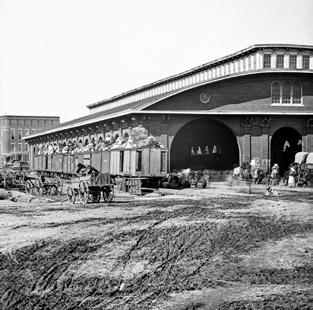

11 January 2020 Civil War News
“The best little book on Barnard”
info: $19.95 plus $3.50 s&h South Carolina residents add 9%
a check to: Historical Publications LLC 520 Folly Road, Suite 25 PMB 379 Charleston, SC 29412 or Order online at www.historicalpubs.com Wrecking Atlanta Northern Engineers Prying Up Track Shadow dating is the practice of timing photograph by studying its shadows. the right—leading one to deduce that this picture was taken on the afternoon of November series of the 1880s. When the men of the 1st Missouri Engineers (oneofPoe’s twoengineerregimentsatAtlanta)sawtheTaberillustration,theyapparentlyrecognized themselves,tothepointofreprintingthedrawingintheirregimentalhistoryof1889with thecaption,“theFirstMissouriEngineersdestroyingarailroadshowingtheuseofhooks made by them for the purpose.” Barnard Under the Microscope for Monday, November 7. Freedpeople on the Boxcars Library of Congress. Congress images bear no captions (as do Poe’s pictures), so students of Barnardiana have to scrutinize the pictures and compare them to others. Peachtree Battery–Another View
sales tax Mail
THE FINEST HISTORICAL ANTIQUE MILITARIA Wallace Markert info@csacquisitions.com 16905 Nash Road • Dewitt, Virginia 23840 804-536-6413 • 804-469-7362 www.csacquisitions.com Buying and Selling The Finest in Americana 11311 S. Indian River Dr. • Fort Pierce, Florida 34982 770-329-4985 • gwjuno@aol.com
Weller Juno
George
A
P53 (Pattern 1853) Enfield
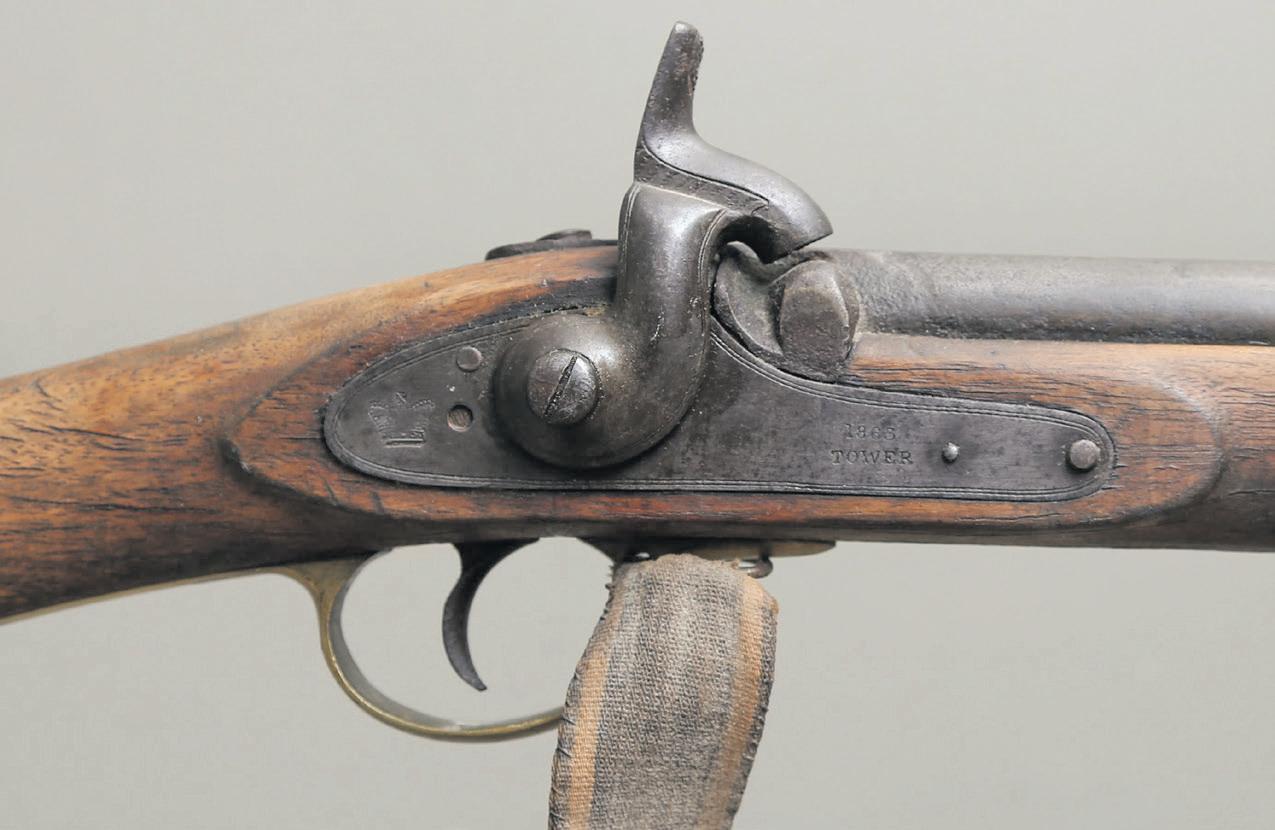
long rifle was recently purchased by a comrade who had questions about its history. It is an interesting piece. It looks like the TOWER and date are engraved further forward on the lockplate than usual. The markings are usually a tad closer to the hammer. The TOWER mark engraved on the lockplate was meant to indicate that the weapon had passed an inspection with gauges at the government facility (called the Tower) on Bagot Street in Birmingham, but this was most often not the case on a military weapon produced for commercial export. The stock behind the trigger guard was marked “Moore and Harris.” What was the firm of Moore and Harris, where we they located and what kinds of guns
did they make?
Moore & Harris was a fairly well known Birmingham commercial gun producer. William Moore began his own business in 1808 and did work making gunstocks for the well-known firm of Joseph Manton in London until about 1820. William Moore also had premises in London and in 1829 opened a stock making operation in the gun quarter of Birmingham at 4 Whittall Street. In 1836 he was made “Gunmakerin-Ordinary” to King William IV of England. This meant that his work was in a higher category than his peers and as such he was chosen as a gun maker for the king. He began a partnership with William Harris in 1838 and began exporting firearms to the United States around this time.
In 1847 William Moore and William Parker Grey, who had been a clerk and later a manager
for the firm of Joseph Manton, went into partnership in London at 78 Edgeware Road where they operated as Wm Moore & Grey. They predominately produced shotguns for sportsmen. It was not uncommon for commercial gun makers to operate several businesses where they could produce just about any sort of firearm and sell to anyone with whom it was legal to do business.
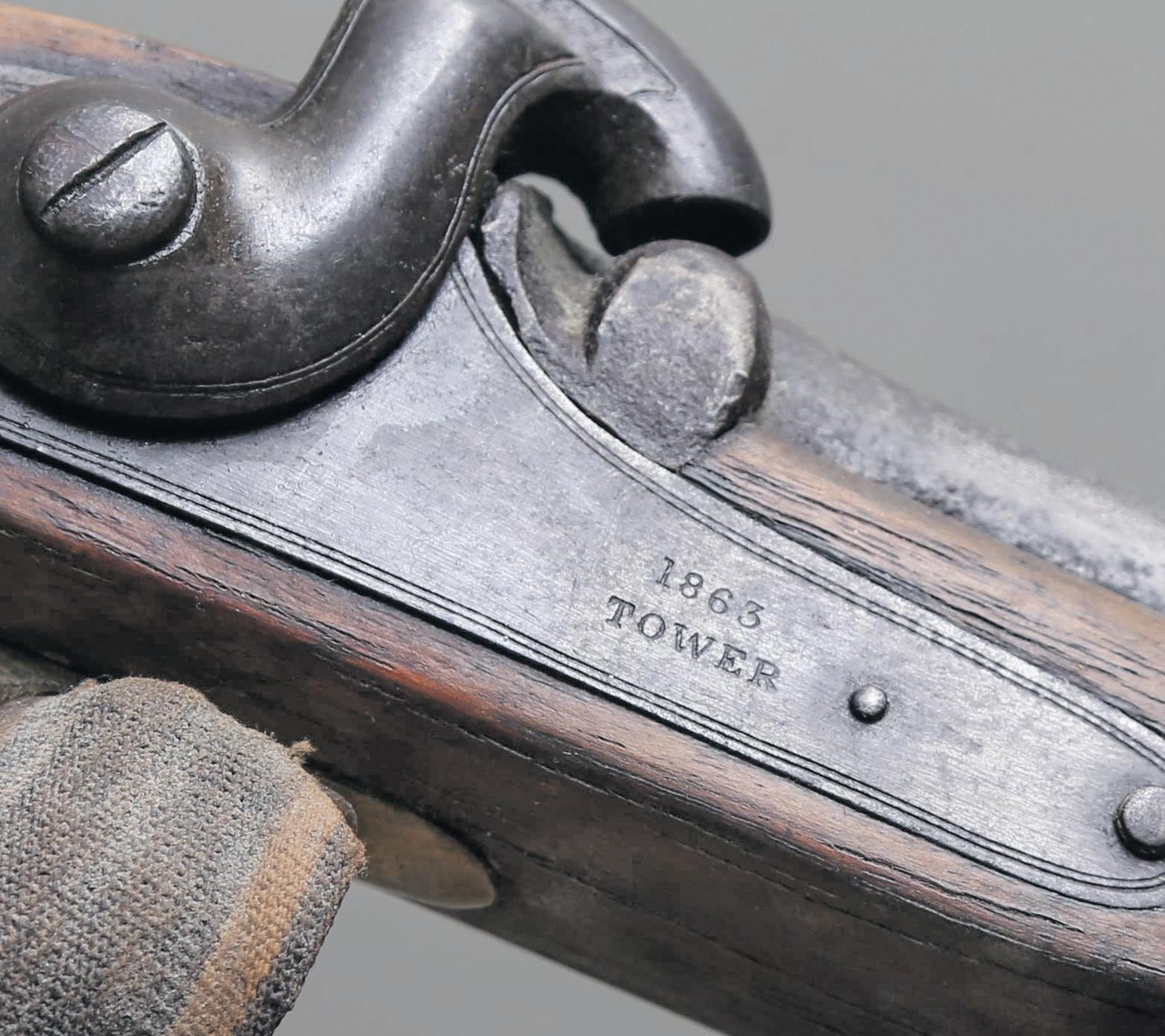

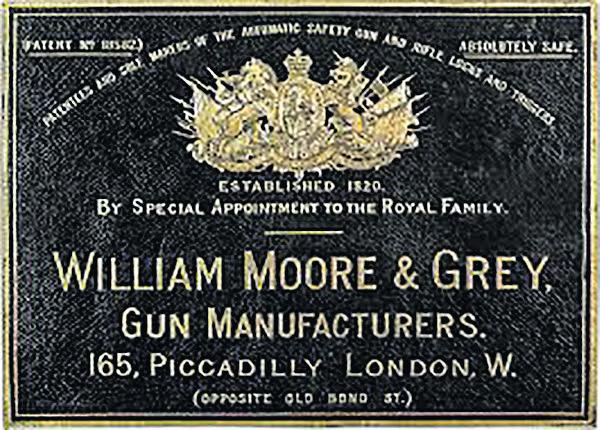

William Harris was recorded in the 1851 census as a master gun maker employing five men. He was living at 38 Great Hampton Street, Birmingham, with his wife Emma, his mother-in-law, and a servant. On October 1, 1852, William Moore and William Harris patented a hinged percussion revolver that was produced in limited quantities. By 1859 Moore & Harris had expanded into barrel and lock making; in 1861 they moved into a large factory known as the Great Western Gun Works at 91 Constitution Hill in Birmingham.
In 1861 Frederick Beesley was apprenticed at the age of 15 to William Grey at William Moore & Co at 43 Old Bond Street. By the middle of 1867 Frederick was coming to the end of his seven year apprenticeship and on January 16, 1869, aged 22, he married Clarissa Cheese, the daughter of a mushroom farmer, at Christ’s Church, Marylebone.
On Monday August 30, 1869, Frederick started work as a stocker for James Purdey the Younger at 314 ½ Oxford Street. Beesley
later opened his own firm producing shotguns and fowling pieces.
The 1861 census record shows William Harris and his wife living at 36 Loveday Street in Birmingham at this time. William Harris is also described in the records as a gun maker. In 1862 the partnership of William Moore and William Harris had a display with both military and civilian sporting guns at the International Exhibition in London. After that, there was a downturn in business in 1864. Perhaps some U.S. Civil War contracts ending could have led to temporary financial problems or it is possible longtime partner William Moore died, no date of death is firmly established; at any rate in 1864 the premises at 91 Constitution Hill (Great Western Gun Works) was sold at auction. Westley Richards joined Moore & Harris in a partnership established to save the firm from closure. The venture failed but because Moore & Harris still had a fairly substantial sporting gun trade and connections in the export business, the operation was bought at auction by W & C Scott & Son.
The firm of Moore & Harris appears to have moved back to London and re-opened retail operations, at least they are known to have been trading in 1867
from a showroom at 2 Long Acre, London. When that operation closed is not known, but it may have lasted up to 1877. William Harris was recorded in the 1871 census as living with wife Emma at 126 Buckingham Palace Road, London, clearly having permanently left the gun quarter of Birmingham. He described himself as the manager of a gun factory. They are not recorded afterwards.
Craig L. Barry was born in Charlottesville, Va. He holds his BA and Masters degrees from the University of North Carolina (Charlotte). Craig served The Watchdog Civil War Quarterly as Associate Editor and Editor from 2003–2017. The Watchdog published books and columns on 19th-century material and donated all funds from publications to battlefield preservation. He is the author of several books including The Civil War Musket: A Handbook for Historical Accuracy (2006, 2011), The Unfinished Fight: Essays on Confederate Material Culture Vol. I and II (2012, 2013) and three books (soon to be four) in the Suppliers to the Confederacy series on English Arms & Accoutrements, Quartermaster stores and other European imports.

12 Civil War News January 2020
Available online at http://booklocker.com/books/9403.html Amazon.com and Barnes & Noble. Hardcover, 534 pages.
Moore and Harris
$39.95
Firearm images courtesy Conny Pressy, images of gumaker placards courtesy WMG London.
1863 TOWER engraved on lockplate.
Lock view of Pattern 1853 Enfield rifle.
The Sage of White Oak, Virginia is Gone
by Robert Lee Hodge
D.P. Newton, the well-known Stafford County, Va., Civil War relic conservator, passed on October 8. He was 66.
His museum, The White Oak Museum, despite its unassuming name that is perhaps reflective of D.P., has an overwhelming collection of Civil War artifacts that was reportedly appraised by The Smithsonian Institution in 1999 at 3.8 million dollars. The dug collection is a sea of soldier-life items, principally from the Federal Army of the Potomac’s 1862-63 winter encampment, a 35-mile-long, log-hut city, where 120,000 troops lived for over four months and generated a great deal of debris that was left behind when the army moved.
D.P. Newton, along with many others in the area, joined the post World War II mine-detecting craze, unearthing a mass of artifacts from Civil War encampments and battlefields. Many “diggers” viewed him as having a gifted talent for finding treasures from the War. Although relic hunters often sold their riches, D.P. never sold an item; however, he would give relics away occasionally.
I first met D.P. Newton on May 11, 1998, when National Park Service Cultural Resources Manager, Noel Harrison, invited me to accompany him and NPS historian John Hennessy to meet the well-known, yet mysterious, man from White Oak.
If we would judge one first by their appearance, D.P.’s shyness and simple demeanor would make many think that he appeared to be slower than most. On the contrary; looks are deceiving. D.P. Newton had the brain of a truly gifted human being. His encyclopedic mind was jaw-dropping to see at work.
D. P. Newton was hypnotic to watch and listen to. He was authentic and homespun, humble, and mannered; adding to this image was his rich Virginia Tidewater accent. D.P. seemed to be more from another time than anyone I ever met.
D.P.’s museum is most impressive; certainly the most impactful historic site I ever stepped foot in. The museum was warm and welcoming, yet had an intense focus, and mixed with a sensory overload of massed Civil War items. The magnitude of all the dug bottles, buckles, buttons, bullets, pipes, shoes, plus soldier art, exhibits on Confederate items, engineering tools, corduroy roads, artifacts from “the punch bowl”, several full-scale in-door and
out-door winter huts, and a handmade full-scale cannon accelerated your pulse.
There are so many impressive items that trigger further thought, from the mundane mustard bottle, to false teeth, to an unidentified gold ring from, of all regiments, the 20th Maine. Not only was the White Oak Museum stuffed with relics from the soil of Stafford County, it was also a huge resource for the written word from the soldiers who lived and fought there. D.P. amassed a huge database regarding the tremendous events that transpired in Stafford County during the Civil War.


As my National Park Service friends and I left White Oak after our first visit, John Hennessy said, “I am not sure what is more impressive, the museum or the man.”
John was onto something. However, over a little time you realized, as much as the White Oak Museum was an amazing historical anomaly, the man was bigger and more inspiring than his creation.
My virgin voyage to the White Oak Museum and meeting D.P. was a watershed moment in my life. There was life before meeting D.P. Newton and life after meeting him; many who have met this soft-spoken country genius often have had the same experience. Immediately after meeting D.P., I was transfixed; he was a
graceful figure that was truly rare. Ego and vanity were the furthest things from his soul. He was somewhat of a cultural apostle. I would often affectionately joke to my Civil War friends that, like Jesus, D.P. Newton was a fisherman and a carpenter. Mr. Newton had an enviable work ethic; akin to the famous Nike commercial;. D.P. “Just Did It”. I wanted to be more like him the moment I met him; he was truly inspirational. Often I would visit the White Oak Museum and walk in to see D.P. answering esoteric questions thrown at him by visitors looking for their Civil War ancestor’s campsite, etc. His genteel slow response was calming and needed in an all-too-often fast-paced world. Time slowed down at the White Oak Museum and it made me thankful for such rare sanctuaries. Visiting DP at the museum was cathartic; it had something that was genuine and hospitable that I craved.
D.P. didn’t talk much, but acted often. A huge part of D.P.’s awe-inspiring life was his focus and quiet determination to build a museum that promoted the history of Stafford County and the neighboring Fredericksburg, Va., area.
I have been to the White Oak Museum probably 50 times, never growing tired of it. Part of the excitement of returning to White Oak and D.P. was to bring a guest
who you knew could appreciate the sage and the place. Watching their excitement as they witnessed the overwhelming collection for their first time was always part of the joy of going to see D.P. and the museum.
Public history academics and museology scholars have looked at D.P.’s efforts at The White Oak Museum with a great deal of respect and awe. Far too often there has been a divide between archaeologists and relic hunters, but D.P. clearly bridged that gap. His curiosity and modest demeanor might be seen in one vignette many of his friends have. When reenactors camping at the museum’s outdoor huts accidentally set fire to one shebang, they panicked, but D.P. only commented that he wished he’d been there to see it burn, just so he could add to his understanding of the burnt hut sites he excavated.
D.P.’s funeral service was conducted in a school auditorium in Stafford where the crowd reached into the several thousands. His casket was draped in a Virginia flag. Various friends and family spoke about the gifted sage of White Oak, with not a dry eye in the crowd. The acclaimed field music of the 2nd Maryland Fifes and Drums, CSA, played D.P.’s favorite music at the auditorium and later at the nearby cemetery. Police agencies attended in massive force.
At the cemetery, on the Second Fredericksburg battlefield, as the 2nd Maryland Fifes and Drums played The Yellow Rose of Texas, Stonewall Jackson’s Way, and Dixie, I looked at D.P.’s Virginia flag-draped coffin, staring at the words “Sic Semper Tyrannis;” realizing the sage was really gone, I wept like a child.
Perhaps it is ironic that D.P. Newton—The Sage of White Oak, Va., a candle in an electric world had as his final statement, that his 4.5-mile long funeral procession along the Jefferson Davis Highway stopped Fredericksburg traffic for tens of minutes, a nearly impossible Herculean task! The people I feel truly sad for are the ones who never had the opportunity to meet D. P. Newton.
13 January 2020 Civil War News
This Ball Is At An End (Battle of Chickasaw Bayou part 1)


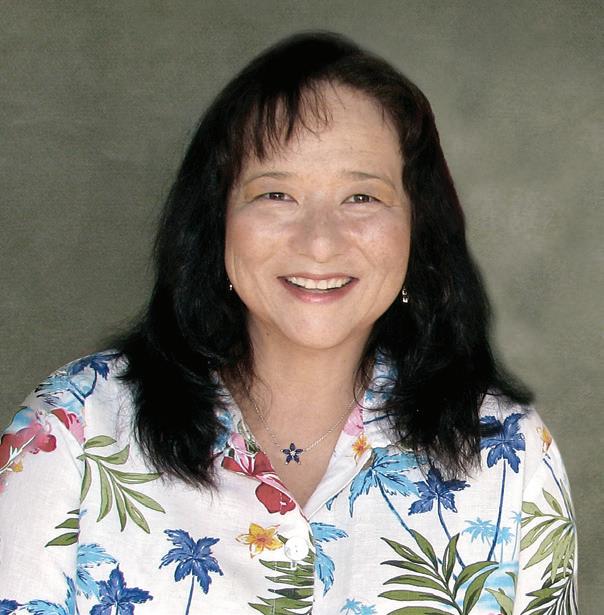
“… Better come out here, I hears a boat a coming. … I hears it say, choo, choo, pat, pat, pat.” – little negro girl
On the evening of Dec. 24, 1862, telegraph operator C.S. Maj. L. L. Daniel was assigned to report boat movements on the Mississippi River, as part of the early warning system for defending Vicksburg, Miss., sixty-five miles downriver. The Federals were unaware of the existence of the private telegraph line of Horace B. Tibbots, a rich planter, twelve miles south of Lake Providence, La.
About 8:45 p.m., alerted to the sounds of boats on the river, Daniel and his companion C.S. Maj. E. P. Earnhearst left their card game to go to the riverbank “… and waited perhaps thirty minutes. We could hear the panting and pat, pat; directly a monster turned the bend, two miles above us, and came slowly as if feeling the way. It was the gunboat. I was ready to send the news to you, [Fall] but no—‘hello Major here cames [sic] another,’ this in a whisper; just then some sparks flew out of the Major’s pipe, and I grabbed the pipe, extinguished the fire, telling him those * * * would fire a volley at the crack of a match. By now, the large black devil was abreast of us, in easy gun shot from our double barrels, but suicide to fire.”
“It was a dark, cloudy night, cold and drizzly; just as soon as we were satisfied the last one was by, I jumped on my little bay filly and fairly flew to the little
telegraph office, three miles back in the woods.” Daniel telegraphed C.S. Col. Phillip H. Fall at De Soto Point, La., across the river from Vicksburg. “Good God, Phil, eighty-one transports loaded with Yankees, and gun- boats galore, passing down the river, and many more behind moving on, … I can see lights as far as the eye can reach up the river.”
It was after midnight when Fall received the wire. Understanding the urgency of the message, Fall, ignoring personal safety, delivered the message within a half hour. He rowed across the river against the high wind and choppy waters. Fall flashed his red signal light to alert the Vicksburg batteries so they would not fire at him, fearing the waves would extinguish his light. Landing, he rushed up to the hilltop home of Dr. William T. Balfour. Balfour was hosting a grand Christmas Eve ball at his mansion. The women were wearing beautiful gowns. The guests, including Confederate officers, were gliding in pairs over the dance floor. Muddy and disheveled, Fall “stopped in front of Gen. [Martin Luther] Smith, he scanned me critically and frowned with the exclamation, ‘Well sir, what do you want?’ I told him eightyone gun boats and transports had passed Lake Providence and were still passing. He turned very pale, and in a loud voice exclaimed, ‘This ball is hereby at an end. The enemy are coming down the river, all non-combatants must leave the city!’”
Both Smith and Gen. John C. Pemberton, commander of the Dept. of Mississippi were Northern career soldiers who had married Southern women. The Confederates were aware that
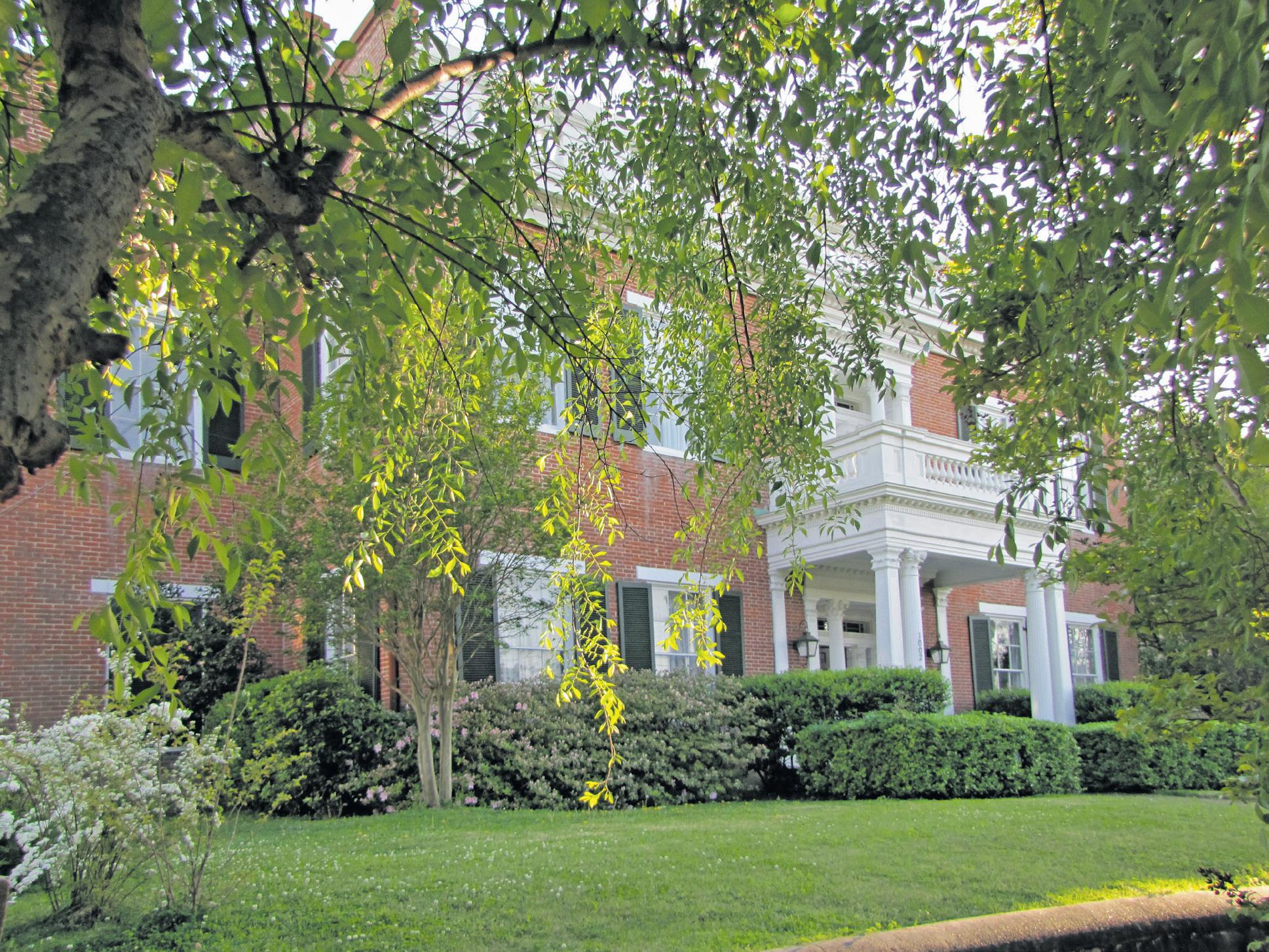
the Federals were determined to return the Mississippi River to its role as the main commerce thoroughfare for the Mid-West. Vicksburg, the “Gibraltar of the West”, located on a high bluff, on a bend in the Mississippi River was an obstacle. A military engineer, Smith designed Vicksburg’s defenses. At intervals for nearly 20 miles, guns lined the bluffs.
On Dec. 19, as part of a morale boosting tour, Confederate President Jefferson Davis and Gen. Joseph E. Johnston, commander of the Dept. of the West inspected Vicksburg’s defenses. During the visit it became clear the three men had different strategies. Johnston felt, “Our great objective is to hold the Mississippi.” Davis believed that


14 Civil War News January 2020
Balfour House.
(© 2010 Robert Berryman)
Gen. Martin L. Smith, CSA, Florida. Colorization © 2019 civilwarincolor.com courtesy civilwarincolor.com/cwn. (Library of Congress)
Panorama of the Vicksburg Battlefield ca. 1910. In the right center is the Illinois Memorial located on Union Avenue. This memorial was dedicated on Oct. 26, 1906. (Library of Congress)
“Vicksburg is the nail head that holds the South’s two halves together.” He and Pemberton wanted to turn Vicksburg into a fortress, differing only on the size of the garrison. Johnston advised a “concentration of forces” and fighting the enemy where they were found. He envisioned a fort with a small garrison. Instead, he found, “an immense intrenched camp, requiring an army to hold it.” Furthermore, all positions were scattered on the high ground “to prevent the bombardment of town, instead of close to the navigation of the river to the

enemy,” to enable the batteries to concentrate fire during a naval attack. Davis responded by wiring the War Department of the “immediate and urgent necessity for heavy guns and long-range fieldpieces at Vicksburg.”

On Christmas day, Smith ordered his men to their positions. The Confederates had already determined five spots the Federals most likely would cross the bayou to reach Vicksburg and sent for reinforcements. Daniel spread the alert, wiring Gen. Edmund Kirby-Smith and others. Between the natural and man-made defenses, the Federals faced a formidable fight.
Instead of attacking Vicksburg’s high bluffs from the water, Gen. William Sherman’s plan was to land at Chickasaw Bayou and work his way towards Walnut Hills, north of the town. On Dec. 24, Sherman’s army loaded on seven gunboats and 59 troop transports arrived at Milliken’s Bend, La. Sherman sent out Gen. Stephen G. Burbidge’s Brigade to cut down telegraph poles and destroy the Vicksburg & Shreveport railroad bridges. Daniel was captured and held for months. The Federals, in retaliation for
Confederates firing on their boats, would leave Milliken’s Bend in flames. The Battle of Chickasaw Bayou, Dec. 26–29, the first battle of the Vicksburg Campaign, began with the Federals landing at Johnson’s plantation, opposite Steele’s Bayou. The Federals outnumbered their foe two to one (30,720 to 13,792). Sherman, who considered surprise instrumental to his attack, did not realize his arrival was already known.
Sources:
• Foote, Shelby. The Civil War: A Narrative: Fredricksburg to Meridan: Vintage Books, 1963



• Lee, Stephen D. “Details of Important Work by Two Confederate Telegraph


Operators, Christmas Eve, 1862, Which Prevented the Almost Complete Surprise of the Confederate Army at Vicksburg”, The Mississippi Historical Society, Vol. VIII, Oxford, Mississippi, 1904
• Taylor, William D. A Fit Representation of Pandemonium: East Tennessee Confederate Soldiers in the Campaign for Vicksburg:
Mercer University Press, April 30, 2007
Stephanie Hagiwara is the editor for Civil War in Color.com and Civil War in 3D.com. She also writes a column for History in Full Color. com that covers stories of photographs of historical interest from the 1850’s to the present. Her articles can be found on Facebook, Tumblr and Pinterest.

15 January 2020 Civil War News The Artilleryman Magazine is a quarterly magazine for enthusiasts who collect and shoot cannons from Rev War to World War II. $34.95/ year. Historical Publications LLC, 520 Folly Road Suite 25 PMB 379 Charleston, SC 29412. 800-777-1862 www.ArtillerymanMagazine.com
"GLORY ENOUGH FOR ALL" www.NCHistoricSites.org/ sher THE 155TH COMMEMORATION OF THE SECOND BATTLE OF FORT FISHER BATTLE REENACTMENTS WITH HUNDREDS OF REENACTORS LIVE ARTILLERY FIRE DEMONSTRATIONS DESCENDANTS' REUNION PROGRAM PERIOD EXHIBITS & GUEST SPEAKERS UNIFORMED REENACTOR DEMONSTRATIONS FORT FISHER MUSEUM AND STAFF PRESENTATIONS FAMILY-FRIENDLY FREE EVENT WHEN Jan. 18th-19th, 2020 10:00am - 4:00pm WHERE 1610 Fort Fisher Blvd. South Kure Beach, NC 28449 CONTACT (910) 251-7340 www.friendsoffortfisher.com
Tools for Searching the National Archives Online
Munden and Henry Putney Beers to serve as compilers. In the preface to this work, the compilers highlight the importance of remembering “…postwar documentation, in its value for Civil War research, often transcends in importance the records of the war period.” The book, totaling 721 pages, contains a wealth of information on the records of Congress, the Judiciary, and the Presidency, as well as the various governmental departments. An appendix, ‘List of Records Groups Containing Federal Records Relating to the Civil War,’ will serve as the focus of this article.
Munden and Beers introduction to the appendix notes the archives contain over 300 record groups, yet “the Federal records in the National Archives and the centers that are important to Civil War research are in 79 record groups.” A listing of these groups, and a brief description of the contents within each follow.
RG 15. Records of the Veterans Administration RG 99. Records of the Office of Paymaster General War Dept.: Office of the Paymaster General RG 21. Records of the District Courts of the United States Judiciary: U.S. District & Circuit Courts Territorial Courts
Dept: Surgeon General’s Office RG 101. Records of the Bureau of Comptroller of the Currency Dept. of the Treasury: Office of Comptroller of Currency Record Group (RG) Record Hierarchy Record Group (RG) Record Hierarchy RG 23. Records of the Coast & Geodetic Survey Dept. of the Treasury: U.S. Coast Survey
RG 104. Records of the Bureau of the Mint Dept. of the Treasury: U.S. Mint & Branch Mints RG 24. Records of the Bureau of Naval Personnel Dept. of the Navy: Bureau of Equipment & Recruiting Bureau of Navigation – In General Office of Detail Chaplain Corps
Page RG 97. Records of the Bureau of Agricultural and Industrial Chemistry Dept. of Agriculture RG 16. General Records of the Dept. of Agriculture Dept of Agriculture RG 98. Records of the U.S. Army Commands War Dept.: Arsenals Military Prisons Cavalry Bureau Territorial Commands & Armies Army Corps Regular Army Regiments Forts, Camps, and Other Army Posts First-Fifth Military Districts RG 19. Records of the Bureau of Ships Dept. of the Navy: Bureau of Construction/Equipment/Repairs Bureau of Construction/Repair Bureau of Steam Engineering Naval Boards & Commissions Office of General Superintendent of Ironclads
Bureau of Yards & Docks – Naval Home Abandoned Lands RG 26. Records of the U.S. Coast Guard Dept. of the Treasury: U.S. Revenue – Cutter Service Light-House Board
RG 107. Records of the Office of Secretary of War War Dept.: Secretary’s Office War Dept. Telegraph Office Canby Claims Commission RG 27. Records of the Weather Bureau War Department: Topographical Bureau Surgeon General’s Office
RG 108. Records of the Headquarters of the Army War Dept.: Headquarters of the Army RG 28. Records of the Post Office Department Post Office Dept.: Office of the Postmaster General Appointment Office Contract Office Finance Office
RG 109. War Dept. Collection of Confederate Records War Dept.: Adjutant General’s Office Military Prisons Record and Pension Office Dept. of the Interior: Secretary’s Office RG 29. Records of the Bureau of the Census Dept. of the Interior: Census Office
RG 110. Records of the Provost Marshal General’s Bureau War Dept.: Provost Marshal General’s Bureau RG 36. Records of the Bureau of Customs Dept. of the Treasury: Customs Service
RG 111. Records of the Office of the Chief Signal Officer War Dept.: Office of the Chief Signal Officer and the Signal Corps RG 37. Records of the Hydrographic Office Dept. of the Navy: Bureau of Navigation – U.S. Naval Observatory and Hydrographical Office
RG 112. Office of the Surgeon General (War) War Dept.: Surgeon General’s Office and the Medical Department RG 39. Records of the Bureau of Accounts Dept. of the Treasury: Office of the Register
RG 118. Records of the U.S. Attorneys & Marshals Office of the Attorney General: U.S. Attorneys & Marshals RG 41. Records of the Bureau of Marine Inspection & Navigation Dept. of the Treasury: Office of the Register Customs Service Steamboat-Inspection Service
Next month: a look at the Confederate Record Groups in the National Archives.
Until then, good luck in researching the Civil War!
Michael K. Shaffer is a Civil War historian, author, lecturer, instructor, and a member of the Society of Civil War Historians,

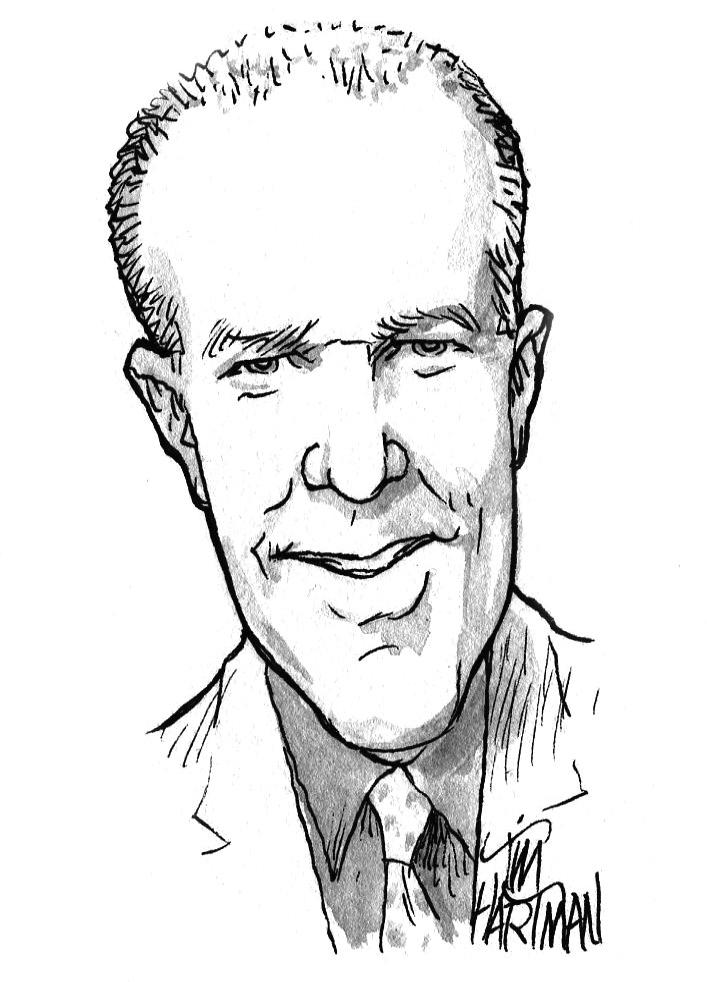
RG 105 Records of the Bureau of Refugees, Freedmen, and Abandoned Lands Dept. of the Treasury: Special Agencies War Dept.: Bureau of Refugees, Freedmen, and Page 2 of 6
RG 121. Records of the Public Buildings Admin. Dept. of the Treasury: Office of Solicitor of Treasury Office of Supervising Architect
the Historians of the Civil War Western Theater, the Georgia Association of Historians, and the Georgia Writers Association. Readers may contact him at mkscdr11@gmail.com, or to request speaking engagements, via his website www.civilwarhistorian.net. Follow Michael on Facebook www.facebook. com/michael.k.shaffer and Twitter @ michaelkshaffer.
16 Civil War News January 2020
1 of 6 Record Group (RG) Record Hierarchy Record Group (RG) Record Hierarchy RG 11. General Records of the United States Government RG 94. Records of the Adjutant General’s Office War Dept.: Adjutant General’s Office Inspector U.S. Military Academy Surgeon General’s Office & the Medical Dept. Office of the Judge Advocate Office of the Provost Marshal Bureau of Refugees, Freedmen, and Abandoned Lands War Records Office RecordandPensionOffice CommissiononClaimsofOfficers and Men,Western Dept. AmericanFreedmen’sInquiry Commission SlaveClaimsCommissions CommissiononCorruptPracticesin the South CommissiononEnlistmentof GermansasSubstitutes CommissiononRewardsfor ApprehensionofLincolnAssassins and Others TerritorialCommandsandArmies ArmyCorps VolunteerRegiments OfficeoftheAttorneyGeneral: Pardon Clerk U.S.ChristianCommission
War
Last month in this column, readers learned of the recent online enhancement offering Optical Character Recognition (OCR) searches of the various Record Groups in the National Archives. A few offline tools exist, which will enable researchers to target their online searches. First up, Guide to the Federal Archives Relating to the Civil War. For this 1962 publication issued during the centennial commemoration, the National Archives tapped Kenneth W. Dept. of the Interior: Pension Office
Remember to check WorldCat http:// www.worldcat.org for help in finding the Guide to the Federal Archives Relating to the Civil War in a local library; conduct your search using the book’s title, and also check for reprint editions from 1986 and 2005. Review additional information on this resource at https://www.archives.
gov/publications/finding-aids/guides. html#civilwar.
Civil War News


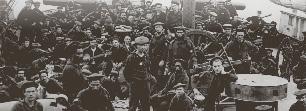
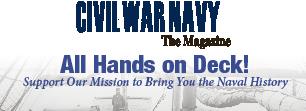
17 January
2020
Page 3 of 6 Record Group (RG) Record Hierarchy Record Group (RG) Record Hierarchy RG 42. Records of the Office of Public Bldgs. & Public Parks of the National Capital Dept. of the Interior: Office of the Commissioner of Public Bldgs. Memorialization Agencies RG 123. Records of the U.S. Court of Claims Judiciary: U.S. Court of Claims RG 45. Naval Records Collection of the Office of Naval Records & Library Dept. of the Navy: Secretary’s Office Bureau of Navigation – U.S. Naval Observatory and Hydrographical Office Chaplain Corps Bureau of Ordnance Bureau of Steam Engineering Bureau of Yards & Docks Naval Boards & Commissions Office of Superintendent Ironclad Gunboats Squadrons & Flotillas Navy Yards & Naval Stations RG 125. Records of the Office of the Judge Advocate General (Navy) Dept. of the Navy: Secretary’s Office – Office of the Solicitor and Naval Judge Advocate General Naval Boards and Commissions RG 46. Records of the U.S. Senate Congress Joint Standing Committees Joint Select Committees Senate RG 127. Records of the U.S. Marine Corps Dept. of the Navy: U.S. Marine Corps RG 48. General Records of the Dept. of the Interior Dept. of the Interior Secretary’s Office Washington Aqueduct Office U.S. Penitentiary for the District of Columbia RG 128. Records of Joint Committees of Congress Congress: Joint Standing Committees Joint Select Committees RG 49. General Records of the Bureau of Land Management Dept. of the Interior General Land Office Census Office RG 130. Records of the White House Office Presidency RG 50. General Records of the Treasurer of the United States Dept. of the Treasury Office of the Treasurer of the United States RG 149. Records of Government Printing Office Dept. of the Interior: Office of Superintendent of Public Printing RG 52. Records of the Bureau of Medicine and Surgery Dept. of the Navy Bureau of Medicine and Surgery RG 153 Records of the Office of the Judge Advocate General (Army) War Dept.: Bureau of Military Justice Office of the Assistant Judge Advocate General Page 4 of 6 Record Group (RG) Record Hierarchy Record Group (RG) Record Hierarchy RG 53. Records of the Bureau of the Public Debt Treasury Dept. Office of the Register RG 156. Records of the Office of the Chief of Ordnance War Dept.: Office of the Chief of Ordnance and the Ordnance Dept. Military Prisons Commission on War Claims at St. Louis Commission on Ordnance Claims and Contracts RG 56. General Records of the Dept. of the Treasury Dept. of the Treasury Secretary’s Office Special Agencies U.S. Purchasing Agents Commissioners of Claims RG 159. Records of the Office of the Inspector General War Dept.: Office of the Inspector General RG 58. Records of the Internal Revenue Service Dept. of the Treasury Office of Internal Revenue State Direct Tax Commissions RG 167. Records of the National Bureau of Standards Dept. of the Treasury: Office of the Superintendent of Weights and Measures RG 59. General Records of the Dept. of State Dept. of State Departmental Records War Dept. Commissions to Investigate Political Imprisonment RG 181. Records of Naval Districts and Shore Establishments Dept. of the Navy: Bureau of Navigation – U.S. Naval Academy Navy Yards & Naval Stations RG 60. General Records of the Dept. of Justice Office of Attorney General Dept. of the Interior: Secretary’s Office RG 185. Records of the Panama Canal Panama Canal Railroad Co. RG 66. Records of the Commission of Fine Arts Memorialization Agencies RG 192. Records of the Office of the Commissary General of Subsistence War Dept.: Office of the Commissary General of Subsistence RG 71. Records of the Bureau of Yards and Docks Dept. of the Navy: Bureau of Yards and Docks Naval Boards and Commissions RG 203. Records of the Office of the Chief of Finance (War) War Dept.: Secretary’s Office RG 74. Records of the Bureau of Ordnance Dept. of the Navy: Bureau of Ordnance RG 204. Records of the Office of the Pardon Attorney Office of the Attorney General: Pardon Clerk RG 75. Records of the Bureau of Indian Affairs Dept. of the Interior: Office of Indian Affairs RG 205. Records of the Court of Claims Section (Justice) Office of the Attorney General: Assistant Attorney General for Claims Cases RG 76. Records of the Boundary & Claims Commissions and Arbitrations Dept. of State: Claims Commissions and Courts RG 206. Records of the Solicitor of the Treasury Dept. of the Treasury: Office of the Solicitor of the Treasury Page 5 of 6 Record Group (RG) Record Hierarchy Record Group (RG) Record Hierarchy RG 77. Records of the Office of the Chief of Engineers War Dept.: Engineer Bureau Topographical Bureau District Engineer Offices Defenses of Washington Inspector of U.S. Military Academy RG 217. Records of the General Accounting Office Dept. of the Treasury: Office of the First Comptroller Office of the Second Comptroller Office of the Commissioner of Customs Office of the Register Office of the First Auditor Office of the Second Auditor Office of the Third Auditor Office of the Fourth Auditor Office of the Fifth Auditor Office of the Auditor of the Treasury for the Post Office Dept. State Direct Tax Commissions War Dept.: Western Gunboat Fleet Office of Paymaster General Office of Commissary General of Subsistence Commission on War Claims at St. Louis Commissioners on Emancipation in the District of Columbia RG 78 Records of the Naval Observatory Dept. of the Navy: Bureau of Navigation – U.S. Naval Observatory & Hydrographical Office Nautical Almanac Office RG 231. Records of the U.S. Soldiers Home U.S. Soldiers Home RG 79. Records of the National Park Service Chesapeake and Ohio Canal Co. Memorialization Agencies RG 233. Records of the U.S. House of Representatives Congress: Joint Select Committees House of Representatives RG 84. Records of the Foreign Service Posts of the Dept. of State Dept. of State: Foreign Service Posts RG 241. Records of the Patent Office Dept. of the Interior: Patent Office RG 87. Records of the United States Secret Service Dept. of the Treasury: Office of Solicitor of the Treasury –Secret Service Division RG 249 Records of the Commissary General of Prisoners War Dept.: Office of the Commissary General of Prisoners Office of the Commissioner for Exchange of Prisoners RG 90. Records of the Public Health Service Dept. of the Treasury: Marine Hospital Service RG 267. Records of the Supreme Court of the U.S. Judiciary: Supreme Court Record Group (RG) Record Hierarchy Record Group (RG) Record Hierarchy RG 92. Records of the Office of Quartermaster Gen. War Dept.: QG’s Office & QM Dept. Office of Paymaster General Office of Commissary Gen. of Subsistence U.S. Military Telegraphs U.S. Military Railroads Cavalry Bureau RG 318. Records of the Bureau of Engraving & Printing Dept. of the Treasury: National Currency Bureau – First Division RG 351 Records of the Government of the District of Columbia Dept. of the Interior: Metropolitan Police
Capital of the Confederacy Civil War Show has Increased Attendance

RICHMOND, Va.—The Capital of the Confederacy Civil War Show held in Richmond, Va., is one of the oldest collector shows in the country, having just celebrated its 39th consecutive year. Mike Kent of MK Shows has managed the show for the Central Virginia Civil War Collectors Association for the past 11 years and is proud to state that the show is going strong, filling the hall with vendors and enthusiasts, and keeping the hobby and business of Civil War collecting alive and well.
This year’s event, held on November 16 & 17 at the Richmond Raceway Complex, was a success with the same number of dealer tables sold as last year and a 5% increase in attendance. Buying was strong according to many dealers and that activity seemed evenly divided among weapons, artifacts, books, documents, and memorabilia.

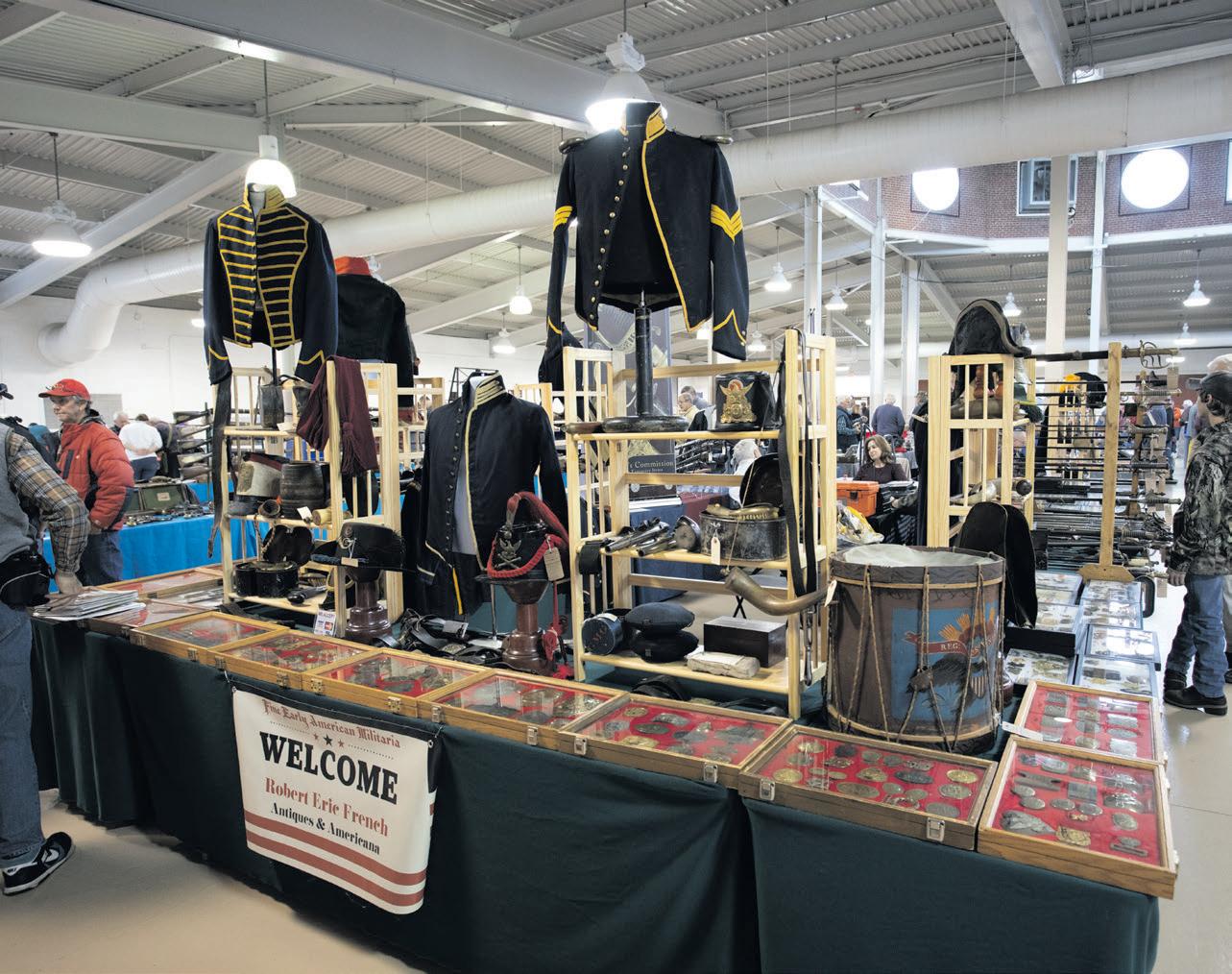


Although the Capital of the Confederacy Show is the smallest of three Civil War events sponsored by MK Shows, it often acts as an indicator as to how the larger shows at Franklin, Tenn., and Dalton, Ga., will fare later in the year. Kent predicted that a good, positive vibe, the room buzzing with activity and numerous reports of strong sales and purchases at the end of the weekend all bode well for the Franklin
Show on December 7 & 8 and the Dalton Show on February 1 & 2.


“We are fortunate to be able to continue to fill all tables at our shows and continue to have a robust gate that keeps the dealers coming back year after year” said Kent. He continued “that as our dealer base ages and we lose one or two dealers every year due to age and illness issues, some younger dealers are stepping up to the plate and reserving an extra table or two. In many cases this is driven by purchases of collections by younger dealers from their elders who are getting out of the hobby. This process benefits the seller, who gets a fair price from a knowledgeable dealer; the buyer who gets a fresh collection that hasn’t been on the market before and the industry as a whole as enthusiasts are exposed to new, fresh material. Taken together, this process keeps the hobby alive and vibrant.”
Like most shows, this one had several displays put together by dedicated individuals who often funnel their time, effort, and money into specialized collecting niches to gather the best of the best and then bring it out for the public to see. Unless you are a collector and displayer, it is difficult to understand the effort required to store, transport, set up, take down, insure, label, and research such a project, for
Deadlines for Advertising or
is
no monetary gain. Such actions are truly a labor of love and we are fortunate the following individuals brought their spectacular award winning displays.
CDR Gerald Roxbury, USN Retired, was the winner of the Best in Show award for his display entitled “A Cut Above –Presentation Pattern 1852 Naval Officer’s Swords” that included 16 swords with scabbards and a wealth of information on each sword and its original owner.
Bill Thompson won the Award for Historical Significance for his stunning display entitled “Colt Revolvers Identified to Civil War Soldiers,” a collection that obviously took many years to acquire and research.
Last but not least was Chris Trimble who brought out his extremely rare identified 2nd U.S. Sharpshooters Service captain’s uniform and full sized tintype which was a crowd favorite.
As always the show had to contend with traffic jams and road closures due to the Richmond Marathon, cold weather, and other events being held simultaneously at the Richmond Raceway. The Capital of the Confederacy Civil War Show prevailed again however and is already making plans for its historic 40th annual show on November 14 & 15, 2020. Don’t miss it!
18 Civil War News January 2020
Editorial Submissions
the 20th of each month.
to: ads@civilwarnews.com
Email
Central Virginia Battlefield Trust does a great job of protecting our hallowed ground.
Vin Caponi doing one of his many deals over the weekend.
Bob French’s sale tables. Bob is from Maine wouldn’t miss the Capital of the Confederacy Show!
Subscribe online at CivilWarNews.com
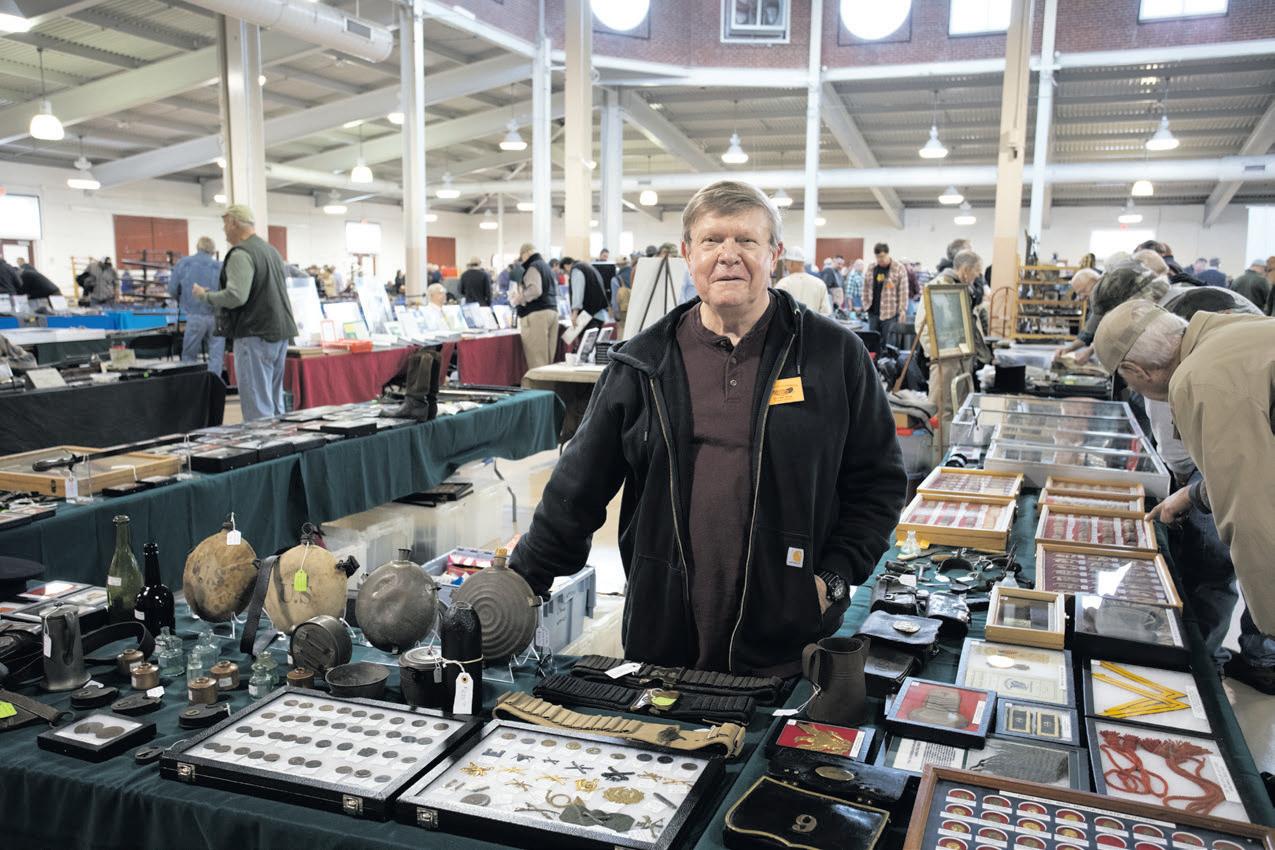


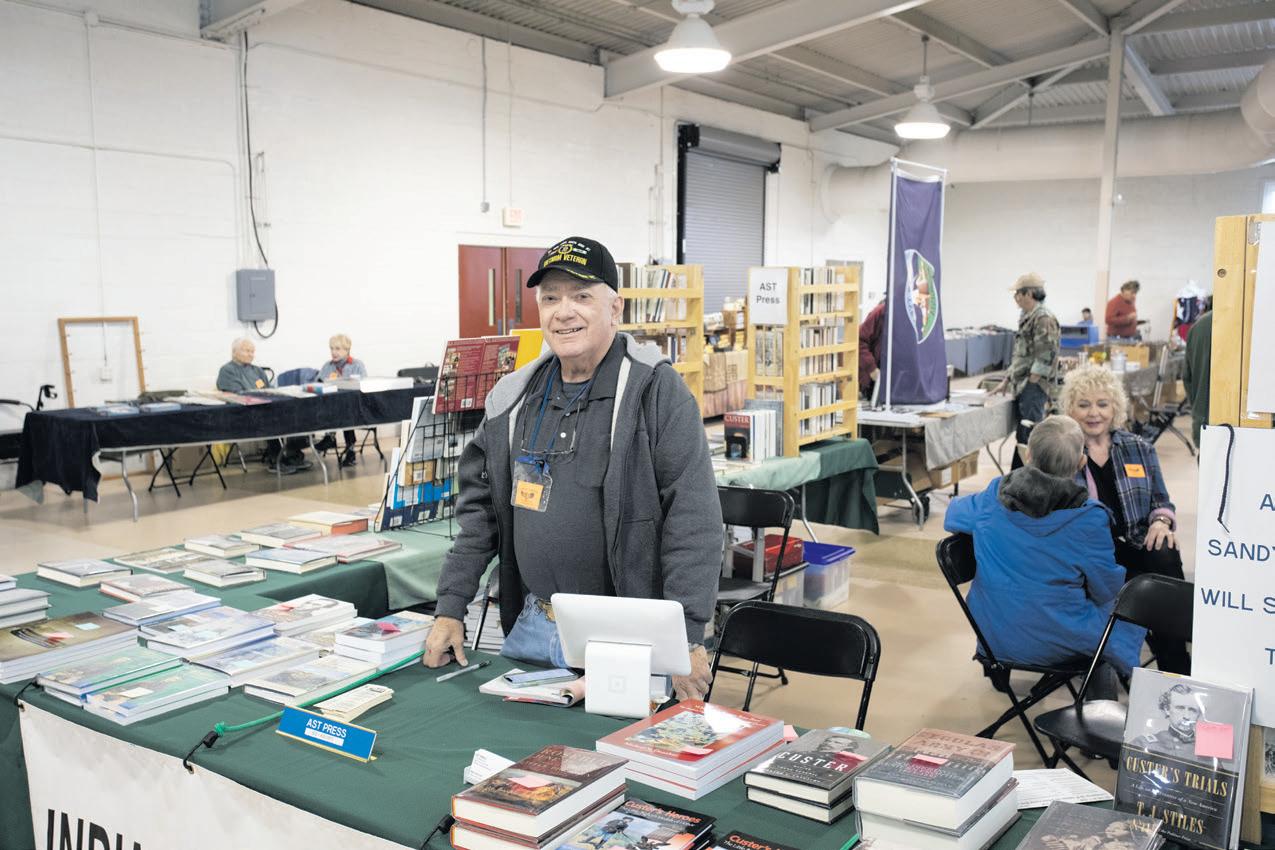


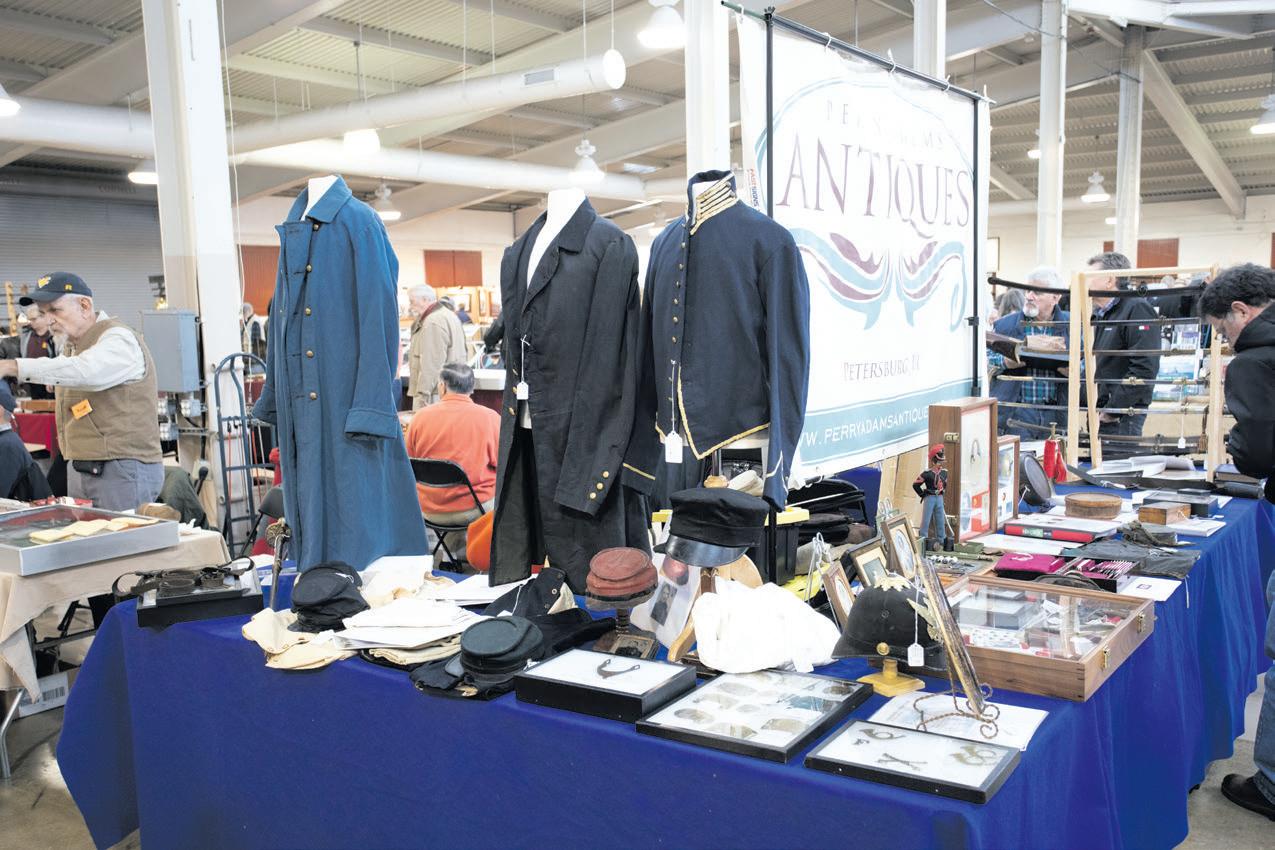
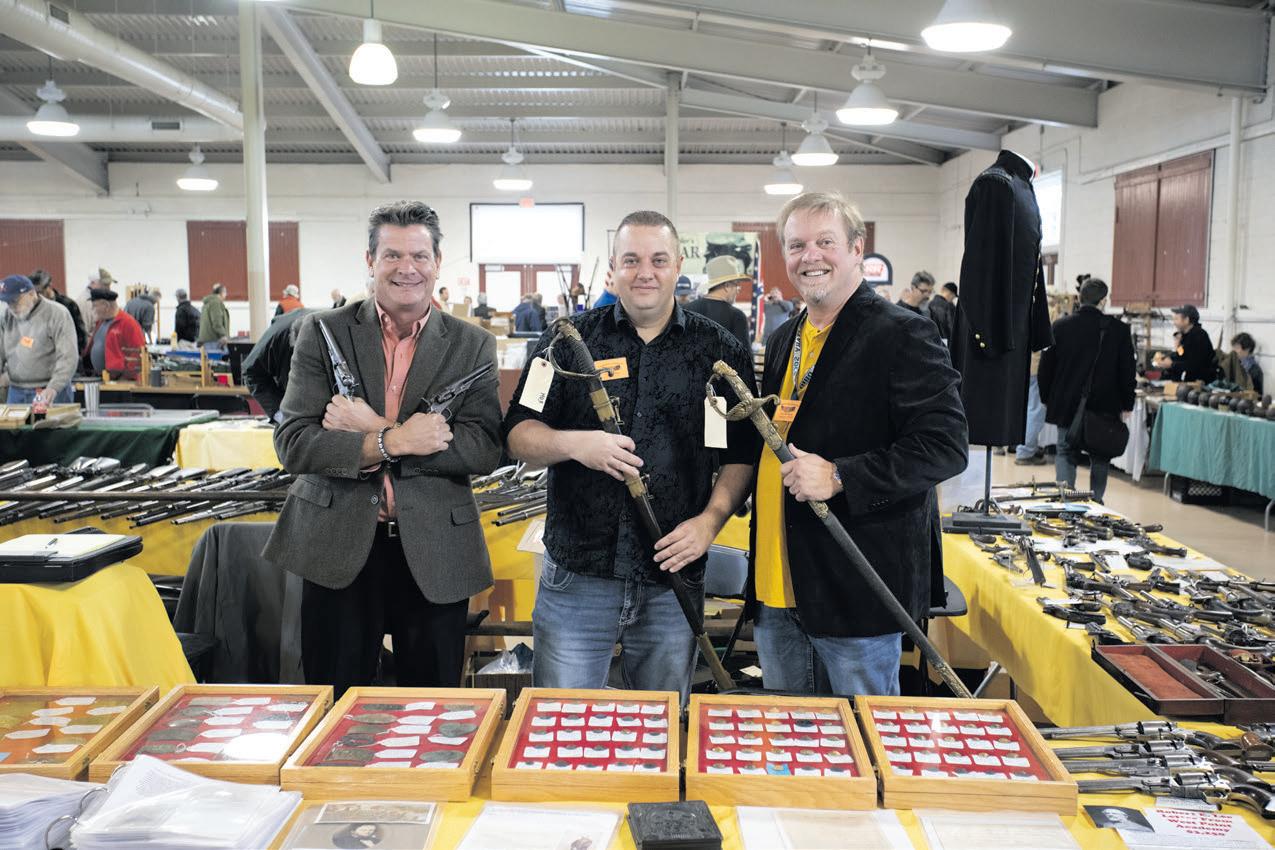
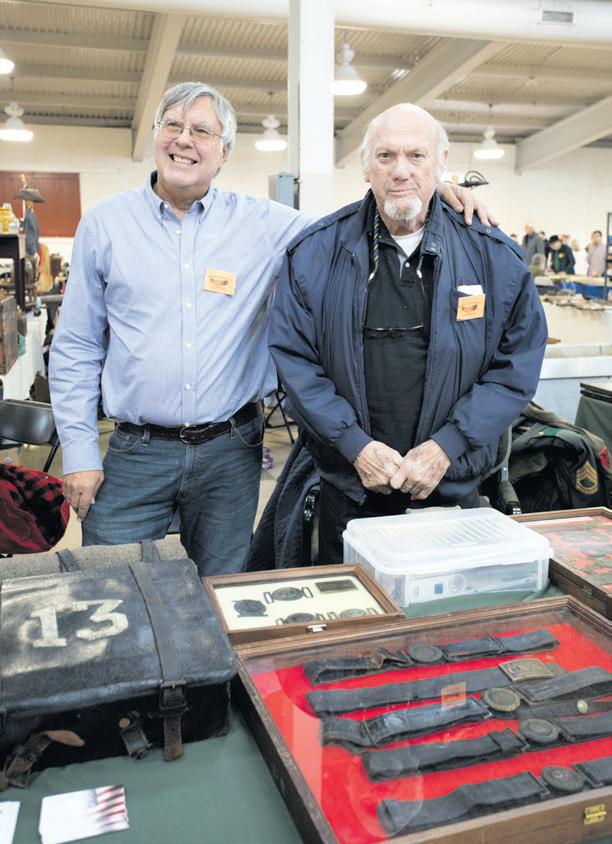

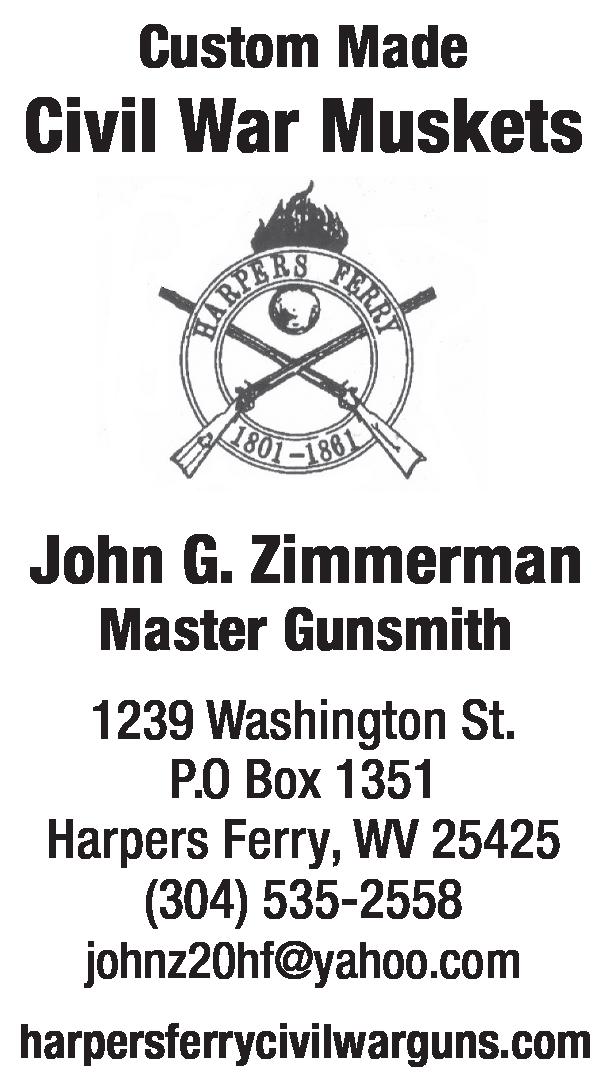
19 January 2020 Civil War News
Barry Banks made the commute from Georgia for his first Capital of the Confederacy Show.
Charles Williams of Civil War Navy Magazine always has some eye catching items at his table.
Chris Trimble peering from behind his gallery of early Americana.
Sandy Banard with AST Press is a noted expert on General George Custer.
Karen Eubanks and Nick Harris – how could you have a Civil War show without them?
Gerald Roxbury and his grandson Jonathan Bouchard with their award winning display of naval swords.
Perry Adams Antiques has been a regular at this show for many years.
Rick Burton, Matt Hagans and Rafael Eledge are prepared to take on the customers!
Deadlines for Advertising or Editorial Submissions is the 20th of each month. Email to ads@civilwarnews.com
Long time vendors and obviously good friends, Will Gorges and Homer “Mac” Cole.
Violet Bank Museum Scheduled for Restoration
by Bob Ruegsegger
Situated high above Petersburg on the north bank of the Appomattox River, the Violet Bank Museum in Colonial Heights offers a commanding view of the historic downtown below.
Violet Bank served as the headquarters for General Robert E. Lee’s Army of Northern Virginia during the first six months of the Petersburg Campaign.

The history of the Violet Bank site dates back to the late 1700’s when Thomas Shore first purchased 144 acres on which he built his home. The site was part of a larger holding called
Archer’s Hill, a grant that encompassed much of what is now Colonial Heights.
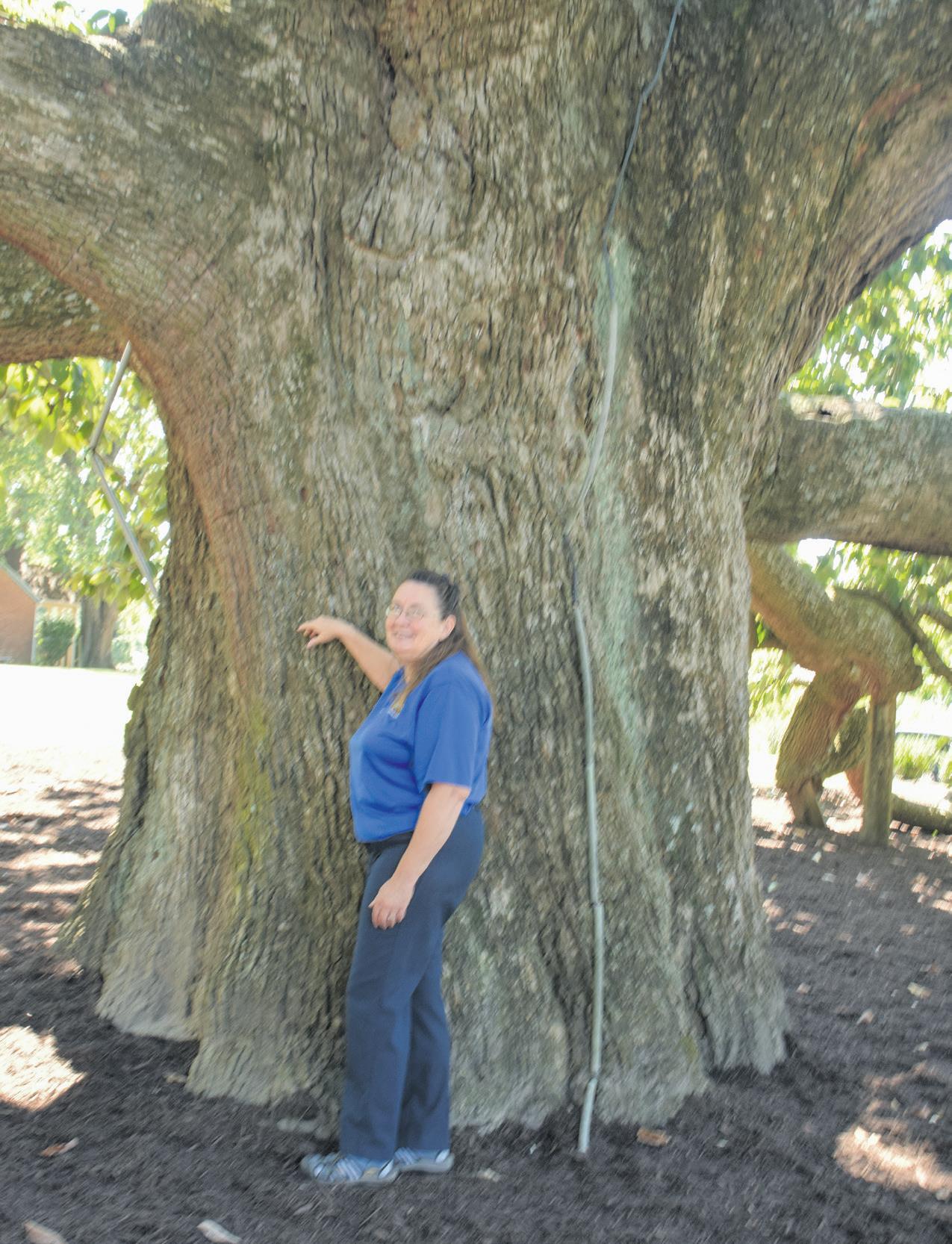
The existing house was the second residence built on the property. After the initial dwelling burned in 1810, a new residence was rebuilt using the footprint of previous structure, including the original English basement and chimney stacks.
Over the last century and a half,
Father Time and Mother Nature have taken their toll on Violet Bank. Foundation issues, water damage, and structural concerns have made a major four-part restoration project essential to preserving the historic building. The undertaking, if all goes well, has been estimated to take several years.
“Violet Bank does have some condition issues related to the water that is continually getting into the house,” said Wendy Alvis, curator of the Violet Bank Museum. “It definitely needs some work. It hasn’t had a major restoration in a long time. It really hasn’t had a complete restoration since, basically, it was built,” she noted.
“It’s long overdue for that. The house has good bones. It has a lot of potential. It’s gone through a period of graceful decline.”
Architects Mesick, Cohen, Wilson, and Baker, a group noted for the preservation and restoration of historic buildings, has been selected to oversee the $1.1 million, four-phase endeavor.
“The firm that’s going to be doing the work was really thrilled with how much original molding and trim work remained,” Alvis said. “We’re hoping that they can restore what is damaged and replicate what is missing,” she said.
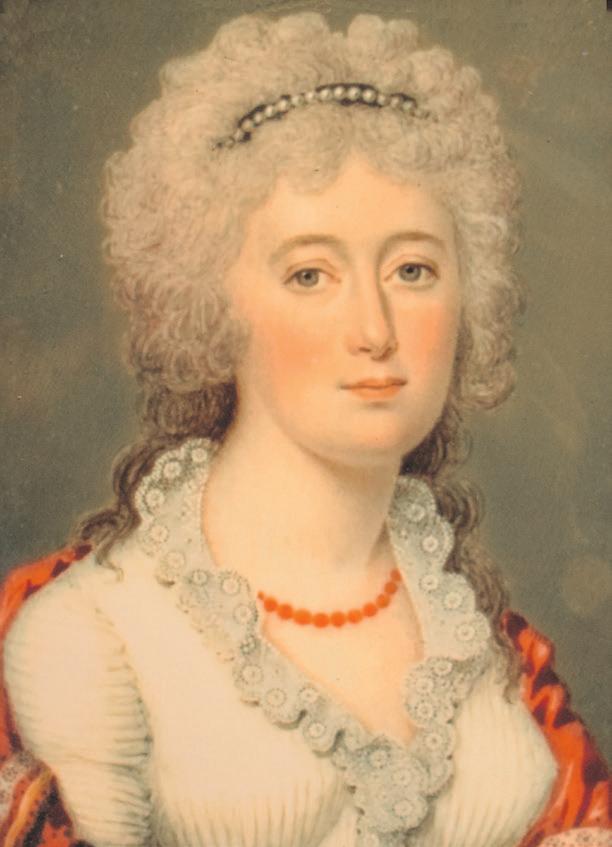
“They have a whole retinue of qualified craftspeople who specialize in historic preservation and restoration so we know that it will be done right.”
Because of its strategic location Violet Bank was a place of interest during the Revolutionary War and also the Civil War. The hillside outpost afforded a great view into Petersburg.
“Petersburg was the second largest city in Virginia at the time of the Civil War,” said Alvis. “It was a transportation hub. It had five rail lines coming into it, and it had water access for shipping,” she explained. “To hold the high ground and be able to look into Petersburg was very important. It allowed Lee to be close but not too close.”
General Lee’s aide, Lt. Colonel Water H. Taylor, established Lee’s headquarters at Violet Bank on June 17, 1864, at the onset of the siege of Petersburg. Protected by Confederate defenses to the south and east, the city remained connected to the Confederate capital via the Richmond and Petersburg Railroad as well as the Manchester and Petersburg Turnpike.
Violet Bank was situated near both transportation routes. It enabled General Lee to travel rapidly to Richmond to consult with Confederate President Jefferson Davis. It also made it convenient for President Davis to visit Lee at Violet Bank.
While at Violet Bank, Lee was informed of the explosion that began the Battle of the Crater on July 30, 1864, and hastened to the front to direct the Confederate counterattack. Although Lee retained his headquarters at Violet Bank, after August 15, 1864, he
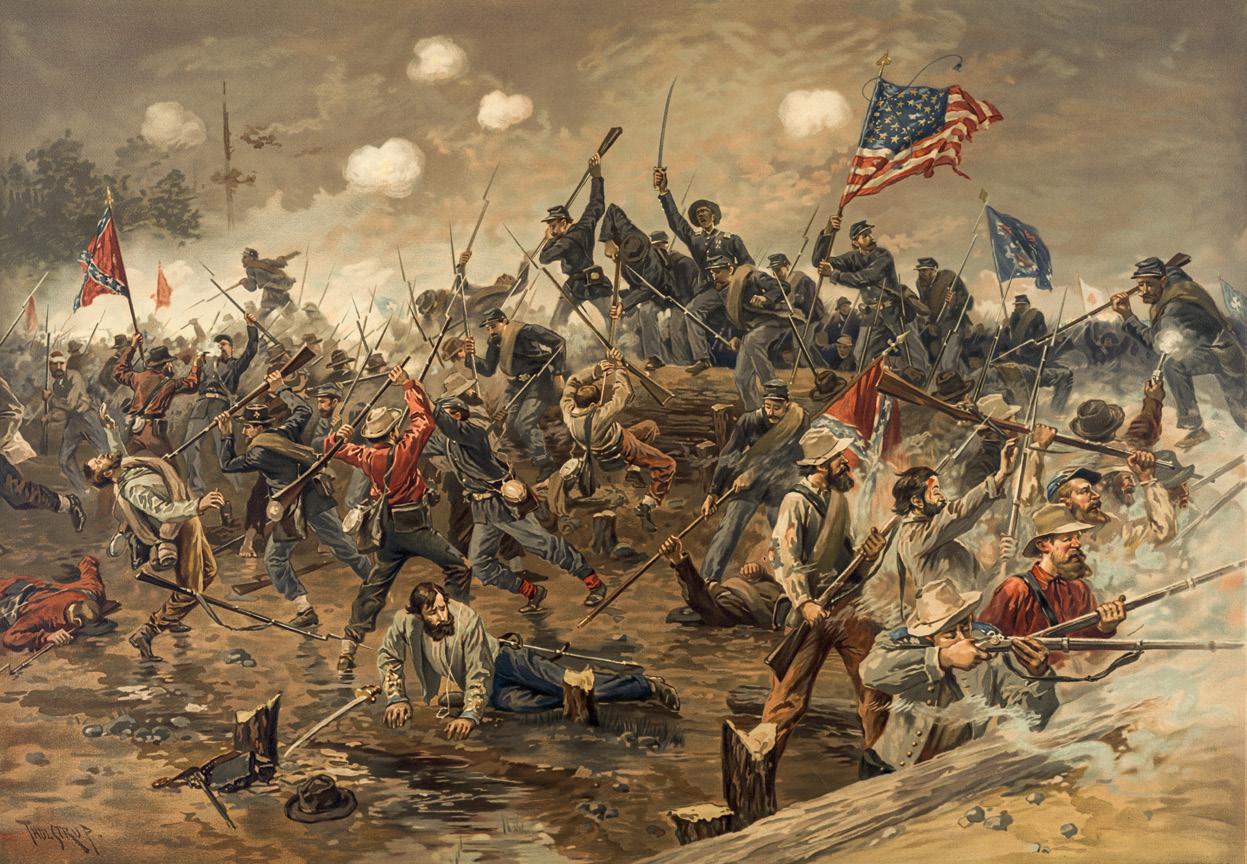
spent a good percentage of his time at Chaffin’s Bluff, north of the James River.

On October 28, 1864, General Lee moved his headquarters to another location in Petersburg. Following Lee’s evacuation of Petersburg on April 2-3, 1865, Union troops occupied Violet Bank briefly. While Lee used one of the parlors as his office, the family stayed in residence in the other wing of the house. Dr. John Gilliam and his wife, the granddaughter of Thomas Shore, continued to reside at Violet Bank. “Violet Bank was described as being in the Federal-style, but it was really unique architecturally,” said Alvis. “The design is attributed to Benjamin Latrobe. It’s in his style. The influence is there, but a direct connection has not been established.”
The Gilliam family initially offered General Lee the entire house. He declined that offer. They asked if he would like
20 Civil War News January 2020
This Cucumber tree, a variety of magnolia, is estimated to be over 300 years old.
Jane Grey Wall Shore, widow of Thomas Shore, had Violet Bank rebuilt after it burned in 1810.
Now a house museum, Violet Bank saw service as a VFW post as well as Colonial Height’s first public library. (All photos by Bob Ruegsegger)
to take rooms in the house so he wouldn’t have to sleep outside. He also declined that suggestion.
“General Lee preferred to be among his men because he felt it kept morale and discipline up,” said Alvis. “He had his general’s tent outside, and he used the rooms above the basement as office space.”

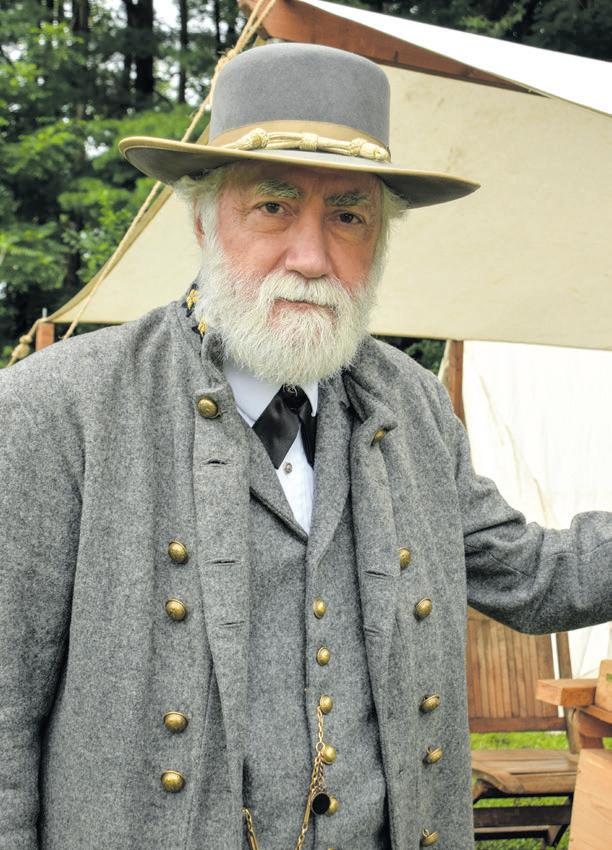
On the front lawn just beyond the porch, an ancient cucumber tree, a variety of magnolia, embraces the yard.
“This tree is estimated to be in excess of 300 years old,” said Alvis. “Under this very tree, General Robert E. Lee arranged for church services to be held to benefit him and his men at Violet Bank.”
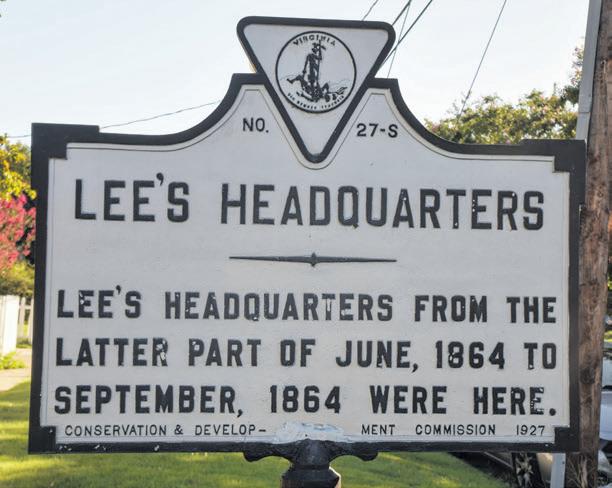

Violet Bank was occupied by descendants of the Shore family until after the war. In the 1870’s it was sold and changed hands a number of times. Parcels of land were sold from the original acreage. The house and property ended up as a dairy farm. The long part of the house was converted to a dairy barn and the upstairs was used as a haymow. Hay was pulled down the staircase.
“When it came time to divide the land up and develop it, they knocked the long part of the house down and sealed up where the two parts of the house came together,” said Alvis. “They sold this structure as a stand-alone house.”
Proposed Plan for Preservation and Restoration
The first phase of the preservation-restoration project addresses water issues relative to the structure. Extensive water damage has occurred in the chimney stacks and the foundation due to the porosity of the ancient brick and mortar. Shoring-up and strengthening the load bearing chimneys is crucial because of their impact on the floor, roof, and the structure around them.

“They have to trench all the way around the building. They’re going to make sure this is stabilized and that water is no longer getting in,” said Alvis. “They’re going to point-up the mortar. This is the most important phase because without a strong foundation and the stabilized chimneys, there’s no point in doing the rest of it,” she said. “This has to stand another couple of hundred years.”
In the second phase, issues with restoring and repairing the porches, support columns, roofing, and guttering will be resolved.
Phases three and four overlap.
Upgrading the plumbing, electrical, HVAC systems, and site beautification are all part of phase three. Recasting and restoring the ornamental interior moldings, repainting the exterior, and refinishing and reinstalling the shutters and hangers will be part of the work done during phase four.
“There is some overlap between phases three and four,” said Alvis. “I can’t separate it completely. Some of it goes hand in hand.”
Post-Restoration Plans

Curator Wendy Alvis has great plans for Violet Bank once the restoration has been completed. She has a variety of programs in mind, speaking engagements, art exhibits, and small living history events are among them.
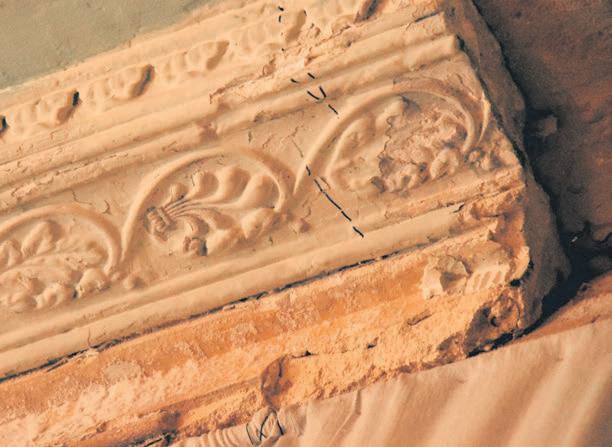
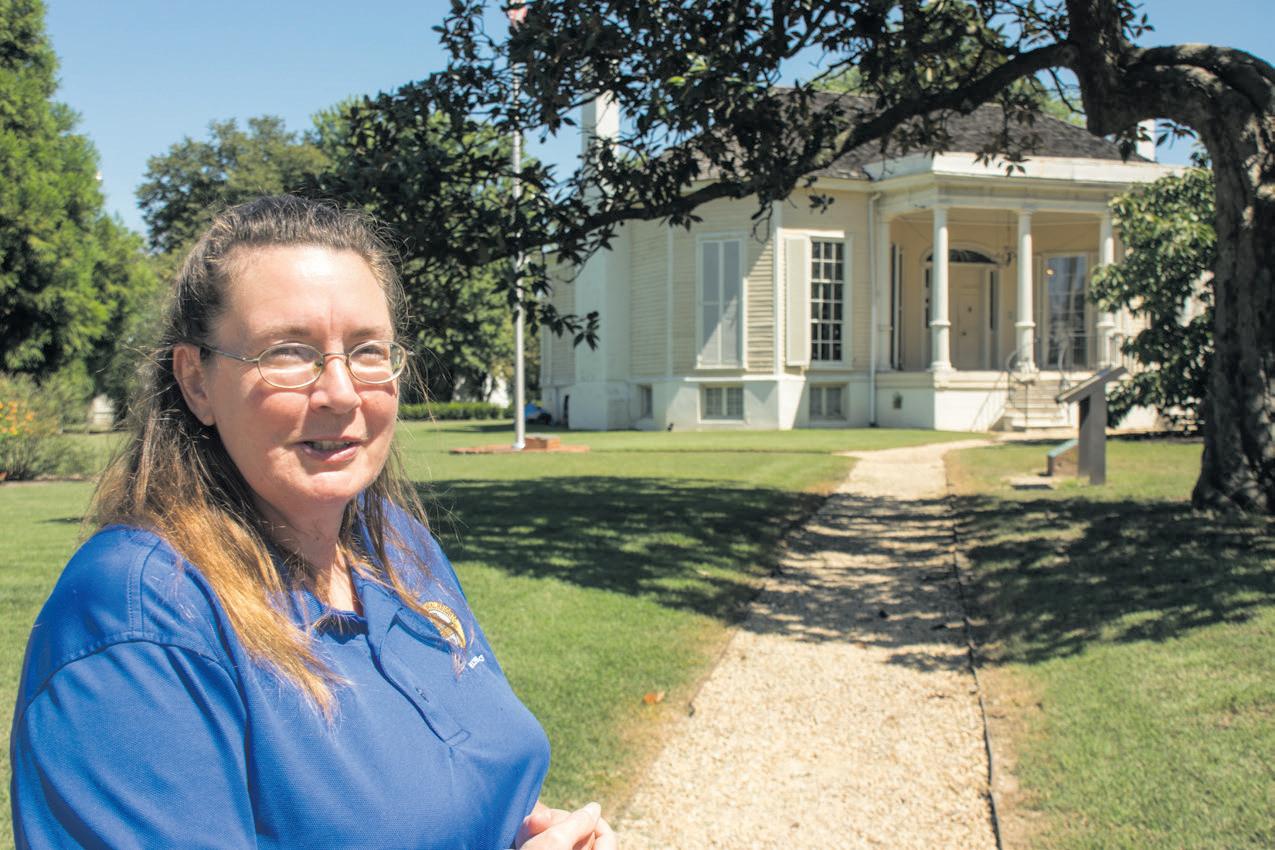
Architecturally, she compares the house to a beautiful old jewel. She warmly embraces the opportunity to showcase the architecture and history of the resurrected house.

“The renovation is going to give the programs a chance to succeed and be well-attended by the public,” said Alvis. “I really want to show this place off when it gets finished. It’s going to be gorgeous.”
Note: Violet Bank Museum is located at 303 Virginia Avenue in Colonial Heights, Va. It is open Tuesday-Saturday from 10 a.m.
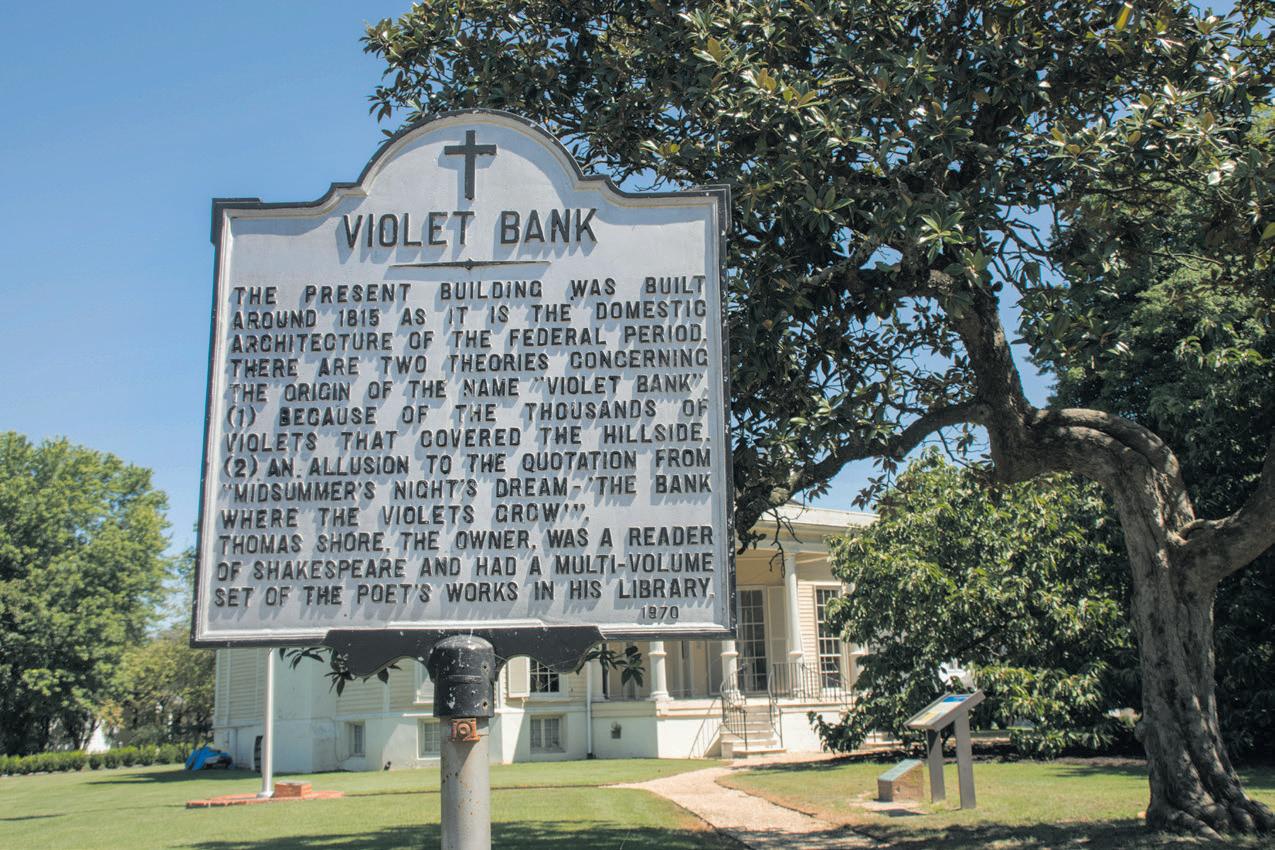
until 5 p.m. and Sunday from 1 p.m. until 6 p.m. The museum is closed on Monday. For more information call 804-520-9395or visit www.colonialheightsva.gov
Bob Ruegsegger is an American by birth and a Virginian. His assignments frequently take him to historic sites throughout Virginia, the Mid-Atlantic, and the Southeast. His favorite haunts include sites within Virginia’s Historic Triangle—Jamestown, Yorktown, and Williamsburg. Bob served briefly in the U.S. Navy. He is a retired educator and has been an active newspaper journalist for the last twenty years.

21 January 2020 Civil War News
Wendy Alvis is the curator of the Violet Bank Museum.
The Violet Bank Virginia highway marker offers several explanations about why this historic house may have come to be known as Violet Bank.
General Lee slept in a tent while on the grounds of Violet Bank.
The ladies parlor proved ideal for use as Lee’s office while the Army of Northern Virginia was headquartered at Violet Bank.
This ornamental plaster ceiling cornice is among the architectural features that make Violet Bank a beautiful “old jewel.”
The Gentlemen’s Parlor served as Lee’s staff’s office space.
Door corner block.
Gatling Gun–Violet Bank’s galleries include weapons that range from Colt revolvers to a Gatling gun.
The chimney stack bricks are preserved behind a thick coating of plaster.
Lee’s Headquarters Stone at the intersection of Arlington Avenue and Route 301 marks the entrance to the housing development that grew up around Violet Bank.
The Lee’s Headquarters highway marker S-27 on Route 301 indicates the location of Lee’s headquarters.
The Yacht Rebecca
The Graphic War highlights prints and printmakers from the Civil War discussing their meaning and most importantly, the print maker or artist’s goals.
When is a Civil War print not a Civil War print? Why, when it’s a yacht, of course.
During the height of the lithograph’s popularity, and just prior to the ascendancy of the photograph, Currier and Ives documented myths and idealistic versions of America. In addition to their extensive battle and military prints, the firm also produced trotting prints, horse races, and scenes portraying the rarified playground of yachting. In 1861, Currier published the print “The Yacht ‘Rebecca’ 75 Tons.” It was originally painted by a leading American marine artist, Joseph B. Smith (1798–1876), who worked with his son William until the younger Smith joined the 14th Brooklyn, which ultimately became the 84th New York Volunteers.
When Currier decided to portray the yacht, it turned to one of its premier in-house artists, Charles Parsons, to transfer Smith’s dynamic painting into a marketable print. As the title margin indicates, “To her owner James B. Bennett, Esq., this print is with permission respectfully dedicated by the Publisher.” It was described as a 77-ton, 72foot centerboard sloop.
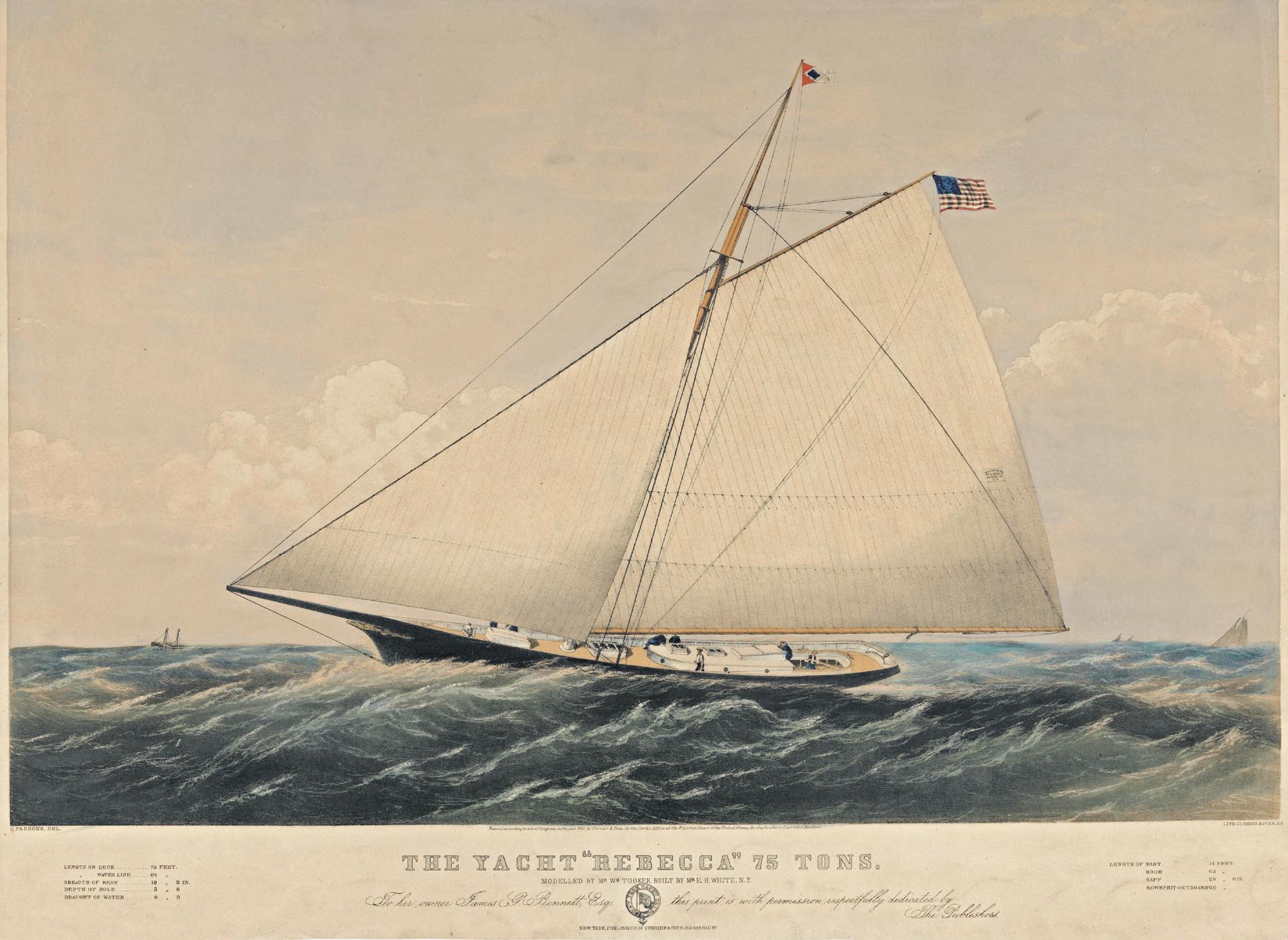
More intriguing than the history of the print is the intrigue, on a national level, involving the yacht’s role in the Civil War. Not much attention was paid to the yacht`s naval efforts either during the great conflict or by successive historians and scholars.
The owner of the boat, James Gordon Bennett Jr. was the playboy son of the founder, owner, and editor of the New York Herald. The younger Bennett had raced Rebecca in the 1857 annual sail of the New York Yacht Club and he was admitted to that elite membership at age 16. Bennett, Sr. was an avid anti-Lincoln
partisan calling the 16th president “a third-rate Western lawyer,” an “illiterate Western boor,” and a “vulgar village politician.”1 He wielded the Herald as a bludgeon to attack Lincoln at every opportunity.
Once the war began, Bennett senior experienced a miraculous conversion to Union, Lincoln, and the northern war effort. Speculation was that he thought better of the vitriol he was spewing through his articles and editorials when a mob stormed the paper immediately after Sumter. In order to make amends, Bennett raised the flag over his building and quickly issued patriotic editorials.2
Perhaps his most bizarre move involved his son’s sloop, Rebecca. He sent his competent and trusted reporter Henry Villard to Washington on a most peculiar mission. Bennett, through Villard, offered Lincoln the yacht Rebecca for the government to use in the revenue service. The offer wasn’t free. In
return, Bennett wanted Lincoln to commission junior as a lieutenant in the Navy. As author Ted Widmer points out: it is unlikely that “Lincoln had ever even heard the word ‘yacht’.” Villard, for his part, promised that “the Herald would hereafter be unconditionally for the radical suppression of the Rebellion by force of arms.”3

Lincoln accepted the sloop and true to his word, appointed the younger Bennett to the Internal Revenue Service where he was commissioned a lieutenant. He served until May 11, 1862, when he resigned.4 Before Bennett’s offer to Lincoln, almost unnoticed in one of the Herald’s “cheeky” ads (Widmer’s term), in fine print was an ad for the sale Rebecca: “Can be seen at Greenpoint.” As author Widmer concludes, “perhaps Bennett’s willingness to offer Rebecca” to the Lincoln administration “had something to do with the fact that no one wanted to buy her.”5
Endnotes:
1. As cited in Ted Widmer, “Yacht for Sale,” New York Times, April 21, 2011.
2. Adam Goodheart, 1861: The Civil War Awakening, New
York: Alfred A. Knopf, 2011, 209-210. Bennett denied the mob’s evil intentions writing in an editorial that they were most interested in getting copies of the latest issue of the Herald. Ibid., 416-417.
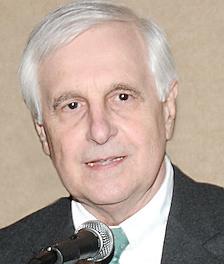
3. Widmer, Ibid.
4. Robert S. Harper, Lincoln and the Press, 320. (See James M. Perry, A Bohemian Brigade: The Civil War Correspondents, 54-55. See also the Lehrman Institute Presents: Mr. Lincoln and New York, “James Gordon Bennett (1795-1872).” The New York Times reported September 9, 1861 a “Captain Coxetta” cruised the yacht Rebecca, Capt. J. G. Bennett, Jr., but without success.”
5. Widmer, Ibid. For further reading see: Adam Goodheart, “1861: The Civil War Awakening”; Michael Burlingame and John R. Turner Ettlinger, eds., “Inside Lincoln’s White House: The Complete Civil War Diary of John Hay”; Douglas Fermer, “James Gordon Bennett and the New York Herald: A Study of Editorial Opinion in the Civil War Era, 1854–1867”; Don C. Steitz, “The James Gordon Bennetts; Memoirs of Henry Villard,
22 Civil War News January 2020
James Gordon Bennett Jr. (Library of Congress)
The yacht Rebecca 75 tons. Modelled by Mr. Wm. Tooker. Built by Mr. E.H. White, N.Y.
Journalist and Financier”; James L. Crouthamel, “Bennett’s New York Herald and the Rise of the Popular Press”; Oliver Carlson, “The Man Who Made News: A Biography of James Gordon Bennett, Sr.”; The New York Herald, April 23 and 30, 1861; “Mr. Lincoln and New York” [mrlincolnandnewyork.org]; “The Lincoln Log”
[thelincolnlog.org
After 43 years in the museum field, Salvatore Cilella now spends his time writing and is the author of several articles and books. His last professional position was President and CEO of the Atlanta History Center. His most recent books are Upton’s Regulars: A History of the 121st New York Volunteers in the Civil
New Civil War Artillery Book


Civil War News publisher, Jack W. Melton Jr., is proud to announce his new 392 page, full-color book, Civil War Artillery Projectiles – The Half Shell Book. For more information and how to order visit the website www.ArtillerymanMagazine. com or call 800-777-1862.
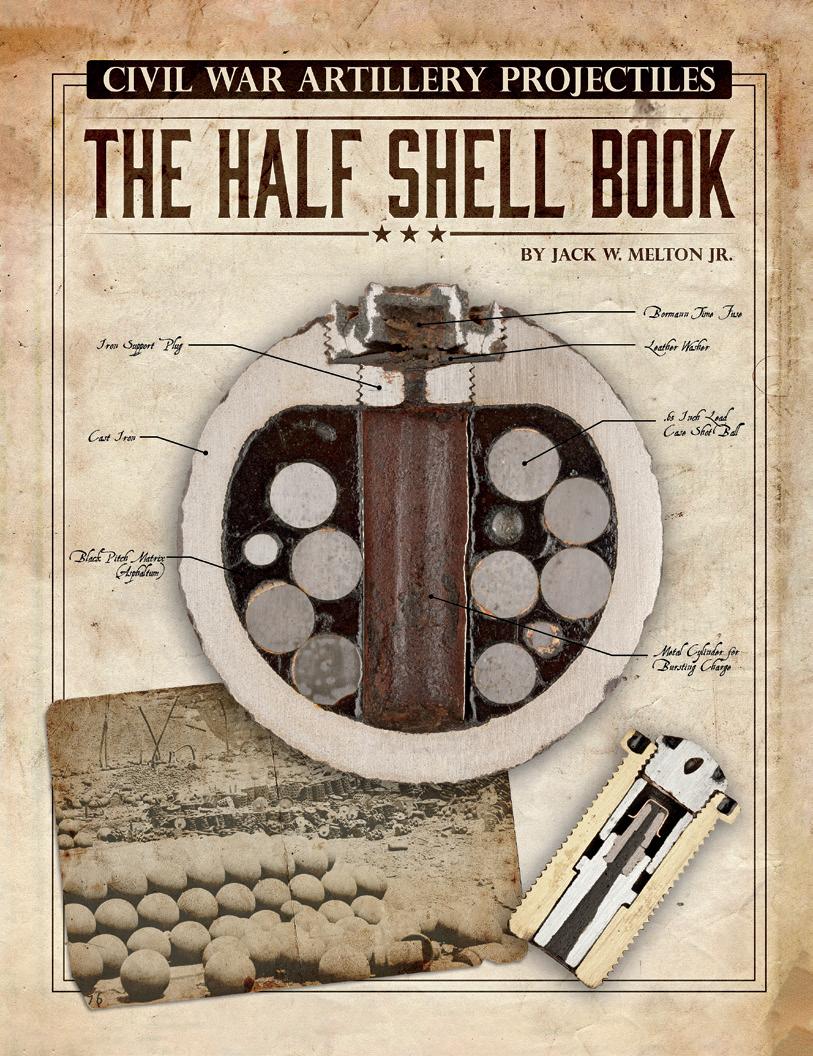
$89.95 + $8 media mail for the standard edition shown here. The limited edition deluxe edition is $125 + $8 media mail. Order online at www.ArtillerymanMagazine.com
War (U. Press Kansas, 2009). His two-volume Correspondence of Major General Emory Upton, (U. of Tennessee Press, 2017), is the recipient of the 2017–2018 American Civil War Museum’s Founders Award for outstanding editing of primary source materials. His new book, Upton’s letters to his wife, will be published this spring by Oklahoma University
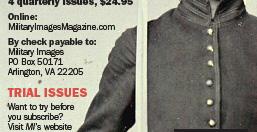
23 January 2020 Civil War News Subscribe online at CivilWarNews.com
Civil War Artillery Projectiles –The Half Shell Book cover.
Confederate Purchased Bar on Band Enfield Rifles
On January 25, 1856, one of the first, and most important, long arms to be derived from the Pattern 1853 Enfield Rifle Musket was officially approved for use in the British Army. The Pattern 1856 “Short Rifle” was an iron mounted long gun based upon the Pattern 1853 Rifle Musket with the same .577 caliber bore, the same 3-groove rifling with a 1:78-inch rate of twist, but with a shorter 33-inch barrel and an appropriately shorter stock. The most important new features that were debuted on the Pattern 1856 an improved, “double freed”, lock designed to minimize friction within the internal parts, a 1,100-yard rear sight and a bayonet stud brazed to the barrel that accepted the new Pattern
1856 saber bayonet. The “Short Rifle” was intended for issue to the 60th Regiment of Foot, the Rifle Brigade, the Cape Mounted Rifles, and the Royal Canadian Rifles, as well as sergeants in all line infantry regiments. The shorter barrel and slightly lighter weight were both considered substantial improvements in the handling of the rifle versus the rifle musket for skirmishing and similar activities.
By late November 1856, the first contracts for the new Pattern 1856 short rifle were being let to the Birmingham contractors, with more contracts to follow with both Birmingham and London makers. Almost immediately concerns began to develop regarding the stability of the bayonet stud on the barrel, and the possibility that the stud could be damaged or broken when the bayonet was used, or more
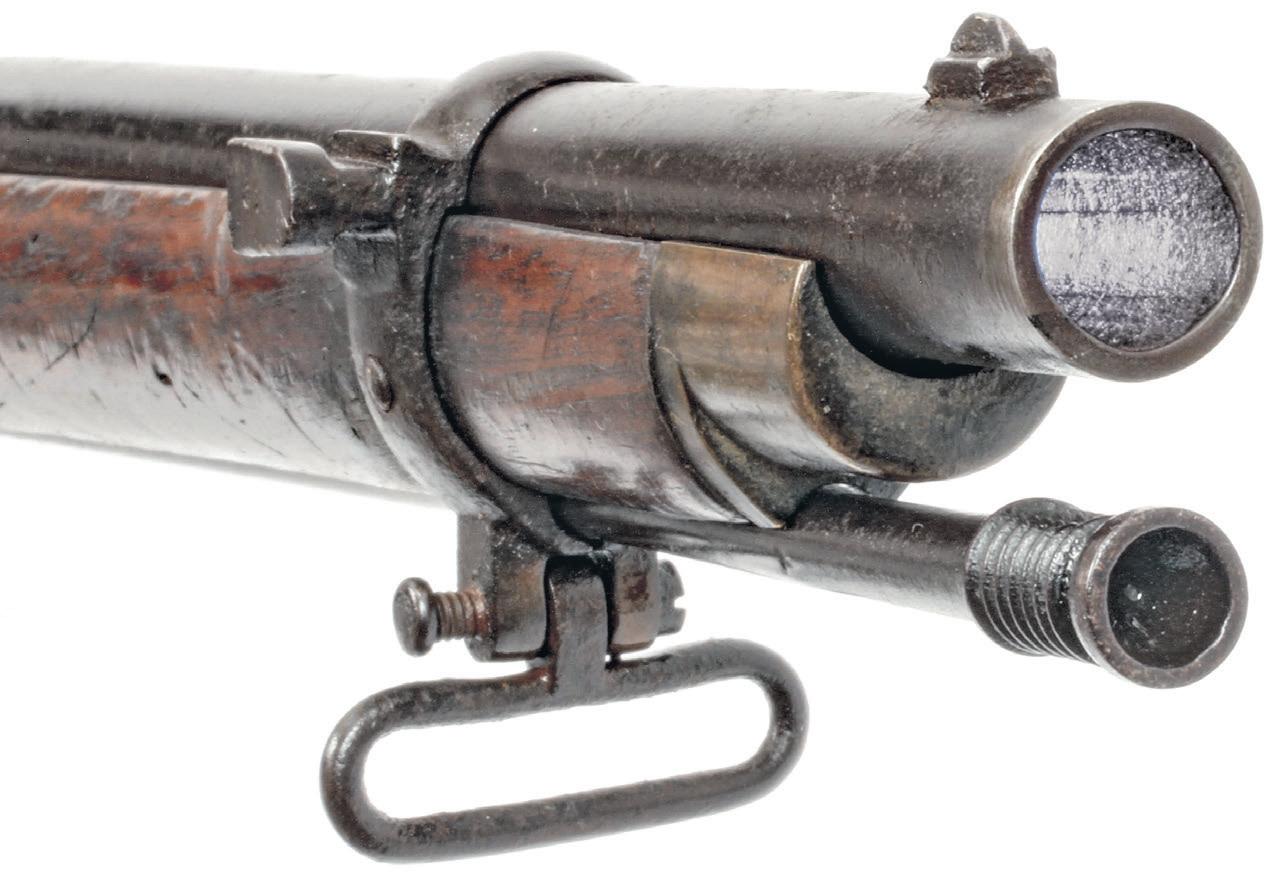
seriously the barrel itself could be damaged. There was also concern about damage that could be done to the barrel when the lug was brazed on, due to excessive heat. The remedy that was almost immediately suggested was that the bayonet lug be mounted on the upper barrel band, rather than the barrel itself. In order to make this a workable solution the redesigned rifle was stocked to within 1 ¼-inch of the muzzle with the front band placed where the old bayonet stud had been located. Additionally, a metal pin was added, passing through both sides of the barrel band and the stock beneath the barrel to support the band and prevent it from deforming or rotating when the bayonet was mounted upon it.
This new design was officially approved on July 6, 1858, and became known as the Pattern 1856 Rifle No. 2, also designated the Pattern 1856/58 Rifle and sometimes as the Pattern 1858 Rifle as well. This last designation only created confusion, as the Royal Navy had adopted their rifle, designated as the Pattern 1858, a brass mounted short rifle with a heavier 33-inch barrel, rifled with 5-grooves and a much faster 1:39-inch rate of twist; twice as fast as the rifle musket. As a result, the War Department very quickly resorted to calling the gun what it would be known as by future collectors and arms enthusiasts, the “Bar on Band” rifle. It is not clear how quickly the contracts for the new No. 2 rifle were let, or whether the existing contracts were modified to meet the new “bar on band” specifications. However, the speculation is that only a few thousand rifles were manufactured. With the inherent lag and sluggishness by the Birmingham arms trade in adopting new pattern changes, it is unlikely that many (if any) short rifles of the “bar on band” configuration were manufactured before the summer of 1859. It is further likely that it was sometime in 1860 before bar on band rifles were being “set up”, inspected and accepted for service. About the time the new rifle was going into production


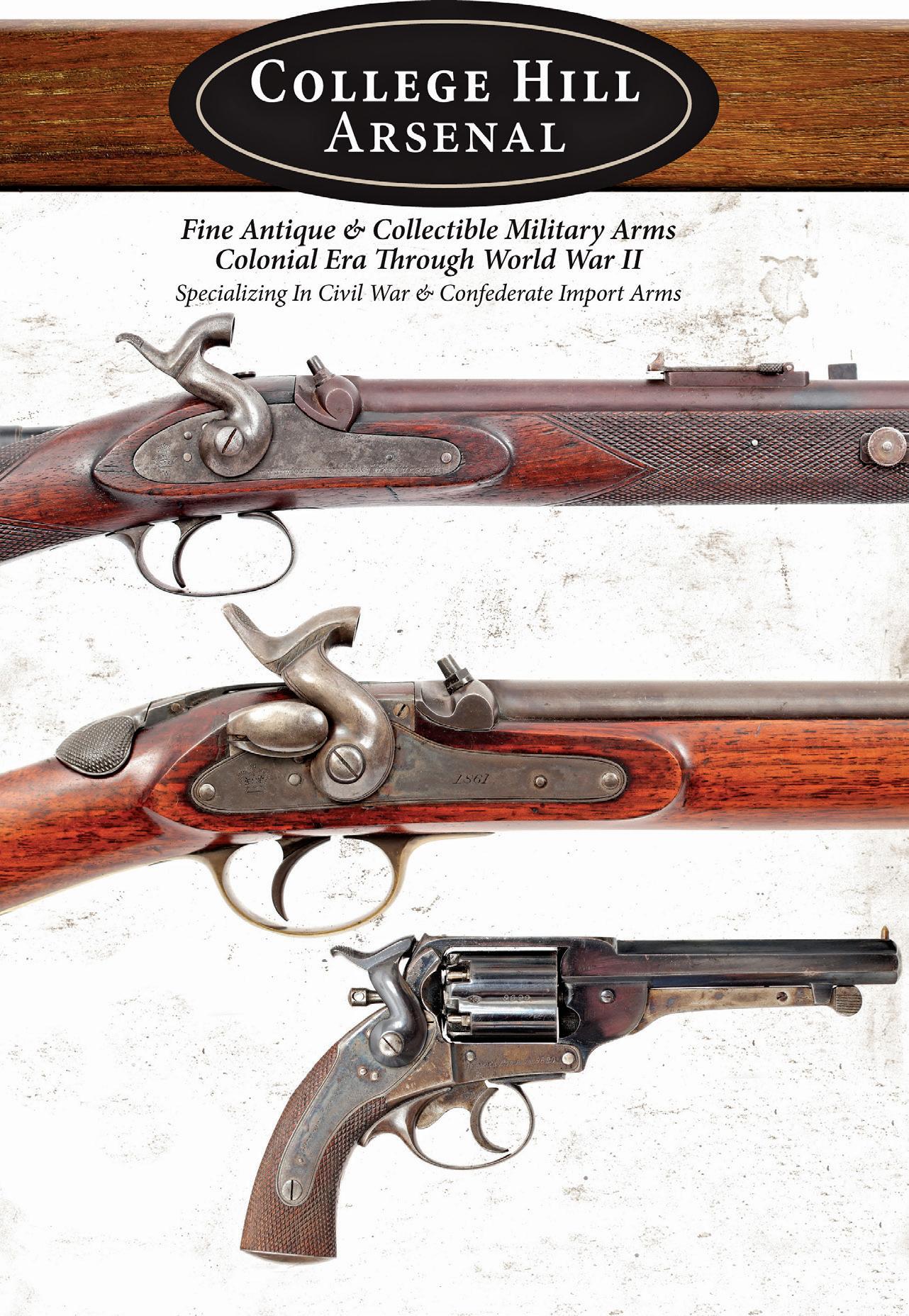
with the contractors; the War Department cast a spanner into the works, and changed the specifications again. On February 22, 1860, the War Department officially recommended adoption of an army version of Pattern 1858 Naval Rifle to replace the Pattern 1856 and Pattern 1856 No. 2 rifles. This was to be officially designated the Pattern 1860 Short Rifle. Since acceptance of the short rifle pattern, it had been felt that the overall accuracy was not on par with that of the rifle musket. The navy designed 5-groove barrel with a rate of twist twice as fast as that previously adopted turned the lack luster short rifle into a highly accurate tack driver. The heavier barrel with slightly larger exterior diameter resolved the issues related to barrel strength and bayonet lug problems and less than two years after being officially adopted, there was no longer any reason to produce the Pattern 1856 No. 2 Bar on Band Short Rifle.
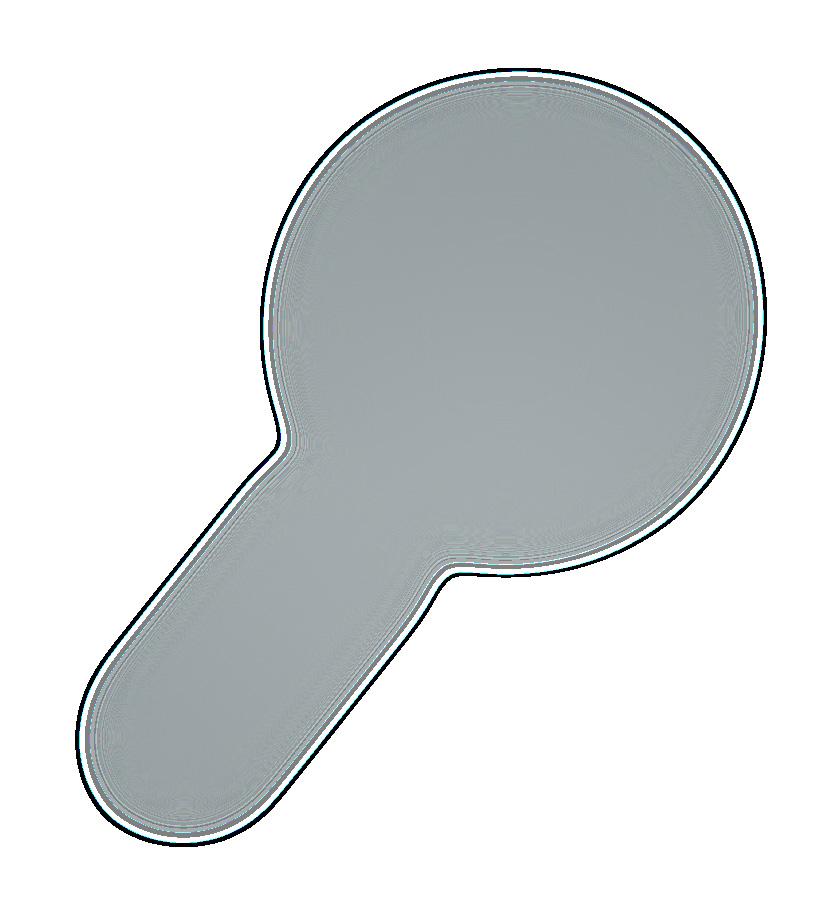
Again, the contractors slow walked the changeover in specifications, reverting to the older pattern stocks that were shorter and producing the new, heavier barrels, rifled in a new way. Pattern 1858 No 2 rifles continued to be delivered in spurts though 1861 and early 1862, but after that date the Pattern 1860 Short Rifle and its immediate replacement the Pattern 1861 Short Rifle were produced for the British military. The existing stocks of leftover “bar on band” parts were to be used up on Volunteer pattern rifles for the British militia and commercially made rifles. A number of these commercial guns made from left over “bar on band” parts were purchased by the Confederacy, and during 1861–1862, a small number of the JS/{ANCHOR} inspected and inventory numbered short rifles purchased by the South were of the “bar on band” pattern, with both iron and brass mountings.
During 1861 and 1862, the

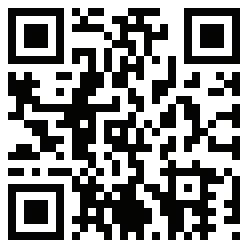
Confederacy let a number of contracts for the delivery of “Enfield” pattern percussion long arms of all varieties. Many of these contracts are well documented in the papers of Confederate General Colin McRae, that now reside in the collection of the South Carolina Relic Room & Military Museum, in Columbia, S.C. While the majority of the purchases concentrated on Pattern 1853 Enfield rifle muskets for use by Confederate infantry, a number of “short rifles” and carbines (both artillery and cavalry) were obtained as well.
Confederate documents reveal that one early order included 30,000 Pattern 1853 “Long Enfields” obtained from Sinclair, Hamilton & Company, as well as 10,000 “short rifles” of varying patterns. The 40,000 guns from these Confederate central government contracts are the ones found with both the JS/{ANCHOR} viewer’s mark and Confederate inventory number markings. Some guns were also marked on top of the stock comb with a “furnisher’s” mark. This initial indicated the “Five Furnishers” who were responsible for delivering the guns to Sinclair, Hamilton & Company. These contractors received the large order and then delivered the guns via a combination of producing the guns and subcontracting production to other makers. The Five Furnishers were the old-time Birmingham gun makers CW James and W&C Scott and the London makers EP Bond, Parker, Field & Son and James Kerr. The initials used for their markings were J, S, B, F and K, respectively.
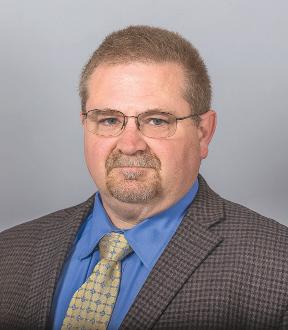
The “Long Enfields” were serialized in three series, from 1-10,000, 1-10,000 / A, and 1-10,000 / B. The short rifles were simply serialized 1-10,000, without series or suffix letters. The short rifles were a mixture of standard Pattern 1856 and Pattern 1856 Type No. 2 (known as the Pattern 1858 “Bar on Band”)

24 Civil War News January 2020 www.CollegeHillArsenal.com Tim Prince College Hill Arsenal PO Box 178204 Nashville, TN 37217 615-972-2418
Muzzle area of Bar on Band rifle #3513, clearly showing the band-mounted bayonet “bar” (lug) that gives the rifle its nickname.
iron mounted rifles, as well as non-standard brass mounted Pattern 1856 and Pattern 1856 No. 2 rifles. A handful of the brass mounted Pattern 1858 Naval rifles, and iron mounted Pattern 1860 and Pattern 1861 rifles were also purchased.
Today, a multi-decade survey of extant surviving Confederate marked and inventory numbered Enfield short rifles reveals that less than one hundred of these guns are known to have survived; about 1% of the total purchased. Of these, less than twenty are of the “Bar on Band” pattern. While some are in private collections, others reside in museums or other public collections where they can be viewed, but never owned by a collector. The most famous of these rifles is the gun carried by Sergeant Richard Kirkland of the 2nd South Carolina Volunteer Infantry. Kirkland is known to history as the “Angel of Marye’s Heights” for his heroic acts of taking water to wounded men from both sides during the Battle of Fredericksburg. Kirkland’s rifle was a brass mounted bar on band Enfield with the engraved inventory number 2370 on its buttplate. This rifle is in the collection of the South Carolina Confederate Relic Room & Military Museum (Catalog #4.109.1560.1977). Since at least one other numbered, brass mounted bar on band in a private collection has strong ties to South Carolina troops serving in Kershaw’s South Carolina brigade, all brass mounted Confederate bar on band rifles have developed this association.

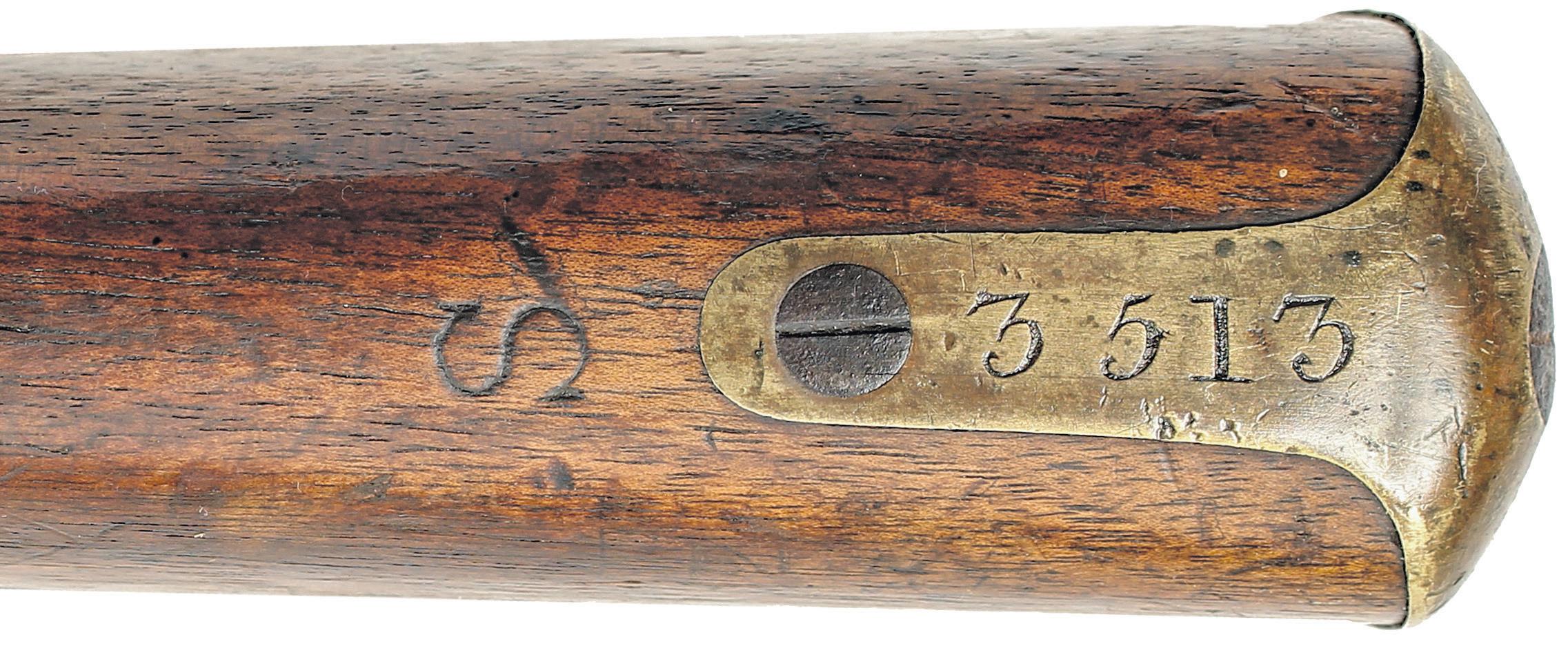
It is interesting to note that the brass mounted “Bar on Band” rifle was not a standard British military pattern, but rather a “volunteer” or commercial pattern rifle. However, it is encountered with Confederate markings at nearly twice the rate of the iron mounted version, which was the standard British military variant.

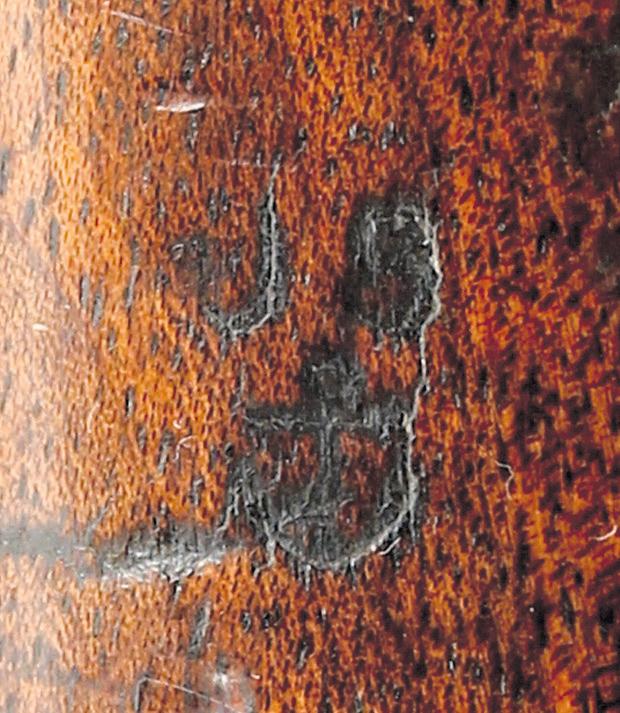

The furniture of the “iron mounted” rifles was made of iron rather than brass and was color casehardened as well. Due to the difficulty of engraving a number in the case hardened buttplate tang, versus the much softer brass used on brass mounted guns, the iron mounted rifles that were inventory numbered were marked with their numbers stamped in the wood of the stock belly, between the triggerguard and buttplate.
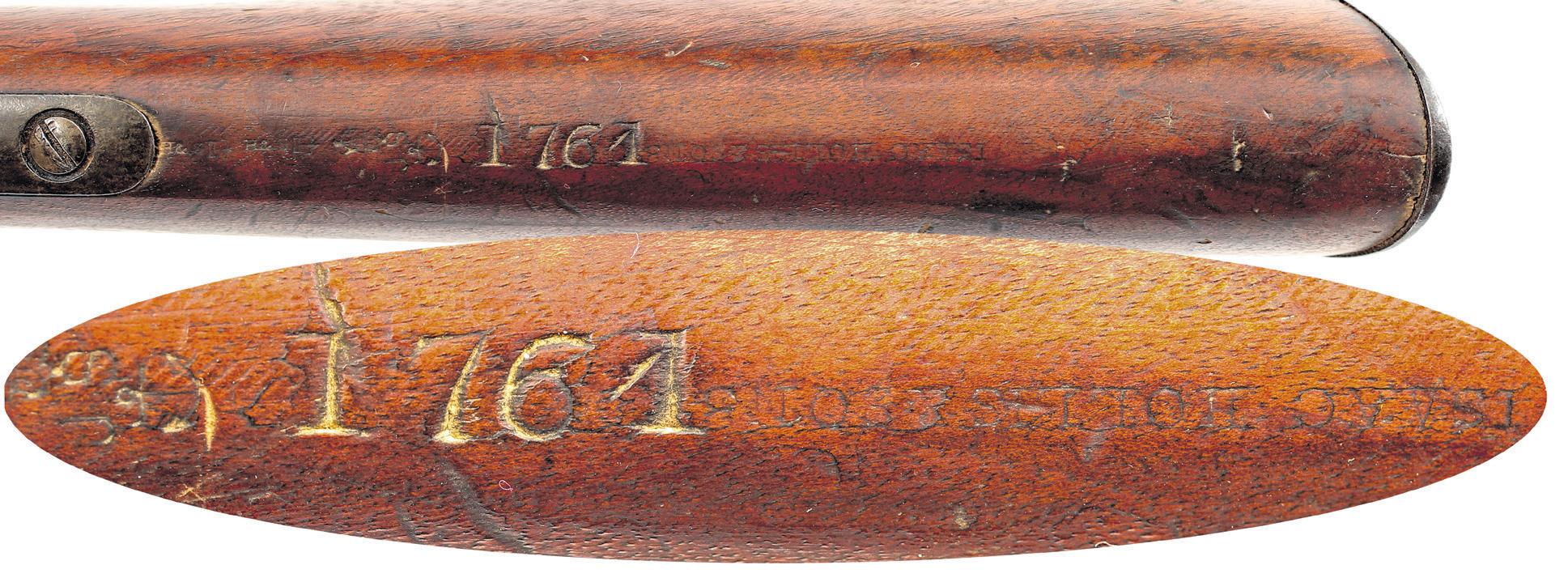
The various Enfield pattern “short rifles” were lighter and handier than rifle muskets and were preferred for use not only by Confederate infantry that functioned as skirmishers and sharpshooters, but by Confederate cavalry that tended to operate as mounted infantry, rather than
as traditional heavy cavalry. Confederate cavalry commanders
J.E.B. Stuart and Nathan Bedford Forrest were both proponents of issuing short rifles to their cavalry troopers. Short rifles with saber bayonets are known to have been issued to Confederate infantry regiments serving in Kershaw’s Brigade, the 10th, 16th, 18th & 51st Georgia, the 13th, 17th, 18th & 51st Mississippi, the 41st Tennessee, the 1st Battalion of Texas Sharpshooters, and the 5th Texas. Mounted Confederate units that are known to have been issued the “short Enfield rifle” were Cobb’s & Phillip’s Legions of Georgia, the 18th & 19th Mississippi cavalry (McCulloch’s Brigade of Forrest’s 2nd Cavalry), the 2nd North Carolina Cavalry, the 3rd, 6th, 9th & 27th Texas cavalry regiments (Ross’ Brigade) and the 7th Virginia Cavalry.
Tim Prince is a full-time dealer in fine & collectible military arms from the Colonial Period through WWII. He operates College Hill Arsenal, a web-based antique arms retail site. A long time collector & researcher, Tim has been a contributing author to two major book projects about Civil War era arms including The English Connection and a new book on southern retailer marked and Confederate used shotguns. Tim is also a featured Arms & Militaria appraiser on the PBS Series Antiques Roadshow.
Close
25 January 2020 Civil War News
Overall view of brass mounted Confederate purchased Pattern 1856 No. 2 “Bar on Band” rifle #3515 produced by Woodward & Sons. (All photos by Tim Prince)
Buttplate of Confederate brass mounted Bar on Band rifle #3513, showing the engraved inventory number and the “S” furnisher’s mark indicating the rifle was delivered to Sinclair, Hamilton & Company by the firm of W&C Scott of Birmingham.
The J S / {ANCHOR} viewer’s mark in the belly of the stock of #3513.
Close up of the lock area of the well-used Bar on Band rifle #3513, which is dated “1861” over the word “Tower.”
Overall view of iron mounted Confederate inventory numbered Bar on Band rifle #1761 manufactured by Isaac Hollis & Sons.
up of the markings in the belly of the stock of iron mounted Bar on Band rifle #1761. Note that the J S / {ANCHOR} Confederate viewer’s mark and the fact that the inventory number is partially stamped over the contractor name of Isaac Hollis & Sons, the maker of the rifle.
Perspectives on Antietam Phase Two –The Sunken Road
Last time we reviewed the accounts of two Federal officers who described their actions and observations in the first phase of the Battle of Antietam in the fields and woods at the north end of the line. We now leave this part of the battlefield, and the men who fought to exhaustion there, and move to the center, the sunken road made famous by the bloody struggle that marked the battle`s next phase.
Col. John Andrews led his Delaware regiment in this sector and took command of Brig. Gen. Max Weber’s Brigade when Weber was wounded. In his report Andrews described the brigade’s attack on the Confederates’ position and the terrain over which the attack occurred.
“Having advanced steadily through woods and corn-fields…, we met the enemy in two lines of battle, posted in a road or ravine 4 feet below the surface of the adjoining field, with a third line in a corn-field in the rear, the ground gradually rising so that they were able to fire over the heads of those in the ravine; our right was also exposed to the sudden and
terrible fire from the troops who succeeded in breaking the center division of the line of battle. We were at this time about 20 paces off the enemy, and returned their fire for some time with much coolness and effect.”
We also learn from this report what can happen when inexperienced troops go into battle. “A charge was then ordered and attempted, but our second line, composed of new levies, instead of supporting our advance, fired into our rear. We had now lost one-third of our men, and 8 officers commanding companies were either killed or wounded. Under these circumstances we fell back gradually to a stronger position until relieved by our third line composed of veterans under General Kimball. This was our first battle….”
Brig. Gen. Nathan Kimball reported on his brigade’s attack. “Directly on my front, in a narrow road running parallel with my line, and, being washed by water, forming a natural rifle-pit, between my line and a large cornfield, I found the enemy in great force, as also in the corn-field in rear of the ditch.”
Kimball’s brigade advanced
and “a murderous fire was opened upon it from the entire force in front. My advance farther was checked, and for three hours and thirty minutes the battle raged incessantly, without either party giving way.” The Confederates tried unsuccessfully to turn Kimball’s left, then “made a heavy charge upon my center, thinking to breach my line, but… was repulsed with great slaughter.” Kimball then charged, “driving the enemy entirely from the ditches &c., and some distance into the corn-field beyond. In this charge my command captured about 300 prisoners, the enemy in his flight leaving behind several stand of colors….”It seems that Kimball’s men were busy pursuing the enemy and did not stop to pick up these flags. The colors were “were taken by some parties outside my brigade….”
Kimball’s report praised these men who fought while others gathered abandoned flags. “For four hours and a half my command was under the most galling fire, and not a man faltered or left the ranks until the field was left by the rebels in our possession, those who were sent with the wounded to the rear quickly
returning to their places in line. For three and a half hours of this time we were upon the field, and maintained our position without any support whatever. My men having exhausted all their ammunition, the fight was maintained for some time with the supplies stripped from the bodies of their dead and wounded comrades.”
To complete our look at this phase of the battle, we turn to Col. Francis Barlow, who commanded two New York regiments. The fighting in this sector began at about 9:30. Within an hour, reinforcements arrived on both sides. Some Confederates had been dislodged from their strong defensive position but others, as Barlow stated, “remained lying in a deep road, well-protected from fire in their front.”
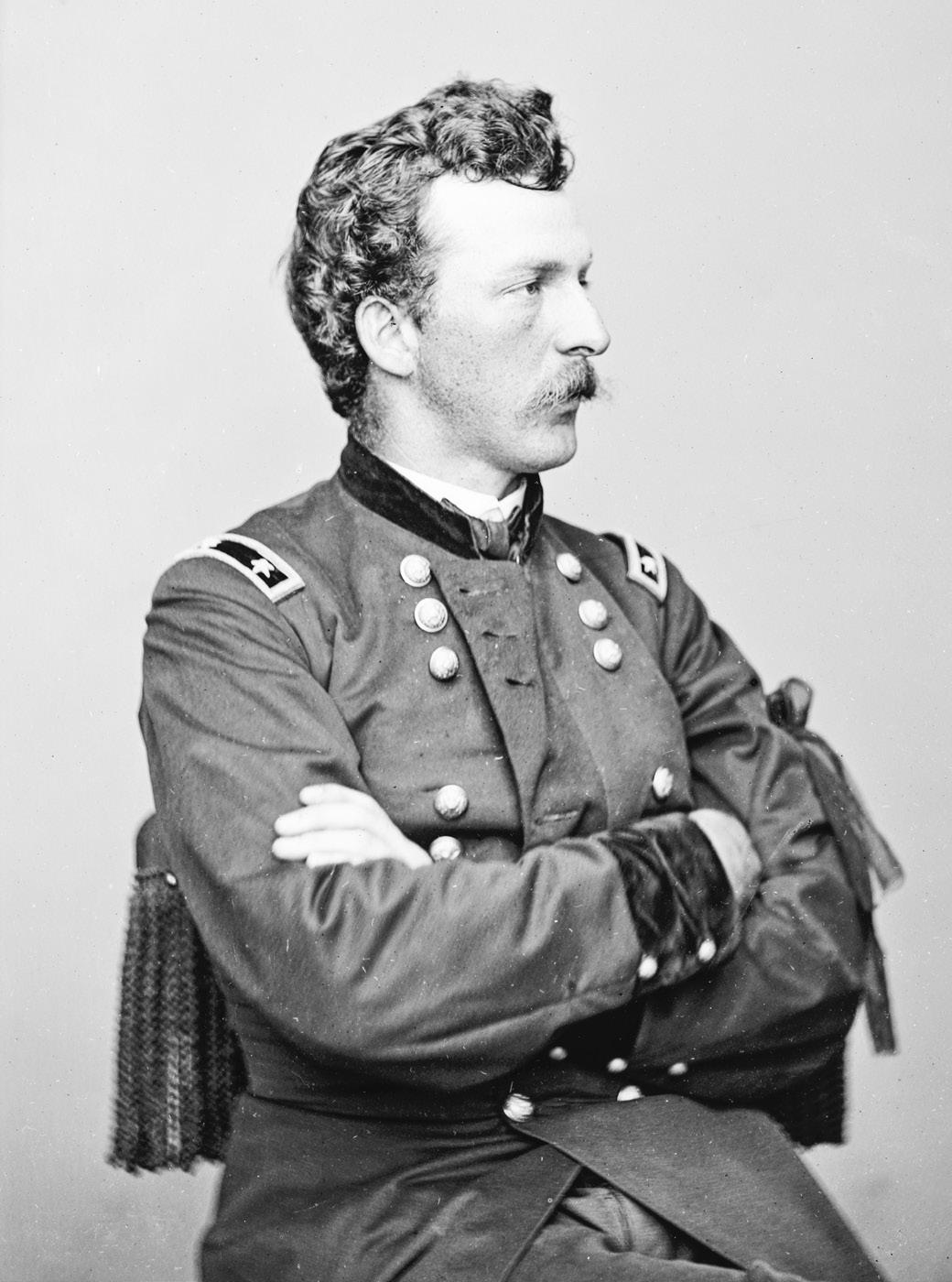
Barlow, though he had only 350 men total in both regiments, took advantage of a feature of the terrain to gain the upper hand. “Our position giving us peculiar advantages for attacking in flank this part of the enemy’s line, my regiments advanced and obtained an enfilading fire upon the enemy in the aforesaid road. Seeing the uselessness of further resistance, the enemy, in accordance with our demands, threw down their arms, came in large numbers, and surrendered. Upward of 300 prisoners thus taken by my regiments were sent to the rear….”
As Barlow’s biographer wrote, Barlow’s regiments “struck the Confederates on their extreme right where the road was shallowest. What had been a formidable defensive position now became a death trap as the Yankee musketry spat vengeance on the Southerners who had torn apart the previous assaults.”
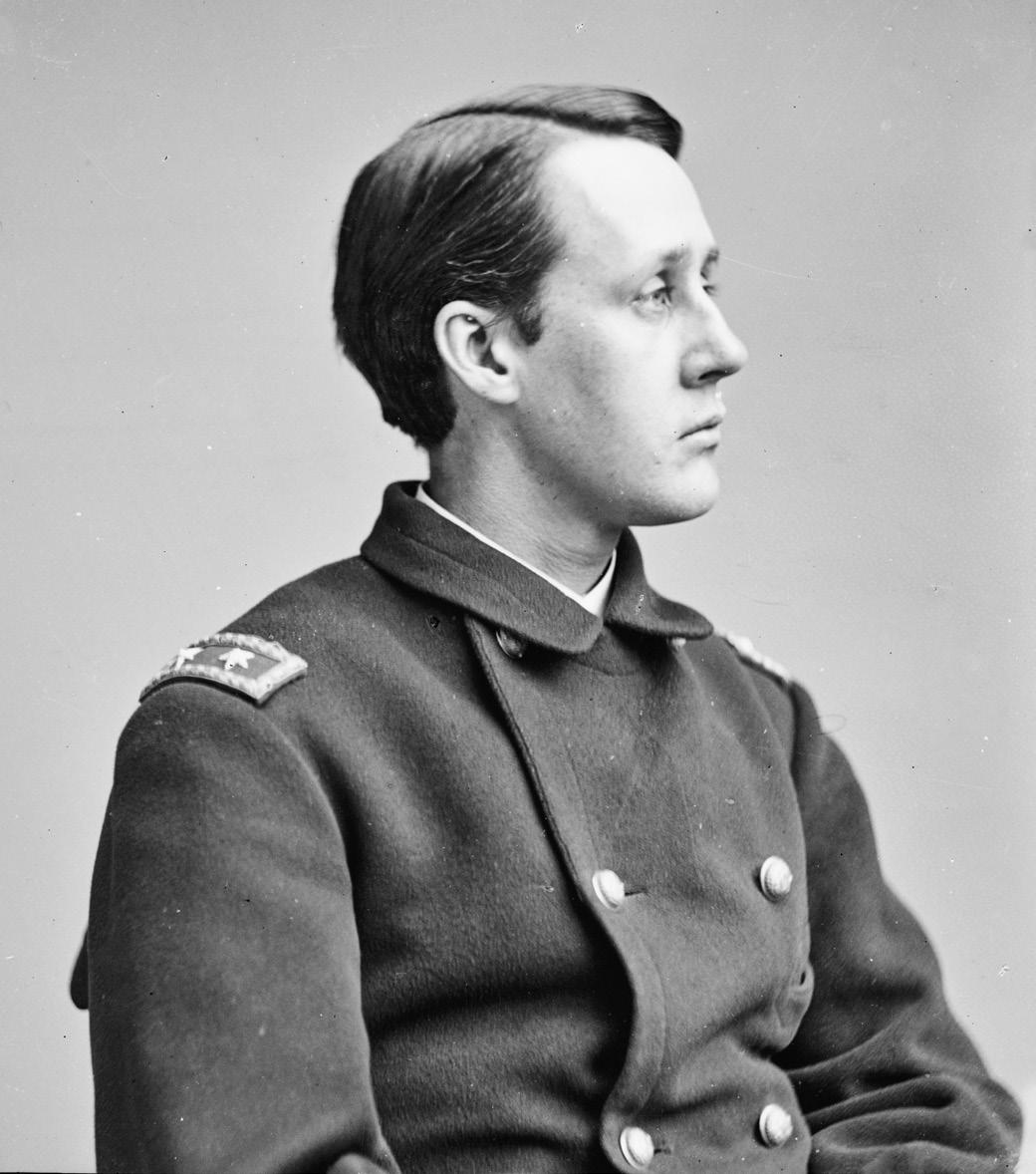
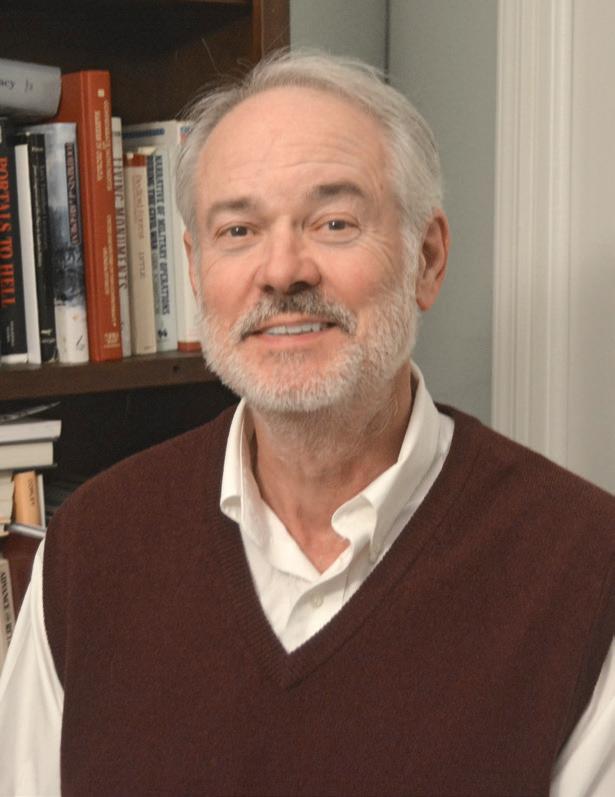
The Confederates had lost their strong point in the road, but the fighting in this sector was not over. Barlow’s regiments, “with the rest of our line, advanced into the corn-field through which the enemy had fled, beyond the deep road….” However, they and the other Union regiments faced desperate counterattacks. Barlow changed front once to counter Confederates coming from his right. He changed front again to face Confederates coming from another direction. At this point the colonel was wounded and turned command over the Lt. Col. Nelson Miles. The counterattacking Confederates were not numerous, but, supported by artillery, they succeeded in slowing the Federal advance.
At this point the division commander, Maj. Gen. Israel Richardson, also fell wounded, his being a mortal one. Many company officers and hundreds of men had fallen as well along with higher leaders. The Federal push against the Confederates in this sector slowed and stopped. The carnage in the center ended about 1 p.m.
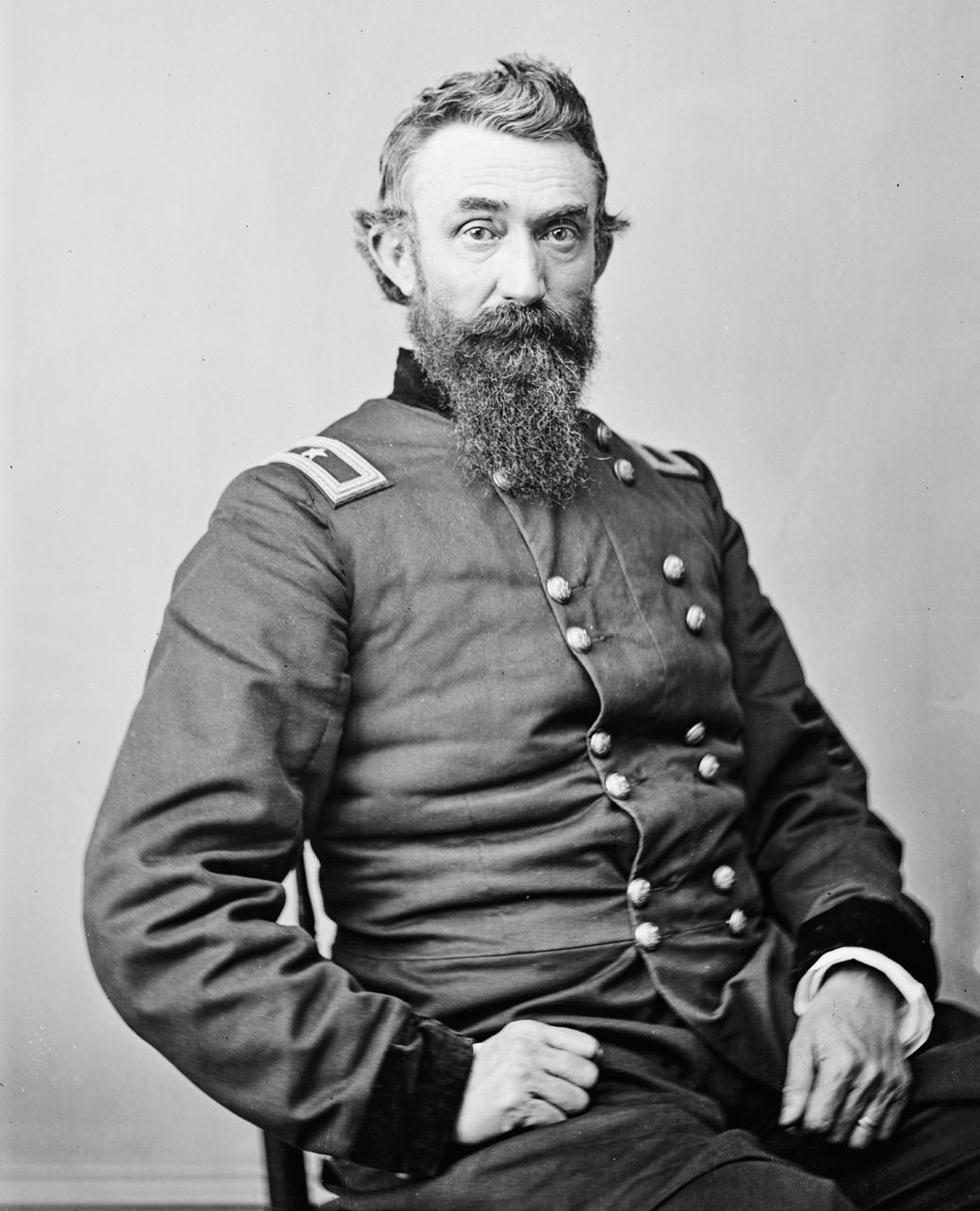
Miles reported that after Barlow fell, he “was ordered to let the skirmishers remain and form in the open field..., which position we held until relieved.” The command of two depleted regiments then withdrew and “was not engaged again during the day.”
In the center, as on the Federal right earlier in the day, casualties were heavy, with many hundreds falling on each side. The Confederates bent under the force of the Federal assaults, but ultimately held. In both sectors the opposing forces stood like two boxers who had hammered
26 Civil War News January 2020
Maj. Gen. Francis Channing Barlow
Brig. Gen. Nathan Kimball
Maj. Gen. Nelson A. Miles
each other round after round. There was yet no winner and no loser. They stood staring at each other’s bloody and swollen faces, both holding their arms as if ready to punch some more, but both too weary to swing with any force. So the battle shifted to the southern end of the line, where the Federals’ task was to cross the creek and move against the thinly held Confederate position on the heights above. Next month we will examine this final phase of the battle from the perspective of Federal officers who led men on the Union left.
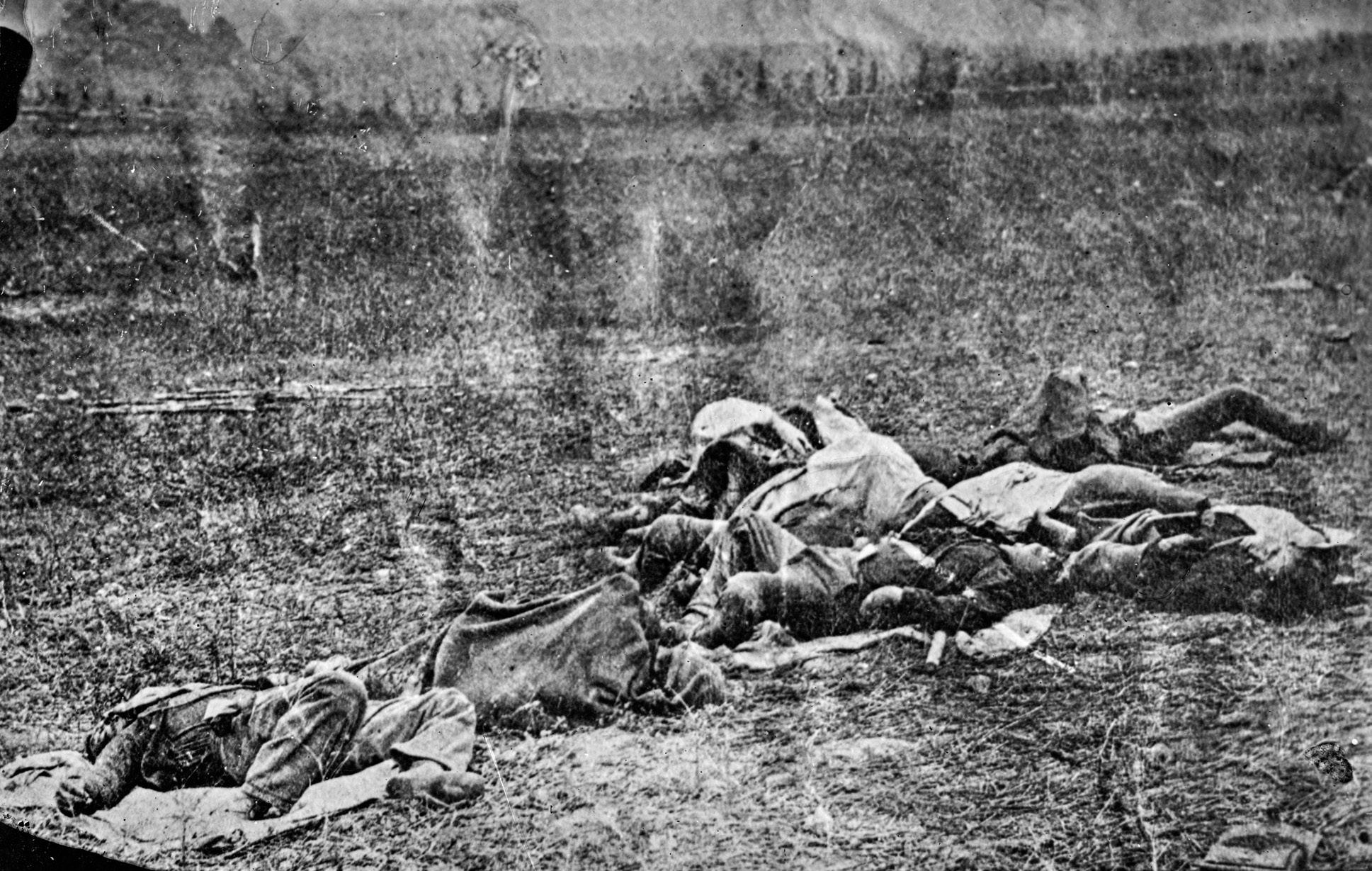
Sources and further reading:
• Official Records, Ser. I, Vol. XIX, Pt. I, Reports of Col. John Andrews, Col. Francis Barlow,
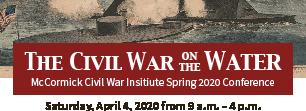
Brig. Gen. Nathan Kimball and Lt. Col. Nelson Miles.
• Richard F. Welch, The Boy General: The Life and Careers of Francis Channing Barlow, The Kent State University Press, 2003.
Gould Hagler is a retired lobbyist living in Dunwoody, Ga. He is a past president of the Atlanta Civil War Round Table and the author Georgia’s Confederate Monuments: In Honor of a Fallen Nation, published by Mercer University Press in 2014. Hagler speaks frequently on this topic and others related to different aspects of the Civil War and has been a regular contributor to CWN since 2016. He can be reached at gould.hagler@gmail.com.
This unique work contains a complete photographic record of Georgia’s memorials to the Confederacy, a full transcription of the words engraved upon them, and carefully-researched information about the monuments and the organizations which built them. These works of art and their eloquent inscriptions express a nation’s profound grief, praise the soldiers’ bravery and patriotism, and pay homage to the cause for which they fought.

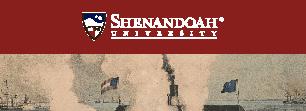
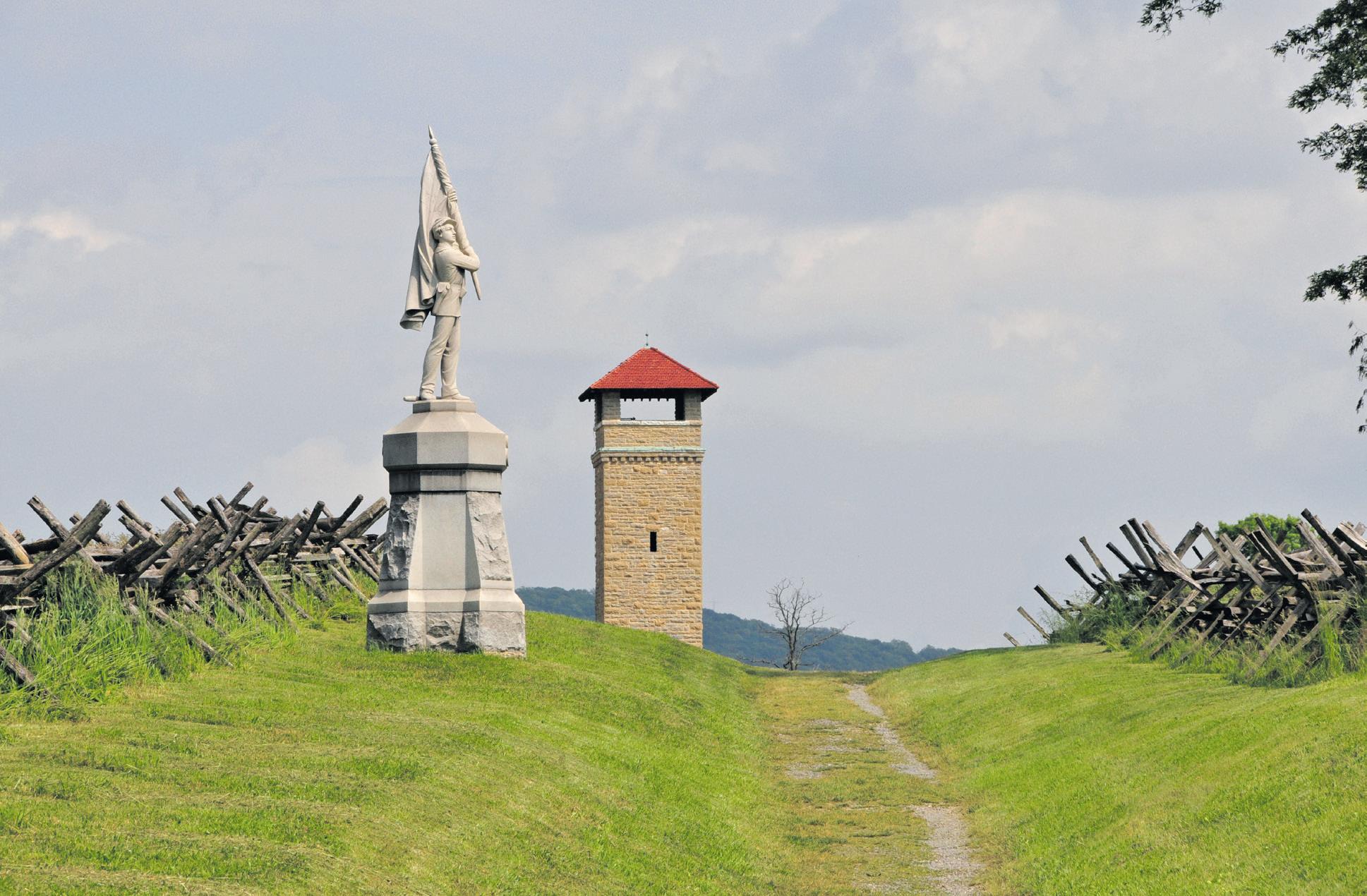
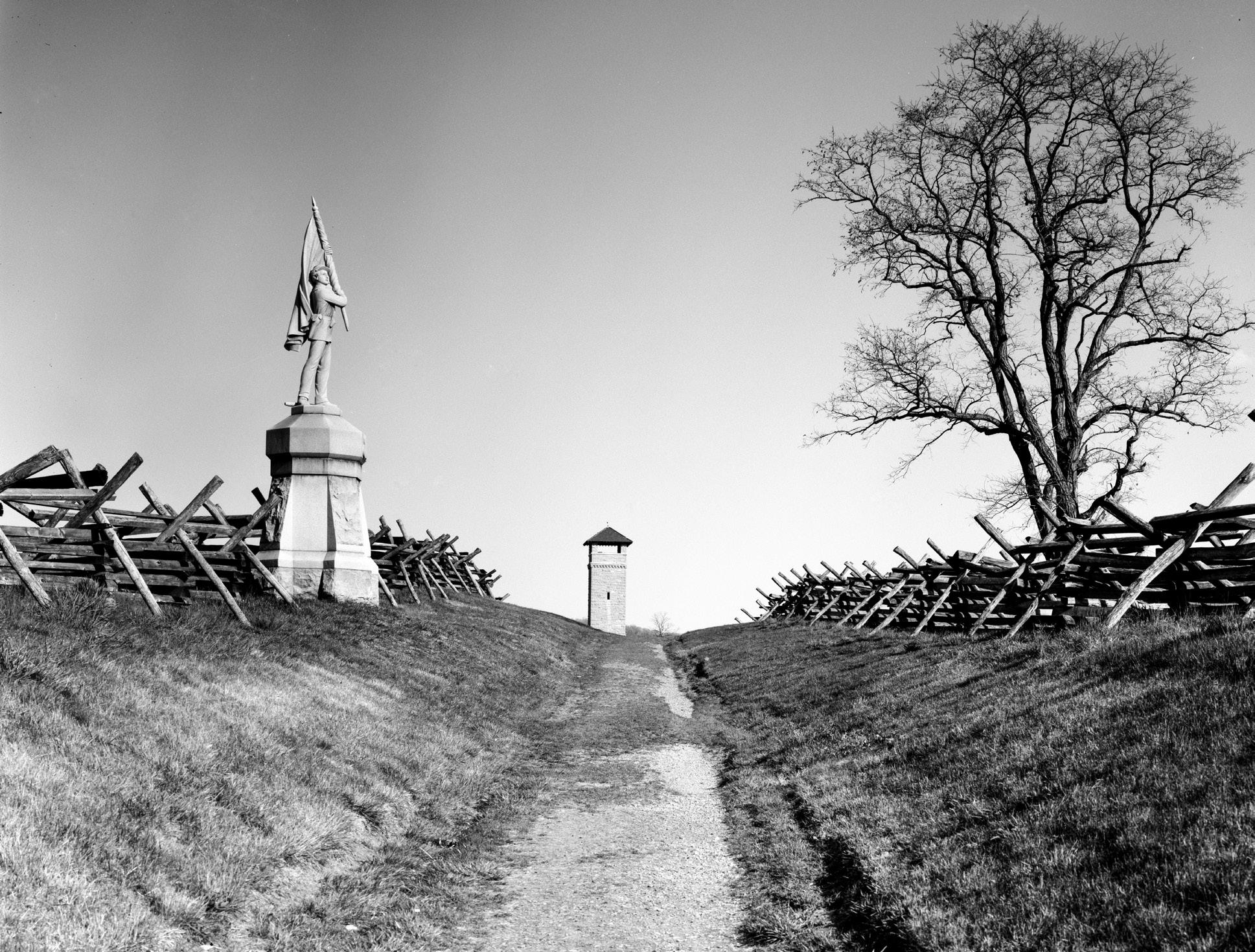
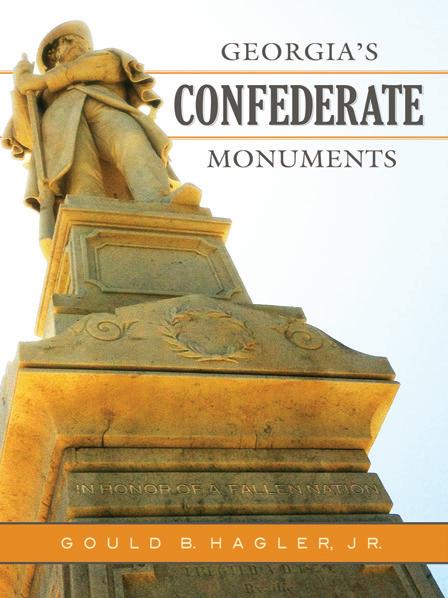
27 January 2020 Civil War News www.mupress.org 866-895-1472 toll-free
GEORGIA’S CONFEDERATE MONUMENTS In Honor of a Fallen Nation
B. Hagler, Jr. Subscribe online at CivilWarNews.com
Gould
The Sunken Road, or Bloody Lane.
(All photos Library of Congress)
Dead on the Battlefield.
The Sunken Road, or Bloody Lane at 2008.
(Jack Melton)
www.emergingcivilwar.com
town has undergone significant transformation to better accommodate the all-important tourist trade. Former cow pastures have disappeared beneath ballooning subdivisions. The store where I bought comic books is now a physical therapist’s office. The old chocolate factory in the heart of downtown has vanished.
When I drive around, I clearly notice the many differences— but because I look through the rose-colored lenses of nostalgia, I mostly see what used to be.
connection, I’ve developed a warm affinity for the roundtable there. I’ve been fortunate to speak to them a few times since. (They pay in chocolate!)
In mid-November, the folks from Hershey teamed up with the Harrisburg CWRT for a daylong bus tour of the Wilderness with me (with some overlapping Chancellorsville thrown in, too).
While it may be true that you can’t go home again, it was nice to have a little bit of home come to me.
— Chris Mackowski, Ph.D. Editor-in-Chief
The Seventh Annual Emerging Civil War Symposium at Stevenson Ridge will be held Aug. 7-9, 2020. Early bird tickets are $155 now through December 31. The regular ticket price, beginning January 1, 2020, will be $175. You can order tickets or find out more information here: https://emergingcivilwar. com/2020-symposium.

ECW News and Notes
the battles of Chickamauga and at Chattanooga. ECW’s Sarah Bierle also spoke at the conference, where she addressed leadership at the battle of New Market.
From the Editor
My childhood smelled of chocolate.
I grew up in Hershey, Pennsylvania, in the 1970s. Although my childhood was not without its challenges, I mostly remember it as idyllic. (For a glimpse, check out this essay I wrote a few years ago: https://scholarsandrogues.com/2010/05/10/ the-sweetest-place-on-earth/).
In the fall of sixth grade, I came home from school one day to find my street clogged with fire engines. Our house had exploded. Literally.
The accident ended our idyllic time in “the Sweetest Place on Earth.” We moved away.
I still have family in the area, though, so I make it back to Hershey once or twice a year, always glad for the chance to drive down memory lane. But of course, as the saying goes, you can never go home again. The
The willow tree in the cul-desac of my old street—long since been chopped down—still stands in memory, and I can see the eight-year-old me swinging from its whip-like branches. I can still see, too, the mudpuddles beneath the tree that, beginning in late fall, would freeze over with thin sheets of ice that my brother and I would rush out to break with our stomping feet. In the spring, we would race our bikes around that cul-de-sac, round and round like bicycle NASCAR and the playing cards woven into the spokes of our tires rattled like tommy guns.
A few years ago, the Hershey Civil War Roundtable invited me to speak there. As it happened, it was on my birthday, which allowed me to spend yet another birthday in a place where I’d celebrated so many happy ones. That talk ended up putting me in touch with some of my former elementary school classmates and that, in turn, led me to a 25th high school class reunion with friends I hadn’t seen since sixth grade.
Because of my Hershey
The Seventh Annual Emerging Civil War Symposium at Stevenson Ridge by Kevin Pawlak Planning ECW’s next annual symposium begins before the previous one ends. Once we settle on the topic—2020’s is “Fallen Leaders”—then the organizers of the symposium pull together topic proposals from other ECW historians. We debate amongst ourselves and select the speakers and topics based on a wide variety of criteria. Is this story well-known? Does it fit the overall theme? How do the ideas balance with each other? Who’s spoken recently and who deserves a chance in the spotlight?
After the selections are made, the chosen historians submit all of their marketing materials. Biographies, topics, and stories of many fallen leaders scream between inboxes back and forth across the internet before landing on the ECW online blog.
But the job is not done there. With many more months to go, preparations will continue until the doors open at Stevenson’s Ridge and ushers in the next ECW symposium.
Gordon Rhea will be our keynote speaker this year. He’ll talk about the loss of Jeb Stuart at Yellow Tavern.
We recently announced the rest of our line-up of speakers:
Edward Alexander
Matt Atkinson
Sarah Kay Bierle
Sean Michael Chick
Meg Groeling
Kevin Pawlak
Dave Powell
Dan Welch
Kris White
Additionally, Greg Mertz, National Park Service historian at Fredericksburg and Spotsylvania National Military Park will lead Sunday’s tour on the wounding of General James Longstreet during the battle of the Wilderness.
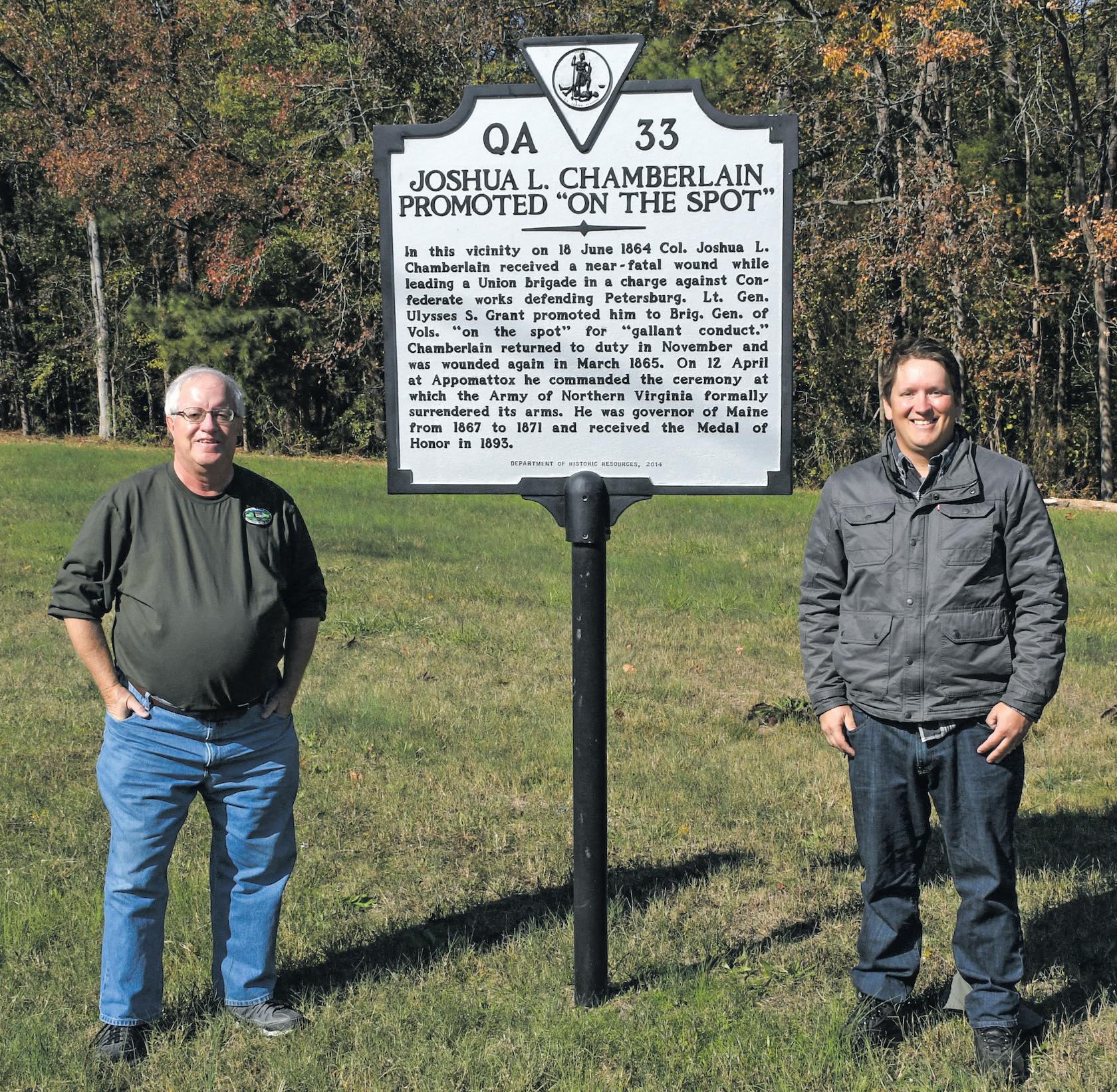
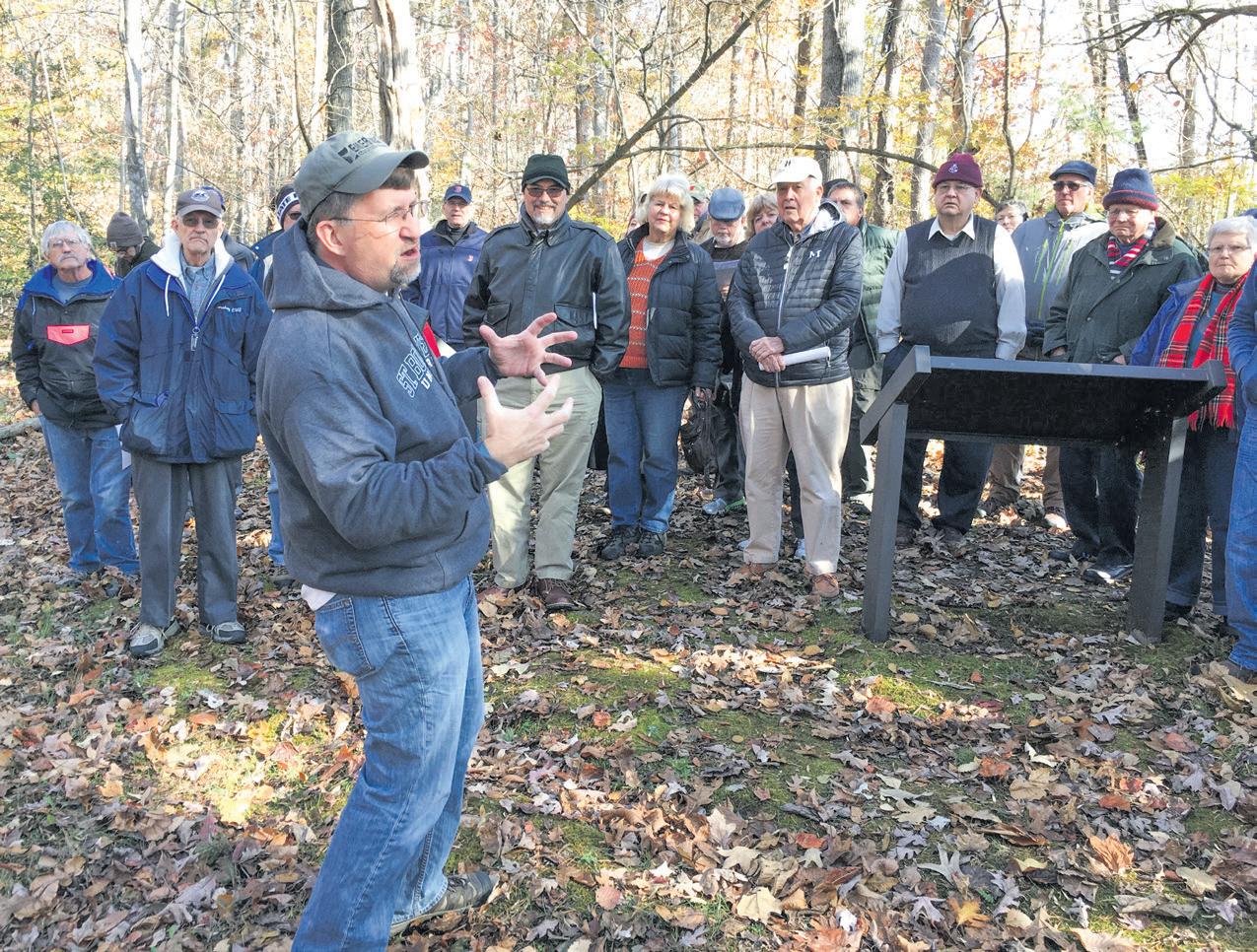
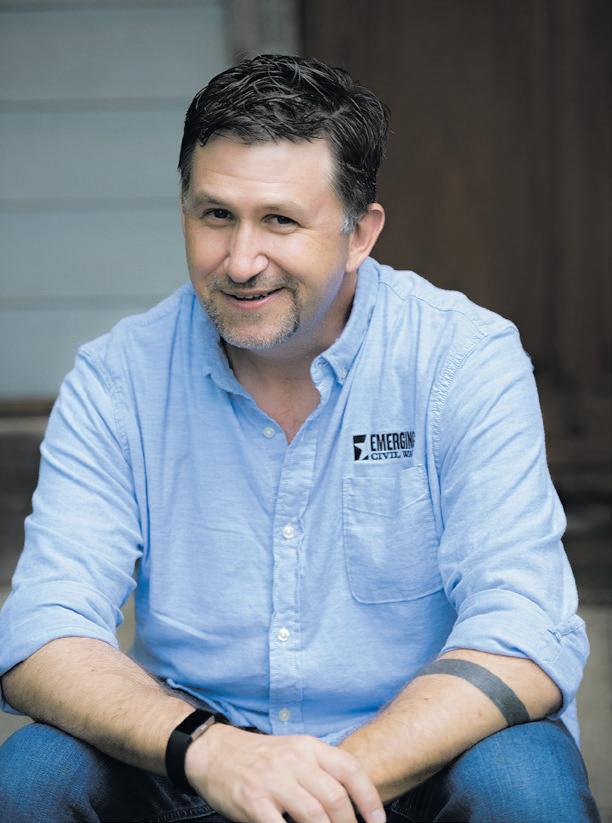
Chris Mackowski and Dave Powell traveled to California in November to serve as the keynote speakers at the West Coast Civil War Roundtable Conference. Chris offered a talk on Burnside’s leadership at the battle of Fredericksburg and one on Confederate leadership at the battle of Chancellorsville. Dave talked about leadership at
Edward Alexander spent a day on the battlefields of Petersburg with ECW’s friend Brian Swartz, the blogger behind Maine at War. Brian is working on a biography of Joshua Lawrence Chamberlain for the Emerging Civil War Series. You can read Brian’s work each month at Maine at War: http://maineatwar.bangordailynews.com.
Sean Michael Chick has been on the speaking circuit. Most recently, he spoke about P.G.T. Beauregard and the battle of Petersburg to the Mobile Civil War Roundtable. Sean’s biography of Beauregard will be coming out this spring as part of the Emerging Civil War Series.

28 Civil War News January 2020
Chris Mackowski
Chris Mackowski welcomes the Hershey and Harrisburg Civil War Roundtables to Grant’s Knoll in the Wilderness.
Following a talk at the Lincoln-Davis Civil War Roundtable in Illinois, ECW’s Steve Davis received a gift from ECW reader Larry DeMar: a copy of Sarah Bierle’s Call Out the Cadets: The Battle of New Market.
Brian Swartz and Edward Alexander at the site of Joshua Lawrence Chamberlain’s wounding at Petersburg, where Chamberlain was, according to the historical marker, “promoted on the spot.”
Doug Crenshaw will be speaking on the battle of Glendale at the Powhatan CWRT in January and at the Richmond CWRT in February.
Jon-Erik Gilot has published an essay in Volume III of the Journal of the Shenandoah Valley During the Civil War, published by the McCormick Civil War Institute at Shenandoah University. In “Hardships and Dangers Bind Men as Brothers,” Gilot examines the 170th Ohio National Guard during the summer of 1864. You can get the journal at Amazon.
The pre-publication notice for Dwight Hughes’s Emerging Civil War Series volume, Unlike Anything that Ever Floated: The Monitor and Virginia and the Battle of Hampton Roads, was featured for spring 2020 release in the Savas Beatie Facebook page. Pre-order this exciting addition to the ECWS today!
Dwight was also recently invited by The Civil War Monitor to write a book review on “Our Little Monitor:” The Greatest Invention of the Civil War by Anna Gibson Holloway and Jonathan W. White (Kent State University Press, 2018). Look forward to his review in an upcoming edition of the magazine.
Speaking of book reviews, Dan Welch will have several book reviews in the coming issues of The Civil War Monitor and Gettysburg Magazine. Look for them when they hit the shelves.
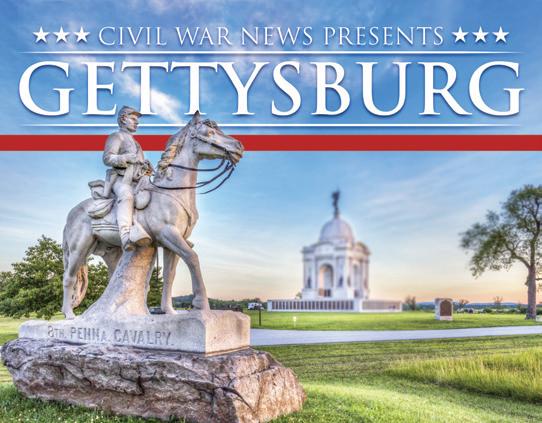
ECW’s Chief Historian, Chris Kolakowski has some exciting news to share. He will be leaving his post at the MacArthur Memorial in Norfolk, Virginia, and heading to the colder and snowier environs of Wisconsin where he will take the reins at the Wisconsin Veterans Museums in Madison. Congrats, Chris!
On Saturday, November 16, Chris Mackowski gave a bus tour of the Wilderness battlefield for the Hershey and Harrisburg Civil War Roundtables.
Kevin Pawlak and Dan Welch spent a day at Antietam National Battlefield, braving the cold, to bring more videos to ECW’s YouTube channel. We’ll have plenty of great videos on the battle coming out over the next several weeks so stay tuned!
Dan had an article on the battle of Cedar Mountain published by the Essential Civil War Curriculum. You can find it here: https://www.essentialcivilwarcurriculum.com/the-battle-of-cedar-mountain.html.
Emerging Civil War Podcast
November 1862 saw the




replacement of George B. McClellan with Ambrose Burnside. In the first ECW Podcast of November, Chris Mackowski spoke with Kevin Pawlak about McClellan’s tumultuous time after Antietam and the lead-up to his final firing.
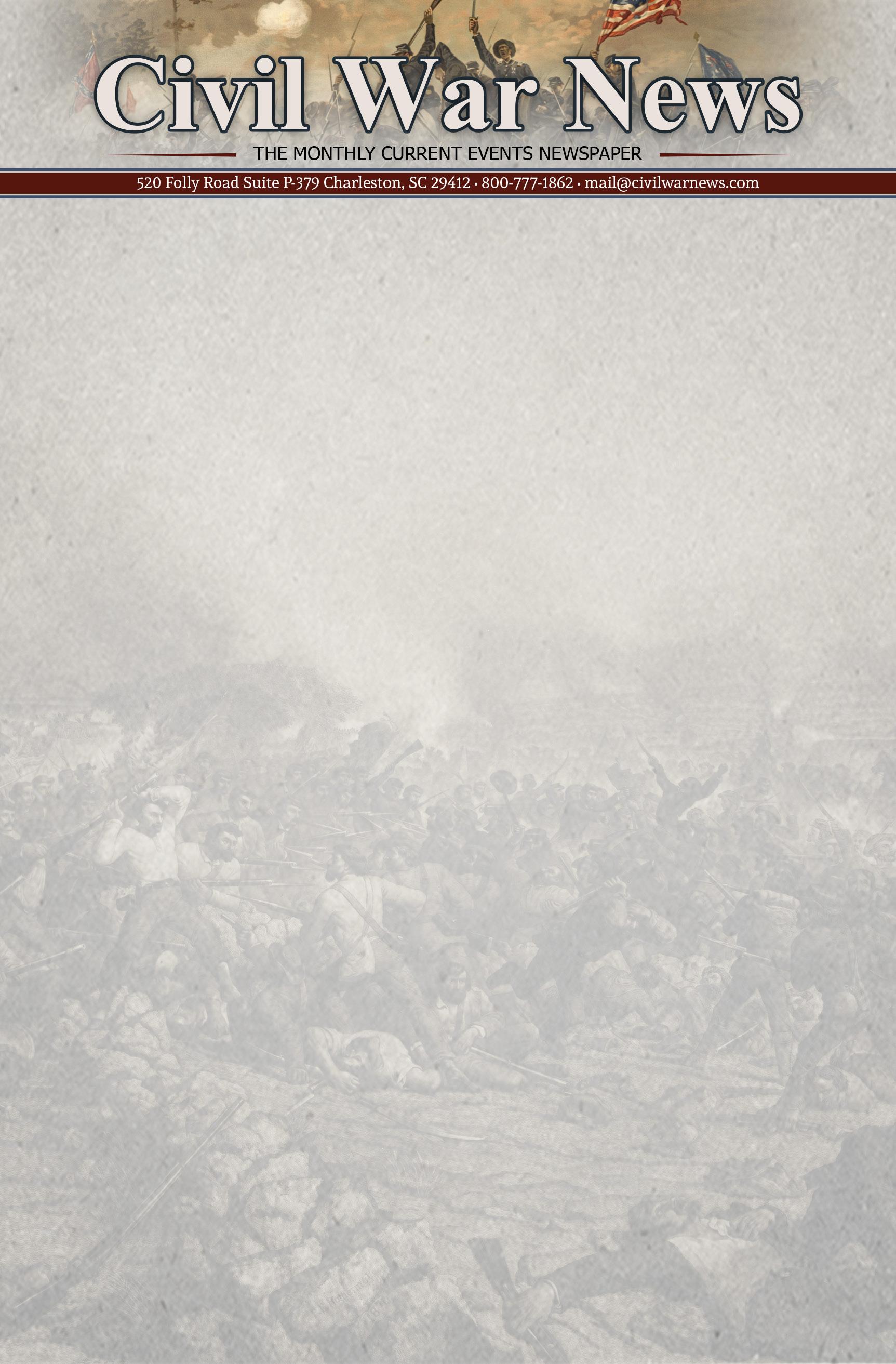
The second ECW podcast for November featured a conversation Chris had with historian Emma Murphy of the Andrew Johnson National Historic Site. Chris and Emma talked about Johnson’s impeachment. Learn about the precedent and the process behind today’s headlines!
You can subscribe to the podcast at https://www.patreon.com/ emergingcivilwar.
10 Questions...with Steward Henderson
Steward Henderson is a Fredericksburg-based historian who specializes in the role of the United States Colored Troops in the Civil War. We first profiled him in the December 2016 newsletter (https://conta.cc/2iezSA3). You can read his full Emerging Civil War bio here: https://emergingcivilwar.com/author-biographies/ authors/steward-henderson/.
seasonal rangers across the country were laid off in 2018 due to a paperwork change, I started to volunteer at the park again. I especially liked leading tours and talks and working at the battlefields. Additionally, I had been working on a Civil War medical and surgical project for the park and completed the first portion of that project. I continue to work with Chief Historian John Hennessy on tours and projects. I also continue to work at the park’s bookstores, where I am purchasing and reading the newest Civil War books, as well as reading some of the books that I do not own. This lets me continue to be at the park several days per week.
Why has it been hard to slow down?
It’s been hard to slow down because I have continued to be a living historian and reenactor for the 23rd USCT and the 54th Massachusetts Co. B. We are still being asked to participate in many programs. I have not been able to do as many as I want, but I still do quite a few. I have tried to help out friends by participating at various Civil War battlefields, and I have participated in a few New Market Heights programs (for instance, I did the voiceover for the American Battlefield Trust’s Richmond Battlefield App for New Market Heights). I participated in the Appomattox Court House Lantern Tour. I was going to do the Cold Harbor Lantern Tour, but it was cancelled by inclement weather for the past two years. Spotsylvania Court House Battlefield had a living history audience-immersion event, in which the visitors got to follow the reenactors on Upton’s Charge of May 10th and the Battle of the Mule Shoe. A couple of us from the 23rd USCT escorted the Confederate prisoners to the rear.
Roundtable. At St. George’s Episcopal Church, I gave a lecture titled, “War Comes to the Church.” For the Hampton Roads Civil War Roundtable and two Senior Citizen organizations, I gave lectures on “The Importance of the Fredericksburg Area in the Civil War.” Plus, I gave several talks on the 23rd USCT at various churches, Juneteenth programs, Veterans Day programs, and Black History Month programs.
I have acted in two of the skits in the first two annual “Fredericksburg Untold Stories” programs. Both skits were about the 23rd USCT. Those skits have made our friend and Supervisory Historian, FRSPNMP, Greg Mertz a star actor!
Another treat has been working with my fellow Emerging Civil War friends, Chris Mackowski, Kris White, Dan Davis, Phil Greenwalt, Ed Alexander, and Doug Crenshaw, participating in American Battlefield Trust Facebook Lives for Chancellorsville and the Overland Campaign. I cannot forget Garry Adelman and all of the energy he brings to the events. But the real star is Connor Townsend, behind the camera, who had to keep us crazy Civil War guys in line— and she did a fantastic job!
Finally, I had been asked to get involved in several committees in the Fredericksburg area: the St. George’s 300th Anniversary
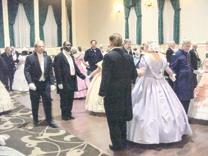
History Committee, and a Fredericksburg committee to decide what to do with the slave auction block. Just in the last month, I have been asked to serve on the City of Fredericksburg Memorials Commission and the African American History Committee.
Aside from the 23rd USCT, what are some of the other Civil War interests you’ve been pursuing these days?

I am researching and writing a book on the United States Colored Troops. I had long planned to do this, but I was happy just writing for Emerging Civil War. Then my wife, Malanna, several of my former bank colleagues, and some who know me as a Civil War living historian kept pushing me to write my book on the USCT. So, I am finally in the process of writing it.
The 23rd USCT and 54th Massachusetts Company B (I belong to this unit as well) have been asked for this year and next to participate in the 200th Anniversary of Israel Metropolitan CME Church (formerly Israel Bethel). One of the church’s founding members was Reverend Henry McNeal Turner, Chaplain of the 1st USCT and the first African American Chaplain selected by President Abraham Lincoln. We also hope to be a presence in the 155th Anniversary of the battle and surrender at Appomattox
During the Sesquicentennial, you were exceptionally busy doing living history events and talks related to your favorite regiment, the 23rd USCT. You said you were going to slow down once the 150th wrapped up. But it seems like you’ve still been plenty busy! What have you been up to?
I had been working as a park ranger at the Fredericksburg and Spotsylvania National Military Park (FSNMP). After many


I fulfilled one of my bucket list items: I participated in the 155th anniversary reenactment of the Battle of Wilson’s Wharf at Fort Pocahontas, in Charles City County, Va. This was the battle that I talked about at the 2017 Emerging Civil War Symposium. Speaking to various groups ensures that I am keep entrenched in the history of the Civil War. I constantly reinforce my themes and seek more information to add to my presentations.
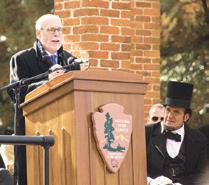

I have given lectures and speeches to the various organizations. At the University of Mary Washington Elder Study program, I gave a two-hour lecture, “Fighting for Their Freedom: The United States Colored Troops.” I gave a portion of the same lecture to the Powhatan Civil War


29
January 2020 Civil War News
Historical Publications, LLC Civil War News • 800-777-1862 520 Folly Road, Suite 25 PMB 379 Charleston, SC 29412 www.CIVILWARNEWS.com UP-TO-DATE COVERAGE • PRESERVATION NEWS • BOOK REVIEWS SHOWS, LIVING HISTORY AND REENACTMENTS • HISTORICAL ARTICLES MONTHLY COLUMNS • CALENDAR OF EVENTS STAY INFORMED! Only $38.50/One Year • $66.00/ Two Years THE MONTHLY CURRENT EVENTS NEWSPAPER -FORCIVIL WAR ENTHUSIASTS SINCE 1974 12 ISSUES PER YEAR PRINT & DIGITAL EDITIONS AVAILABLE CALL OR SUBSCRIBE ONLINE TODAY! 2018 CW N No. $3.50 America’s Newspaper For Civil Enthusiasts The Trust members saved in Culpeper Virginia. of Civil War Trust’s Path to Preservation CW N January $3.50 Civil News America’s Monthly Newspaper For Civil Enthusiasts Dancing page 27 issue: Inspection, Through Roundtable GETTYSBURG, that woundingGettysburg, sortstown hear morebattle Gettysburg place seekwhere dancing theyEstablished Brother’s, Severalhaunt tavern. “Rebecca,”seen Whether dinner participatedancing. Newbold Duffypresentingtheincluding photographs onlyHotel. balls, the enjoying Dancing the Night Away at the Gettysburg Hotel Floor blur Lincoln Scholar Harold Holzer’s Oration at the 154th Anniversary of the Gettysburg Address National November Washington—standsEmancipation extendinhalf-nakeddeclared day, aparteveryafter-coming generationsexalted Abraham Douglass’s incorrect. slave degrading.Douglass’s contested sculpturere-consecrate acknowledgcontroversy—the memory gather speech not gavewithMeadevalor, onto issueLost retrievable,equal—remained Now war—a condemned, defaced,went inspire challenge collective recallsundisputed INSIDE EVERY ISSUE
Steward Henderson in uniform as a member of the 23rd USCT
Court House next year.
You’ve pioneered something new at the Spotsylvania battlefield: instead of dressing in your park service uniform, you’ve been dressing in your Union uniform and interacting with visitors that way, appearing more as a living historian instead of just as a park ranger. What have those interactions been like for you?
FSNMP recently had a threeday planning workshop I was able to attend. One suggestion for the future was for a living historian to appear on the battlefields to interact with visitors. Since I was working the Spotsylvania Battlefield on the following Sunday for the park, I volunteered to experiment with this suggestion. That day was very enlightening. More visitors approached me in my Civil War uniform, as a percentage, than when I was dressed in my park ranger’s or park volunteer’s uniforms. I gave four 20-minute programs on the Battle of Spotsylvania Court House and the role that the USCT played. I had several conversations about why I was there in my Civil War uniform. Next time I try it, I would do some first-person scenarios.
I thought that it was good to pioneer this program because there were visitors who did not know that the USCT played a role in the battle. Plus I could talk about
the 23rd USCT becoming the first African American regiment fighting against the Army of Northern Virginia.
You’ve been doing some work with Fredericksburg Tours lately. Tell us about that.
Working for Fredericksburg Tours, leading private Civil War battlefield tours of the Fredericksburg-area battlefields, lets me keep doing what I love to do. People contact us, and I ride with them in their personal vehicle and give them a private battlefield tour in greater detail than I can give working as a ranger. The tours range from two to eight hours on a battlefield. Most tours I have led have been for more than one of our battlefields, usually lasting a day and a half to two days. Next year, we are going to add the Bristoe Station, Mine Run, North Anna, and Rappahannock Station battlefields. One day, I hope for a tour of Fort Harrison and New Market Heights in the Richmond battlefield!
I am creating a new tour for Fredericksburg Tours, “From Enslaved to Soldier.” This tour will be an African American History tour about slavery in the Fredericksburg area, the escape of 10,000 slaves during the first Union occupation of Fredericksburg, and the ones who return in the 4th Division of the IX Corps. The first tour
is planned for Feb. 22, 2020. It also is helpful that the City of Fredericksburg wants to encourage more African American history of the city and surrounding counties.
Lightning Round (short answers with a one-sentence explanation)
Favorite primary source?
Official Records of the War of the Rebellion. I also like to read letters and diaries of soldiers who fought in the Civil War.
Favorite Civil War-related monument?
The African American Civil War Memorial and Museum in Washington, DC. It is dedicated to all of the African Americans who played a part in the Union war effort and pays tributes to the soldiers and sailors. The museum across from the monument is the home of all of the USCT living history regiments.
Favorite unsung hero of the Civil War era?
Frederick Douglass. He was the most important African American of the 19th century. He was an orator, author, abolitionist, and USCT recruiter.
What’s a bucket-list Civil War site you’ve not yet visited?

I would like to visit Fort Monroe to honor the XXV Corps, the contrabands, and Major General Benjamin Butler’s dedication to the United States Colored Troops.
Favorite ECWS book?
I still think the first one is my favorite, Simply Murder: The Battle of Fredericksburg, because I think it made Emerging Civil War more identifiable and well known to the public. Look what has followed since it was written!
Emerging Revolutionary War News
November saw some of the members of the Emerging Revolutionary War take their annual American Revolutionary War road trip. This year’s agenda included sites both in the French and Indian War and American Revolution in New York and Vermont. Highlights included Saratoga Battlefield, Fort Ticonderoga, and the only battlefield in Vermont, Hubbardton. Check out ERW’s Facebook site for Facebook Live videos from some of these sites, and read the blog for posts generated from the trip: www.emergingrevolutionarywar.org
Plans are in motion, as well, for the second annual Emerging Revolutionary War symposium in partnership with Historic Alexandria. Updates are on the blog as well under the “symposium” tab.

Speakers Bureau Spotlight
Doug Crenshaw, a strategic consultant with the Commonwealth of Virginia, is an author, speaker, and tour leader specializing in actions around Richmond. You can read his full bio here: https://emergingcivilwar.com/author-biographies/ authors/doug-crenshaw.
Talks and Tours:
• The Seven Days
• Glendale: Lee’s Lost Opportunity
• Fort Harrison and the battles of Chaffin’s Farm
Tours:
• Seven Pines
• Hanover Court House,
• June 1 at Cold Harbor
Descriptions about his talks and a full bio are available as part of the 2019-2020 ECW Speakers Bureau Brochure, available here: https://emergingcivilwar.com/ upcoming-presentations.
Digital Issues of CWN are available by subscription alone or with print plus CWN archives at CivilWarNews.com
Civil War Catalog
Featuring a large assortment of Civil War and Indian War autographs, accoutrements, memorabilia, medals, insignia, buttons, GAR, documents, photos, & books. Please
30 Civil War News January 2020
Emerging Revolutionary War historians (from left) Billy Griffith, Kevin Pawlak, Phill Greenwalt, Mark Malloy, and Rob Orrison visited the Saratoga battlefield.
our
Free copy mail catalog Mike Brackin PO Box 652, Winterville, NC 28590 • 252-565-8810
visit
fully illustrated online catalog at www.mikebrackin.com
Fort Fisher, North Carolina: The Gibraltar of the South
by Chris E. Fonvielle Jr.
General Robert E. Lee’s telegram to military authorities in North Carolina in late 1864 expressed a sense of urgency. “If Wilmington falls, I cannot maintain my army,” he wrote. The message was clear. The survival of the Army of Northern Virginia, and thus the Confederacy, depended upon the survival of Wilmington as a blockade running seaport. For more than three years, Confederate commerce vessels had been importing firearms, ammunition, edged weapons, blankets, medicines, hardware, food, and civilian goods from Europe, especially Great Britain, through the U.S. Navy’s blockade of Wilmington to help the Confederacy sustain its war effort.
Wilmington was ideally situated for the blockade running trade as it was located near the British transshipment points of Bermuda and Nassau, out of which blockade-runners operated. As the ships approached the seaport on the Cape Fear River, they could access the harbor by two entryways: Old Inlet at the mouth of the river, and New Inlet six miles to the north. The dual passageways, separated by Bald Head Island and Frying Pan Shoals, offered blockade-runners a choice of entry and exit. Union blockading vessels off Wilmington found it virtually impossible to halt the more than 100 speedy steamships and an undetermined number of sailing vessels that enjoyed an astounding success of about 85 percent.
Once the smuggled supplies reached the Tar Heel seaport they were transported along three railroads to the needy on both the battlefront and home front. The most important was the Wilmington and Weldon Railroad which ran from Wilmington to Goldsboro and then Weldon, North Carolina, where it connected with the Petersburg and Weldon Railroad. The Wilmington and Weldon Railroad served as Gen. Lee’s main supply route in the last year of the war and became known as “Lee’s Lifeline” and the “Lifeline of the Confederacy.”
To protect Wilmington, the Cape Fear River, the Wilmington and Weldon Railroad, and the inlets that blockade-runners used, Confederate engineers constructed a vast network of forts and batteries. To protect New Inlet, the most popular entryway for blockade-runners, they built the strongest seacoast fortification in the Confederacy—Fort Fisher. It was like no other fort that had ever
existed before the Civil War. Its elevated artillery batteries, made of beach sand and wooden bunkers underneath, rose high above the sea beach and kept Union blockading gunboats at bay. With good reason Confederate and Union observers alike dubbed Fort Fisher the “Gibraltar of the South.” In September 1861, the works were named in honor of Colonel Charles F. Fisher of the 6th Regiment N.C. Troops, who was killed in the war’s first major land battle at Manassas, Virginia on July 21, 1861.

After Union forces captured New Bern and Beaufort, North Carolina, and retook Norfolk in the spring of 1862, Wilmington became the closest seaport to the Virginia battlefront. “To close the port of Wilmington is undoubtedly the most important and effective demonstration that can be made,” exclaimed U.S. Secretary of the Navy Gideon Welles. “If of less prestige than the capture of Richmond, it would be as damaging to the Rebels.” Yet President Abraham Lincoln’s administration and the U.S. War Department ignored Welles’s requests for support in an attack on Wilmington which it considered of little strategic value compared to Richmond, Chattanooga, and Atlanta. Consequently, the Union navy shifted its attention to Charleston, the birthplace of secession and the war, and the center of popular and political interests. Operations on the Mississippi River, especially against Vicksburg, also took precedence.
The government’s attitude toward Wilmington finally changed in the summer of 1864. In early August, Adm. David G. Farragut sealed Mobile Bay, Alabama to blockade running, leaving Wilmington as the only major seaport open to trade with the outside world. President Lincoln now agreed with Secretary Welles’s plan to strike Wilmington, but deferred final approval to Lt. Gen. Ulysses S. Grant, commander of U.S. Army forces.
Grant initially expressed little enthusiasm as it would require him to provide a large expeditionary force to assist the navy. In his opinion he needed more soldiers to maintain the pressure on Robert E. Lee. Since the late spring of 1864, Grant’s operational forces—the Army of the Potomac and the Army of the James—had been battling Lee’s Army of Northern Virginia for possession of Petersburg. As the summer progressed, the siege had devolved into a stalemate
that neither side had been able to break. Grant did not believe he could afford to dispatch troops for an attack on the coast of southeastern North Carolina.
Welles argued that the deadlock in Virginia could be broken by closing Wilmington to blockade running, thus denying General Lee the weapons, food, and clothing his army so desperately needed. Grant eventually came around, but it was not until December that the expeditionary force was ready to go. Admiral David D. Porter commanded the naval task force that targeted Fort Fisher. He assembled the largest fleet of the war—64 warships mounting a total of 627 cannons. Porter believed it would take that kind of firepower to reduce the massive stronghold. Over a two day period, December 24-25, 1864, his warships fired at least 20,271 shells at the sand bastion in the largest naval bombardment of the Civil War. Nevertheless, the stout Confederate defenses and defenders held their own.
The Union defeat at Fort Fisher was offset by Gen. William T. Sherman’s capture of Savannah, Georgia on December 21, 1864. For his part Grant was glad to see Sherman safely on the coast and eager to transfer his powerful 60,000-man army by sea to Virginia for a final showdown with Lee at Petersburg. Sherman had other plans. He proposed to march his army to the Old Dominion by way of the Carolinas, destroying supply depots and railroads and “smash things generally” along the way, as he had done so effectively in his “March to the Sea” across Georgia earlier that autumn. Once he reached Goldsboro, North Carolina his army would be in an advantageous position to strike the Army of North Virginia from below. Sherman predicted that his advance would force Lee
out of Petersburg and into open country where he and Grant together could trap him in a pincer movement.
Sherman’s ambitious plan and his confidence pleased Grant. The crowning benefit might well be the collapse of the Confederacy. “Make preparations to start on your Northern expedition without delay,” Grant wrote Sherman. “Break up the rail-roads in South & North Carolina and join the Armies operating against Richmond as soon as you can.”
Having agreed to Sherman’s bold Carolinas Campaign, as historians call it, Grant determined to guarantee its success by furnishing Sherman’s army with provisions, reinforcements, and equipment, or a haven on the seacoast if need be, halfway between Savannah and Petersburg. Wilmington took on a whole new meaning for Grant. The city must be captured!
To cooperate with the mercurial Admiral Porter, Grant assigned the capable and affable Brig. Gen. Alfred H. Terry, respected commander of the newly formed 24th Army Corps, to command the Wilmington expeditionary force of 9,600 officers and men.
Porter’s warships, slightly scaled down to 58 in number, and Terry’s transports reached Fort Fisher late on the night of January 12, 1865. The battle opened early the following morning. The navy proceeded to bombard the fort for two-and-a-half days, firing almost as many projectiles (19,682) as in the Christmas attack. As Porter’s gunboats pummeled the defenses, Terry’s infantry landed. After positioning his troops over the following two days, he launched a ground assault late on the afternoon of January 15. A shore party of more than 2,200 volunteer sailors and Marines from various ships in the fleet also stormed Fort Fisher.
The Confederate defenders, led by Colonel William Lamb and Maj. Gen. W.H.C. Whiting, rushed from their bombproofs to meet the attack. They succeeded in turning back the poorly armed and disorganized naval column that had advanced along the beach, but soon became embroiled in hand-to-hand combat with Union soldiers who had secured a lodgment on the fort’s ramparts. The savage, close-quarters fighting raged for more than five hours before the heavily outnumbered and outgunned Southerners were driven from the fort. With both Lamb and Whiting seriously wounded, the surviving 2,000 defenders surrendered at about 10:00 o’clock on the night of January 15, 1865, After receiving reinforcements, the Federals then launched an attack upriver to capture Wilmington on February 22, 1865.
No longer able to supply his depleted and embattled troops by way of the Wilmington and Weldon Railroad, and now threatened by two numerically superior armies, Lee was forced to retreat from Petersburg. The situation was just as he had predicted if Wilmington fell. Grant followed closely on Lee’s heels, battling him to Appomattox Courthouse where, on April 9, Lee surrendered the Army of Northern Virginia. The Union victory at Fort Fisher and Wilmington severed Lee’s lifeline and guaranteed the success of Sherman’s Carolinas Campaign.
The Fort Fisher State Historic Site will commemorate the 155th anniversary of the Second Battle of Fort Fisher the weekend of January 18-19, 2020.
For further reading, see: Chris E. Fonvielle Jr, The Wilmington Campaign: Last Rays of Departing Hope.
31 January 2020 Civil War News
Destruction to Fort Fisher’s Battery No. 4 as a result of the U.S. Navy’s bombardment in midJanuary 1865. (Library of Congress)
Captured 2nd National Battle Flag
by Shannon Pritchard
The flag of the Confederacy rose and fell in only four years. It rose over a prosperous, peaceful nation whose mothers sent their husbands and sons to die, if need be, under its folds. Die they did, from the plains of Manassas to the fields of Pennsylvania, from Shiloh to Nashville, from the Wilderness to Appomattox, and from Southern seaports to the shores of distant lands.
The flag the Confederacy adopted as its national standard on March 4, 1861, was first raised on Capitol Hill in Montgomery, Ala. The honorable Jefferson Davis, ex-U.S. Secretary of War and new president of the Confederacy, invited Letitia Christian Tyler to raise the first official flag of the new Confederacy. Miss Tyler had been born in the United States White House. She was the granddaughter of ex-U.S. President John Tyler. The seven star flag Miss Tyler raised that day has come to be known as the First National Confederate Flag, or the Stars and Bars. The circle of seven stars in the canton represented the seven Southern States that had seceded up to that time: South Carolina, Mississippi, Alabama, Florida, Georgia, Louisiana, and Texas.
As disunion became a reality and war fever swept the nation in the late winter and spring of 1861, countless towns, communities, and counties formed local military units in hopes of participating in the coming conflict. Lincoln’s illegal demand that the Southern States aid in subjugating her sister states caused

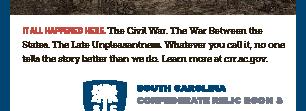
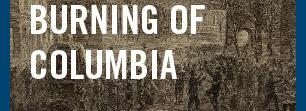
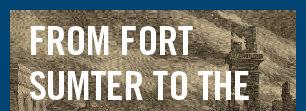
another six states to secede. Virginia on April 17, Arkansas, May 6, Tennessee, May 7, North Carolina, May 20, Missouri, August 5, and Kentucky on November 5. A star was added as each new state joined the Confederacy.
During the Battle of Manassas, it became obvious that the Confederate First National “Stars & Bars” would not do on the battlefield; it was too hard to tell it from the old “Stars and Stripes.” It had intentionally been similar to the flag their forefathers fought under, but a distinct, soldier’s flag was needed and what we now know as the Battle Flag was the result.
After two years of war, there was only hate for the old Stars and Stripes, so by an act of Congress, signed into law on May 1, 1863, a new flag was selected. After some last minute alterations, the final design was the “Stainless Banner.” It was part soldier’s flag and part national flag. The canton consisted of the battle flag, and the field was pure white, symbolizing the purity of the Confederate cause and her people.
The Second National Flag was used as a national, and also as a regimental, flag, by both the eastern and western Armies.
Much more is known about the military issued flag shown here than the vast majority of Confederate flags.
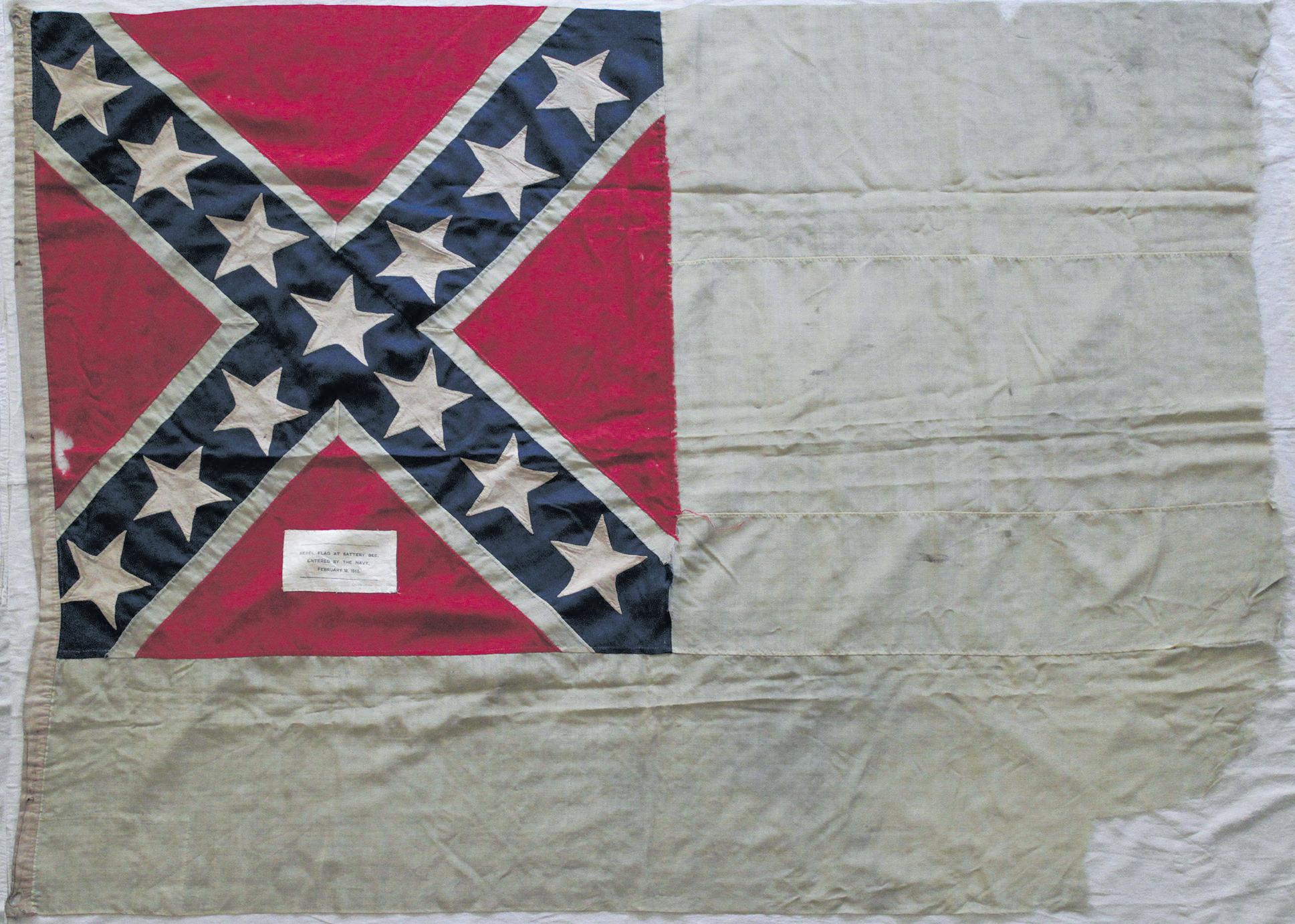
Noted flag historian Dr. Howard Madaus wrote a report on this flag on Nov. 26, 2003, from which much of the information is taken.
This flag measures 64½-inches on its hoist by 92½-inches on the fly (worn down from 96-inches), including 1¼” linen hoist binding. It is constructed of bunting with 7-inch linen stars inset with a welt and visible from both sides. Hand stitched grommets are at the top and bottom corners, with a 7 x 11-inch white reinforcing strip by the lower grommet and a 3 x 6-inch blue reinforcing panel at the top. The canton features a 46 inches square Army of Northern Virginia Battle Flag. The white field is composed of four strips, three 18-inches and one 10-inch; there is no fold on the top or bottom edge. The flag is completely hand stitched. Written in ink toward the lower corner of the hoist is “Battery Bee 1 Jany 1864” and at the upper corner “6 x 10”. Stitched to the flag on the lower center red portion of the canton is a 4½ x 8-inches polished cotton rectangle bearing the printed legend: “Rebel Flag Battery Bee/ Entered By The Navy,/ February 16, 1865.” The date refers to the day Union forces entered the Charleston defenses.
According to Madaus’ evaluation, “...the flag conforms to the style and size of the type produced for ‘posts and camps’ by the Confederate Clothing Depot at Charleston, S.C., there is no reason to doubt the ascribed history written on this cotton patch.” Doubtless this flag appears exactly as it was when removed from Battery Bee with one small tear along the hoist, the edge of the fly somewhat tattered, and a section of stitching that has opened along
one side of the canton.
Battery Bee was located in Charleston Harbor. The Report of Captain Warren Adams dated Nov. 20, 1863, indicates that Company I, 1st South Carolina Regular Infantry, also known as the 3rd South Carolina Heavy Artillery occupied the fortifications and took casualties on November 19, 1863. This would have been a mere six weeks prior to the flag`s issue of the flag. There are no records of that regiment being moved from their position although there may be later reports of Battery Bee being held by others after the evacuation.
After several attempts Battery
Bee was finally captured by the U.S. Navy on February 16, 1865.
The flag itself conforms to the Army revisions of the national flag adopted by the Confederate Congress on May 1, 1863, commonly referred to during the period as the Stainless Banner.
When the flag was issued in Jan. 1864, the forces that held “Battery Bee” were probably members of Company I, 1st South Carolina Regular Infantry, also known as the 3rd South Carolina Heavy Artillery (see the report of Captain Warren Adams, dated Nov. 20, 1863, regarding the casualties incurred at “Battery Bee” on Nov. 19, 1863, Official

“This battery was named in honor of General Bee; the soldiers seen are either coming on or going off duty. These guns were considered at the time to be among the best in the South, though they would be thought nothing of in these days.” – Conrad Wise Chapman, 1898
Perhaps this is the same flag that Conrad Wise Chapman painted above. (American Civil War Museum)
32 Civil War News January 2020
The Confederate Second National Pattern flag flown at Battery Bee.
Shannon Pritchard has authored numerous articles relating to the authentication, care, and conservation of Confederate antiques,
including several cover articles and is the author of the definitive work on Confederate collectibles, the widely acclaimed Collecting
the Confederacy, Artifacts and Antiques from the War Between the States, and is co-author of Confederate Faces in Color.
The flag’s maker wrote the flag’s original size on the hoist in ink: 6x10. With damage, the flag is now 7 feet 7 inches.
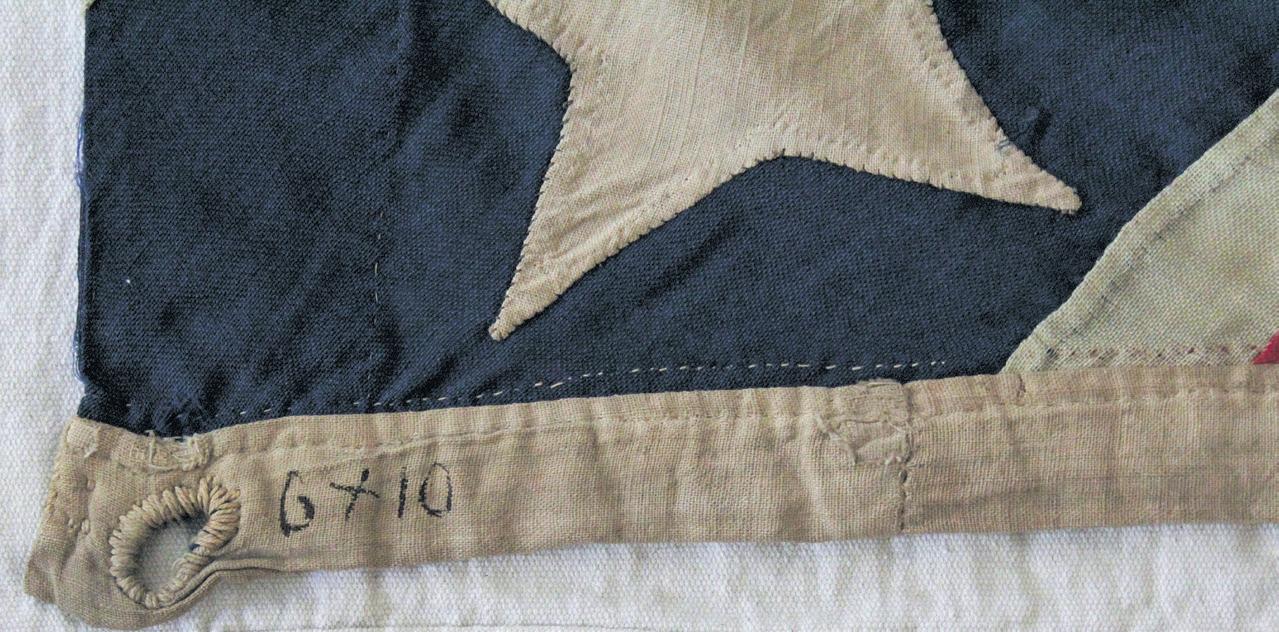
Records of the War of Rebellion, Series I, Vol. 28, Pt. 1, p. 744).
Companies C and H were also garrisoned at the battery at some point.
Battery Bee, so named under General Order dated Nov. 4, 1862, to honor South Carolina General Barnard Elliot Bee, who so famously coined the term “Stonewall” before being mortally wounded at 1st Manassas, was situated on the “western extremity” of Sullivan’s Island west of Fort Moultrie and designed to guard Charleston Harbor. Progressively enlarged, and mounting up to eleven heavy guns, the battery was initially commanded by Lt. Col. Lawrence M. Keitt, of the 20th South Carolina Infantry, who later gave his life at Cold Harbor. By May 1864, the battery was commanded by Major Warren Adams, 1st South Carolina Regular Infantry with two companies.

Battery Bee’s guns engaged Union Navy forces on several
occasions in 1863–64 with slight loss (detailed reports found in OR’s). The city of Charleston and Battery Bee were evacuated on Feb. 17, 1865 in orderly fashion (guns disabled, some critical stores withdrawn) and occupied by Federal troops under General Quincy Gillmore on Feb. 18, 1865. The flag was no doubt left flying in order to fool the Yankees that the battery was still occupied. No specific mention of the flag from Battery Bee is found in the Official Records though we can assume that once the defenses of Sullivan’s Island collapsed, the flags of all batteries on the island were quickly seized. On Feb. 18, Lt. Colonel A.W. Bennett of the 21st US Colored Troops, reported that men under his command had occupied Charleston and secured the flags of Fort Moultrie, Castle Pinckney, Fort Ripley, and seventeen signal pennants found in the city (Official Records, Series I, Volume XLVII, Part I:, 1018-1019).

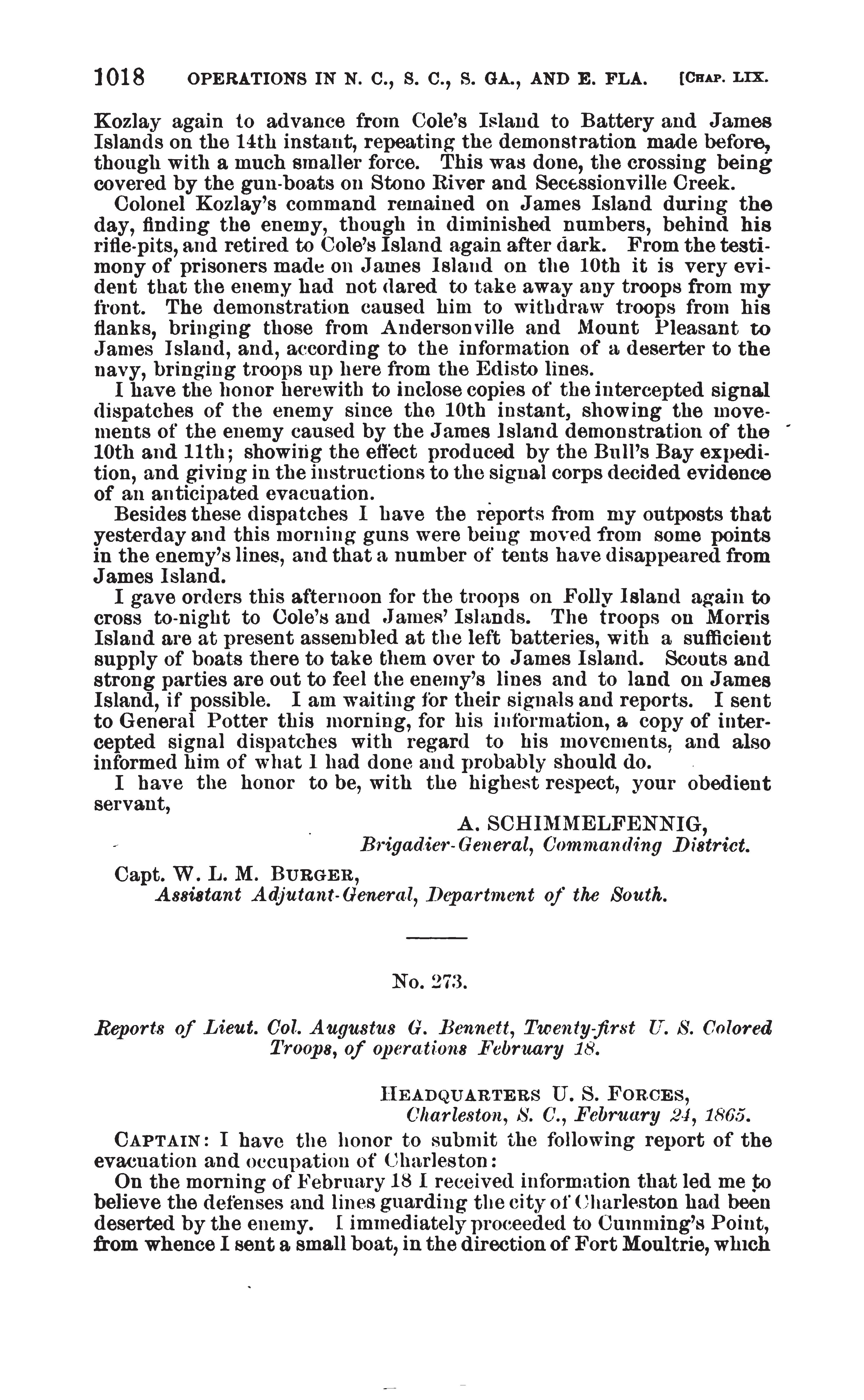

January 2020
A cotton swatch bearing the flag’s capture history was sewn to the flag’s canton with a whip stitch.
The inked inscription along the hoist reads: “Battery Bee 1 Jany 1864” This is presumably when the flag was first flown.
Official Records, Series I, Volume XLVII, Part I:, 1018-1019.
As an unfortunate side effect of time, the War of 1812 is a conflict known to many in name alone. Its dates, battles, ships, and the brave men who fought on both sides have long begun their slow fade into the pages of history books. A surprising feat considering the magnitude of the events that transpired in those two and a half years. The White House and Capitol building were burned to the ground, our National Anthem was penned, Captain Oliver Hazard Perry defended our country from enemy vessels in the Great Lakes, and the phrase “Don’t give up the ship,” was first uttered. It was a war filled with acts of incredible valor, fierce battles, future presidents and generals on the battlefield, and epic naval slugfests as the young United States yet again confronted one of the most powerful nations on earth.
One such battle in that conflict was the Battle of Fort Stephenson. Far from the largest battle of the war, there were only approximately 1,500 total combatants, but it did mark a substantial change in momentum and perfectly symbolized a proud and plucky American force against the overwhelming odds of the British and their mighty Navy. Fort Stephenson was barely more than a trading post fortified by log
palisades and a large ditch, and unfortunately surrounded by high ground. It was located where mod ern-day Fremont, Ohio, currently rests, now a small town about 20 miles down the Sandusky River from the southwest corner of Lake Erie. This small fort was all that stood between an American supply depot further inland and a British floatilla accompanied by a band of Native American warriors led by Shawnee warrior chief Tecumseh.
The sides were far from evenly matched. 700 British Regulars and 700-800 Native Americans were led by General Henry Proctor and came backed by several gunboats of the British fleet as well as a howitzer. The Americans were commanded by 21-year old Major George Croghan. His forces were a 160-man garrison and a weathered 6-pounder cannon named “Old Betsy.”
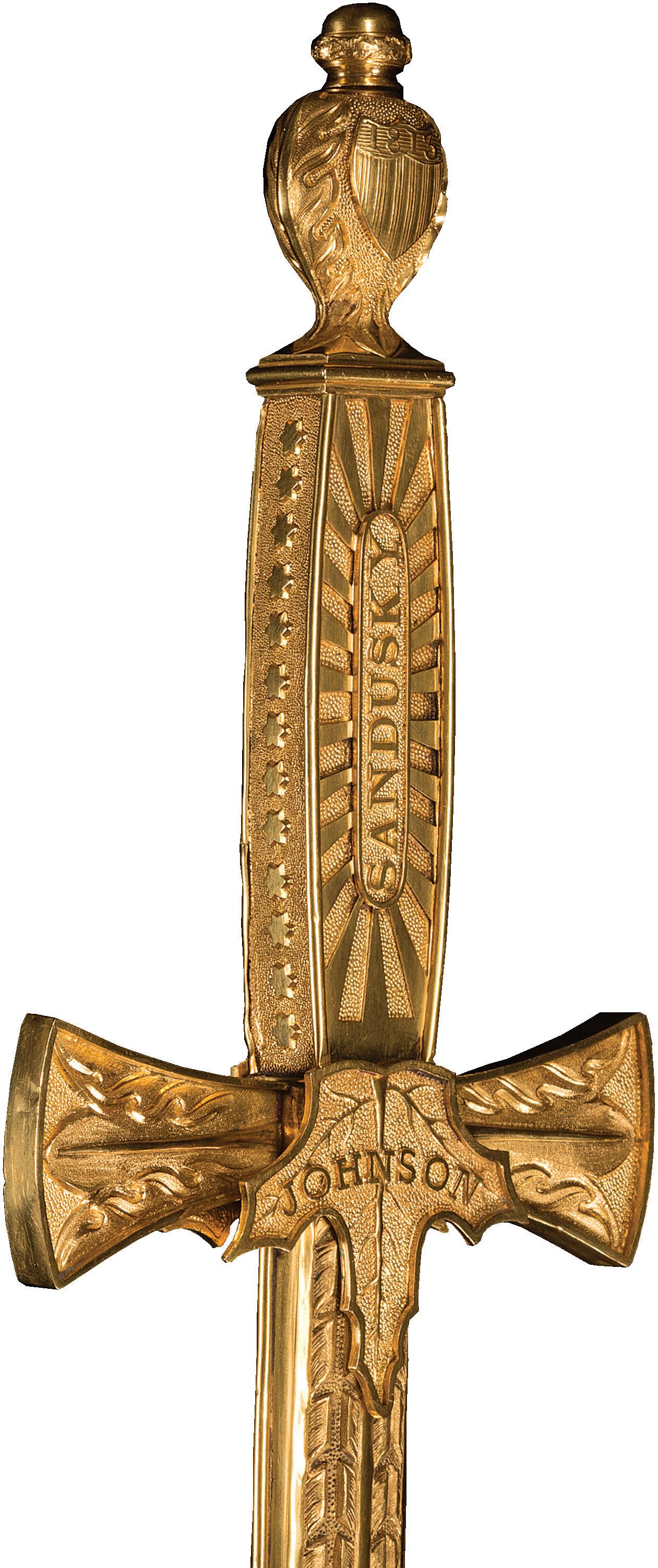
Croghan was ordered to evacuate and set the fort ablaze, but the young Major and his men remained behind prepared to defend
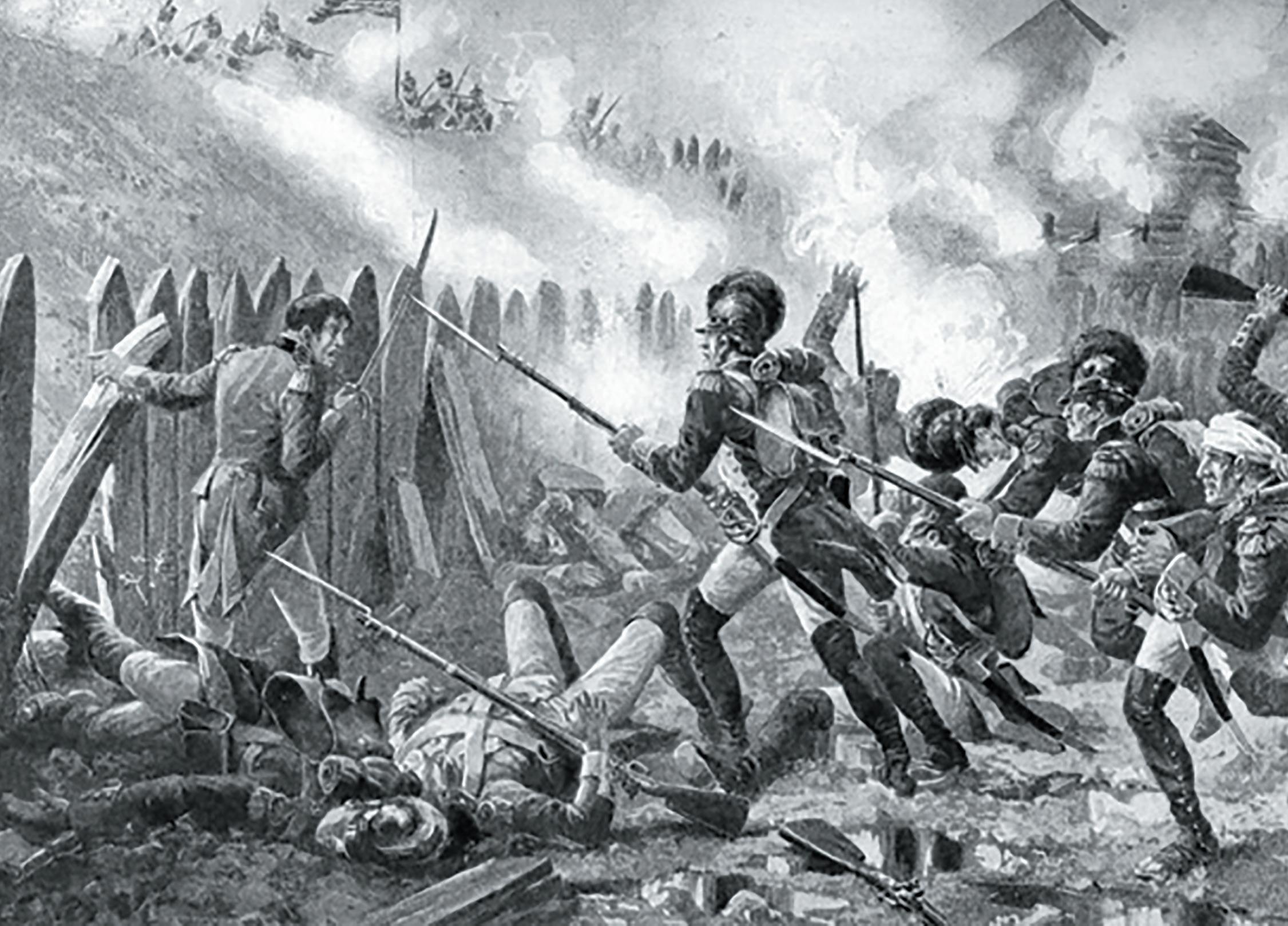
it to the last. Croghan wrote a letter in the days preceding the battle: “The enemy are not far distant. I expect an attack. I will defend this post till the last extremity. I have just sent away the women the children and the sick of garrison, that I may be able to act without encumbrance. Be satisfied. I shall, I hope do my duty. The example set me by my Revolutionary kindred is before me. Let me die rather than prove unworthy of their name.”
Days later, on August 1, 1813, Fort Stephenson found itself surrounded by Native American warriors and a British gunships. When British officers presented the terms of surrender, the reply came, “The fort will be defended to the last extremity; no force, however great, can induce us to surrender, as we are resolved to maintain this post or bury ourselves in its ruins.”
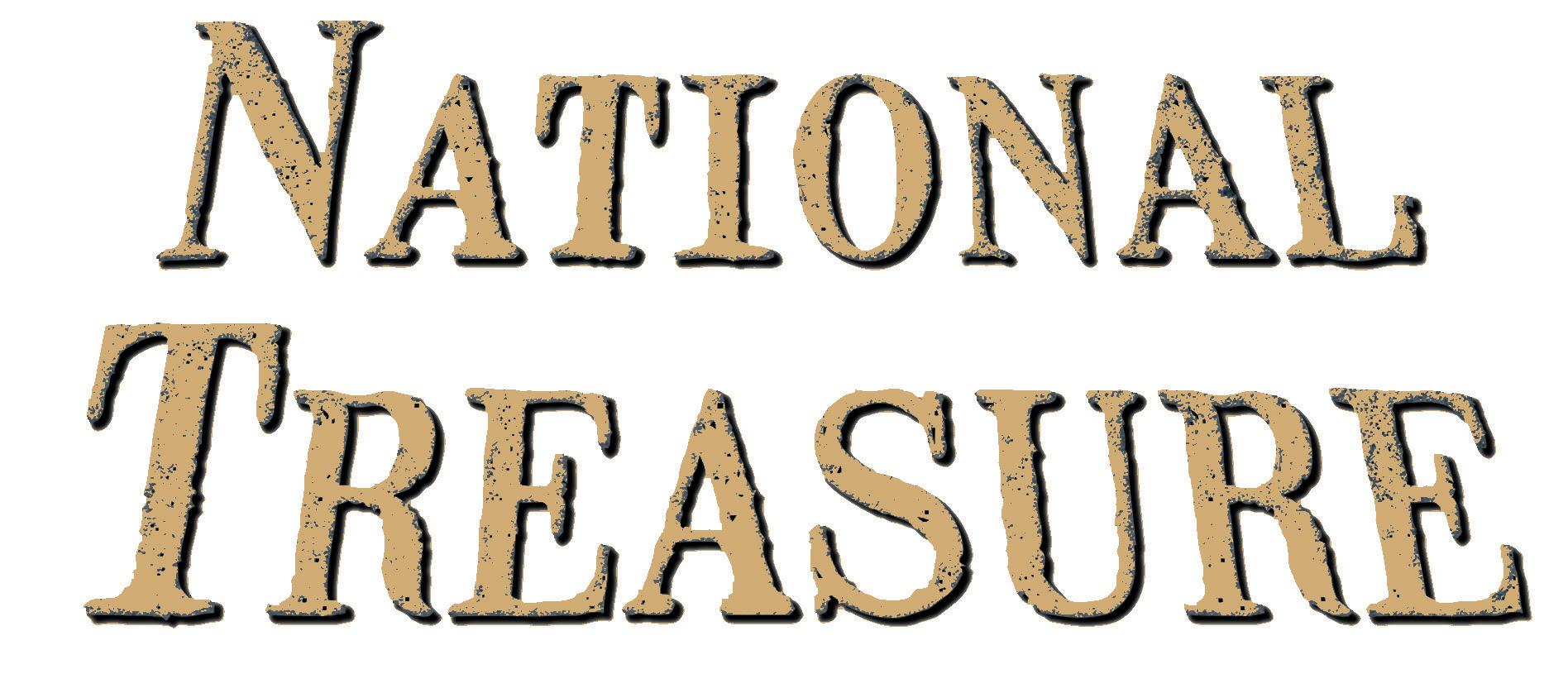
When the British officers further implored the Americans to surrender because they could not prevent the warriors from a massacre once the fort was taken, the Americans said, “When this fort is taken, there will be none left to massacre.”
This began an overnight bombardment by the British to weaken the fort’s palisades. The Americans answered with “Old Betsy,” moving her between shots to give the appearance of more guns returning fire.
As the British columns marched on the Fort the next day, American soldiers had orders to preserve their gunpowder and only fire when the Englishmen were so close that every shot would invariably find its mortal mark. When that moment came, the experienced American infantrymen rained down terror with their .69-caliber Springfield muskets on the tightly-formed British columns. The assailants sprinted for the cover of the ditch, expecting weakened walls from the night’s artillery bombardment, but the palisades remained largely intact against the smaller 6- and 12-pounder British guns. Without axes to hack the walls or ladders to scale them, the British were musket fodder, or would have been were it not for Old Betsy.
When the ditch was filled with Englishmen, a small port hole in the palisade flanking the ditch quietly opened and Old Betsy finally spoke in her terrible tongue. Given a half load of powder and a double load of lead slugs, her blast ripped through

34 Civil War News January 2020
Historic National Treasure Solid Gold Fitted Ames Congressional Presentation Sword Presented by President Andrew Jackson to Lieutenant Benjamin Johnson’s Family for Gallantry and Good Conduct in the Defense of Fort Stephenson During the War of 1812 Auctioned on Dec. 6-8, 2019 at RIAC. To see the results visit: www.rockislandauction.com.
By Joel R. Kolander
the mass of men at a distance of 30 yards. Subsequent shots tore men to bits until the remaining survivors fled to the cover of the woods. In the course of half an hour, the battle was won.
It was truly a change in momentum for the United States who at that point had little to crow about in the War of 1812. They wasted no time in seizing the opportunity to do so now. Croghan in his own report to Harrison had the following to say of his officers, “Too much praise can not be bestowed upon the officers, the non-commissioned officers, and privates under my command for their gallant and good conduct during the siege.”
One of those officers was Lieutenant Benjamin Johnson. After the battle this native Kentuckian was promoted to Captain in the 2nd Regiment of Riflemen, and the praise being heaped upon him would not stop with Croghan’s. His popularity would raise him to a Representative in the Kentucky legislature for many years where he was popular with his constituents. Even though Captain Johnson would die in 1830 at just 40 years of age, his valor was not soon forgotten.
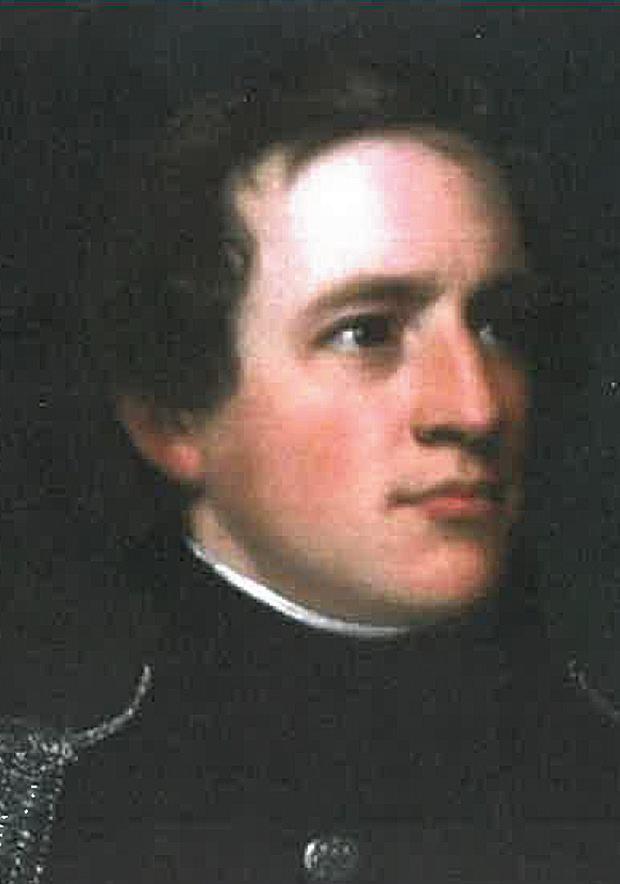
In 1835, Congress passed “a resolution presenting… a sword to each of the officers… for their gallantry and good conduct, in the defense of Fort Stephenson, in eighteen hundred thirteen… Resolved by the Senate and House of Representatives of the United States of America, in Congress assembled, that the President of the United States present a sword to each of the following officers engaged in that affair.”



Given posthumously, this incredible
sword was presented by President Andrew Jackson himself “to the eldest male representative of Lieutenant Benjamin Johnson.”


Forged and crafted by master artisans at the N. P. Ames, this stunning sword represents the highest level of U.S. presentation swords. In private collections today, there are only approximately SEVEN solid gold mounted swords presented by the president and congress for all U.S. wars. It is unquestionably a national treasure.
Not only is the craftsmanship of this sword exceptional, it has the materials to match. The cruciform hilt, four-sided grip, mounts, and throat of the scabbard are comprised not of gold plate, but of solid gold. The scabbard is gilt silver, and the length of the blade is etched with detailed embellishment and includes the presentation text, “Pursuant to a Resolution of Congress of the 13th of February 1835” on one side, and on the other, “Presented by the President of the U.S. to Lieutenant Benjamin Johnson.”
A sword of such beauty, history, and bravery is museum-worthy in every sense of the word. Those vying for this masterpiece aren’t just adding an exceptional blade to their collection; they are volunteering to safeguard this incredible American artifact for the next generation to cherish. This study in gold, silver, and steel tells the tale of when a little fort marked a big change for the entire nation.
Old Betsy was a 6-pounder cannon alleged to have served in the French-Indian War. Her devastating fire turned the tides at Ft. Stephenson nearly a half century later. She currently resides at the Soldier’s Monument in Fort Stephenson Park in Fremont, Ohio.

35 January 2020 Civil War News
“Presented by the President of the U.S./TO/Lieutenant Benjamin Johnson”
President Andrew Jackson
Lieutenant Benjamin Johnson
“Pursuant to a Resolution of Congress/of the /13th of February 1835”
by Gregory L. Wade
Battle of Mill Springs Final Reenactment

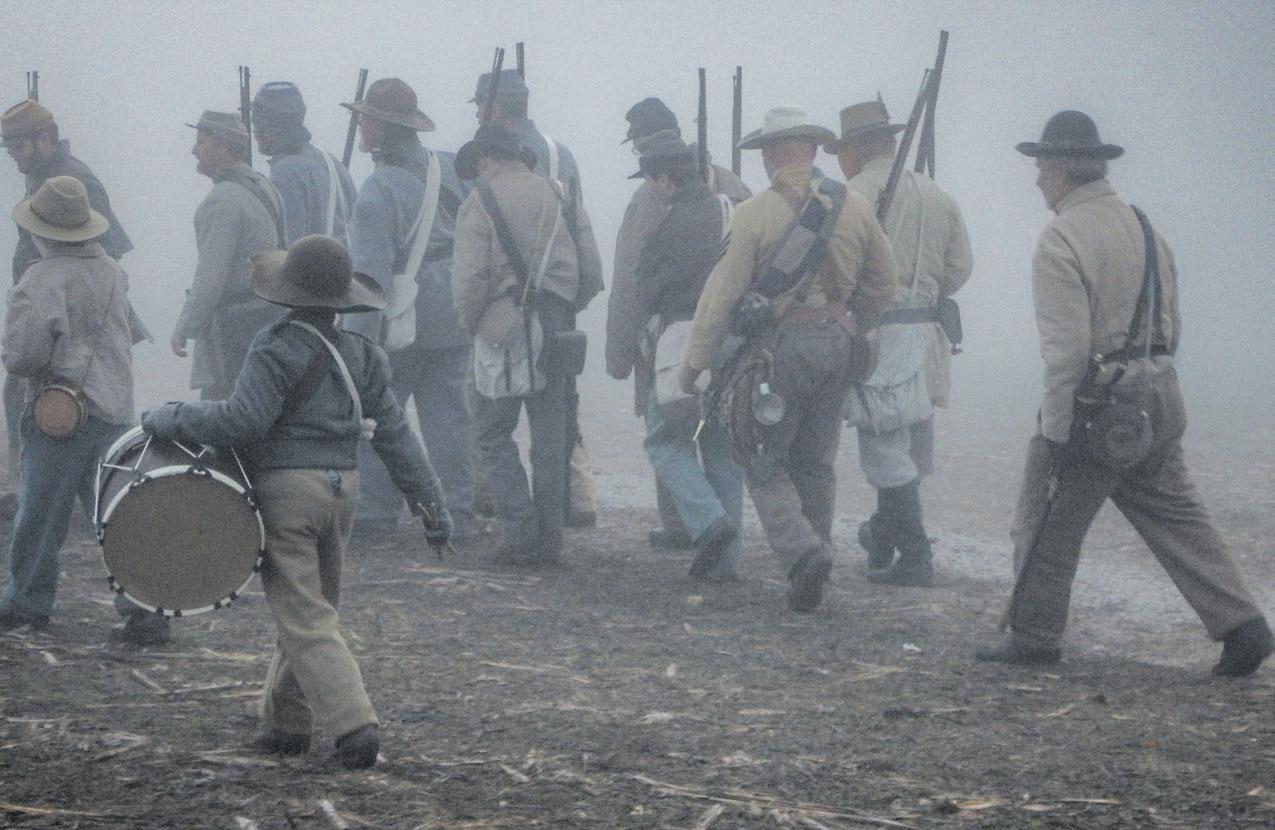
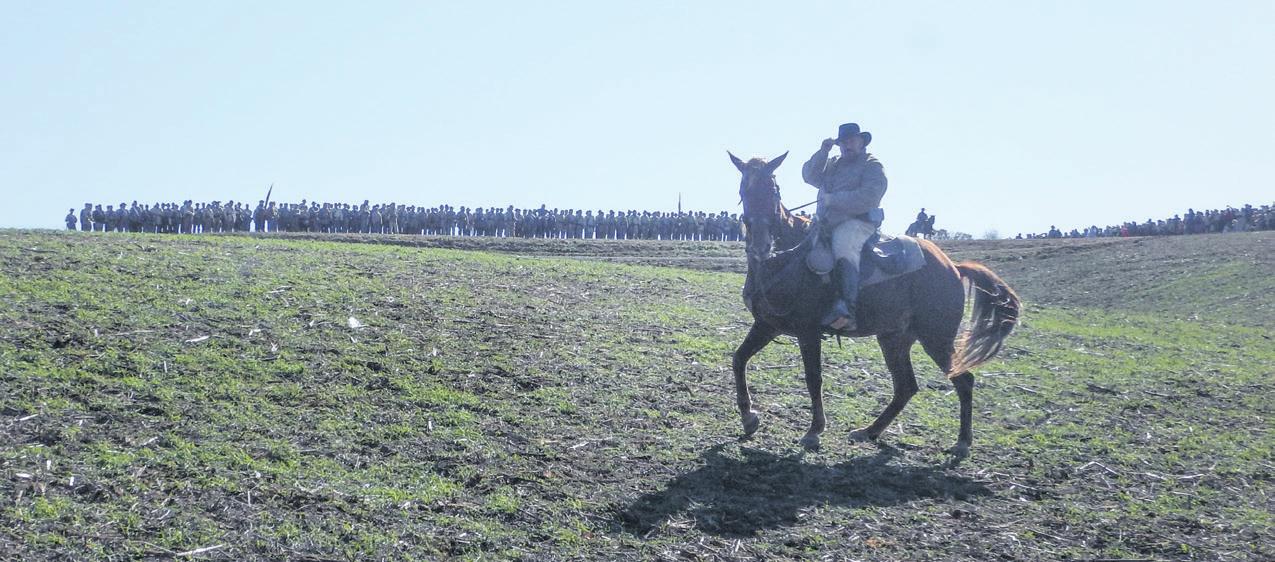
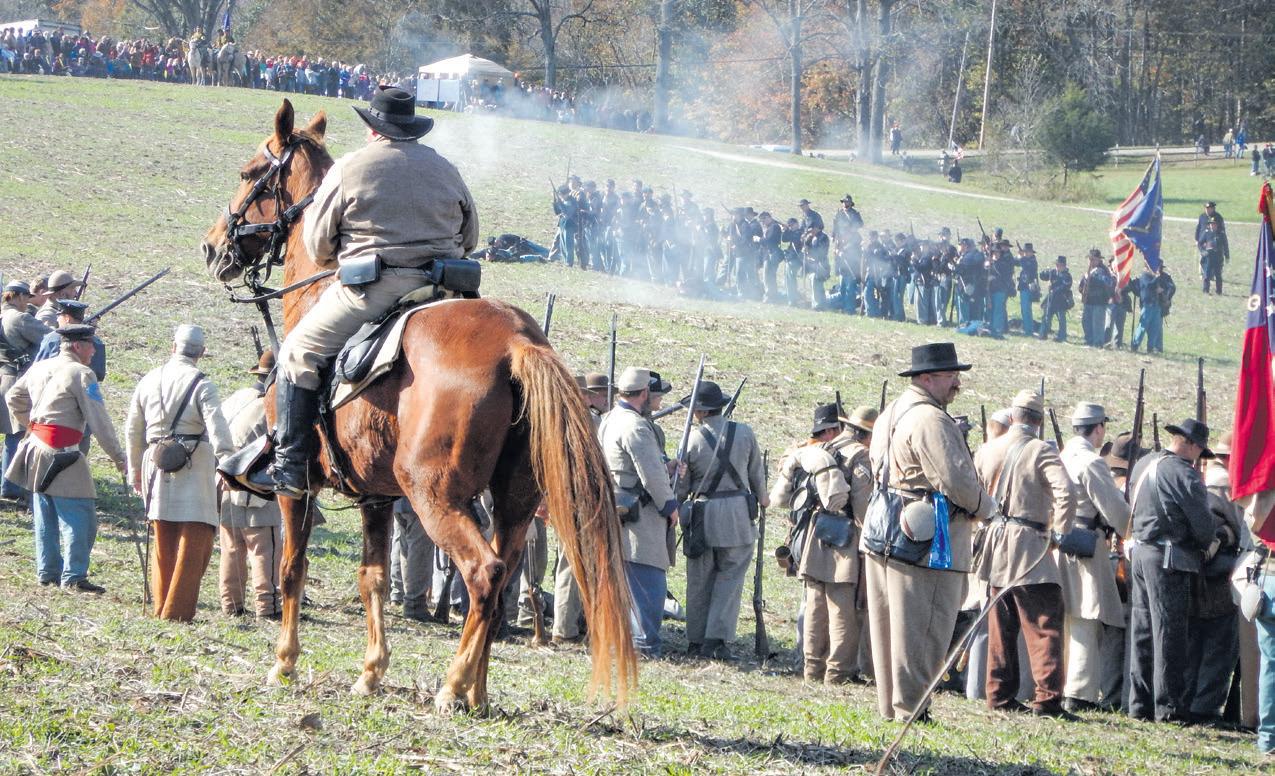
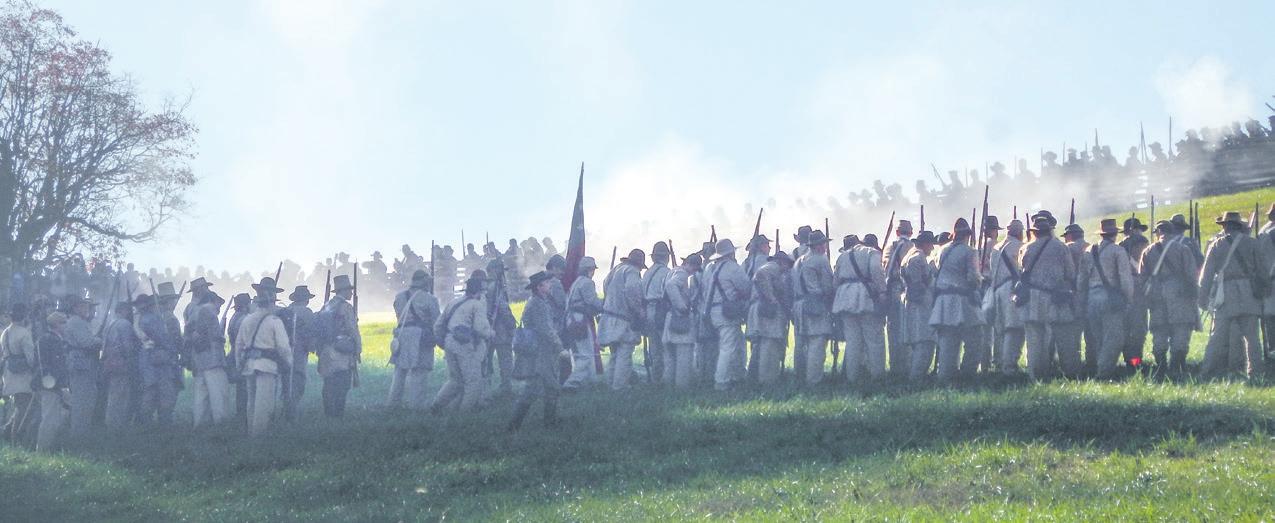
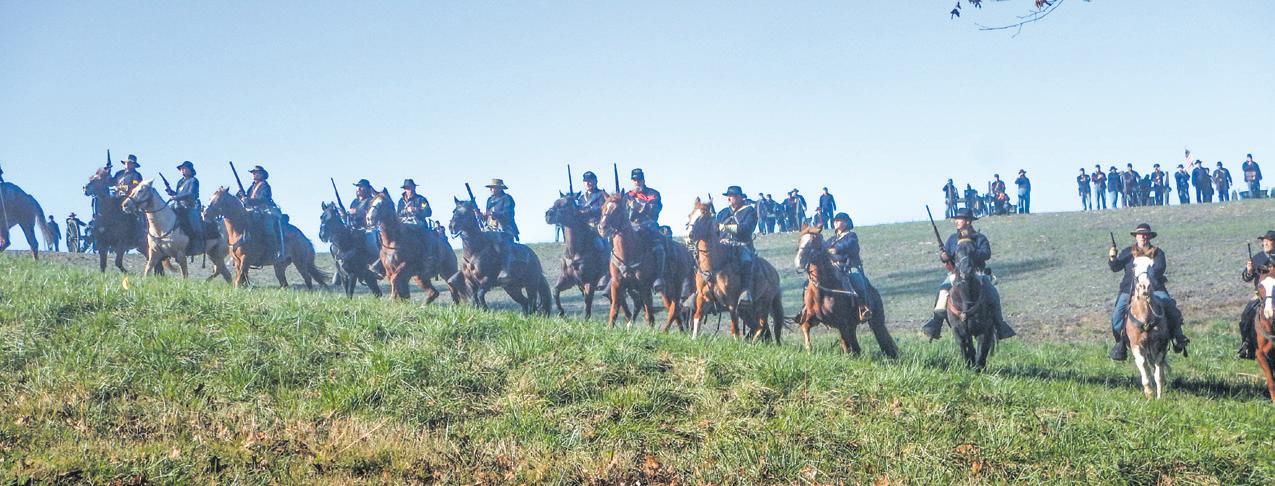
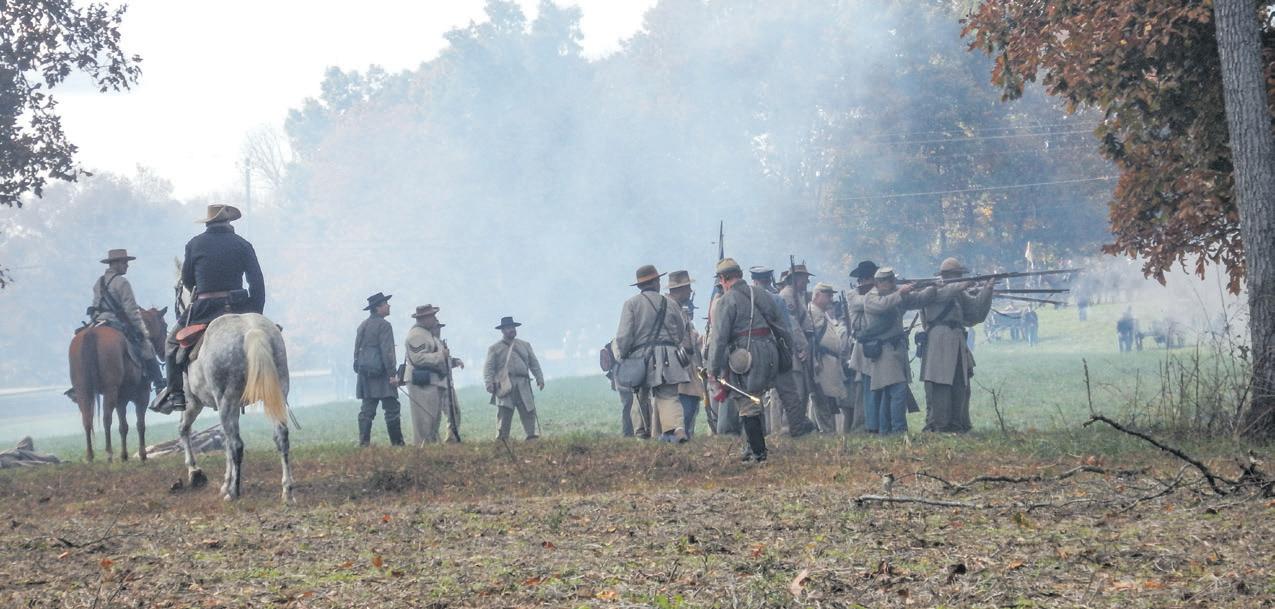

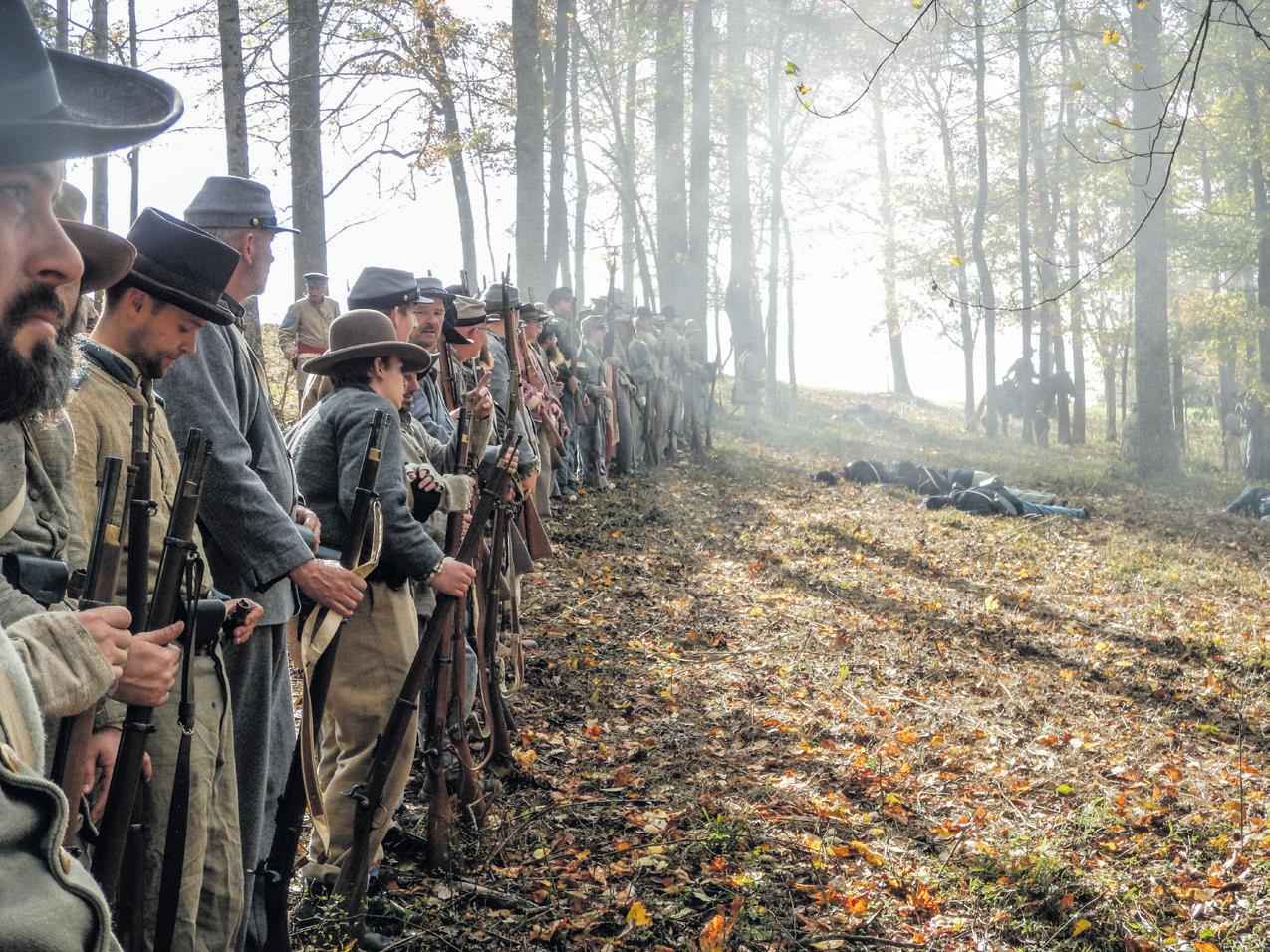
command was flanked, Thomas achieved a significant victory.
NANCY,
Ky.—The
1862 Battle of Mill Springs 2019 Reenactment was held on a crisp early November weekend along the rolling terrain on the actual battle ground, likely the last major event to be held on this site. “We had over 1,000 reenactors and over 6,000 spectators including school groups and sponsors,” said Earl Zeckman of Atlanta Campaign Inc. who put on the event. He added there was one Confederate cavalry unit who, “came all the way from Alaska.” The night time lows dipped below freezing resulting in heavy morning fogs which added to the visual effects of troop and cavalry movements.
In May, President Trump signed the John D. Dingell Jr. Conservation Management and Recreation Act that designated well over one million acres as national parks and wilderness areas. Included in that, the Mill Springs Battlefield will become a new unit of the National Park Service (NPS). Nine hundred acres, the current Mill Springs Battlefield Association Visitor Center and Museum, as well as other historical structures are part of the deal. Local officials praised the acquisition as a boon to tourism in the area. Bill Neikirk, one of the Mill Springs Battlefield Association`s long time leaders told local media he was “very excited and very pleased” the legislation was signed.
Mill Springs, also known as the Battle of Fishing Creek or Logan’s Crossroads, was part of an early Confederate campaign to hold Eastern Kentucky. In the winter of 1861, Confederate Brig. Gen. Felix Zollicoffer made the Mill Springs area his headquarters and in January 1862, Federal Brig. Gen. George Thomas was ordered to push the Southerners out of the area. The battle, Kentucky’s second largest, initially went well for the Confederates but Zollicoffer was killed when he mistook some Federal infantry as his own men and was shot. His death resulted in confusion in their ranks; when Zollicoffer’s
The defeat broke the Confederate defensive line that was anchored in Kentucky and Zollicoffer’s army fled across the Cumberland River back into Tennessee. Total Confederate losses were about 550; the Federals lost about half that number killed, wounded, and missing.
Regarding the potential for future Mill Springs reenactments at other locations since NPS sites do not allow large scale
reenactments, Zeckman said there is talk but nothing concrete.
“It takes about six hundred acres minimum to hold such a large event,” he added. Mike Hoover of the Twentieth Tennessee said, “we really hope there will be future reenactments here to help people learn about a generally little known but important engagement.” Having the battle scenarios on the very ground they took place was, “extra special,” Hoover added.
36 Civil War News January 2020
Confederate line ready to advance.
Confederate reenactors marching through camp.
Confederate troops fire back at the Union position.
Federal cavalry charge.
Confederates attacking Federal lines at the battle’s culmination.
First day of the reenactment with spectators in the background.
Mounted trooper in front of Confederate line ready to advance.
Young Confederate drummer boy marching with the column of troops. (All photos by Gregory L. Wade)
for Advertising or Editorial Submissions is the 20th of each month. Email to ads@civilwarnews.com
Duane Rezac, left of Rushville, Ohio. Jordon Glosser, Columbus, Ohio, 1st Ohio Battery A.
Deadlines

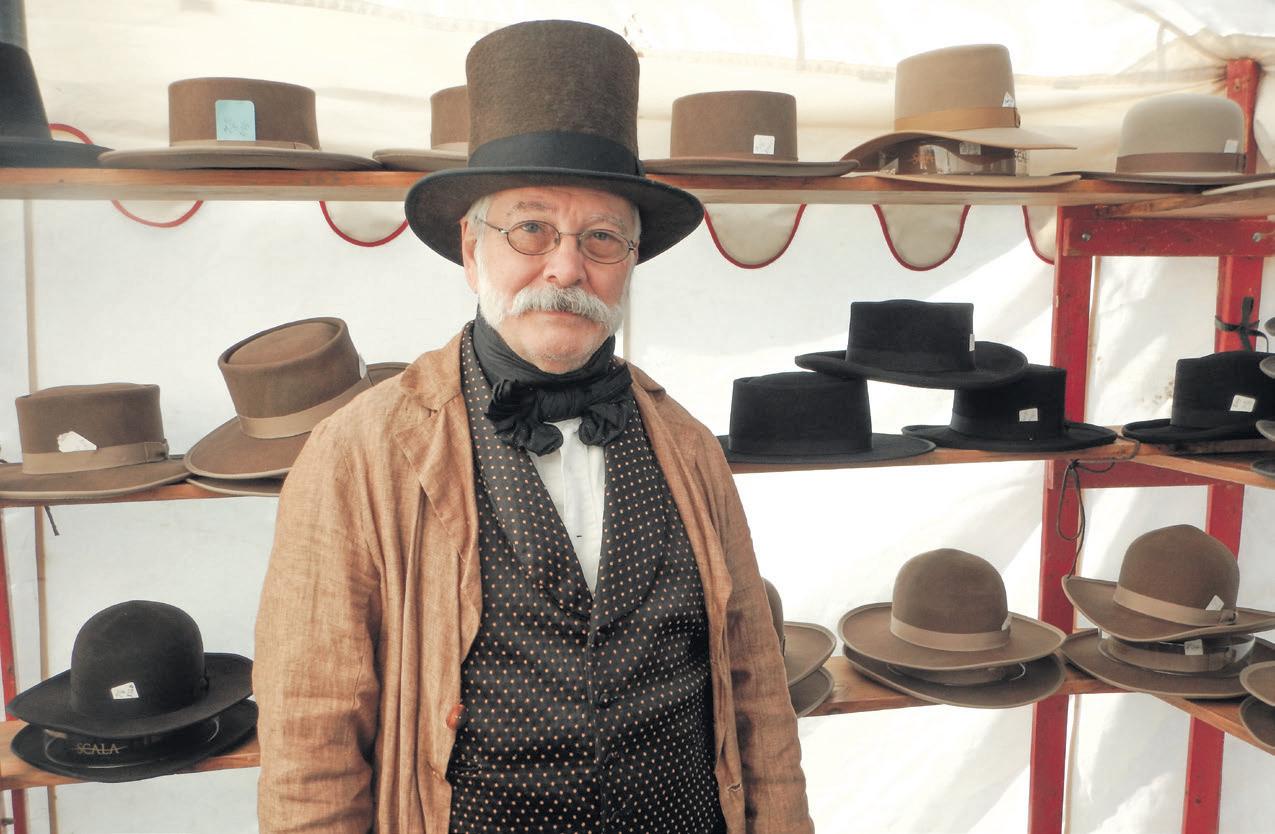


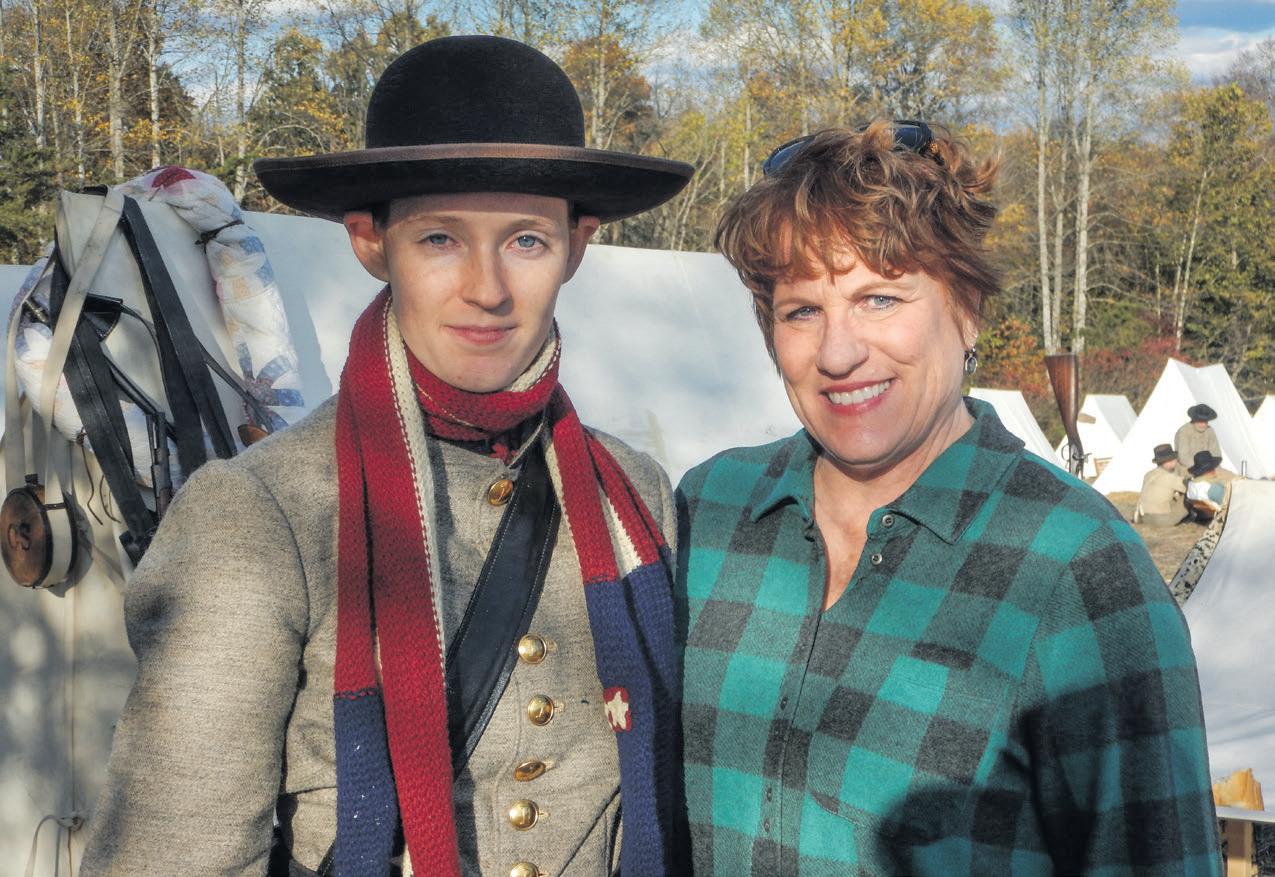
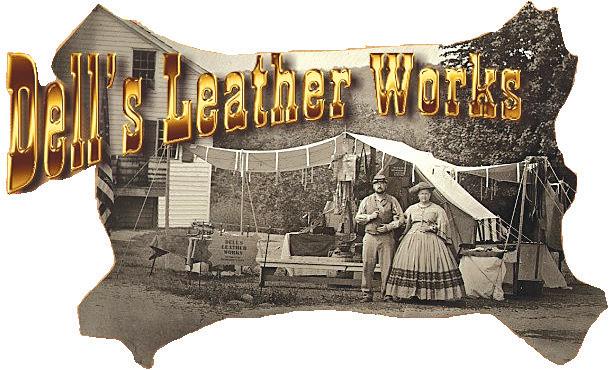

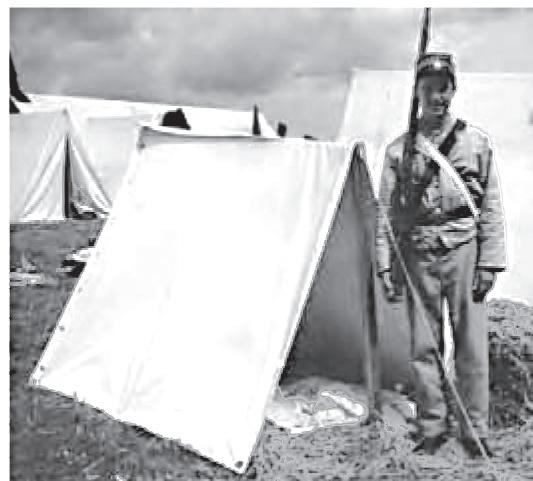
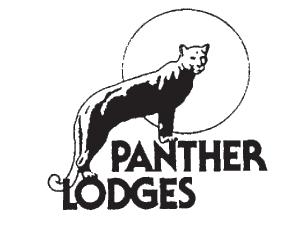

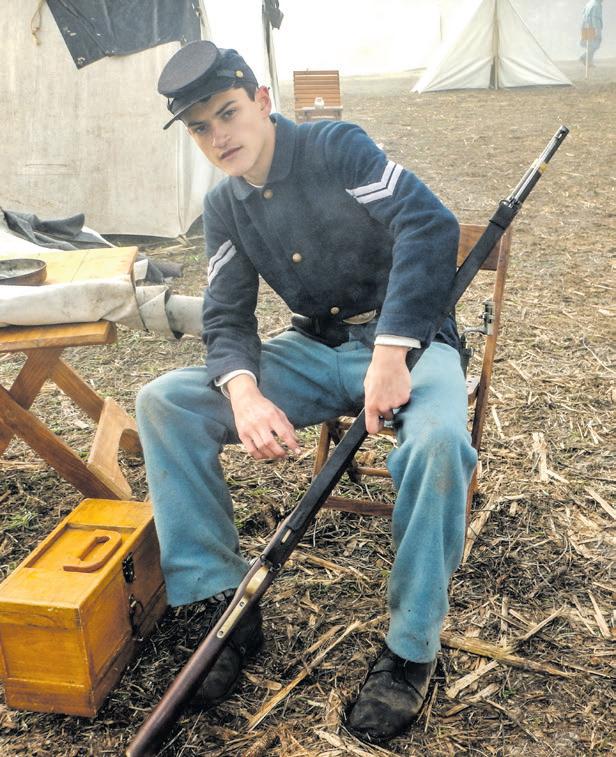
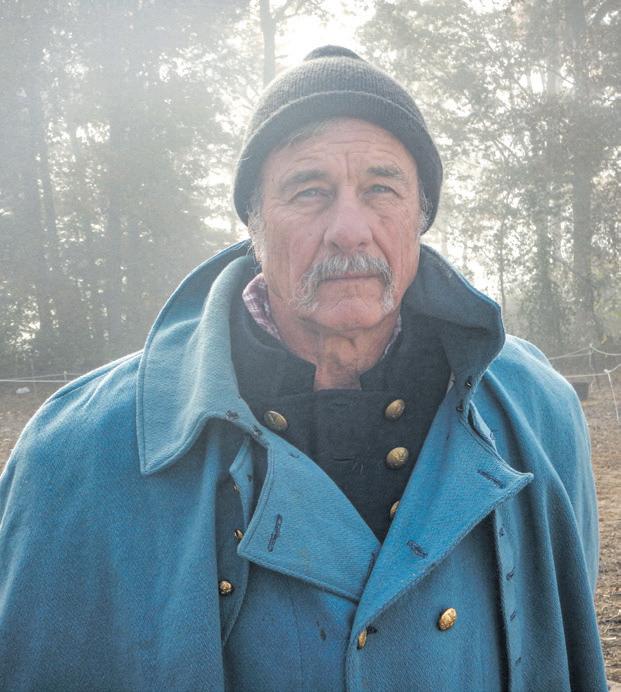


37 January 2020 Civil War News
In the ranks and final battle scene.
Sutler Dirty Billy Hats, Gettysburg, Penn.
Left to right Emma Duvall age 10, Lydia Gerald age 11 and Aryana Gerald age 12 all of Carrollton, Ky., Codi Dean age 11 of Austin, Ind.
Sutler-Artist Gregory Newson of Newson Publishing.
— MAKER — LEATHER WORKS Museum Quality “Raising The Standard” Made In The USA Visit us at www.DellsLeatherWorks.com • (845) 339-4916 Dedicated to the Common Soldiers Who Fought in The War Between The States AUTHENTIC QUALITY REPRODUCTIONS 31st Edition Since 1999 Accepting Discover, Visa, MasterCard and American Express REINFORCEMENTS MAKE ALL THE DIFFERENCE!!! Nobody even comes close to building a Civil War tent with as much attention to reinforcing the stress areas as Panther. Our extra heavy duty reinforcing is just one of the added features that makes Panther tentage the best you can buy! PANTHER Catalog - $2 Web: www.pantherprimitives.com 160 pages of the best selection of historical reenactment items from Medieval era to Civil War era. Includes over 60 pages on our famous tents and a 4-color section. Your $2 cost is refundable with your first order. SEND for copy TODAY The Best Tents in History P.O. Box 32N Normantown WV 25267 (304) 462-7718
Shannon Rowe of Gallatin, Tenn. Shannon works with the NPS at the Lincoln birthplace site. Anna Marie Rowe of Gallatin is Shannon’s mom. Shannon reenacted with the 20th Tennessee CSA.
Bill Paulecik of Willowbrook, Ill. Chicago Light Artillery, Battery A, Jaclyn Cox. Cincinnati, Ohio’s current “Bockfest Sausage Queen.”
Chris Krohn, Acworth, Ga., 125th Ohio.
Michael Brown of Atlanta, 5th and 6th Georgia Cavalry CSA.
Josh Gregory of Henagar, Ala., and Josh Darnell of Calhoun, Ga., both 48th Alabama.
Subscribe online at CivilWarNews.com
Left to right, Taylor Bishop Greensburg, Ky., Blake Werner, Jackson, Tenn., and Sam Walgreen, Martin, Tenn.
Civil War News book reviews provide our readers with timely analysis of the latest and most significant Civil War research and scholarship. Contact Stephen Davis, Civil War News Book Review Editor. Email: BookReviews@CivilWarNews.com.

College Life during the Civil War
Untouched by the Conflict: The Civil War Letters of Singleton Ashenfelter, Dickinson College. Edited by Jonathan W. White and Daniel Glenn. 35 photographs, notes, index, 180 pp., 2019. Kent State Univ. Press, www. KentStateUniversityPress.com. $29.95 cloth.

Reviewed by Paul Taylor
Pennypacker, beginning in April 1862 through July 1865, which was just after the war and his studies ended.
As the title of this book asserts, Ashenfelter truly was “untouched by the conflict,” not merely physically but emotionally as well. Indeed, his sense of detachment from the great rebellion is striking. He is, of course, aware of the war but it is always in the background. His letters contain little personal thought about the war or the broader Northern home front.
For example, during the Confederacy’s September 1862 Maryland invasion which culminated in the battle of Antietam, we learn that Ashenfelter responded to the invasion by penning a patriotic poem that, by so doing, he felt he had displayed “sufficient patriotism.” Reconsidering, he then joined the local “milishe” but gave the impression he did so as a lark, rather than out of any profound sense of duty.
in “utter contempt” and viewed “whatever contributes to my own personal pleasure is right: – all else, – wrong.” This type of person might be described today as a narcissist. As with many youthful men, Ashenfelter also wrote how he thoroughly enjoyed tipping the bottle and of his consistent focus on young women.
As for his studies, he admitted he was not what his teachers would consider a good student, though his grades were never below average. Peer pressure was present in his life as well, for he wrote how he placed more pride upon his position amongst his fellow students than with any honors that might be granted him by the faculty.
Editors White and Glenn have done impressive work in annotating these letters and adding extras that enhance the author’s mid-19th-century college experience for the modern reader. Noted scholar J. Matthew Gallman offers an insightful preface. Photographs of the work’s key participants abound as well as a descriptive listing of those persons. Four appendices include a record of Ashenfelter’s four-year curriculum at Dickinson, a fouryear summary of the expenses required to attend Dickinson, an essay on Dickinson College during the Gettysburg campaign, and Ashenfelter’s 1864 speech titled “Capital Punishment.”
A Same-Sex Relationship that Powerfully Shaped National Events in the Antebellum Era
Bosom Friends: The Intimate World of James Buchanan and William Rufus King. By Thomas J. Balcerski. Appendices, notes, bibliography, index, 352pp., 2019. Oxford University Press, global.oup.com. $34.95 cloth.

Reviewed by David Marshall
Democrats who tried to avoid sectional conflict and were voices for compromise.
These two important individuals lived together in Washington, D.C. Their friendship brought them messing together in boarding houses, where they often shared meals and drank together. Buchanan and King were not alone in sharing quarters in the nation’s quarters, as many elected officials did not live with their wives and families while in Washington. Additionally, their salaries and per diem were quite small compared to the twenty-first century.
The Civil War letters of Union soldiers have been published by the score over the decades. However, those penned by Northern civilians, especially those written by college students, remain elusive. That may be a bit surprising, for while the popular image of young men rushing to enlist in the Union army after the attack on Fort Sumter dominates historical memory, those who opted to stay home were not a small minority. In fact, sixty percent of white, Northern males of military age chose not to enlist and fight in the Civil War.
It is within this latter category that readers learn of Singleton (“Sing”) Ashenfelter, a seventeen-year-old, middle-class white man, who, in 1862 was attending Dickinson College in Carlisle, Pa. This revealing new work collects forty-nine letters that he wrote to his good friend, Samuel
Ashenfelter described himself as a pro-war abolitionist who disdained Northern Copperheads. He wrote how “the South should be made to understand that she cannot do just as she pleases,” yet he never mentions who should do the fighting or why.
Some of these letters are rather short while others are quite lengthy. Yet throughout, the young author’s education, wit, command of the English language, and introspective intellect are self-evident. Like many young people, however, he struggled to find his place in the world. Ashenfelter consistently ruminated about himself, his beliefs, and his internal philosophical debates to the point that it bordered on navel gazing.
In this reviewer’s opinion, young Ashenfelter is not a likable character. He described himself as a materialistic atheist who looked forward to the life of a hypocrite “and a fine prospect it is.” He held the concept of principle
Despite Ashenfelter’s youthful challenges, he enjoyed a successful post-college career as both a newspaper editor and then as a U.S. attorney for the Territory of New Mexico. His Civil War-era letters offer a revealing and uncommon social history glimpse into the workings of a well-educated young man’s mind as he navigated the border between youth and manhood.
Paul Taylor is an award-winning author of seven books pertaining to the Civil War era. He has recently finished transcribing, editing, and annotating the Civil War letters of Union engineer officer Orlando M. Poe to his wife. The manuscript is currently under publisher review.
This wonderful new title concerns a dual biography of two important 19th-century political figures and friends, William Rufus King and James Buchanan. Some people called them the “Siamese twins.” These men had a very close friendship that many individuals questioned, including the issues of whether there was a sexual element. Or was it a very close companionable friendship?
Thomas Balcerski asserts that these lifelong bachelors formed a partnership that endured many tests during their public lives.
William Rufus King was older by five years and was a Southerner, living in North Carolina and Alabama. He held several important elected positions, including the House of Representatives and the Senate. Like James Buchanan, he also held positions that took him to Europe. Buchanan was from Pennsylvania, a successful lawyer who was also elected to the House and the Senate like his close friend. Both were
While their relationship was not uncommon, both men voted consistently the same way. They supported the Democratic party’s agenda, including the independent subtreasury system, a compromise tariff, and expansion of federal land-holdings. King consistently balanced the interests of the slaveholding South with those of the Democratic Party. Buchanan joined King in doing everything possible to stop abolitionism, including a gag rule on anti-slavery petitions. Both men strongly believed that their political positions were the best way to preserve the Union.
However, their nearly ten-year boardinghouse relationship was unique in several ways. The two men were from different parts of the U.S.: King from the South and Buchanan from the North. King hailed from a wealthy slave owning family, and Buchanan from a poor shopkeeping family. King was originally a DemocraticRepublican, and Buchanan was originally a Federalist. However, they shared a few essential personal factors. Both were descendants of Scotch-Irish émigrés and shared ethno-cultural backgrounds. They both attended college, which in the early nineteenth century was a luxury and rare. Neither man ever married, which is one reason for gossip by
38 Civil War News January 2020 Digital Issues of CWN are available by subscription alone or with print plus CWN archives from 2012 at CivilWarNews.com
many.
Interestingly, both men were separated by thousands of miles during the period of 1844–1853. King served as a minister to France, while Buchanan moved from the U.S. Senate to Secretary of State under President James Polk. The author makes an interesting observation concerning the reasoning behind their waning friendship in this period, mainly due to a lack of communication and their separate romantic pursuits. Both no longer consistently agreed on numerous important issues, especially dealing with foreign policy. Buchanan encouraged President Polk to gain new territory from Mexico and Cuba, while King was steadfast against the procurement of these lands. Distance and time permanently changed their relationship.

During the last years of their friendship, this political partnership reached new heights when King was elected Vice President under Franklin Pierce,
and Buchanan elected president in 1856. Both were Democrats, and prior to running independently of each other they worked as running mates in 1852. In the end, their party failed to accept a “bachelor ticket.” Balcerski insightfully examines the reasons that these Bosom Friends were only able to advance one person at a time.
While this volume does not offer a definitive answer as to the intimacy of the relationship of Buchanan and King during the antebellum period, some excellent arguments and well-researched evidence answer many questions that historians have entertained since the nineteenth century.
David Marshall has been a high school American history teacher in the Miami-Dade School district for the past thirty-three years. A life-long Civil War enthusiast, David is president of the Miami Civil War Round Table Book Club.
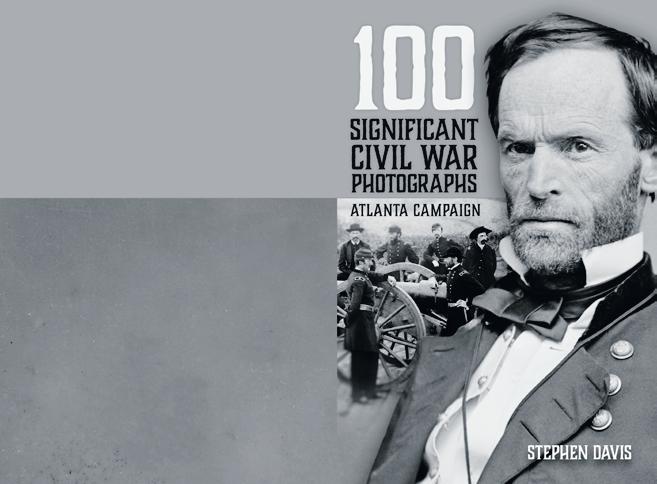
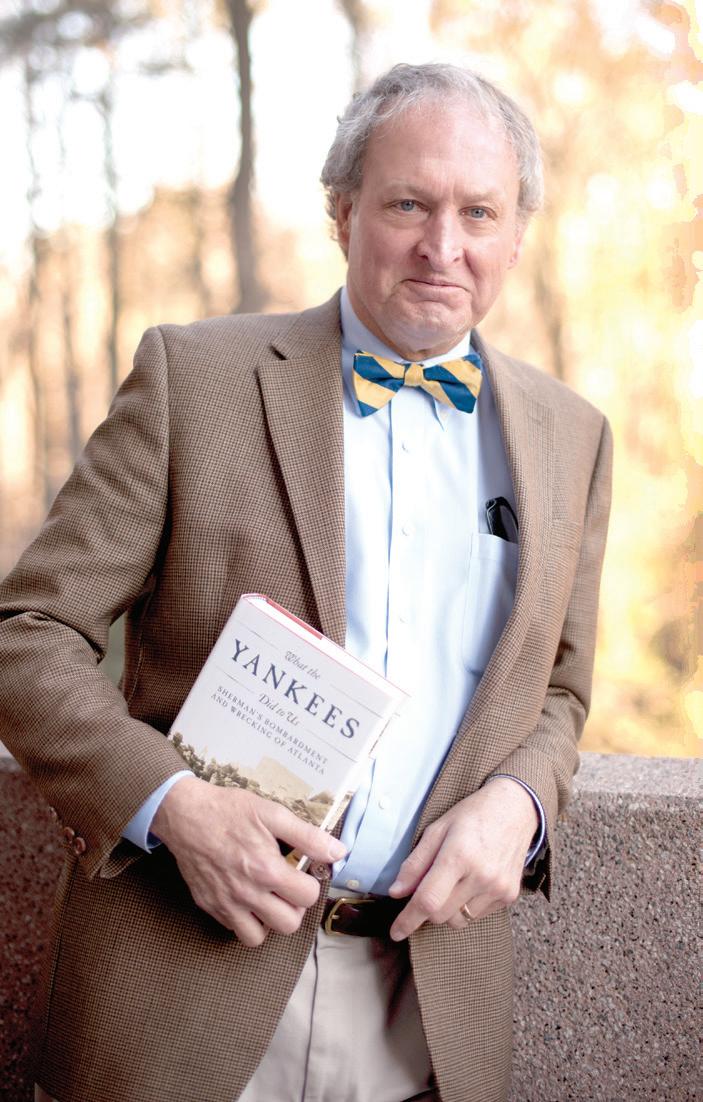
Loyal Legion of the Confederacy

Spiritualism in the Midst of War
Civil War Ghosts: As reported in the newspapers of the time. By Michelle Hamilton. Images, footnotes, 169 pp., 2019. Haunted Road Media, www. hauntedroadmedia.com. $14.99 paperback, $4.99 Kindle.
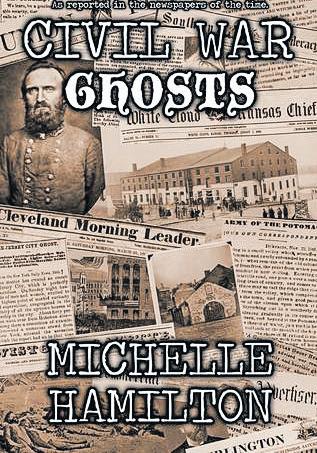
Reviewed by Bill Hendrick
hours in a Boston cemetery, staring at crumbling, tilted tombstones adorned with skulls and crossbones….you know….just in case.
And that’s why Michelle L. Hamilton has written a book on Civil War ghost stories that’s fun to read, especially for people who don’t know a battalion from a brigade, because it is not a war book.
period. Even Mary Todd Lincoln was a spiritualist who held séances in the White House.
Gettysburg’s ghost tours are hugely popular. Same for Sharpsburg, also known as Antietam, where 3,650 soldiers in blue and gray were killed in the bloodiest one-day battle in American history. Indeed, ghost tours are often thronged, from Atlanta’s Oakland Cemetery to the haunting battery at Charleston to the rugged fields of Shiloh.
Tours of the alleged haunts of spooks are ubiquitous across the country, because Americans seem to want to see them, and somehow feel the past in eerie graveyards like the one at Trinity Church in Manhattan, where Founding Father Alexander Hamilton was buried after Vice President Aaron Burr killed him in a duel in 1804. I don’t believe in ghosts, but I once sat silent through the wee
She’s studied microfilm of Civil War newspapers, both Northern and Southern, and discovered many published accounts of ghost stories, reflecting a keen interest in the unknown. Her little book is a delight because it not only prints out her findings in readable type, but also publishes headlines and fuzzy microfilm images she had to strain her eyes to read. One, on the front page of the Oct. 2, 1862, issue of the Savannah (Ga.) Morning News, is headlined “A GHOST” and relates at length how the citizens of Lynchburg, Va., had “been thrown into a fever of excitement by the appearance of a ghost in their midst.”
Civil War Ghosts is not a collection of ghost stories, but of actual articles about “sightings” published during the Civil War. The country was being torn apart at the time and these accounts documented chilling, terrifying tales of the paranormal that may have offered comfort to the millions in a time of massive death. People have always had difficulty dealing with the death of loved ones, which makes stories about ghosts—which would bolster a belief in an afterlife—very appealing, a balm for the soul. This explains why public interest in spiritualism surged during the
The Richmond Enquirer reported that a New Jersey regiment, quartered in the Marshall House in Alexandria, Va.—whose proprietor James Jackson was killed by Union soldiers after he gunned down Elmer Ellsworth—claimed to have seen the hotelier’s ghost and “stampeded from the premises in great terror.”
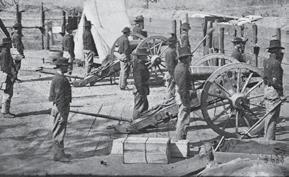
The Holmes County Republican in Mellersburg, Ohio, reported that “Clevelanders are getting a good deal excited about a certain ghost which it is said has been seen by sundry individuals in various parts of the city.”
Still another paper, the Burlington (Iowa) Weekly HawkEye, headlined a story “Ghost! Ghost!! Ghost!!!” “An apparition, robed in white, was seen by a number of persons last night about eleven o’clock,” it declared. And the Keokuk (Iowa) Constitution reported that twenty-five people saw the ghost and were left quite spooked.
It’s quite evident that people of that age took ghosts more seriously than most folks do today.
You don’t have to be a Civil War buff to get a kick out of Ms. Hamilton’s book. It’s not about fighting, but what people believed, or claimed they did.
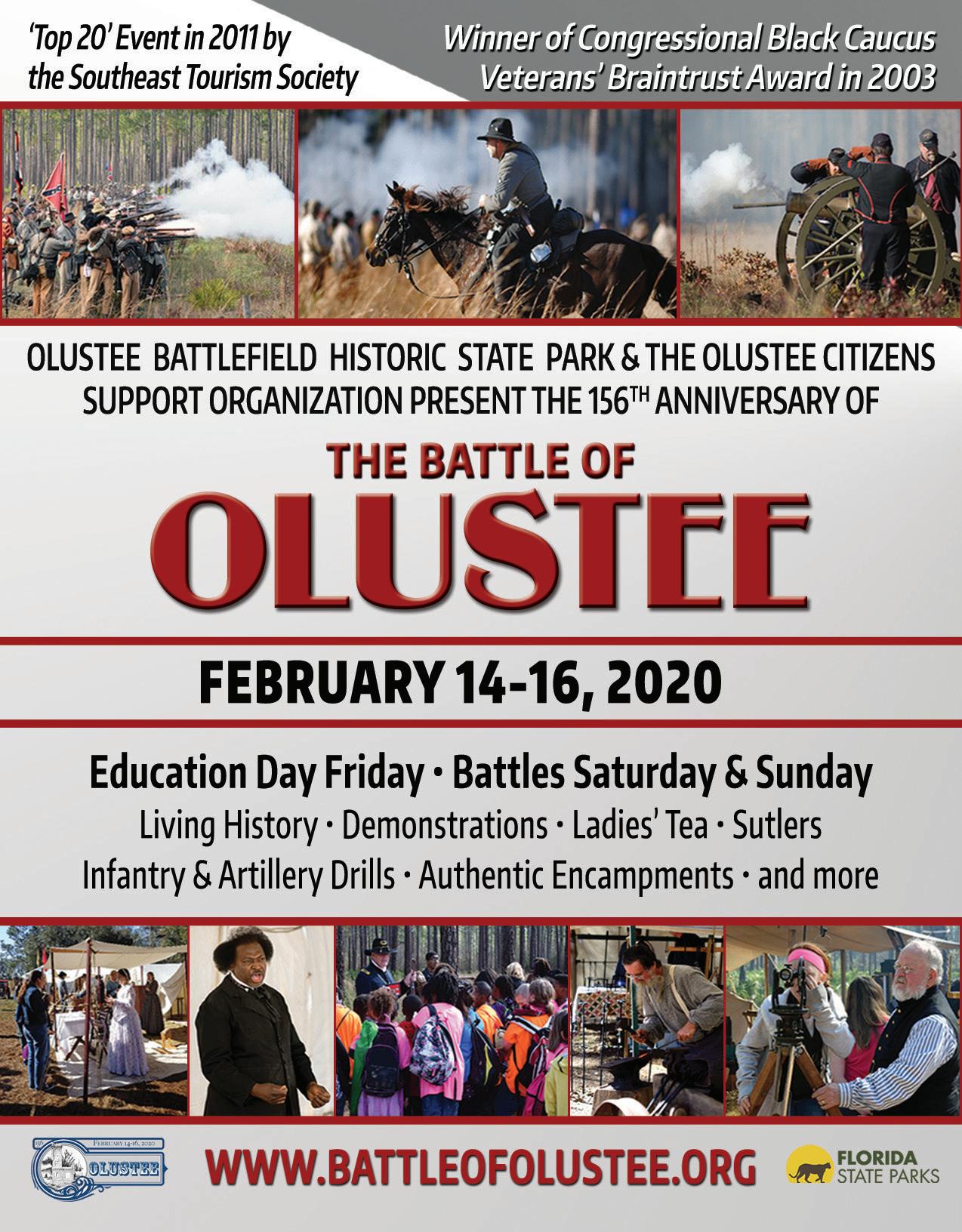
Also, Civil War-era newspapers—in the days before large reporting staffs and wire services, when telegrams were very costly—had a hard time filling up enough space with “news” to justify the advertisements—the lifeblood of papers.
“My interest in the paranormal is a way to connect to the past through a unique angle,” the author says. “I have worked in museums since I was 15. My first job was at the Whaley House in San Diego, which is famous for its paranormal activity. I learned to connect with the visitors through highlighting and focusing on the history of the house by addressing their interest in the paranormal. They came for the ghosts but left learning about the history of the house. The reason I wrote the book was to answer my own questions about what people believed during the Civil War.”
For speaking engagements email:
Bill Hendrick of Atlanta has been a journalist for 45 years, including three decades at the Atlanta Journal-Constitution and one with the Associated Press. He is currently writing a book with Steve Davis on how the Atlanta Daily Intelligencer, the city’s leading newspaper during the war, covered the conflict.
39 January 2020 Civil War News
for Advertising or
Submissions
20th
month.
ads@civilwarnews.com SteveATL1861@yahoo.com Programs for Civil War Round Tables and Historical Societies The American Civil War was the first war in which both sides widely used entrenchments, repeating rifles, ironclad warships, and telegraphed communications. wasalso firstAmericanWar beextensivelyphotographed. Mathew Brady, Alexander Gardner and Timothy O’Sullivan are famous for havingmadeiconicphotographsintheCivilWar’seasterntheater. George N. Barnard deserves to be ranked in this top tier his photographic in the western theater. A civilian photographer hired by Gen. William Sherman’s chief engineer to take pictures of fortifications around Atlanta, Barnard took several hundred of them and around the city in the fall of 1864. His most famous is the site of Union Maj. Gen. James B. McPherson’s death in the battle Atlanta, July 22, Thusfar,nocomprehensive,definitivelistinghasbeenmadeof photographer’s work. The Library of Congress has 130 images; the U. S. Military Academy at West Point, New York, at least photographs, donated by Captain Poe’s widow. Otherrepositories,suchastheGilderLehrmanInstituteofAmericanHistoryin NewYorkCity,havesmallercollections. For this book we have chosen hundred images we deem “significant,” though otherstudentsmaywonderatsomeofourselections. We hope that this work will stimulate further interest in Barnardiana,andthatotherscholarlyvolumesareyet come. The Atlanta Campaign STEPHEN DAVIS 100 SIGNIFICANT CIVIL WAR PHOTOGRAPHS ATLANTA CAMPAIGN Stephen
Cumming, Ga. • Lecturer • Author • Course Instructor
anyone who’s heard me.”
Deadlines
Editorial
is the
of each
Email to:
Davis
“Ask
CSA National Defense Medals & other banned internet items Civil War Recreations WWW.CWMEDALS.COM cwmedals@yahoo.com 1 Smithbridge Rd., Unit 61, Chester Heights, PA 19017
Reminiscences of Fort Sumter and Moultrie in 1860-’61
By Abner Doubleday (1876)
The summer of 1860 found me stationed at the head-quarters of the First United States Artillery at Fort Moultrie, South Carolina.
I was captain of Company E, and second in command to Brevet Colonel John L. Gardner, who was lieutenant-colonel of the regiment. The regimental band and Captain Truman Seymour’s company (H) also formed part of the garrison. The other forts were unoccupied, except by the ordnance-sergeants in charge.
why I chose it for this month’s column.
Because we know what’s going to happen at Fort Sumter, and Doubleday knows that we know, a valuable element of his memoir is its background for the start of the war, events of 1860-61. And because I know that you also know what’s going to happen at Sumter, I’m going to focus on the first part of this charming little book.
In the summer of 1860, “Charleston, at this period, was far from being a pleasant place for a loyal man.” “As early as July there was much talk of secession,” Doubleday wrote, yet he noted that Secretary of War John B. Floyd, a Virginian, sent 17,000 muskets to South Carolina.
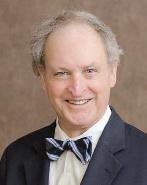
“By the middle of August the country people began to be quite violent in their language.” As the presidential election neared, “the disunionists became more bitter.” About this time a poor seamstress from New York was jailed in the city simply for saying that she opposed slavery. “Independent companies and minute men were everywhere forming,” the author observes. When a party from Moultrie’s garrison attempted to slip across the water to procure ammunition from the Charleston Arsenal, a mob stopped them. Days before the November election, Doubleday was in Fort Moultrie when he saw that “crowds of excited countrymen, wearing secession cockades…formed in procession and marched around it,” to show their martial ardor and perhaps intimidate the garrison. But they did not kick up a fight.
men,” Doubleday recalled. The judge of the U.S. District Court, then in session in Charleston, showed his sentiments by resigning. In Columbia the legislature set the date for a secession convention. Next door, in Georgia, Gov. Joseph E. Brown did, too; the state legislature voted a million dollars to raise troops. Thus, as Doubleday states, “the excitement in each state constantly reacted on the other.”
Fort Moultrie’s garrison at the time numbered sixty-eight officers and men, plus thirteen musicians. Fort Sumter, out in the harbor about a mile west of Moultrie, was held by all of one man, an ordnance-sergeant, who lived on the man-made island with his wife and two young children. Castle Pinckney, on a low island three-quarters of a mile east of the city, also had its ordnance sergeant.
War Secretary Floyd had ordered workmen sent to Charleston Harbor to strengthen the three fortified places – Moultrie, Sumter, and Pinckney. A suspicious Abner Doubleday thought that Floyd was improving fortifications just before South Carolinians would seize them. When Doubleday learned that the Secretary of War had appropriated $150,000 to repair Fort Moultrie and another $80,000 to finish Sumter, he formed the opinion that this “was simply an expenditure of public money for the benefit of the Secessionists.”
“Forts constructed in an enemy’s country, and left unguarded,” he acidly observed, “are built for the enemy.”
concluded that “the General Government seemed quietly to have deserted us.”
An example of Abner Doubleday’s subtle wit is this, having to do with South Carolina’s Ordinance of Secession, which was signed in Charleston: “immediately afterward there was great competition for the possession of the immortal pen with which the instrument was signed. At the close of the war, I heard it was for sale at very low figure.”
After secession, an outspoken Unionist in the city visited Moultrie to express his sorrow and regret. When asked if he favored the state’s secession, Doubleday recorded his reply: “I should think not! South Carolina is too small for a republic, and too large for a lunatic asylum!”
Among Major Anderson’s officers there was talk about removing the garrison from Fort Moultrie to Fort Sumter. Anderson gradually came around to the idea, given Moultrie’s vulnerability to land
attack. While trying to keep the inter-fort transfer secret from the men, Anderson arranged for three schooners and some barges to be loaded with supplies; Doubleday inferred that the garrison was in for “a prolonged residence in Fort Sumter.” The move order came suddenly. Doubleday recalled dinner with his fellow officers on the evening of December 26, when in strode the major: “I have determined to evacuate this post immediately, for the purpose of occupying Fort Sumter; I can only allow you twenty minutes to form your company and be in readiness to start.”
As I said, you know the rest of the story….
Steve Davis and Jack Melton’s new book is 100 Significant Civil War Photographs: Charleston in the War. In it we note that Abner Doubleday’s wife, Mary, sailed north on Jan. 8, 1861, when things were getting testy in Charleston Harbor.
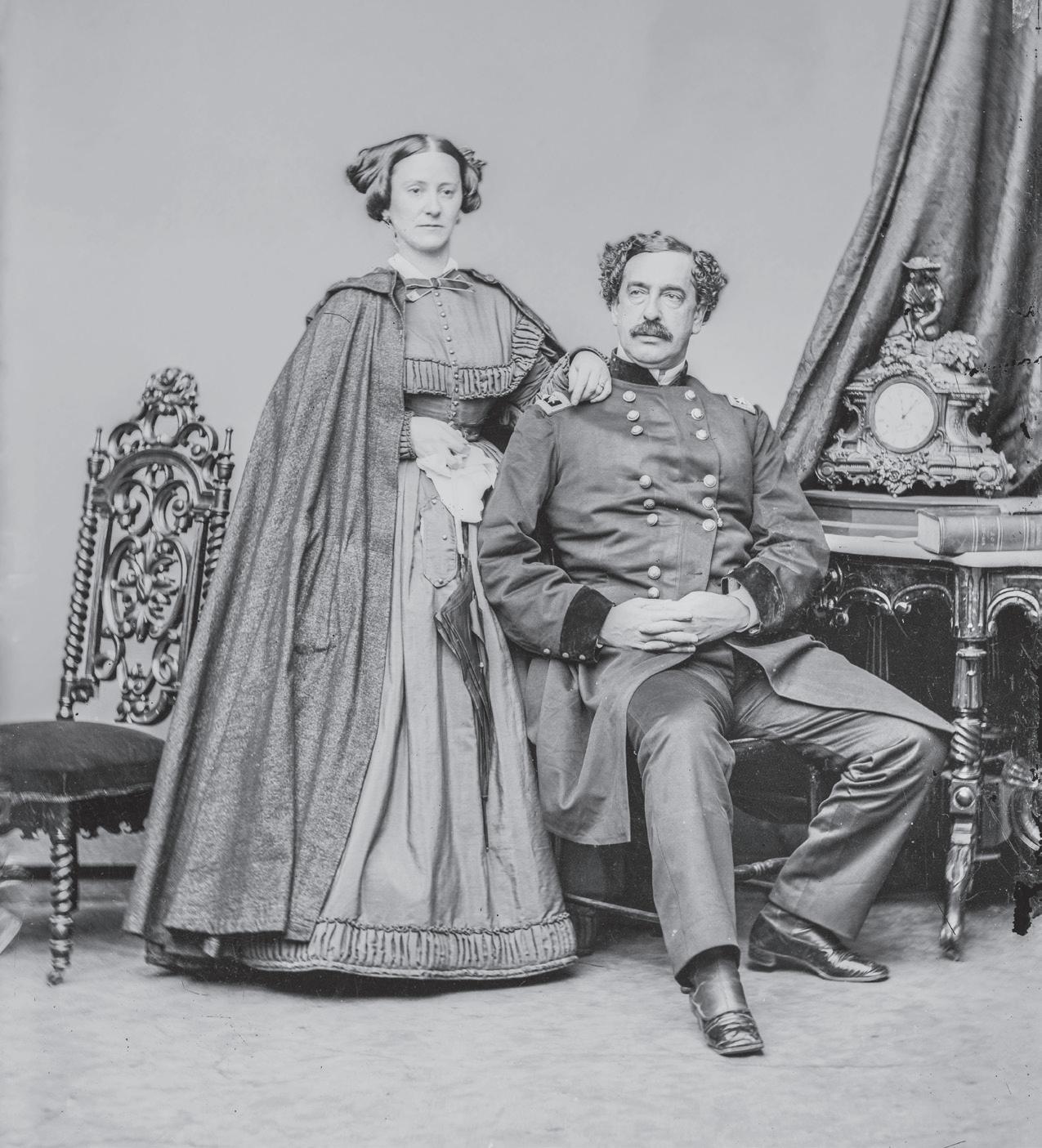
Thus begins Union general Abner Doubleday’s memoir, Reminiscences of Forts Sumter and Moultrie in 1860-’61 (New York, 1876; reprint, Nautical & Aviation Publishing Company of America, 1998).
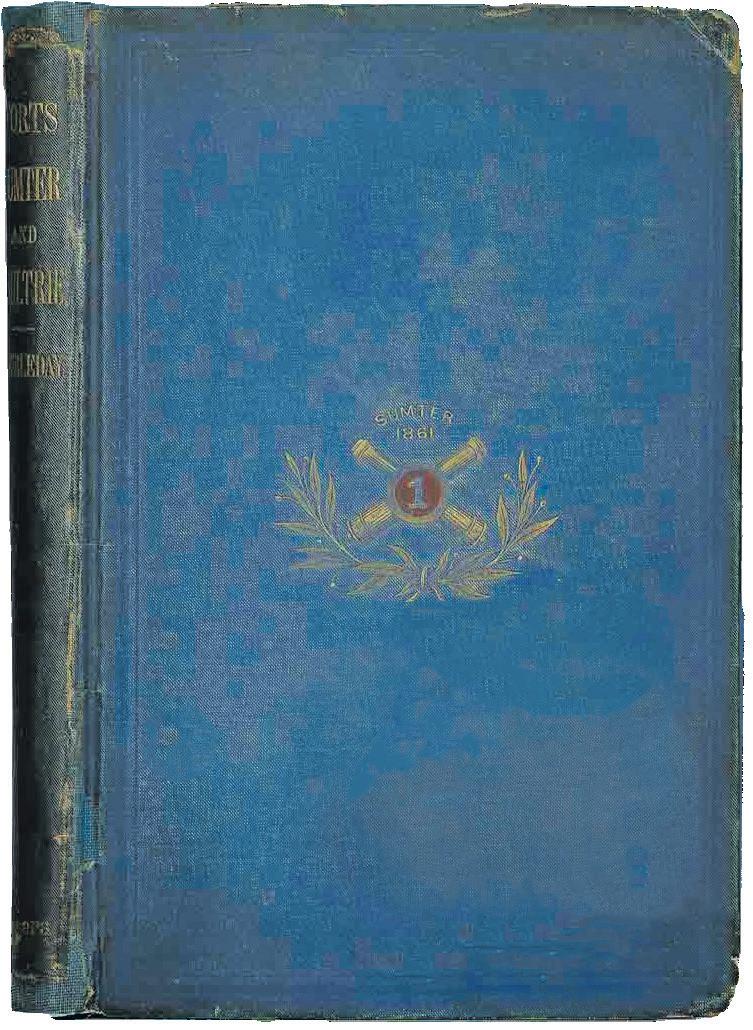
For the latter reprint, my friend in Charleston, Rick Hatcher, then Historian at the Fort Sumter National Monument, wrote the Introduction. He notes that Doubleday’s book was also reprinted in 1976, which signals
The presidential election took place on Tuesday, November 6. Doubleday had learned that he was the only one of Moultrie’s seven officers supporting Lincoln; others may have favored the Northern Democrat, Douglas, or even the Southerner, John C. Breckinridge. Lt Col. John Gardner, garrison commander, was himself “in politics… quite Southern,” Doubleday commented.
When news reached Charleston of Lincoln’s election the day afterward, excited secessionists marched in the streets shouting “Hurrah for Lincoln!” “By the 9th of November the whole state was swarming with minute
One hundred and fifty brick masons from Baltimore arrived in early November to work on Fort Sumter. One officer at Moultrie suggested obtaining muskets from the arsenal to arm the masons to help them guard the gunpowder being stored at Sumter and also other property at Pinckney, but Floyd overruled the order. At the same time he dispatched two thousand more muskets to South Carolina. “This did not look much as if the Administration intended to sustain us,” Doubleday writes with understated sarcasm; “the honorable secretary was thus supplying our enemies with arms, and leaving the United States Arsenal, full of military stores, without a guard.” Floyd did send an officer (Maj. Fitz John Porter) to Charleston to inspect things. After Porter recommended that Lieutenant Colonel Gardner be relieved (he was so old, he had fought in the War of 1812), Porter recommended Maj. Robert Anderson as his successor.
Anderson arrived on November 21. By then Doubleday had
Abner Doubleday (June 26, 1819–Jan. 26, 1893) may not have invented baseball, but he was certainly a soldier. His grandfather had fought in the Revolutionary War. His father, a New York congressman, aided his admission to West Point, from which he graduated in 1842. He fought against Mexicans and Indians (in Texas and Florida) before assignment to Atlantic coastal forts.
The secession of South Carolina found him stationed at Fort Moultrie on Sullivan’s Island, second-in-command to Maj. Robert Anderson. The day after Christmas 1860, Robert Anderson moved his garrison quietly across the harbor to Fort Sumter. Captain Doubleday, as married officers at army posts usually did, had his wife Mary with him. After the withdrawal to Sumter, Mary with other officers’ wives found lodging in the city. Or tried to. Mrs. Doubleday was told by a boarding-house keeper, as Abner relates in his Reminiscences of Forts Sumter and Moultrie in 1860–’61 (1876), “that, as the house depended on the patronage of the Southern people for support, she (the landlady) could not undertake to harbor the wives of Federal officers.”
Mary Doubleday took the hint. On January 8, 1861, she and other Northern officers’ wives left Charleston, northward-bound.
40 Civil War News January 2020
Under a Cloud
The following Northerners and Southerners had their careers derailed or ended by misfortune—a battlefield defeat, or personal misconduct.
Can you name them from the clues below?
1. This Union major general, brought from the west after having captured Island No. 10 and New Madrid, oversaw the defeat of his Army of Virginia at Second Manassas. Who?
2. This Confederate lieutenant general behaved so badly when his lines were overrun at Spotsylvania, May 12, 1864, that General Lee turned his Second Corps over to Jubal Early. Can you name him; and better yet, what was his middle name?
3. When this Union brigadier general, in charge of Kentucky during the fall of 1861, told U.S. Secretary of War Simon Cameron that he needed 200,000 men, Cameron exclaimed, “Great God! Where are they to come from?” Soon afterward, the Cincinnati Commercial headlined an article that the general was “insane.” Who?
4. This son of Kentucky Senator John J. Crittenden lost the battle of Mill Springs, Ky., in January 1862. Officers observed that he was “in a beastly state of intoxication” during the engagement. Later, after Maj. Gen. William J. Hardee also found him drunk and Gen. Braxton Bragg deemed him unfit to command, he resigned on Oct. 23, 1862. Which Kentuckian?
5. As a brigadier in 1861 he was relieved of command in northeast Missouri for drunkenness. At Memphis he “resumed his heavy drinking and came
Revering Confederate Heroes, Explained
Confederate Exceptionalism. Civil War Myth and Memory in the Twenty-First Century.
By
Nicole Maurantonio.
Illustrations, endnotes, index, 250 pp., 2019. University Press of Kansas, www.kansaspress. ku.edu. $32.50 cloth.
Reviewed by Stephen Davis
slavery and racism. As one state senator put it, his constituents “did not want to be carried back anywhere.” With the song’s retirement, Confederate exceptionalists lost a round. Maurantonio relates attending an SCV meeting in Virginia Beach, where a lady sang the old song with tears streaming down her cheeks.
Quite different was the author’s experience when she visited the VMI museum in Lexington for the express purpose of viewing Little Sorrel, Stonewall Jackson’s taxidermied horse on display there. Quickly Maurantonio perceived that the stuffed horse was a “sacred relic” to the VMI populace, and to the museum’s
under official scrutiny for allegedly accepting bribes from cotton speculators,” according to Jeffrey Lash. Sherman relieved him from command on April 18, 1864, partly for having kept a garrison of troops at Fort Pillow, Tenn. (which Forrest captured on April 12). What Union general?
a) Cadwallader C. Washburn b) Stephen A. Hurlbut c) William S. Smith d) Samuel D. Sturgis
6.-7. These two Confederate generals presided over arguably the worst routs of a Southern army during the war: one on Nov. 25, 1863; the other on Dec. 16, 1864. To whom are we referring?
8.-9. These two Union brigadiers, whose divisions charged into the crater after the explosion near Petersburg on the morning of July 30, 1864, were in a bombproof drinking rum while their troops were being mauled by Confederates recovering from the blast. Which drinking/skulking duo? a) Edward Ferrero and James H. Ledlie b) William F. Bartlett and Simon G. Griffin c) Orlando B. Wilcox and Elisha G. Marshall
10. This Confederate lieutenant general surrendered 29,500 men at Vicksburg, July 4, 1863. On April 19, 1864, he resigned his generalship and asked to be reassigned as a lieutenant colonel of artillery. Who?
Answers found on page 46.
Stephen Davis’ newest book is Texas Brigadier to the Fall of Atlanta: John Bell Hood (Mercer University Press, 544 pp., footnotes, bibliography, maps by Hal Jesperson, $35 hardcover). You may e-mail Steve at steveatl1861@yahoo.com.
In this thought-provoking, sure-to-be-controversial new book, Nicole Maurantonio sets out to explore how some people today can view Confederate heroes and symbols with “reverence and affection” (as the SCV pledge recites) and at the same time distance those heroes and symbols from the American history of slavery, racial prejudice and repression (“heritage not hate,” as the saying goes).

The author’s term to describe this phenomenon is Confederate exceptionalism, the process by which individuals can “dissociate Confederate symbols from the racist histories to which they are intimately connected.”
The author, who teaches at the University of Richmond, approaches Confederate exceptionalism by focusing on a half-dozen stories. First is how “Carry Me Back to Old Virginny”—written in the 1870s by a black New Yorker who had never been to Virginia—became the state song in 1940. Fifty years later, black Virginia legislators complained that references to “the old darkey’s heart” and “I labored so hard for old Massa” were offensive references to slavery. So the state legislature retired the song in 1997. The author demonstrates that this was a case in which a cultural artifact—a song written in the 1870s by a prominent black composer of minstrel music (James Bland’s other hit was “Oh Dem Golden Slippers”)— very much became associated with the South’s history of
Titles By Stephen Davis
100 Significant Civil War Photographs: Atlanta Campaign
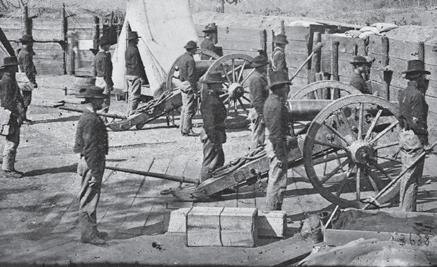
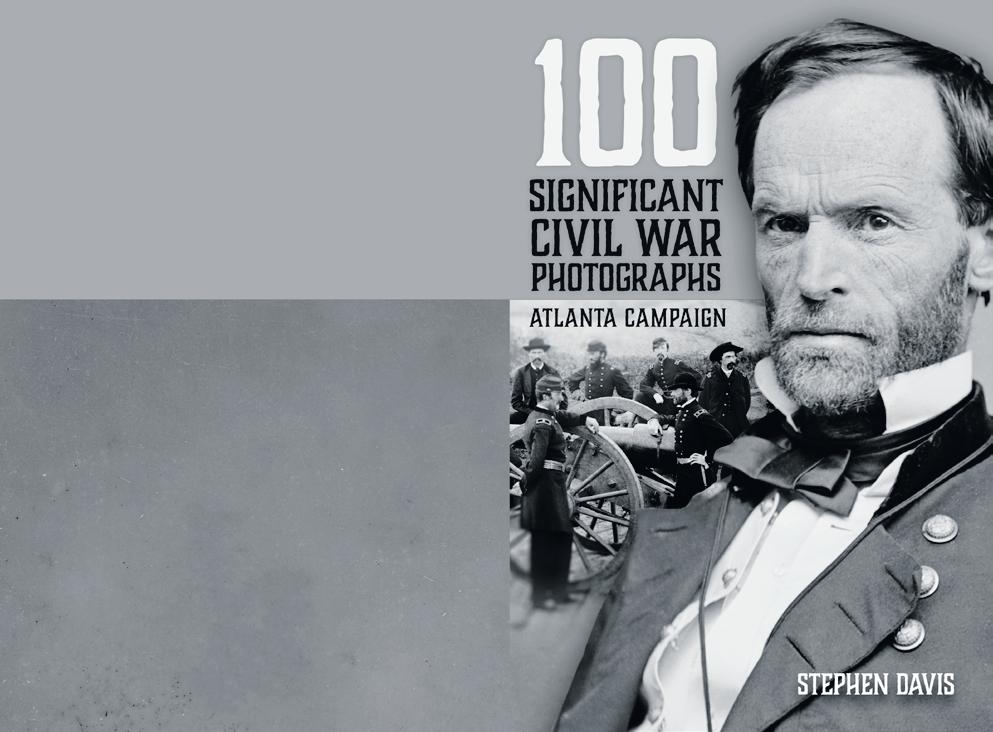
George N. Barnard’s photographs of the Atlanta Campaign
While Mathew Brady, Timothy O’Sullivan and a few others won fame as photographers of the American Civil War’s eastern theater, George N. Barnard earned a reputation as the key cameraman of the war’s western area. Evidence of this is Barnard’s hundreds of photographs taken of Atlanta Campaign scenes. Some were published in 1866, but many more have appeared in the countless pictorial histories of the Civil War.
Paperback, 128 pages. $19.95 + $3.50 shipping
A Long and Bloody Task
The Atlanta Campaign from Dalton through Kennesaw Mountain to the Chattahoochee River May 5–July 18, 1864
Davis’ narrative history of the Atlanta Campaign is divided into two paperbacks from Savas Beatie’s Emerging Civil War Series. Volume One, A Long and Bloody Task, carries Sherman’s forces from Dalton in northwest Georgia to the Chattahoochee River. There the Confederate government was forced to relieve its army commander, Joseph E. Johnston, and replace him with Gen. John B. Hood.
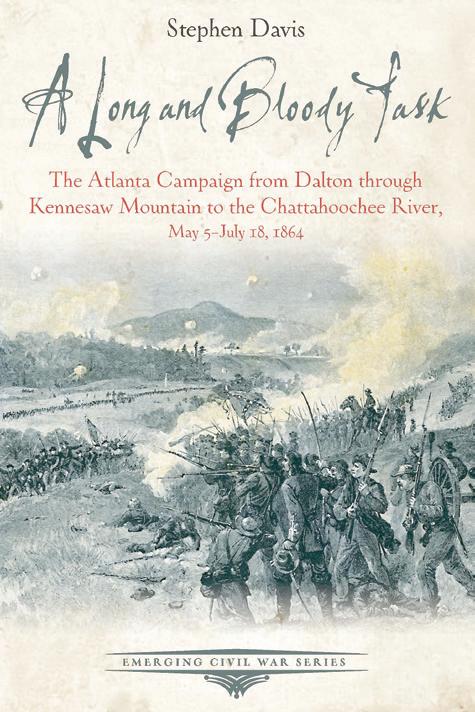
Paperback, 192 pages. $14.95 + $3.55 shipping
All the Fighting They Want
The Atlanta Campaign from Peachtree Creek to the City’s Surrender July 18–September 2, 1864
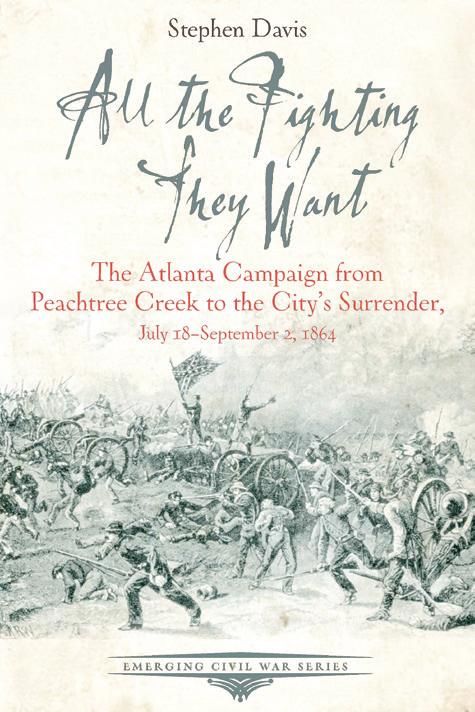
With the Yankee army five miles outside of Atlanta, Hood promised not to give up with city without a fight— which is all President Jefferson Davis asked. Davis’ companion volume, All the Fighting They Want, describes Hood’s efforts to defend Atlanta. Its fall in early September 1864 was a mortal blow to Confederate hopes for independence and a big boost to Lincoln’s hopes for presidential reelection.
Paperback, 192 pages. $14.95 + $3.55 shipping
To order a signed copy from author Stephen Davis email: SteveATL1861@yahoo.com
41 January 2020 Civil War News
Publishers: Send your book(s) for review to: CWN Book Review Editor Stephen Davis 3670 Falling Leaf Lane, Cumming, GA 30041-2087
The American Civil War was the first war in which both sides widely used entrenchments, repeating rifles, ironclad warships, and telegraphed communications. It was also the first American War to be extensively photographed. Mathew Brady, Alexander Gardner and Timothy O’Sullivan are famous for having made iconic photographs in the Civil War’s eastern theater. George N. Barnard deserves to be ranked in this top tier for his photographic work in the war’s western theater. A civilian photographer hired by Gen. William T. Sherman’s chief engineer to take pictures of fortifications around Atlanta, Barnard took several hundred of them in and around the city in the fall of 1864. His most famous is the site of Union Maj. Gen. James B. McPherson’s death in the battle of Atlanta, July 22, 1864. Thus far, no comprehensive, definitive listing has been made of the photographer’s work. The Library of Congress has 130 images; the U. S. Military Academy at West Point, New York, has at least 98 photographs, donated by Captain Poe’s widow. Other repositories, such as the Gilder Lehrman Institute of American History in New York City, have smaller collections. For this book we have chosen a hundred images we deem “significant,” though other students may wonder at some of our selections. We hope that this work will stimulate further interest in Barnardiana, and that other scholarly volumes are yet to come. The Atlanta Campaign STEPHEN DAVIS 100 SIGNIFICANT CIVIL WAR PHOTOGRAPHS ATLANTA CAMPAIGN
many visitors. “This is the place with the horse!” she overheard one visitor shriek. Indeed, the author realized that the town of Lexington itself was involved with Confederate exceptionalism, “where Confederate memory is largely divorced from history.”
Maurantonio’s toughest task, in my view, was trying to understand how Black Southerners can espouse Confederate sympathies (a scholar of less determination would have ducked the question altogether). Instead, she interviewed four African Americans to ask them. Predictably their answers varied. Karen Cooper, known as “the Black Flagger,” is a Tea Party member who exalts Confederates because “they fought the United States government.” James Haymes was eleven when he visited the Museum of the Confederacy; thirty years later he became its operations assistant. He declared that he would not “apologize for my slow talk” or “my heritage.” Teresa Roane, a Black Southerner who serves as archivist for the UDC, explains slavery this way: “I know that slavery existed. But we have to realize that it was a United States issue. All the blame cannot be put on the South.” She goes out of the way to debunk the current assertions of the Southern Poverty Law Center linking the eras of Confederate monument-building to the Jim Crow and Civil Rights eras.
Less successful, in my opinion, is the chapter in which she argues that “Confederate cookbooks… reduce the Confederacy to a delicious consumable, often a delectable and allegedly apolitical confection.” Yet demonstrating the richness of Maurantonio’s narrative is her chapter on Richmond’s famed Monument Avenue, “where the tensions between past and present, nostalgia and resistance, are regularly played out.” The author circumambulates among all of these themes with intellectual dexterity. My one qualm is with her overarching use of “neo-Confederates” in referring to those who engage in Confederate exceptionalism. “Neo-Confederate” is a term that could be applied to everyone from
Deadline for submissions and advertising is the 20th of each month for the following Civil War News issue.


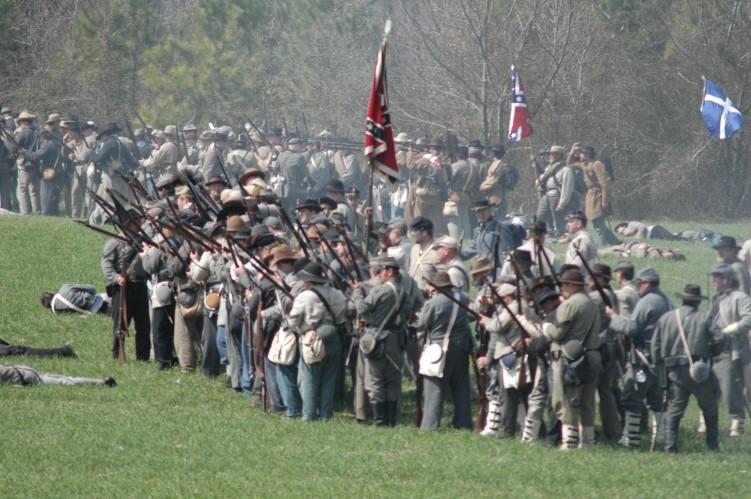
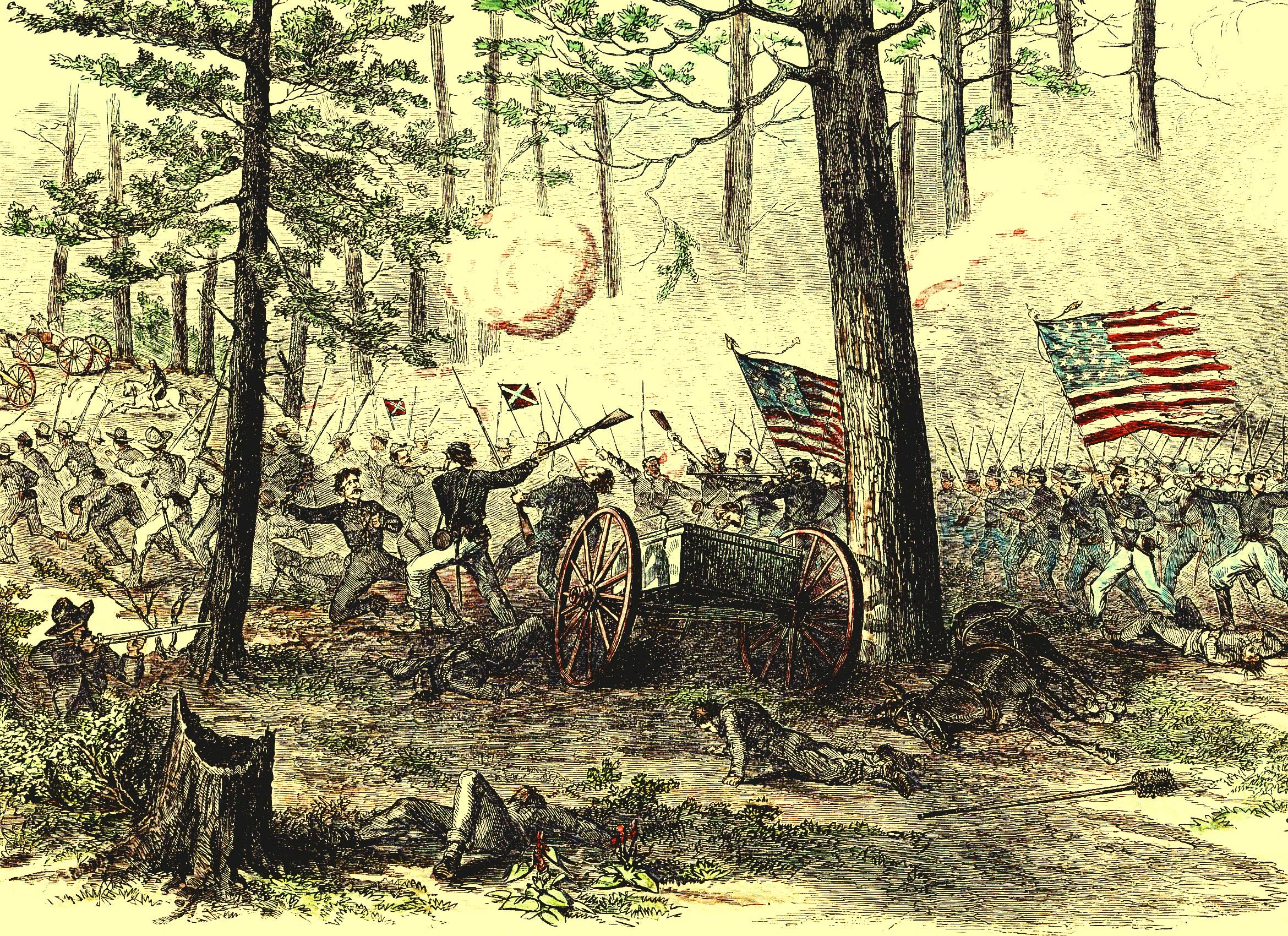
the late, great Nashville Fugitive writer Allen Tate (1899–1979) to Dylann Roof, the Charleston mass-killer. Surely a work of this literary nimbleness could have offered us some subtle distinctions among the many types of Confederate exceptionalists.
Forty-four years ago, even the famed actor George C. Scott might have been called a neo-Confederate. In 1976, America’s Bicentennial Year, NBC’s “Today” show on Fridays spotlighted one of the fifty states. Programs featured views of the state’s historic sites and presented snapshots of its famous people and celebrated events.
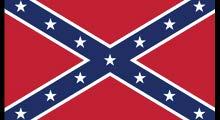
That spring I made a point of watching the “Today” episode on Virginia. In it Scott gave a personal walking tour of the campus of Washington & Lee University in Lexington. Stopping at its historic chapel, Scott stood beside Edward Valentine’s famed recumbent statue of Robert E. Lee. Scott himself was a Virginian, hailing from Wise County in the southwestern part of the state. He wrote the monologue for his campus tour, as he delivered a meditation upon General Lee, whose character he contrasted with the lives of 1970s Americans.
“This is Bicentennial America. This is Election-Year America,” Scott intoned; “this is 20th-century, thermo-nuclear, porno-liberated, cokey-alky, oligarchy, inorder-to-get-mine-I-gotta-grindyou America.”
Then he asked, “what are you and I supposed to learn from or feel about the world and the

character of a man like R. E. Lee?”
“Well,” he answered, “there are a few qualities this remarkable creature had which may serve us too, if we consider them.”
• Patience.
• Quiet good humor.
• Adoration of children.
• Loyalty.
• Respect for hard work.
• Dedication to an ideal.
• Love of animals.
• Appreciation of duly constituted authority—coupled with an abhorrence of authoritarianism.

• A devotion to history, for, as General Lee said, “It is history that teaches hope.”
• Gentleness, and the aspiration to achieve gentlemanliness.
• Understanding of the state of being young.
• Courtesy toward the conditional frailty of advanced age.
• Acceptance of responsibility.
• Personal integrity.
Scott’s monologue was so instantly popular that the University asked the actor for permission to print it, which he did (that’s how I got my copy). As an emblem of how many people today can look sympathetically, even reverently, upon Confederate heroes without associating them with slavery, race prejudice and repression, as a self-confessed Confederate exceptionalist, I can look no further.
The Book Editor’s new book, Texas Brigadier to the Fall of Atlanta: John Bell Hood is just released by Mercer University Press.
42 Civil War News January 2020 Digital Issues of CWN are available by subscription alone or with print plus CWN archives at CivilWarNews.com
American Digger Magazine's :::::::······:::::::Open to Public: Saturday: 9-5 Sunday: 9-3 LOW COUNTRY CIVIL WAR& ARTIFACT SHOW January 4-5, 2020 Omar Shrine Temple 176 Patriots Point Rd. Dealer Setup: Friday 12-7 PM Sat. 7-9 AM Mt Pleasant, SC Bring the whole family! There's something for everyone in nearby Charleston! 200+ tables Buy/Sell/Trade/ Browse/Display Swords & Knives Antique Firearms Dug & Non-dug Civilian Items Jewelry & Bottles Stone Artifacts Forinformation: (770)362-8671or (716)574-0465 anita@ americandigger. com Art, Photographs, & Books Militaria & Americana All Eras to WWII Metal Detectors & Equipment Awards Door Prizes americandigger.com/ american-digger-events/
Jan. 4, Virginia. Lecture
Explore the Mariners’ Museum in Newport News and enjoy a lecture on the CSS Manassas with paid admission. Lecture will be at 2:30 p.m. For information; marinersmuseum.org.
Jan. 4-5, South Carolina. Civil War Show and Sale
American Digger Magazine’s Lowcountry Civil War & Artifact Show, 176 Patriots Point Rd., Mt. Pleasant, S.C. Info: 770-362-8671 or 716-574-0465; email anita@americandigger.com or kesmas@localnet.com.


Jan 10, Virginia. Lunch Discussion
Battle of Stones River at the Mariners’ Park Café in the Mariners’ Museum in Newport News. Discussion is free with paid admission to the museum. For information; marinersmuseum.org.
Jan. 12, Pennsylvania. G.A.R. Museum Open House
Civil War regimental brass band concert to be held at the historic Ruan House located at 4278 Griscom Street, Philadelphia, Pa. at 1:30 p.m. For information; 215-289-6484 or www.garmuslib.org.
Jan. 18-19, North Carolina. 155th Commemoration of the Second Battle of Fort Fisher Program will focus on the Jan. 13-15, 1865 campaign to capture the fort. Battle reenactments and live artillery fire demonstrations with Fort Fisher cannons. Descendant’s reunion program for those with ancestors involved in the battle. Period exhibits, guest speakers and reenactors to demonstrate aspects of the battle. This family-friendly event is open to the public at no charge with off-site parking. Hours both days are 10 a.m. to 4 p.m. Located at 1610 fort Fisher Blvd. South, Kure Beach, NC 28449, for more information; 910-251-7340 or www.friendsoffortfisher.com or www.nchistoricsites.org/ fisher.
Jan. 25, Virginia. Lecture
“Private Confederacies: The Emotional Worlds of Southern Men as Citizens and Soldiers,” at the National Museum of Civil War Medicine in Frederick. 2:30 pm. Free with admission. civilwarmed.org/event/private-confederacies.
Feb. 1-2, Georgia. Civil War Show and Sale
MK Shows presents the Chickamauga (Dalton) Civil War Show at the Northwest Georgia Trade Center, Dalton, Ga., for collectors and history enthusiasts. Over 400 sale and display tables. Adults $10, Children under 12 are free. Open Sat. 9-5 and Sunday, 9-3. For information; www.MKShows. com, email Mike Kent at mike@mkshows.com.
Feb 9. Georgia. Living History
“Soldier Stories,” camp, demonstrations and artifact display at the Pickett’s Mill Battlefield Historic Site. 10 a.m.-4 p.m. Hikes 1 and 2 p.m. Free. explore.gastateparks.org/events.

Feb. 12, Pennsylvania. Lincoln Birthday Celebration, Parade and Ceremonies
Sponsored by the Union League of Philadelphia. Arrive by 10 a.m. for free parking for reenactors at Laz Garage on the N.W. corner of 15th & Sansom St. only. There will be a lunch for the participants at 12 p.m. After the parade participants are invited to return to the Union League for refreshments and entertainment. register: awaski01@gmail. com.
Feb. 14, Virginia. Lunch Discussion
“Confederate POW Camps,” at the Mariners’ Park Cafe in the Mariners’ Museum in Newport News. 12:30 pm. Discussion is free. marinersmuseum.org
Feb. 14-16, Florida. Reenactment
Olustee Battlefield Historic State Park will host the weekend long 44th Annual Reenactment commemorating the 156th anniversary of the Battle of Olustee. More than 2,000 living historians will give presentations of both civilian and military life during the Civil War. Events will include a wreath laying ceremony, Civil War Memorial Service, tours and medical demonstrations, entertainment, arts, crafts and food booths along with artillery night firing and oldfashioned barn dance. Spectators can visit authentic campsites, watch the parade, view artillery inspections, listen to a period music concert and watch the battle reenactment. Friday is living history education day for schools and a ball at the Ball Tent Saturday night. Period attire required and is for reenactment participants only. For information; 877635-3655; www.battleofolustee.org.
Feb. 22-23, South Carolina. Reenactment
The Battle of Aiken reenactment will take place at 1210 Powell Pond Road, Aiken. Camps and demonstrations all weekend with battles each day. $15/adult. For information; battleofaiken.org.
March 6-7, Mississippi. Midsouth Military History and Civil War Show
The 53rd annual show and sale will be held at a new location in 2020 at I-55 & Church Rd. in Southhaven, just 15 minutes from downtown Memphis. Admission is $10, kids 12 and under free. For information; MidsouthMilitaryHistory@ gmail.com or 901-832-4708.
March 7, Pennsylvania. Civil War Lecture
Join us for a lecture on South Mountain Communities during the Civil War, at the Shippensburg Historical Society, 52 W. King St., Shippensburg. 10 a.m. Free, donations welcome. For Information; shippensburghistoricalsociety.org
Upcoming
Conference 1777 Philadelphia
22-26, 2020 Based in Ringgold,




43 January 2020 Civil War News
for a FREE Brochure! 717-264-7101 ext. 206
Call
Campaign
30-May 3, 2020 Limited seating! GATEWAY TO THE DEEP SOUTH:
Join Chambersburg Civil War Seminars & Tours for the largest and most comprehensive study of the Chickamauga & Chattanooga campaigns yet attempted! Five expert historians will cover diverse topics along with four full days of intensive battlefield touring led by David Powell with program coordinator Eric Wittenberg. We’ll visit Bridgeport and Stevenson, AL; LaFayette, GA, Davis’s Crossroads, Chickamauga, Reed’s Bridge, Jay’s Mill, Brock Field, Kelly Field, Brotherton Field, Horseshoe Ridge, Lookout Mountain, National Cemetery, Orchard Knob, Ringgold & more! & Chattanooga
April
Chickamauga
GA
July
www.CivilWarSeminars.org
March 21, Pennsylvania. Preservation Luncheon
Author Bradley Gottfried will speak on “The Days in the Saddle: The Cavalry at Gettysburg” at the Grand Army Museum, 9130 Academy Rd., Philadelphia, Pa. 19114 For reservations or information; garmuslib@verizon. net or 215-289-6484.
March 21-22, North Carolina. Reenactment
Bentonville Battlefield State Historic Site is host to the largest reenactment held in the state of North Carolina every five years. Visitors will learn about the battle that happened Mar. 19-21, 1865, which was the last major Confederate offensive in the war as Gen. Joseph Johnston fought the advancement of Gen. Sherman’s march across the South. Included are many free programs and 2 reenactments which are ticketed events. For tickets, schedule of events and more information; 910-594-0789 or https://www.johnstoncountync. org/155th-bentonville-reenactment.
April 3-5, Maryland. Civil War Conference
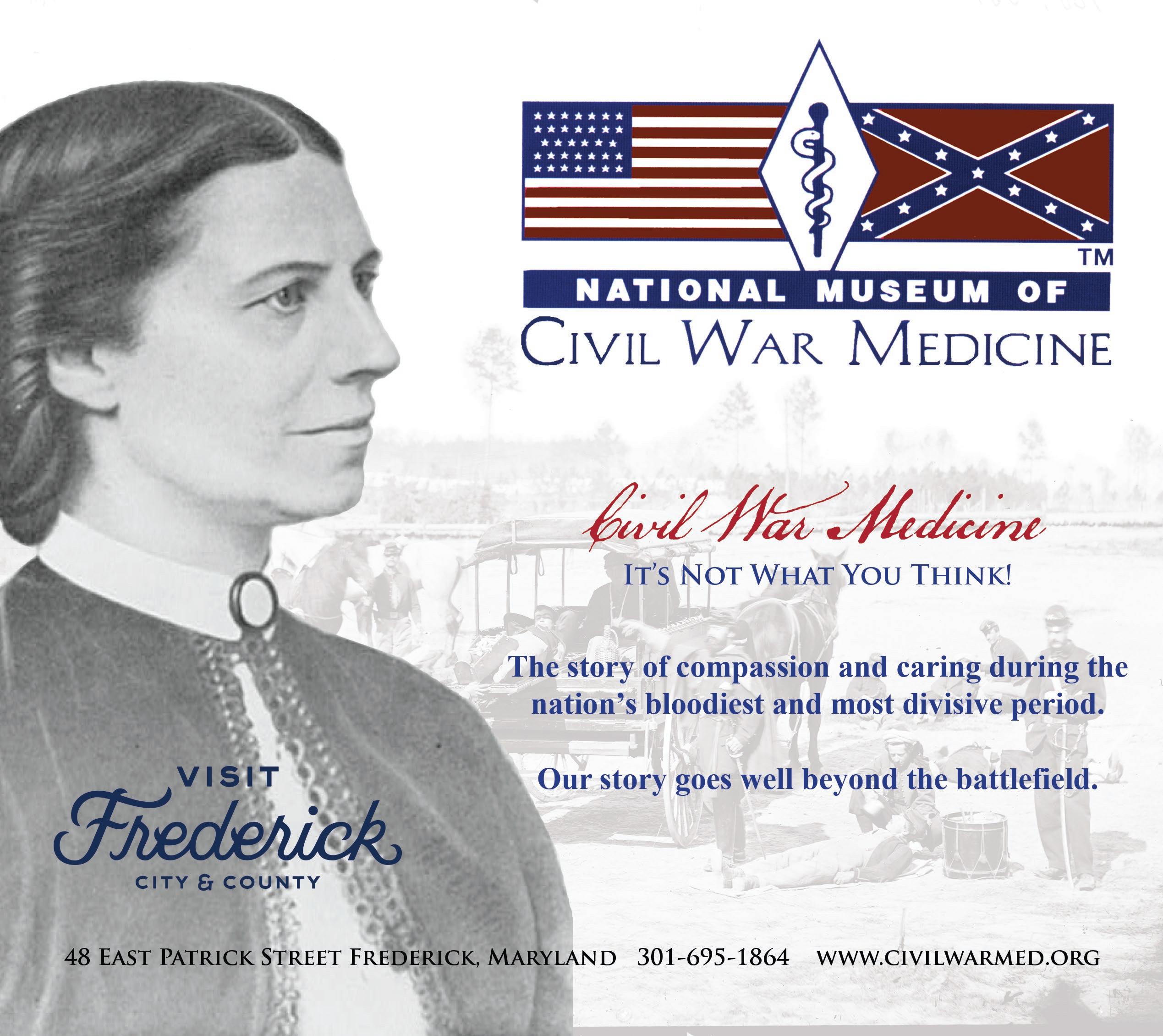
“Lincoln Assassination Studies: Snapshots from the Big Picture,” 21st Annual Conference. Tours and lectures sponsored by the Surratt Society, in Clinton. $225, tours priced separately. For information; surrattmuseum.org
April 4, All States. Park Day sponsored by the American Battlefield Trust
Annual volunteer cleanup and repair at Civil War sites across the country. For information; battlefields.org/events/park-day.
April 4, Virginia. Shenandoah University’s McCormick Civil War Institute in Winchester
The McCormick Civil War Institute will host its 2020 Spring Conference from 9 a.m. - 4 p.m. “The Civil War on the Water.” Featuring nationally recognized Civil War scholars John M. Coski, Anna Gibson Holloway, Karen Needles, Jonathan W. White and Jonathan A. Noyalas (Shenandoah University). Registration fee of $50 ($25 for students with valid id) covers all presentations and lunch. For information or to register visit www.su.edu/ MCWI, or call 540-665-4501, or email jnoyalas01@su.edu.
April 5, Pennsylvania. Symposium
Annual Meade Society History Symposium at the Conservatory at West Laurel Hill Cemetery, Bala Cynwyd, Pa. at 12 p.m. Speakers on the topic – The War with Mexico; Training Ground of the Civil War. Contact: Jerry McCormick 215-848-7753; or gedwinmc@msn.com.
April 23-26, New Jersey. Company of Military Historians Annual Meeting
The 2020 meeting, held at the Crowne Plaza-Princeton, 900 Scudders Mill Rd., Plainsboro, NJ., will begin with the welcome reception on Thursday followed by a field trip to visit Washington’s Crossing, the Old Barracks Museum and Princeton Battlefield on Friday. Nine lectures covering many periods of American military history and material culture along with a 20-table exhibit / flea market room and expanded silent auction. Register online at: https://tinyurl.com/register-4-CMH2020. For more information; lesandjuanita1@hushmail.com, 845-754-8827.
April 24 -26, North Carolina. 23rd Annual Salisbury Confederate Prison Symposium 23rd Annual Salisbury Confederate Prison Symposium sponsored by the Robert F. Hoke Chapter 78, United Daughters of the Confederacy. Event begins Fri. afternoon with 3 lectures, displays, Friendship Banquet, music, and recognition of veterans. On Sat. there are 4 lectures, light lunch, door prizes, displays, and books. Lectures presented by authors, historians, and descendants on subjects related to the Salisbury Confederate Prison. Sun. there is a 10 a.m. Memorial Service for prisoners at the Salisbury National Cemetery and an 11 a.m. Service for guards at the Old Lutheran Cemetery. Sun. afternoon Prison site tour for registered Symposium attendees. Registration $70 per person when postmarked by April 3, $80 afterwards. $15 charge for refunds after April 10. No refunds after April 17. Mail checks to Robert F. Hoke Chapter 78, UDC, PO Box 83, Salisbury, NC 28145-0083. For information; Sue Curtis 704-637-6411, southpawsagain@gmail.com.
April 25, Illinois. Civil War Show and Sale
Zurko Promotions presents The National Civil War Collectors Spring Show and Sale which will be held at the DuPage County Fairgrounds in Wheaton. Hours: 9 a.m. to 4 p.m. Admission is $9 – includes admission to the CADA Collector Arms Dealers Assoc. Show. For information; www. chicagocivilwarshow.com.
May 2-3, Ohio. Civil War Show and Sale
The 43rd Annual Show in Mansfield at the Richland County Fairgrounds.
Friday dealer setup. One of the most impressive artillery living history displays you will ever see. Living history units representing Rev war through WWII. Over 750 tables. Admission is $7, kids under 12 free. For information; email: info@ohiocivilwarshow.com or visit www.ohiocivilwarshow.com.
May 15-17, Georgia. Reenactment
The 156th Anniversary “Battle of Resaca” reenactment will be held on over 650 acres of the original battlefield. This event will have main camps located within the original US and CS lines. Camping allowed in or near the breastworks. Amenities include straw, hay and firewood; food and ice on site. The planned activities include main battles both days at 2 p.m., period dance, medical demo’s, cavalry competition, ladies’ tea, civilian refugee camp, period church services and a memorial service at the Confederate cemetery. Handicapped parking is available. A portion of the proceeds will be donated to the preservation efforts of the Friends of Resaca Battlefield, Inc. A $150 bounty will be paid to the first fourteen cannon and crews registered by May 1st. Reenactor registration fee is $10.00 due by May 1. For more information, www.georgiadivision.org or Battle of Resaca, P.O. Box 0919, Resaca, GA 30735-0919.
May 24, Pennsylvania. Memorial Day Observance at Historic Laurel Hill Cemetery
Recreating the Original G.A.R. Decoration Day Service of 1868: The traditional Decoration Day service of the Grand Army Meade Post #1 will be recreated at Laurel Hill Cemetery, 3822 Ridge Ave. Philadelphia at noon. For information, 215-228-8200 or awaskie01@gmail.com for Dr. Andy Waskie.
May 30, Georgia. Living History
Anniversary living history and civilian program at the Battle of Pickett’s Mill Battlefield Historic Site located at 4432 Mt. Tabor Church Rd., Dallas, Ga. Hours are 9 a.m. - 4 p.m. $6/adult. For information; explore.gastateparks.org/ info/214024?c=17413216.
May 30 & 31, Pennsylvania –Living History
Join us for this annual event recognizing the participation of 120 members of the Pennypacker family, including Governor Samuel W. Pennypacker, a Private in the 26th Pa. Emergency Militia. See soldier life and civilian demonstrations, artillery fire, troop inspections, dress parade, music and speakers. Children can participate in the Be a Soldier Kid Enlistment each day. Pennypacker mansion is open for tours. Food vendor onsite. Hours: Sat. 10- 5; Sun. 10-4. Free to the public. Reenactment units: Fee $2/person before May 1, $10/person after. Free straw, firewood, water and cake. For Information: 610-287-9349 or www.ppmcivilwar.org.
June 6-7, Virginia. Reenactment
23rd Annual Reenactment of Fort Pocahontas, on the historic battlefield located at 13150 Sturgeon Point Rd., Charles City, Va. Camp and demonstrations open 10 a.m. - 4 p.m. Sat., 10 a.m. - 2 p.m. Sun. Battles at 1 p.m. both days. $10/ adults. fortpocahontas.org/reenactment.
June 27-28, Pennsylvania. Civil War Show
Sat. 10 a.m. - 5 p.m., Sun. 9 a.m. – 2 p.m. Eisenhower Hotel & Conference Center Allstar Expo Complex, 2638 Emmitsburg Road, Gettysburg. The Gettysburg Battlefield Preservation Association’s Artifact and Collector’s Show features more than 200 vendors and over 300 tables of artifacts, swords, firearms, correspondence, books, photographs, documents and much more. Daily admission: Adults: $8. Children 12 and under free. Vendors contact: bsynnamon@gmail.com or call 717-334-2350. For more information visit www.uniondb.com or www.gbpa.org. Email: info@gbpa.org.
44 Civil War News January 2020
What do they say?
Jack Melton’s latest endeavor, Civil War Artillery Projectiles – The Half Shell Book, is a remarkable addition to Civil War artillery ammunition literature. For archaeologists and collectors the clearly written text and the excellent photographs provide a wealth of information to properly identify recovered shells and burst fragments. For bomb squad and EOD specialists this book should be on every units’ shelf. The material found in these pages will help EOD personnel identify what has been found, whether or not it is dangerous, and how to inert the round without the necessity of destroying an important historic object. This book takes Civil War artillery ammunition studies to a new level.
Douglas Scott Adjunct Research Faculty, Colorado Mesa University. Author of Uncovering History: Archaeological Investigations of the Little Bighorn.
Wow. I have been reading a lot of different books on ordnance from this era, but this one takes the cake. Most of the other books drift off in directions that are not helpful with the ordnance specific information I am usually looking for. But this book stays on task and topic from start to finish.

 Tom Gersbeck
Tom Gersbeck
MFS, Graduate Faculty, Arson-Explosives Investigation (AEI), School of Forensic Sciences, Oklahoma State University


Jack Melton’s new book Civil War Artillery Projectiles – The Half Shell Book, promises to be one of the most important volumes on Civil War artillery in recent times. Anyone who has studied the wide variety of Civil War projectiles knows that what is inside is just as important, and maybe more so, than what is outside the shell. In this book, cutaway shells are graphically explained with superb color photographs and detailed notes. They reveal important details and differences in a variety of similar projectiles that tell us U.S. from C.S. and between type variations, in a way that no other approach has ever done. It is supremely helpful in explaining to others just how a shell works, whether it is still dangerous or not, and why.
 Les Jensen Former Curator of the Museum of the Confederacy
Les Jensen Former Curator of the Museum of the Confederacy
45 January 2020 Civil War News
Small Talk Trivia Answers

1. John Pope (1822–1892). On September 5, 1862, within a week of the battle, Pope was relieved of command. He was sent to Minnesota to fight the Sioux Indians (Peter Cozzens, General John Pope: A Life for the Nation [2000], pp. 198-201).
2. Richard Stoddert Ewell (1817–1872). “At one point Ewell lost his head and began beating some of his fleeing soldiers over the back with his sword. Lee reined in his enraged lieutenant, saying sharply, ‘General Ewell, you must restrain yourself; how can you expect to control your men when you have lost control of yourself? If you cannot repress your excitement, you had better retire’” (Donald C. Pfanz, Richard S. Ewell: A Soldier’s Life [1998], p. 389).
3. William Tecumseh Sherman (1820–1891). Under a cloud, Sherman was relieved and assigned to duty as drillmaster at the St. Louis Barracks (Lloyd Lewis, Sherman: Fighting Prophet [1932], 194-201).
4. George Bibb Crittenden (1812–1880). After his removal, he served without rank on the staff of various officers in western Virginia (Lawrence L. Hewitt, “George Bibb Crittenden” in William C. Davis, ed., The Confederate General [6 vols., 1991], vol. 2, p. 43).
5. Stephen Augustus Hurlbut (1815–1882). The quotes are from Lash’s entry on Hurlbut in John T. Hubbell and James W. Geary eds., Biographical Dictionary of the Union: Northern Leaders of the Civil War (1995), p. 269.
6.-7. Braxton Bragg (1817–1876) and John Bell Hood (1831–1879).
8.-9. Edward Ferrero (1831–1899) and James Hewitt Ledlie (1832–1882). Ledlie was accused of cowardice and drunkenness by a court of inquiry. He went on sick leave a week after the battle of the Crater and resigned in January 1865. Ferrero, also criticized by a court of inquiry, was allowed to stay with his division till the end of the war (Jeff Kinard, The Battle of the Crater [1995], p. 39, 41).
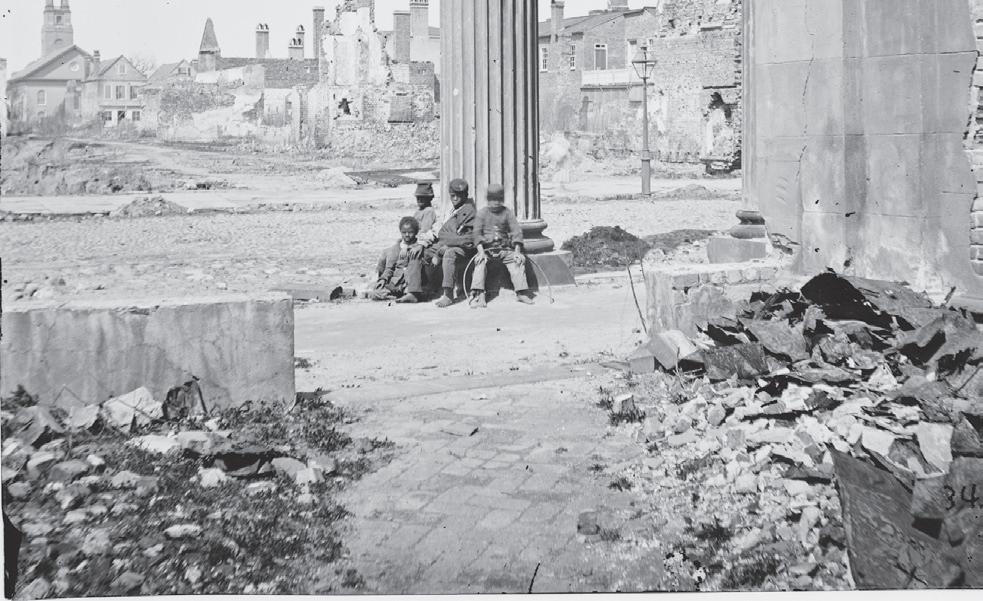
10. John Clifford Pemberton (1814–1881) (Michael B. Ballard, Pemberton: A Biography [1991], 181, 185).
July 4-5, Pennsylvania. Reenactment
The 2020 reenactment of the Battle of Gettysburg will be hosted by the Gettysburg Battlefield Preservation Association and will be held at the Daniel Lady Farm. For updates visit https://www.gbpa.org/news/gbpasdaniel-lady-farm-host-2020-battlegettysburg.
July 22-26, Georgia.
Gateway to the Deep South: Chickamauga & Chattanooga
Featuring tour guide & leading authority David Powell with special guest Eric Wittenberg as we visit Bridgeport and Stevenson, AL; LaFayette, GA, Davis’s Crossroads, Chickamauga, Reed’s Bridge, Jay’s Mill, Brock Field, Kelly Field, Brotherton Field, Horseshoe Ridge, Lookout Mountain, National Cemetery, Orchard Knob, Ringgold & more! Based in Ringgold, GA. More details www. CivilWarSeminars.org or call 717264-7101.
July 25-26, Tennessee. Civil War Show and Sale
American Digger® Magazine’s Chattanooga Civil War & Artifact Show, Camp Jordan Arena, 323 Camp Jordan Pkwy., East Ridge, Tenn. Info: 770-362-8671 or 716-574-0465; email anita@ americandigger.com or kesmas@ localnet.com.
Aug. 15-16, Minnesota. Reenactment
“Pipestone Civil War Days,” 850 N Hiawatha Ave, Pipestone. Camps, music, talks and demonstrations
8 a.m. - 4:30 p.m. Sat., 8 a.m. - 4 p.m. Sun. Battles to be held on both afternoons. For information; pipestoneminnesota.com/cwd.
Sept. 26, Illinois. Civil War Show and Sale
Zurko Promotions presents The National Civil War Collectors Fall Show and Sale which will be held at the DuPage County Fairgrounds in Wheaton. Hours: 9 a.m. to 4 p.m. Admission is $9 – includes admission to the CADA Collector Arms Dealers Assoc. Show. For information; www. chicagocivilwarshow.com.
Oct. 17-18, Virginia.
Reenactment
Plan to attend the 156th Anniversary of the Battle of Cedar Creek in Middletown, Va., hosted by Cedar Creek Battlefield Foundation www. ccby.us. For more information; info@ccbf.us or call 540-869-2064.
Oct. 17-18, Virginia. 156th Anniversary Reenactment of the Battle of Cedar Creek
In commemoration of the 1864 Battle of Cedar Creek, this reenactment event hosts a Civil War Reenactment daily with cavalry, infantry, artillery,
and living history presentations along with presentations by guest speakers and historians. Family friendly, gates open to the public at 9:00 AM. Located on the actual battlefield and hosted by Cedar Creek Battlefield Foundation, a non-profit 501(c) (3), all proceeds help preserve the battlefield. For Reenactor and other participants registration and for other information visit www.ccbf.us. or call 540-869-2064.
Nov. 14-15, Virginia. Civil War Show and Sale
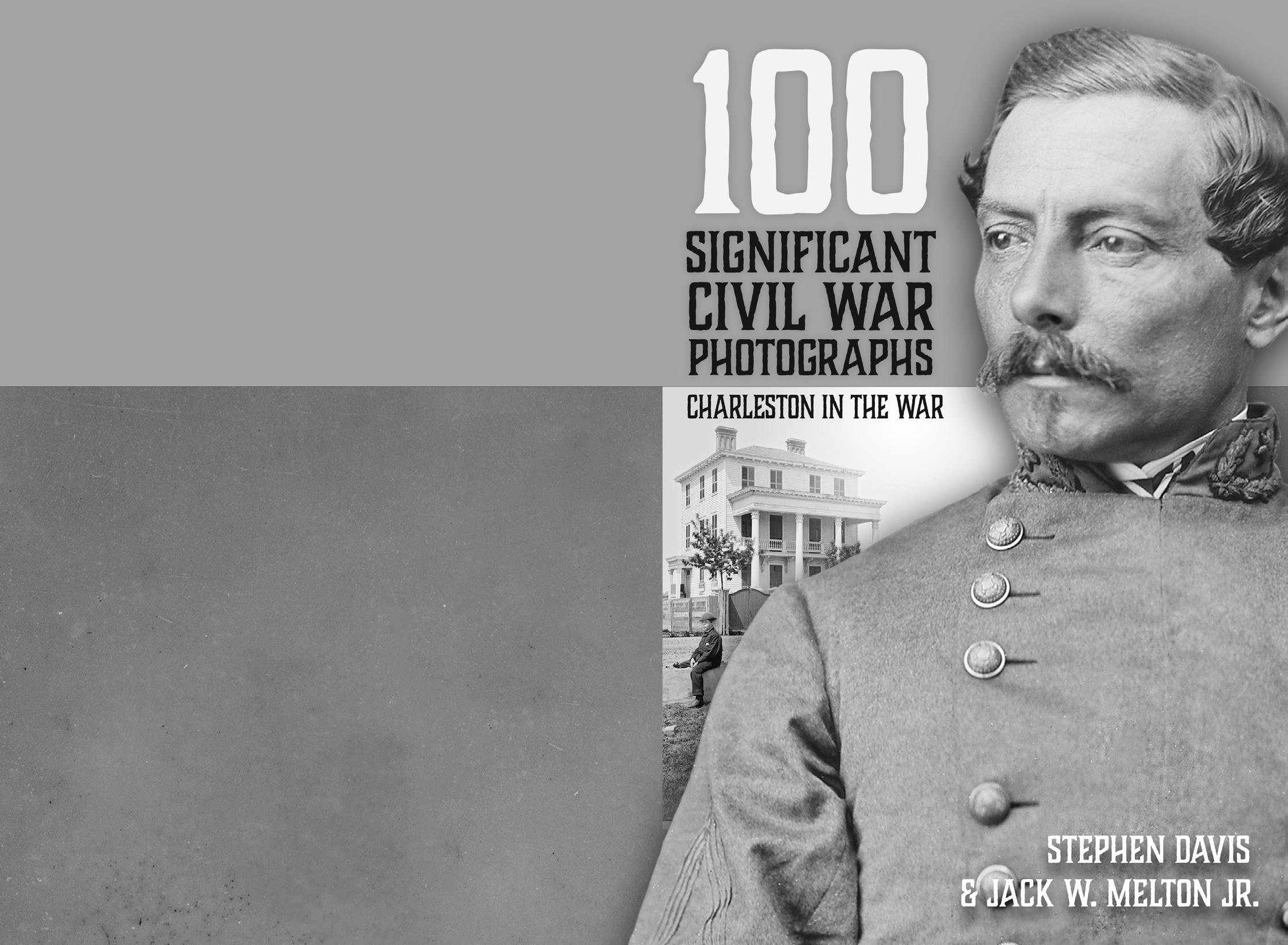
MK Shows presents the 40th Anniversary of the “Original Richmond” Capital of the Confederacy Civil War Show for collectors and history enthusiasts. Located at the Richmond International Raceway, 600 E. Laburnum Ave. Free parking. Over 350 tables. Adults $10, Children under 12 are free. Sat. 9-5 and Sun. 9-3. For info: www.MKShows.com, mike@mkshows.com.
Nov. 21, Pennsylvania. Remembrance Day in Gettysburg
General Meade & his Generals and the veterans of the Battle of Gettysburg Honor / Dedication Ceremonies during the Remembrance Day Observance. Honoring all commanders and veterans of the Battle. Meet at the General Meade Equestrian Monument at 10:30 a.m. For info: Jerry McCormick at 215848-7753 or gedwinmc@msn.com.
Dec. 5-6, Tennessee. Civil War Show and Sale
MK Shows presents the 34th Annual Middle Tennessee Civil War Show and Sale at the Williamson County Ag Expo Park, 4215 Long Lane in Franklin. The nation’s largest Civil War show, featuring 1,000 tables of antique weapons, artifacts and memorabilia from top dealers and collectors around the country and encompassing all eras of military history from the Revolutionary War through World War II. Appraisers are always on hand to help you identify and value your military collectibles at no cost. Hours are 9-5 on Sat., 9-3 on Sun., parking is free and admission is only $10/adults and children 12 & under/free. For more information; www.MKShows.com or Mike@MKShows.com.
Dec. 31, Pennsylvania. Annual General Meade Birthday Celebration
Mark your calendar for the annual anniversary of the birth of General George G. Meade, heroic commander of the victorious Union army at the Battle of Gettysburg. The General Meade Society will celebrate his birthday at Historic Laurel Hill Cemetery, 3822 Ridge Ave. at noon. For directions, call: 215-228-8200 Laurel Hill Cemetery.
46 Civil War News January 2020
“The STORIES BEHIND THE PICTURES” 100 Significant Civil War Photographs CHARLESTON IN WAR By Stephen Davis & JACK W. MELTON JR Name Shipping Address City State Zip 160 pages • OVER 100 PHOTOS • MAPS • INDEX • BIBLIOGRAPHY • ISBN: 978-1-61850-167-7 Paperback: $19.95 (+$3.50 S & H) • Released Jan. 2020 3 ways to order YOUR COPY! CALL US 800-777-1862 ORDER ONLINE www.historicalpubs.com fill out this form BELOW & mail with a check for $23.45 to: Historical Publications LLC 520 Folly Road, Suite 25 PMB 379, Charleston, SC 29412 (S.C. residents include 9% sales tax of $1.80) newly and Charles photograph, selected e Fire allow are Confederates Harbor of Federal history historical works. as DAVIS & MELTON 100 SIGNIFICANT CIVIL WAR PHOTOGRAPHS : CHARLESTON IN THE WAR
Terms and Conditions
The following terms and conditions shall be incorporated by reference into all placement and order for placement of any advertisements in Civil War News by Advertiser and any Agency acting on Advertiser’s behalf. By submitting an order for placement of an advertisement and/or by placing an advertisement, Advertiser and Agency, and each of them, agree to be bound by all of the following terms and conditions:
1. All advertisements are subject to acceptance by Publisher who has the right to refuse any ad submitted for any reason.
2. The advertiser and/or their agency warrant that they have permission and rights to anything contained within the advertisement as to copyrights, trademarks or registrations. Any infringement will be the responsibility of the advertiser or their agency and the advertiser will hold harmless the Publisher for any claims or damages from publishing their advertisement. This includes all attorney fees and judgments.
3. The Publisher will not be held responsible for incorrect placement of the advertisement and will not be responsible for any loss of income or potential profit lost.
4. All orders to place advertisements in the publication are subject to the rate card charges, space units and specifications then in effect, all of which are subject to change and shall be made a part of these terms and conditions.
5. Photographs or images sent for publication must be high resolution, unedited and full size. Phone photographs are discouraged.
6. At the discretion of Civil War News any and all articles will be edited for accuracy, clarity, grammar and punctuation per our style guide.
7. Articles can be emailed as a Word Doc attachment or emailed in the body of the message. Microsoft Word format is preferred. Email articles and photographs: mail@civilwarnews.com

47 January 2020 Civil War News Advertisers In This Issue: 100 Significant Civil War Photographs: Atlanta 11 100 Significant Civil War Photographs: Charleston 46 American Battlefield Trust 8 Ace Pyro LLC 15 Artilleryman Magazine 5 Brian & Maria Green 5 C.S. Acquisitions 11 Civil War Artillery – The Half Shell Book 45 CWMedals.com, Civil War Recreations 39 Civil War Navy Magazine 17 Civil War Shop – Will Gorges 9 College Hill Arsenal – Tim Prince 24 Dell’s Leather Works 37 Dixie Gun Works Inc. 30 Fugawee.com 19 Georgia’s Confederate Monuments – Book 27 Gettysburg Foundation 23 Greg Ton Currency 9 Gunsight Antiques 9 Harpers Ferry Civil War Guns 19 The Horse Soldier 13 James Country Mercantile 10 Jeweler’s Daughter 7 Jessica Hack Textile Restoration 13 Le Juneau Gallery 11 Mike Brackin 30 Military Images Magazine 23 National Museum of Civil War Medicine 44 Panther Lodges 37 The Regimental Quartermaster 9 Richard LaPosta Civil War Books 38 SC Confederate Relic Room & Military Museum 32 Stephen Davis – Author 38, 41 Suppliers to the Confederacy – Book, Craig Barry 12 Ulysses S. Grant impersonator – Curt Fields 9 University of Tennessee Press 16 Vin Caponi Historic Antiques 10 Events: 155th Bentonville Reenactment 42 155th Battle of Fort Fisher 15 Baltimore Antique Arms Show 43 Civil War Seminars 43 The Civil War on the Water Conference 27 Lowcountry Civil War Show 42 MKShows, Mike Kent 3, 18 Mid South Military & Civil War Show 15 Olustee Reenactment 39 Poulin Auctions 48
c c c c c c
NAME ADDRESS ADDRESS CITY STATE ZIP CODE EMAIL $38.50 - 1 year USA Print $48.50 - 1 year USA Print & Digital $66 - 2 year USA Print $86 - 2 year USA Print & Digital $29.95 - 1 year Digital only Payment Enclosed Check # Card # Exp. Date Security Code Name on Card New Renewal c Make checks payable to Historical Publications LLC. c c c c
Year PHONE Email (required for digital subscription) USA Subscriptions Only No Canada or International Mail to: Historical Publications LLC 520 Folly Road, Suite 25 PMB 379, Charleston, SC 29412 Deadlines for Advertising or Editorial Submissions is the 20th of each month. Email to ads@civilwarnews.com Subscribe online www.CivilWarNews.com Mike@MKShows.com • www.MKShows.com Admission Coupon To Any MKShows Event $1 Off 770-630-7296
Charge my: Discover MasterCard Visa
Civil War News – 12 Issues Per
































































































 by Joe Bilby
by Joe Bilby






















 Bob Zeller President, Center for Civil War Photography
Bob Zeller President, Center for Civil War Photography
































































































































































































 Tom Gersbeck
Tom Gersbeck


 Les Jensen Former Curator of the Museum of the Confederacy
Les Jensen Former Curator of the Museum of the Confederacy









